 Dr. Jeff Harper | Comments Off |
Dr. Jeff Harper | Comments Off | My most current blog entry:
Entries in Monkey (7)
Images from a Japanese Sojourn, May 2024
 Saturday, January 4, 2025 at 8:04PM
Saturday, January 4, 2025 at 8:04PM In May of 2024 my wife and I joined a group of her friends on a golf junket to Japan. A van/bus was rented and we drove, over several days and several overnight stop-overs, from Tokyo to near Nagoya - and back to Tokyo. We had lots of fun and saw a lot of amazing things . . . and ate a lot of great Japanese food . . . lots of it! While the group played golf I set off to explore the surrounding area with my camera. This entry, unlike others here, is not a chronological account of the whole trip, but "only" a collection of favorite images.
 At a tourist trap bathroom stop I took this amazing photo of Mt. Fuji with late spring colors in the foreground. Magical.
At a tourist trap bathroom stop I took this amazing photo of Mt. Fuji with late spring colors in the foreground. Magical.
 I spent one morning with a Japanese man, another "golf widow," exploring the temples we found on GoogleMaps. Fantastic beauty. . .
I spent one morning with a Japanese man, another "golf widow," exploring the temples we found on GoogleMaps. Fantastic beauty. . .
 Fantastical Japanese artistic expression.
Fantastical Japanese artistic expression.
 A trip highlight was a frightening ride up a steep mountain on a cable-car. The view was astounding!
A trip highlight was a frightening ride up a steep mountain on a cable-car. The view was astounding!
 Transportation options around an ancient royal Japanese temple complex.
Transportation options around an ancient royal Japanese temple complex.
 Japanese use of color and aesthetics are impressive.
Japanese use of color and aesthetics are impressive.
 Japanese sense of humor . . . or? "Marriage Rocks."
Japanese sense of humor . . . or? "Marriage Rocks."
 I was a bit embarrassed when out tour leader booked a dockside viewing of traditional woman pearl divers. They seemed like they were just awakened from their naps and driven down to the port to perform for us. It was interesting.
I was a bit embarrassed when out tour leader booked a dockside viewing of traditional woman pearl divers. They seemed like they were just awakened from their naps and driven down to the port to perform for us. It was interesting.
 We stopped to marvel at a 19th century Japanese businessman's house. Beautiful.
We stopped to marvel at a 19th century Japanese businessman's house. Beautiful.
 Astoundingly beautiful temples at every turn.
Astoundingly beautiful temples at every turn.
 Japanese woodworking skill on display . . . love this.
Japanese woodworking skill on display . . . love this.
 We visited many, many shrines . . . each different in special ways.
We visited many, many shrines . . . each different in special ways.
 A seaside shrine with monks.
A seaside shrine with monks.
 Japanese traditional temple aesthetic.
Japanese traditional temple aesthetic.
 The Japanese love of Nature is evident everywhere.
The Japanese love of Nature is evident everywhere.
 Springtime in Japan means . . . FLOWERS!
Springtime in Japan means . . . FLOWERS!
 We visited a famous Begonia garden. Fantastic!
We visited a famous Begonia garden. Fantastic!
 Springtime in Japan . . . many different flowers everywhere.
Springtime in Japan . . . many different flowers everywhere.
 A field of bluebells.
A field of bluebells.
 Seen in a museum waiting room.
Seen in a museum waiting room.
 Gorgeous natural views . . .
Gorgeous natural views . . .
 We stayed in hotels with great views throughout the week.
We stayed in hotels with great views throughout the week.
 Another great hotel room window view.
Another great hotel room window view.
 Fantastic beauty . . . and craftsmanship.
Fantastic beauty . . . and craftsmanship.
 Big straw knot.
Big straw knot.
 Inner room of a Japanese temple.
Inner room of a Japanese temple.

Pagoda viewpoint . . . er . . . coastal city view.
 Too many steps for me! I didn't go up.
Too many steps for me! I didn't go up.
 Small Japanese town urban environment.
Small Japanese town urban environment.
 Sweet waterfall at a temple.
Sweet waterfall at a temple.
 Small temple shrine.
Small temple shrine.
 We stopped at a small town along the way and discovered a covered walking street.
We stopped at a small town along the way and discovered a covered walking street.
 Small town sweet shop.
Small town sweet shop.
 The Japanese lead the world in amazing, and beautiful packaging.
The Japanese lead the world in amazing, and beautiful packaging.
 Busking with your monkey at the pagoda view point.
Busking with your monkey at the pagoda view point.
 Japan is known for its beautiful gardens . . .
Japan is known for its beautiful gardens . . .
 . . . so many beautiful Japanese gardens!
. . . so many beautiful Japanese gardens!
 I just love these contrasting textures and shapes. Japan!
I just love these contrasting textures and shapes. Japan!
 A sacred temple.
A sacred temple.
 An ancient village restored for tourist enjoyment and appreciation.
An ancient village restored for tourist enjoyment and appreciation.
 Japanese tourists enjoying a tour through their cultural heritage.
Japanese tourists enjoying a tour through their cultural heritage.
 Packaged and ready to ship.
Packaged and ready to ship.
 My lunch, carefully selected from the corn dog family of fine and delicious deep fried foods. Japan!
My lunch, carefully selected from the corn dog family of fine and delicious deep fried foods. Japan!
 I left Japan with wonderful memories and a ton of images . . . many more than I could post here. I know I will go back to Japan. It is a fascinating country try.
I left Japan with wonderful memories and a ton of images . . . many more than I could post here. I know I will go back to Japan. It is a fascinating country try.
 Dr. Jeff Harper | Comments Off |
Dr. Jeff Harper | Comments Off | Ratchaburi Ramble
 Wednesday, April 6, 2022 at 5:36PM
Wednesday, April 6, 2022 at 5:36PM One of the benefits of having a wife who is a serious golfer is that I get to tag along when she goes on an out-of-Bangkok golf junket with her pals. We were on vacation in the seaside town of Hua Hin and made the short drive north to the Ratchaburi Royal Golf Club early one morning after a spactacular sunrise over the Gulf of Thailand . . . . and while she played a competitive round, I explored the nearby countryside, the old town market in Ratchaburi town, and the 10th century Wat Mahathat Worawihan.
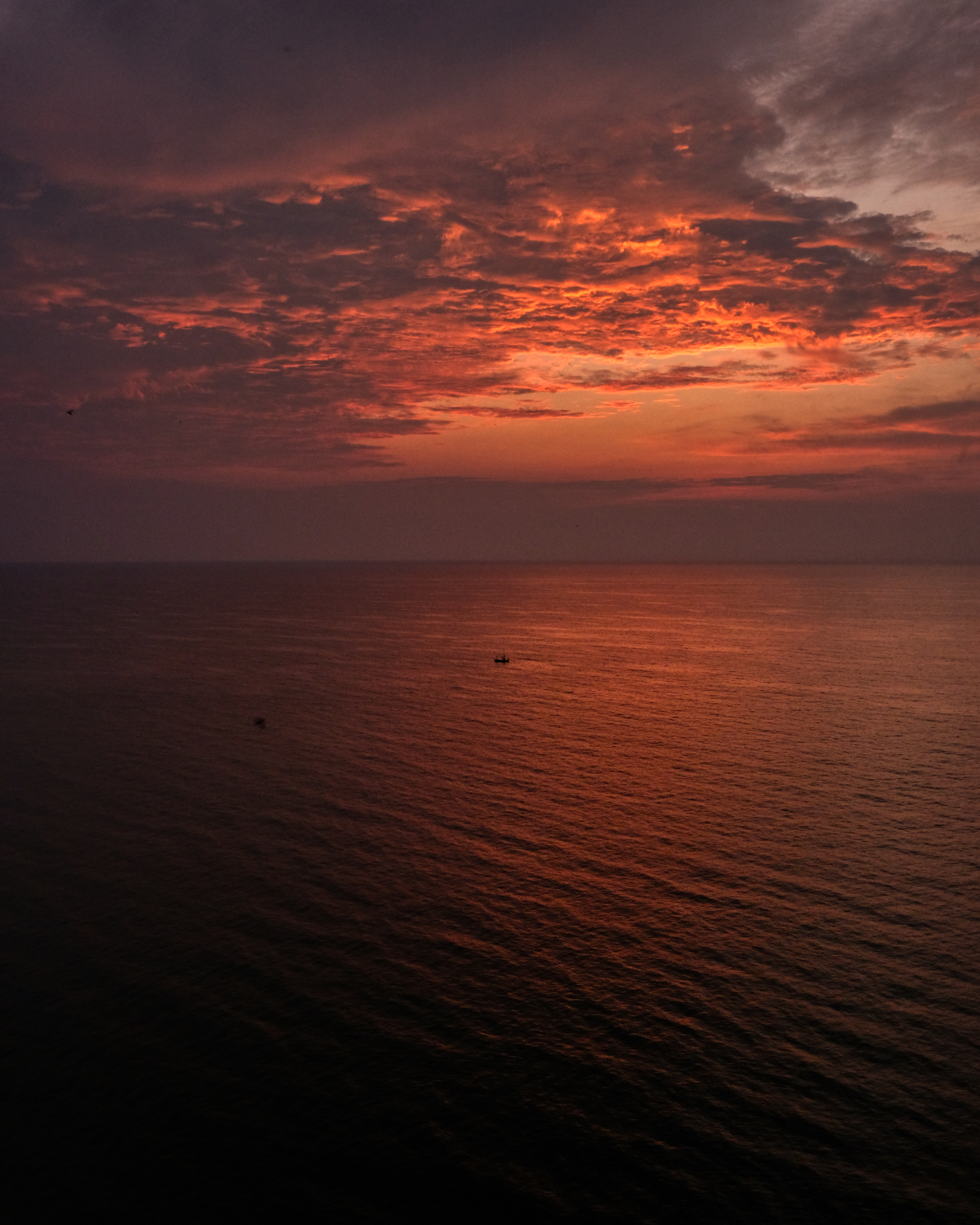 It's nice to sit on the balcony drinking the the first morning cup of coffee while the sun is rising over the Gulf of Thailand. The squid fishermen were returning with their catch after having been out to sea all night.
It's nice to sit on the balcony drinking the the first morning cup of coffee while the sun is rising over the Gulf of Thailand. The squid fishermen were returning with their catch after having been out to sea all night.
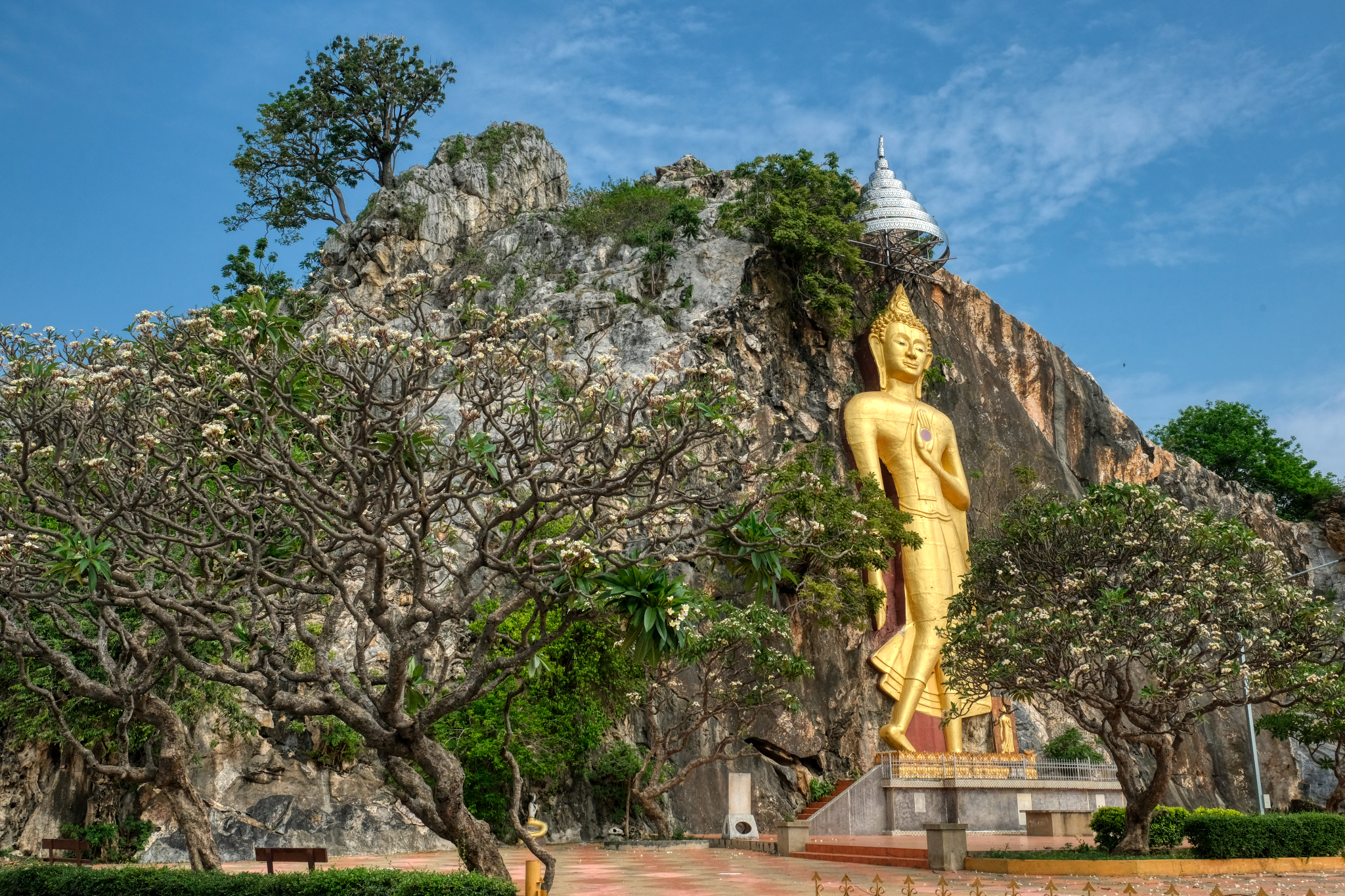 Along the Ratchaburi highway . . . a giant Buddha statue . . . without a place name.
Along the Ratchaburi highway . . . a giant Buddha statue . . . without a place name.
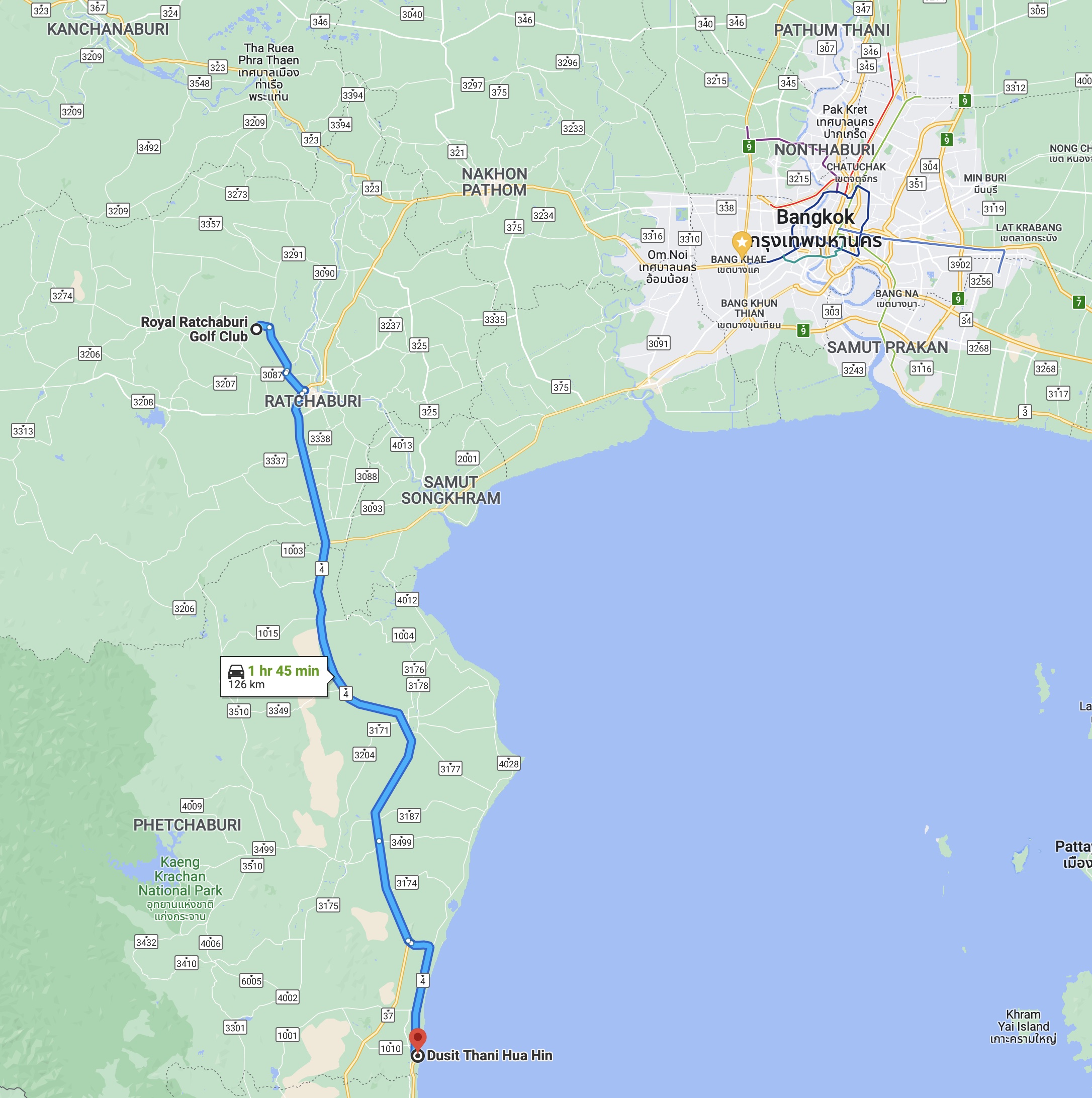 Only an hour and 45 minutes away . . . up and into the hilly Ratchaburi Province.
Only an hour and 45 minutes away . . . up and into the hilly Ratchaburi Province.
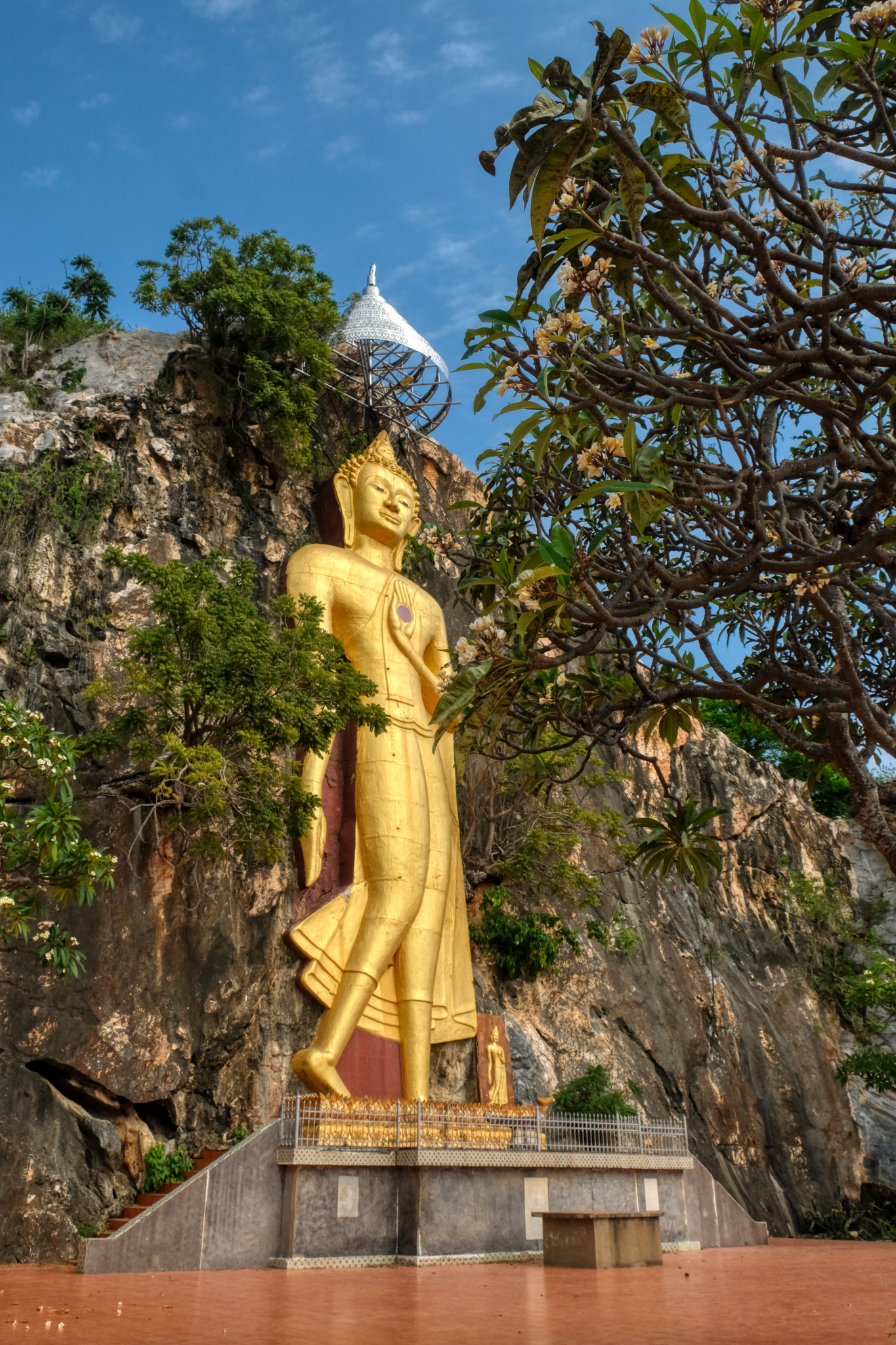 Small provincial roads in Thailand always serve up some amazing sights.
Small provincial roads in Thailand always serve up some amazing sights.
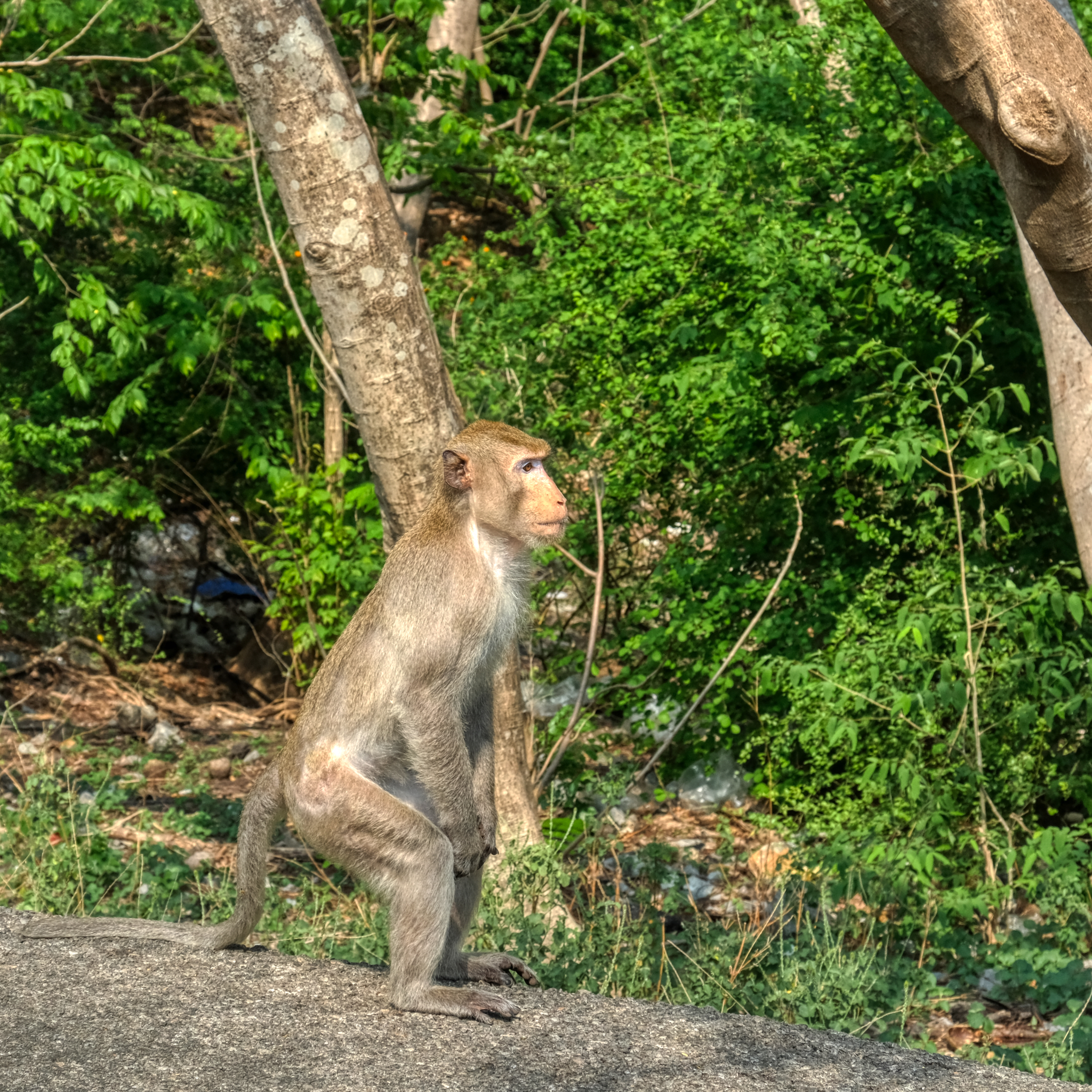 Yes, they have monkeys in Thailand. This one, and about 20 of his buddies kept me from leaving my car to walk up a trail to a large cave Buddha temple.
Yes, they have monkeys in Thailand. This one, and about 20 of his buddies kept me from leaving my car to walk up a trail to a large cave Buddha temple.
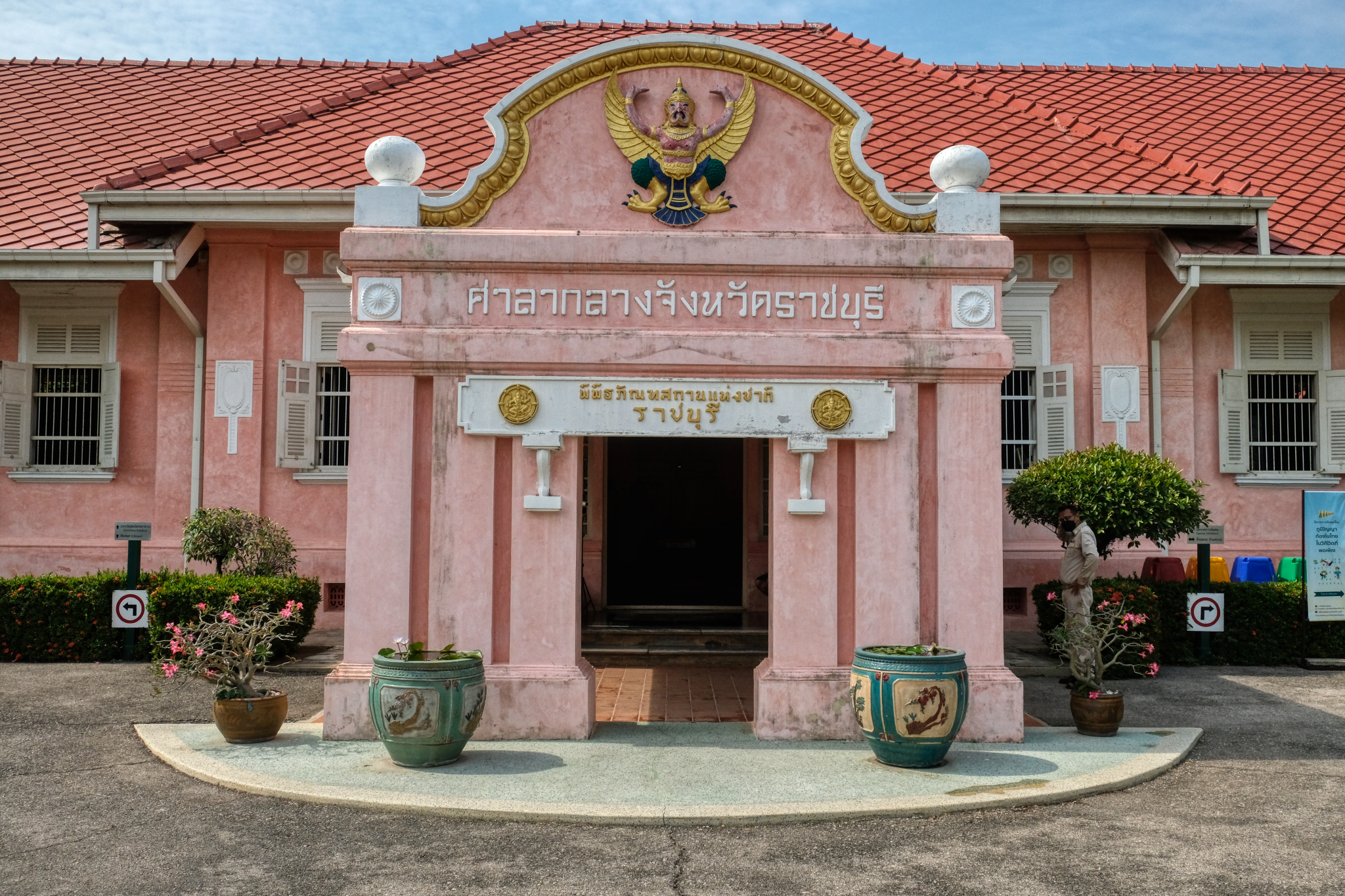 As I was on a 'ramble', I had no particular place to go. I made my way to Ratchaburi, a town I had never visited. I arrived in Ratchaburi on small roads and on the outskirts of town I discovered this wonderful place: The Ratchaburi National Museum.
As I was on a 'ramble', I had no particular place to go. I made my way to Ratchaburi, a town I had never visited. I arrived in Ratchaburi on small roads and on the outskirts of town I discovered this wonderful place: The Ratchaburi National Museum.
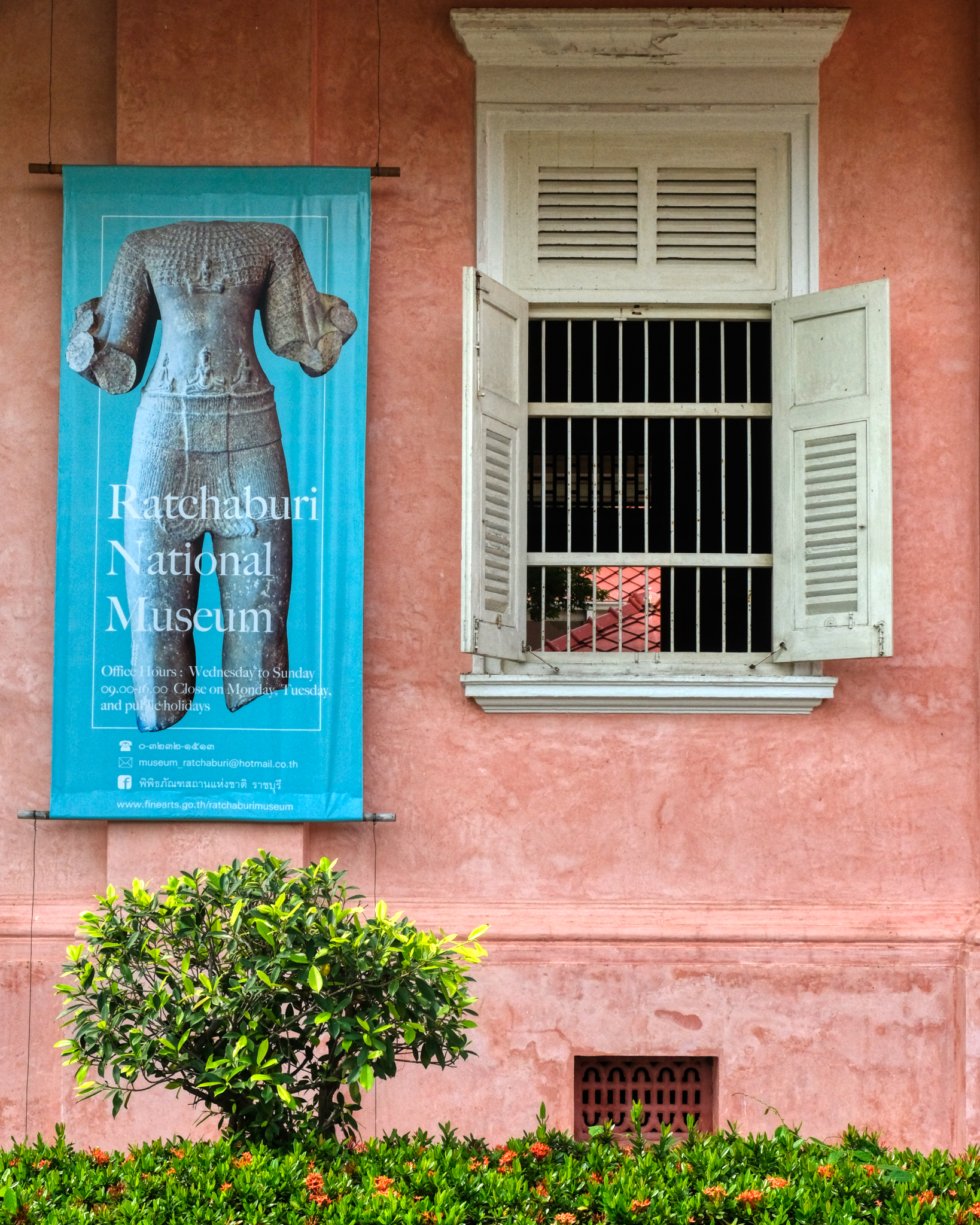 It was a gorgeous building . . . old Thai monumental style.
It was a gorgeous building . . . old Thai monumental style.
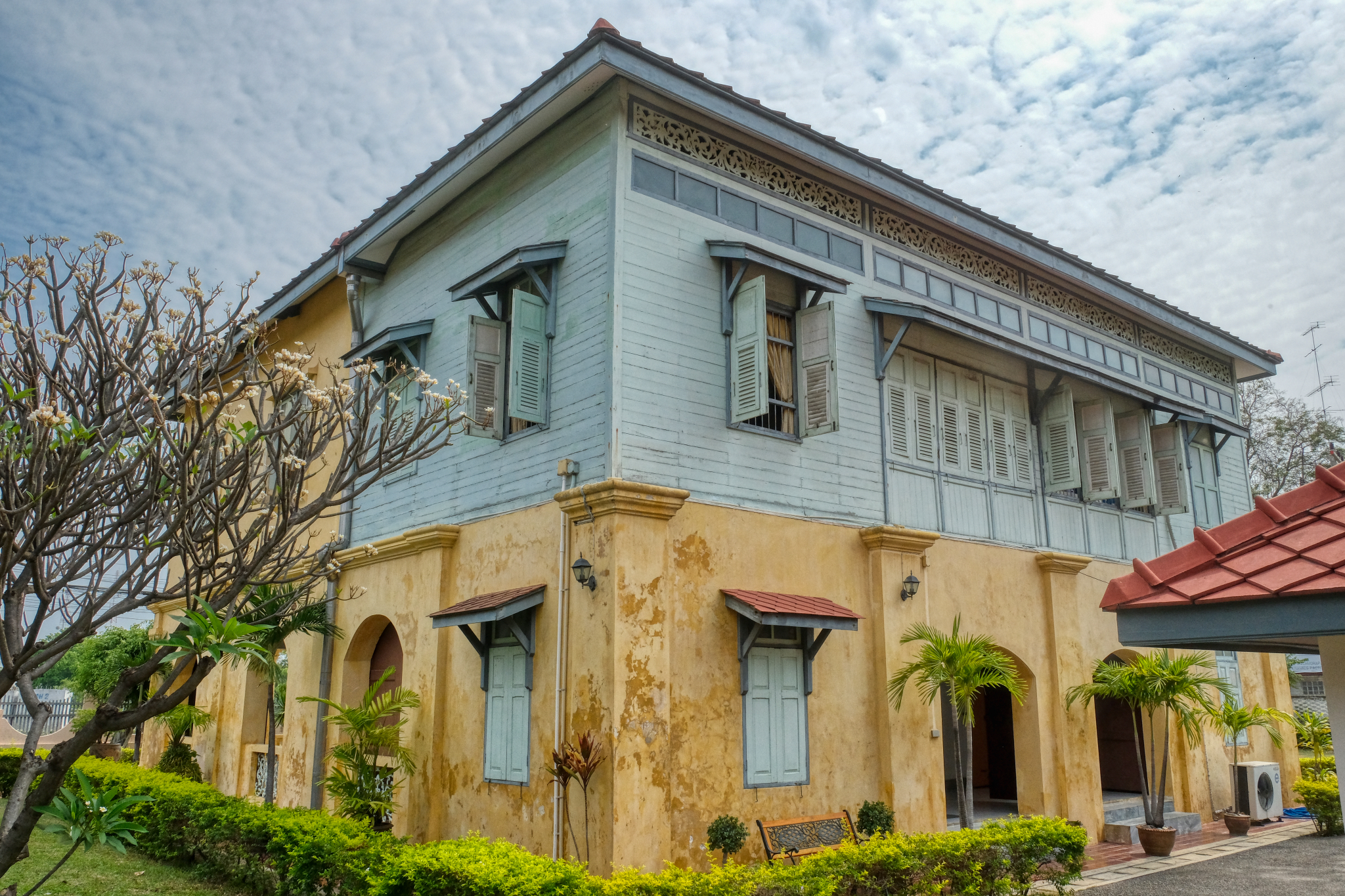 There were two buildings on the museum property. I adored the patina, color, and style of this old gem.
There were two buildings on the museum property. I adored the patina, color, and style of this old gem.
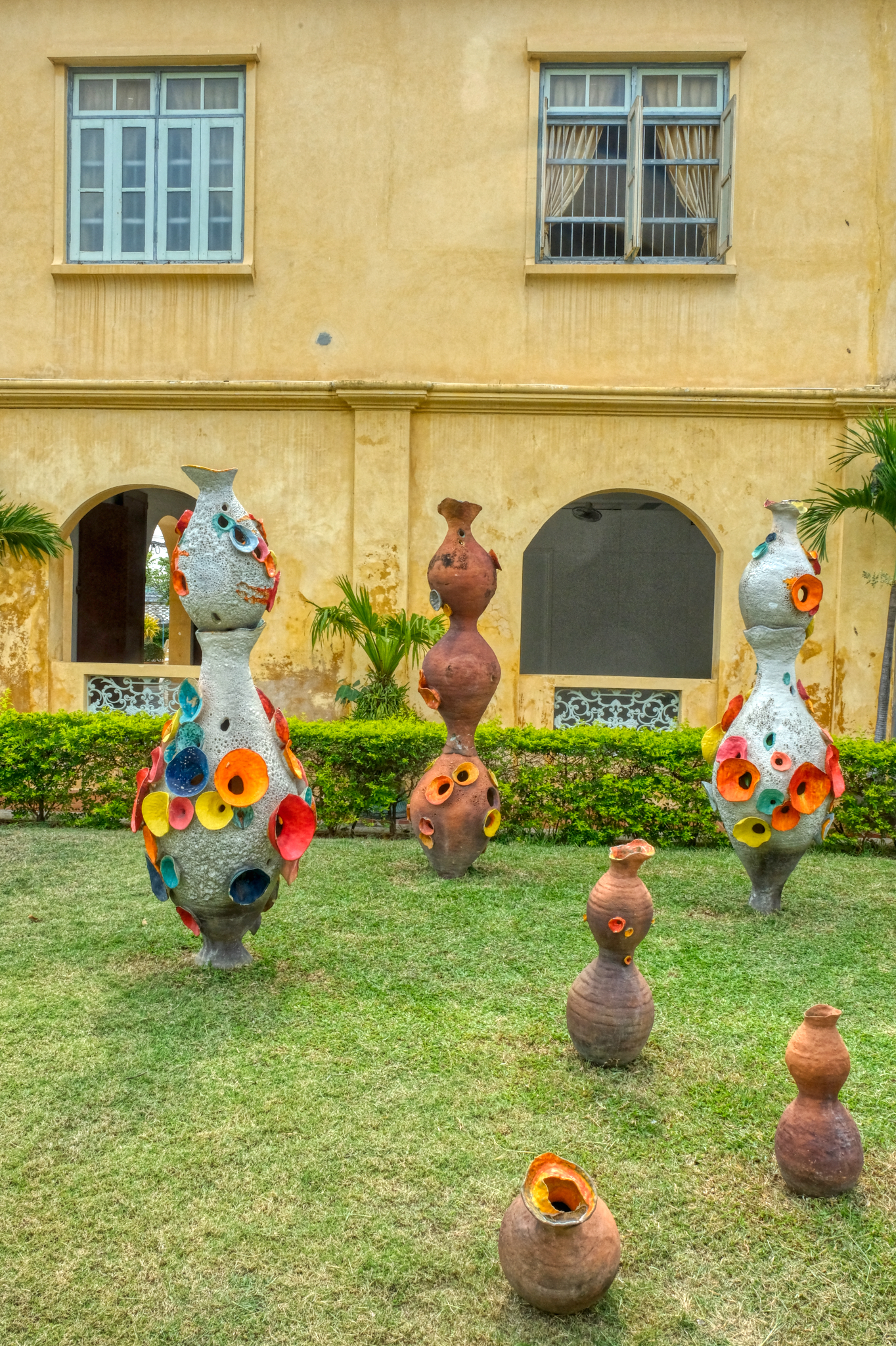 Being a museum, they had yard art too.
Being a museum, they had yard art too.
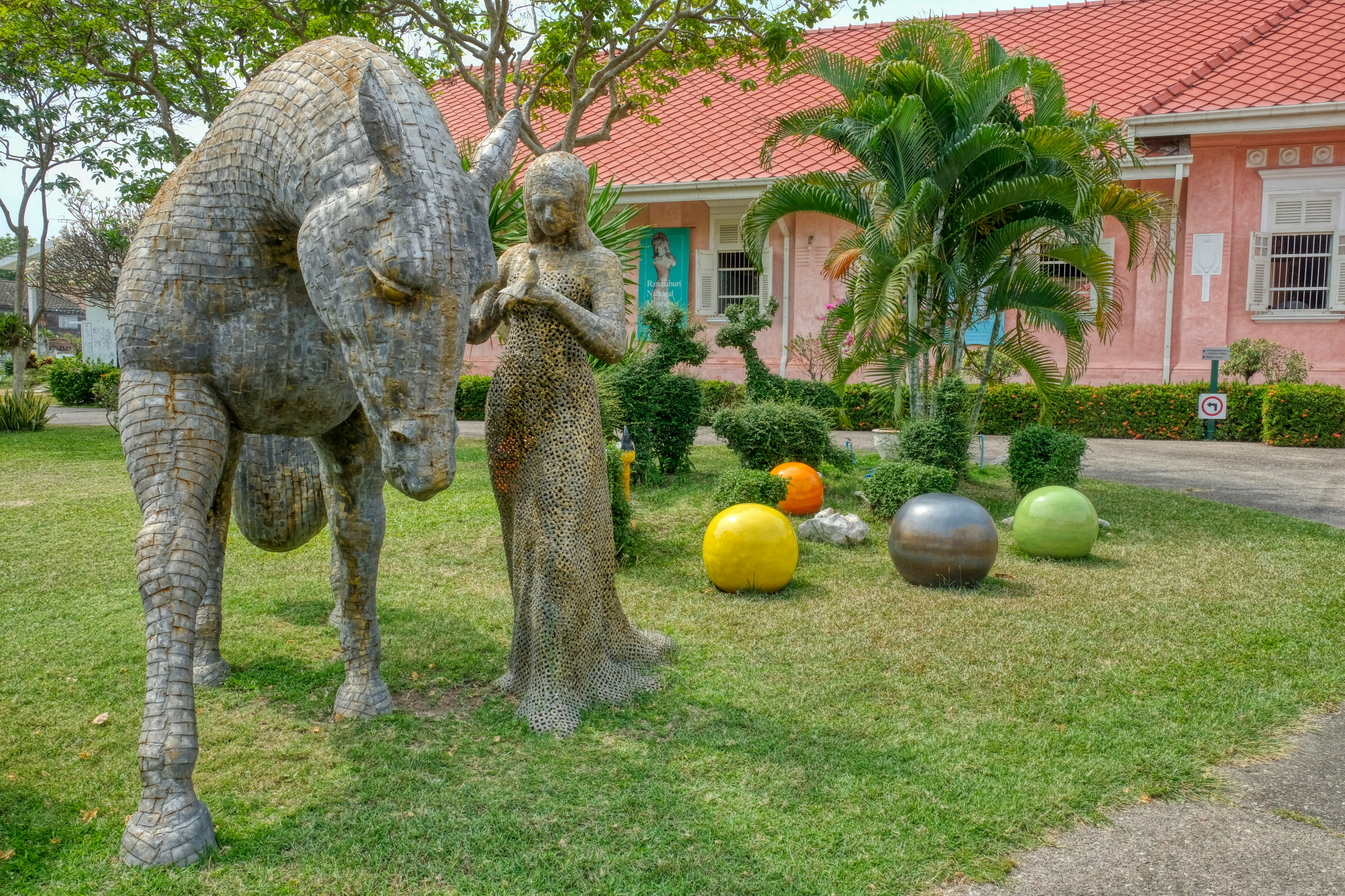 This large metal sculpture was fantastic.
This large metal sculpture was fantastic.
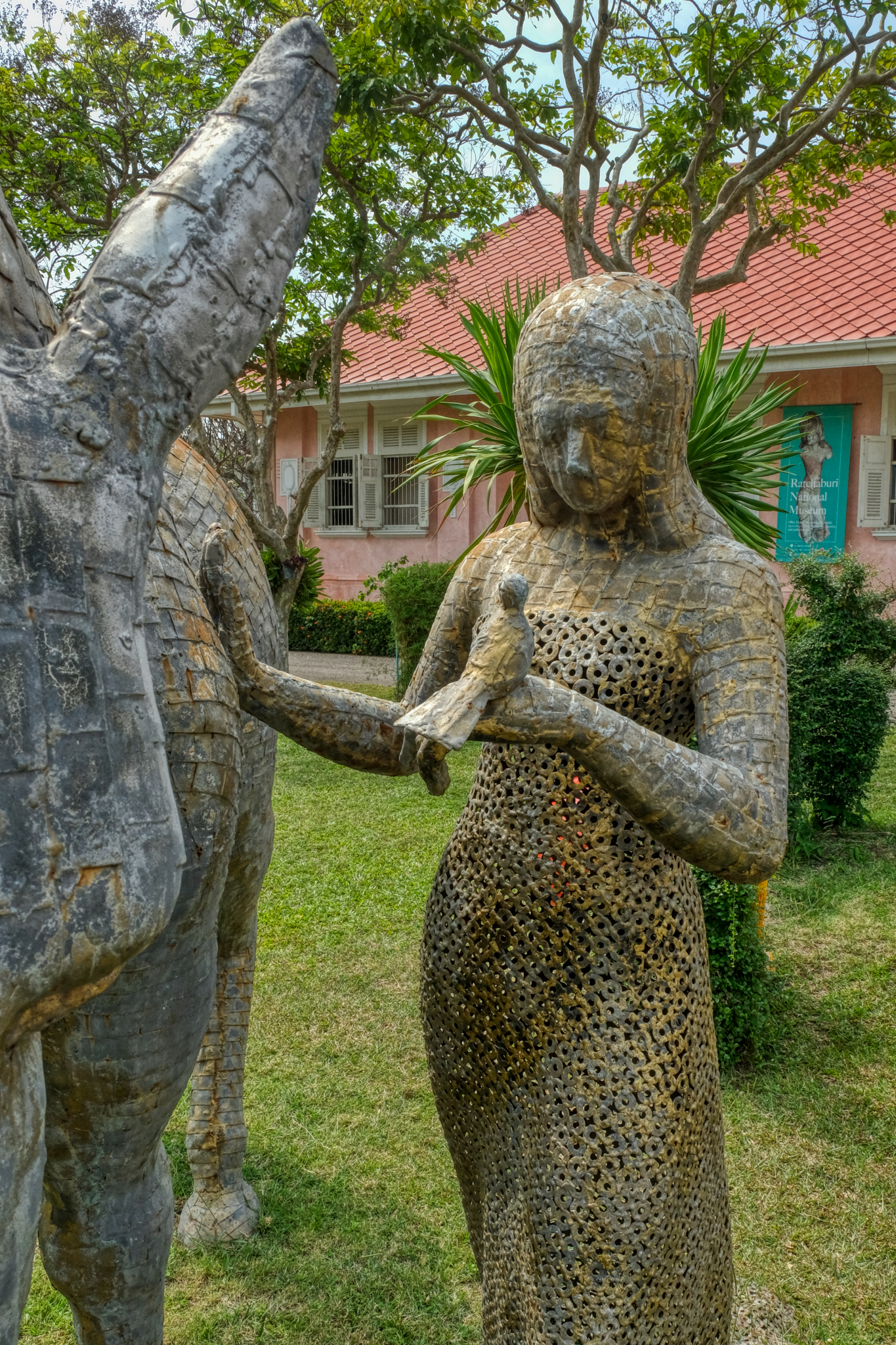 Made entirely of ordinary steel washers and small squares of steel. Amazing.
Made entirely of ordinary steel washers and small squares of steel. Amazing.
 The museum rules strictly prohibited photography of the exhibits . . . and they enforced this rule by having one of the museum staff follow me from room to room. They did, however, allow me to photograph the halls and courtyard when I asked.
The museum rules strictly prohibited photography of the exhibits . . . and they enforced this rule by having one of the museum staff follow me from room to room. They did, however, allow me to photograph the halls and courtyard when I asked.
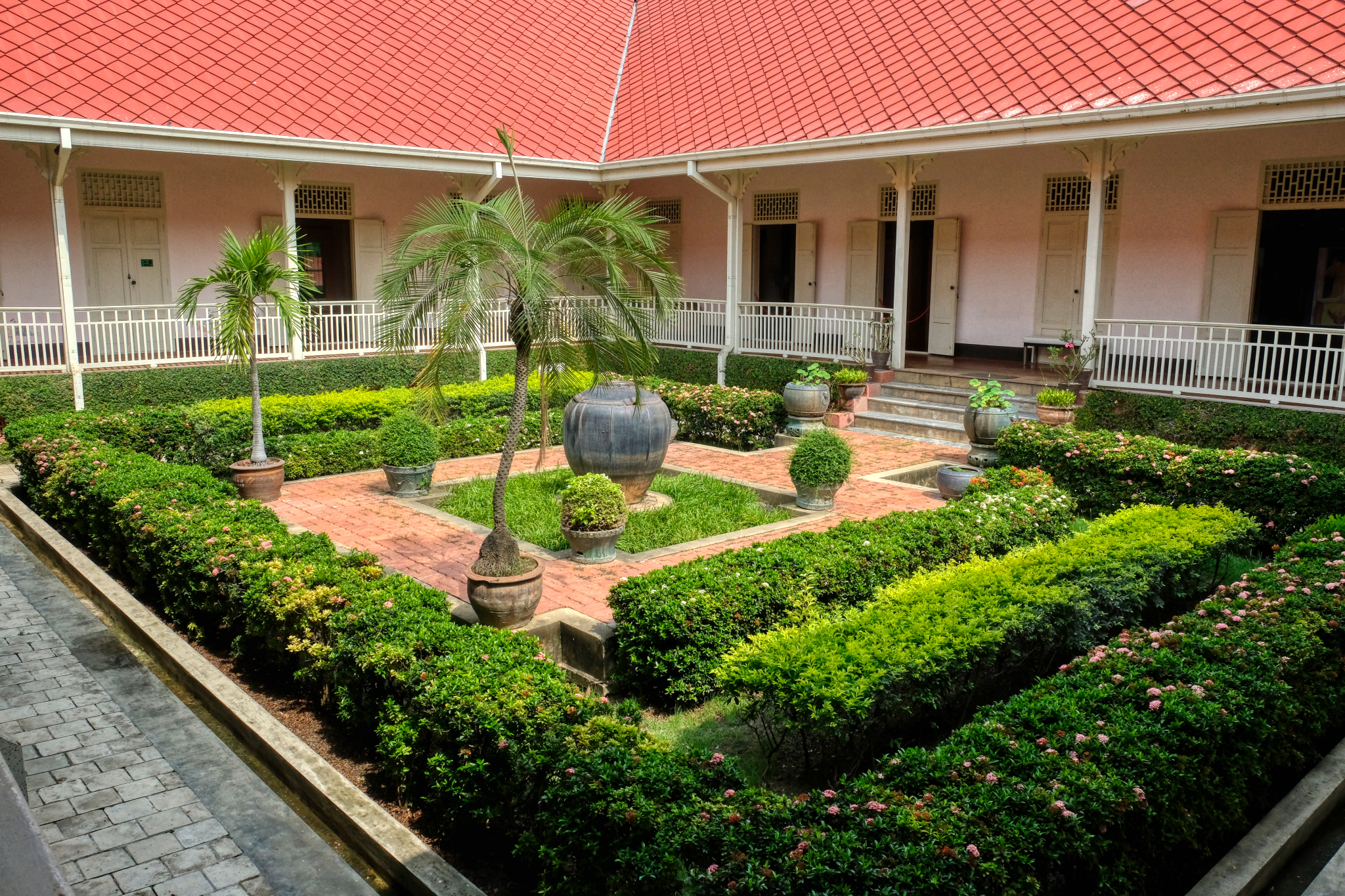 The museum collection was excellent and very well organized. The exhibits began in prehistory and ancient geology of the area and proceeded chronologically as you walked from room to room around the courtyard. It was one of the best, most informative provincial museums I have been to anywhere in the world.
The museum collection was excellent and very well organized. The exhibits began in prehistory and ancient geology of the area and proceeded chronologically as you walked from room to room around the courtyard. It was one of the best, most informative provincial museums I have been to anywhere in the world.
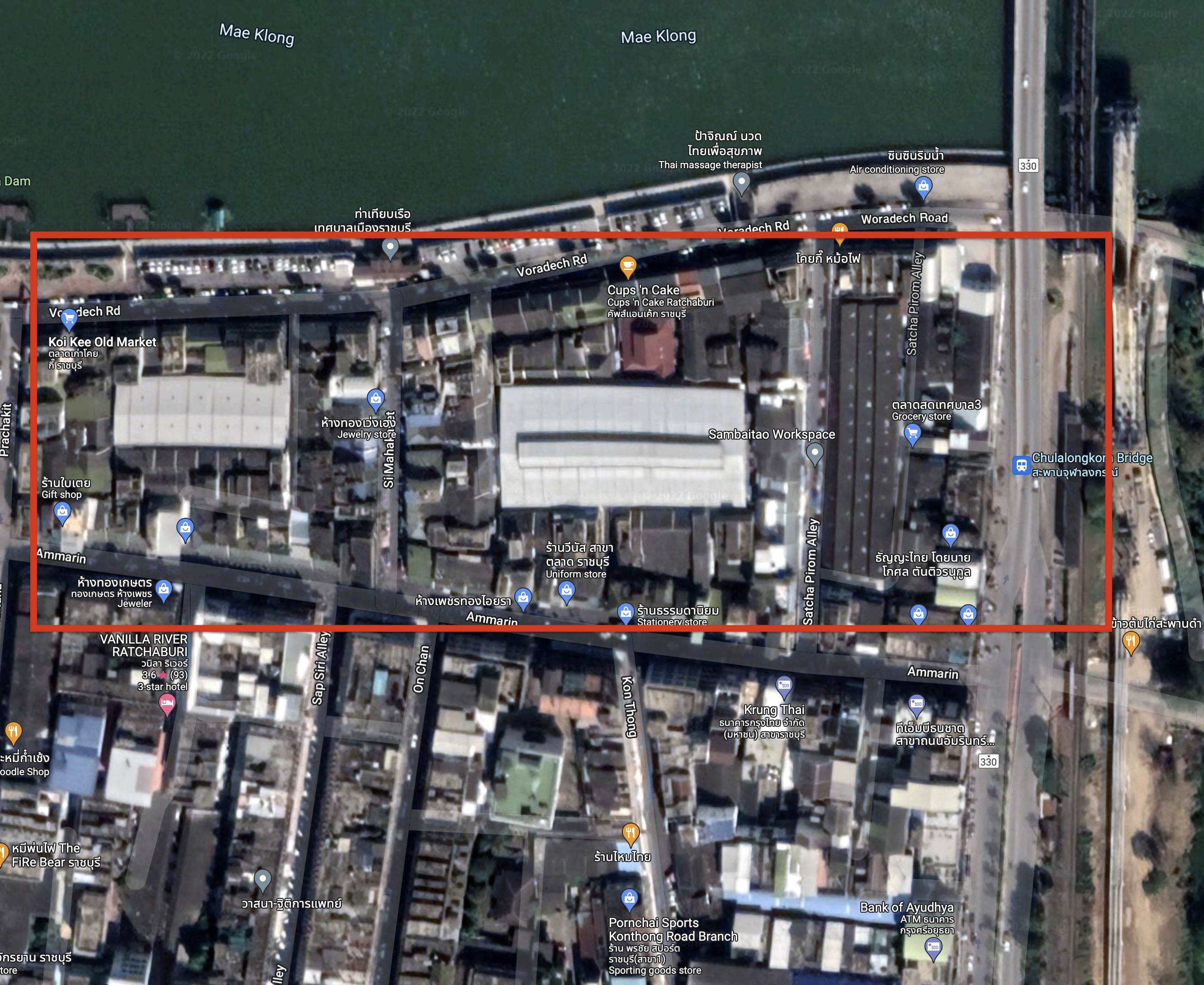 I next drove into the town center and the old city center market. The market occupies the inside center alleyways of several blocks along the Mae Klong River.
I next drove into the town center and the old city center market. The market occupies the inside center alleyways of several blocks along the Mae Klong River.
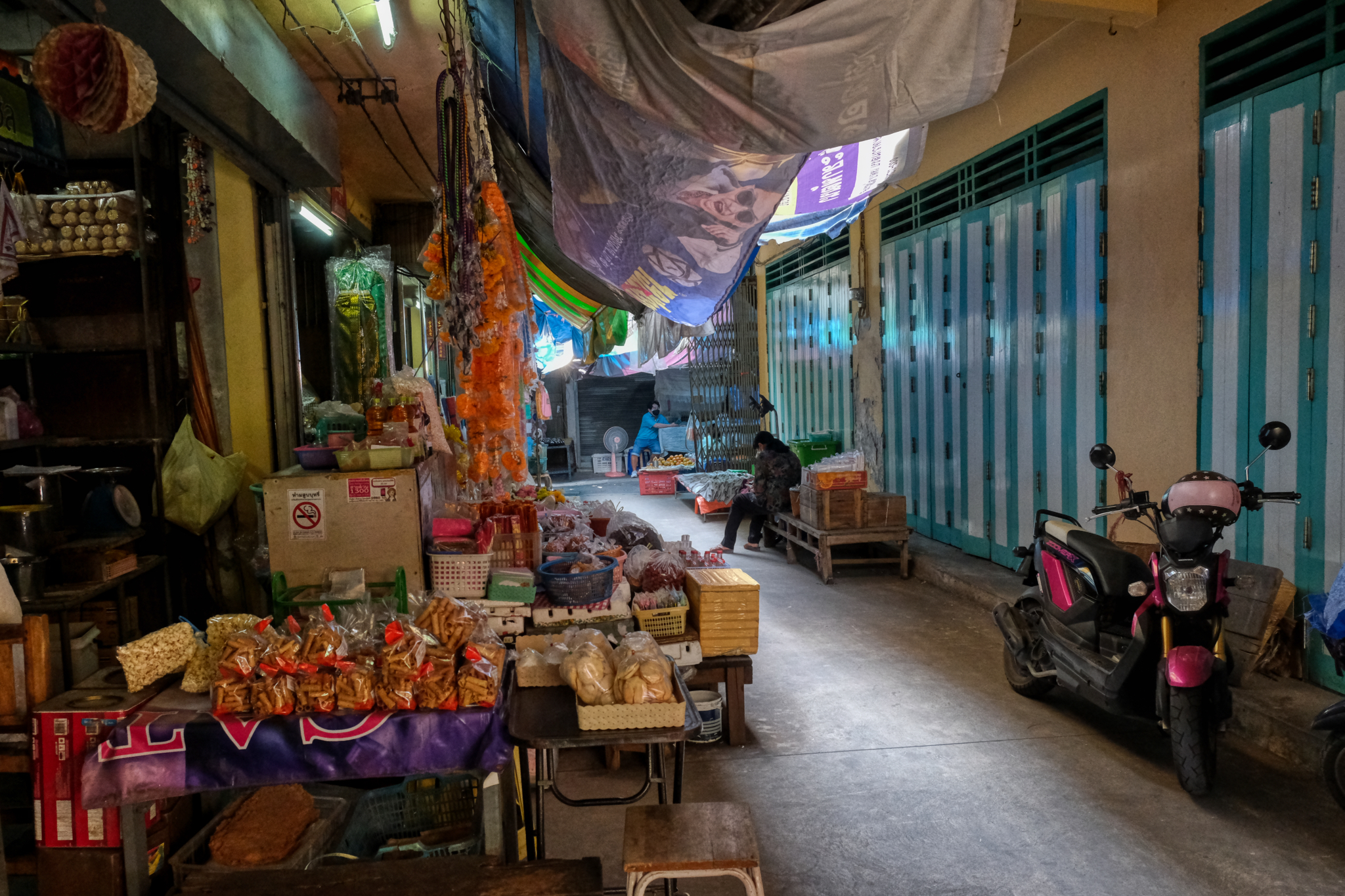 As I left the museum I looked on my GoogleMaps and spotted a river and "Old Town Market" . . . so I drove straight there. I love these old town, city center markets in Thailand's small cities. This market would have been in it's prime during the 1950s and 1960s.
As I left the museum I looked on my GoogleMaps and spotted a river and "Old Town Market" . . . so I drove straight there. I love these old town, city center markets in Thailand's small cities. This market would have been in it's prime during the 1950s and 1960s.
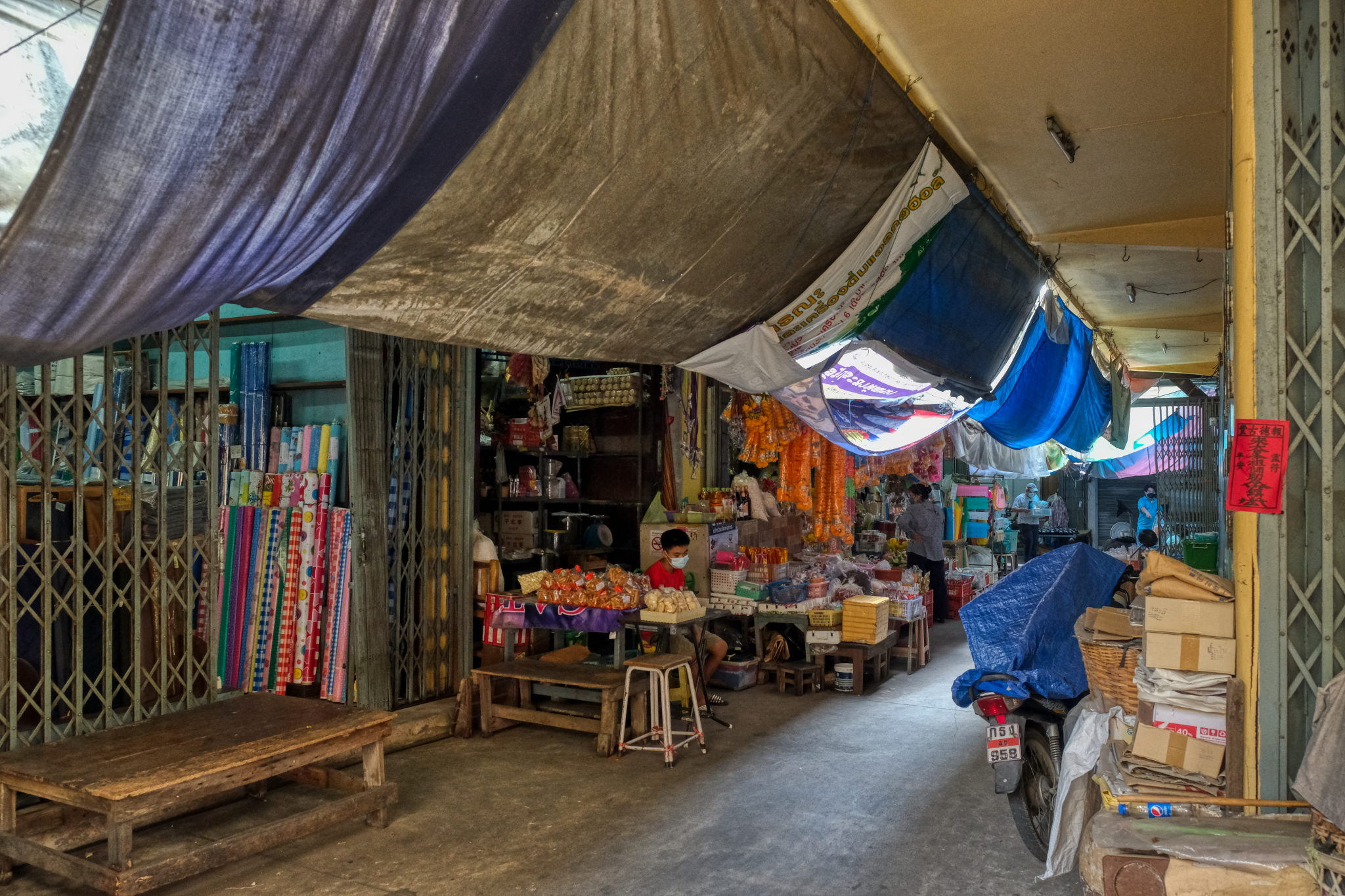 The old markets are the remnants of the oldest parts of Thai cities and maintain an older way of doing business.
The old markets are the remnants of the oldest parts of Thai cities and maintain an older way of doing business.
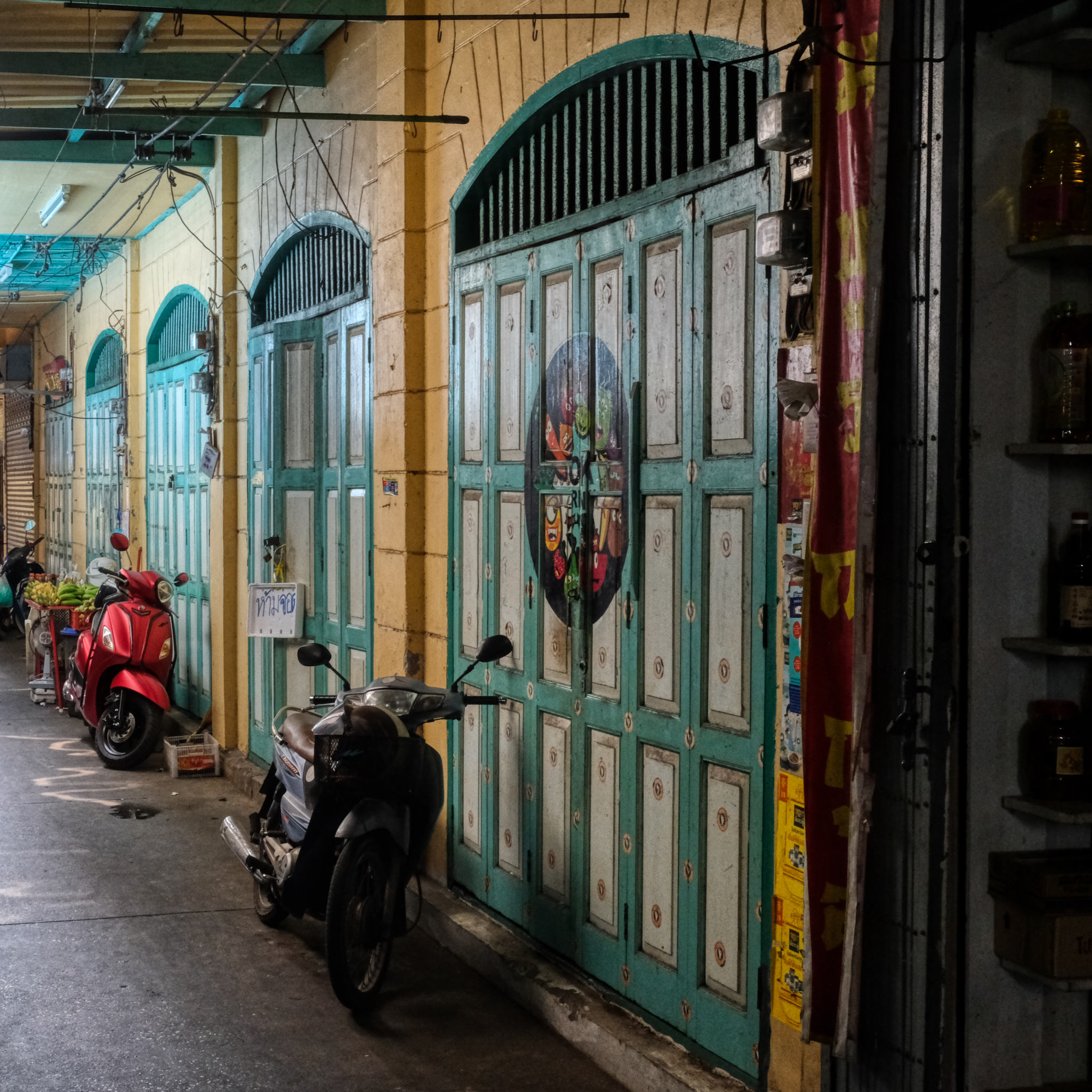 The city or local area government seems to have taken an interest in this old market. Many of the walls and old panel doors seem to have been painted recently. It looked very good.
The city or local area government seems to have taken an interest in this old market. Many of the walls and old panel doors seem to have been painted recently. It looked very good.
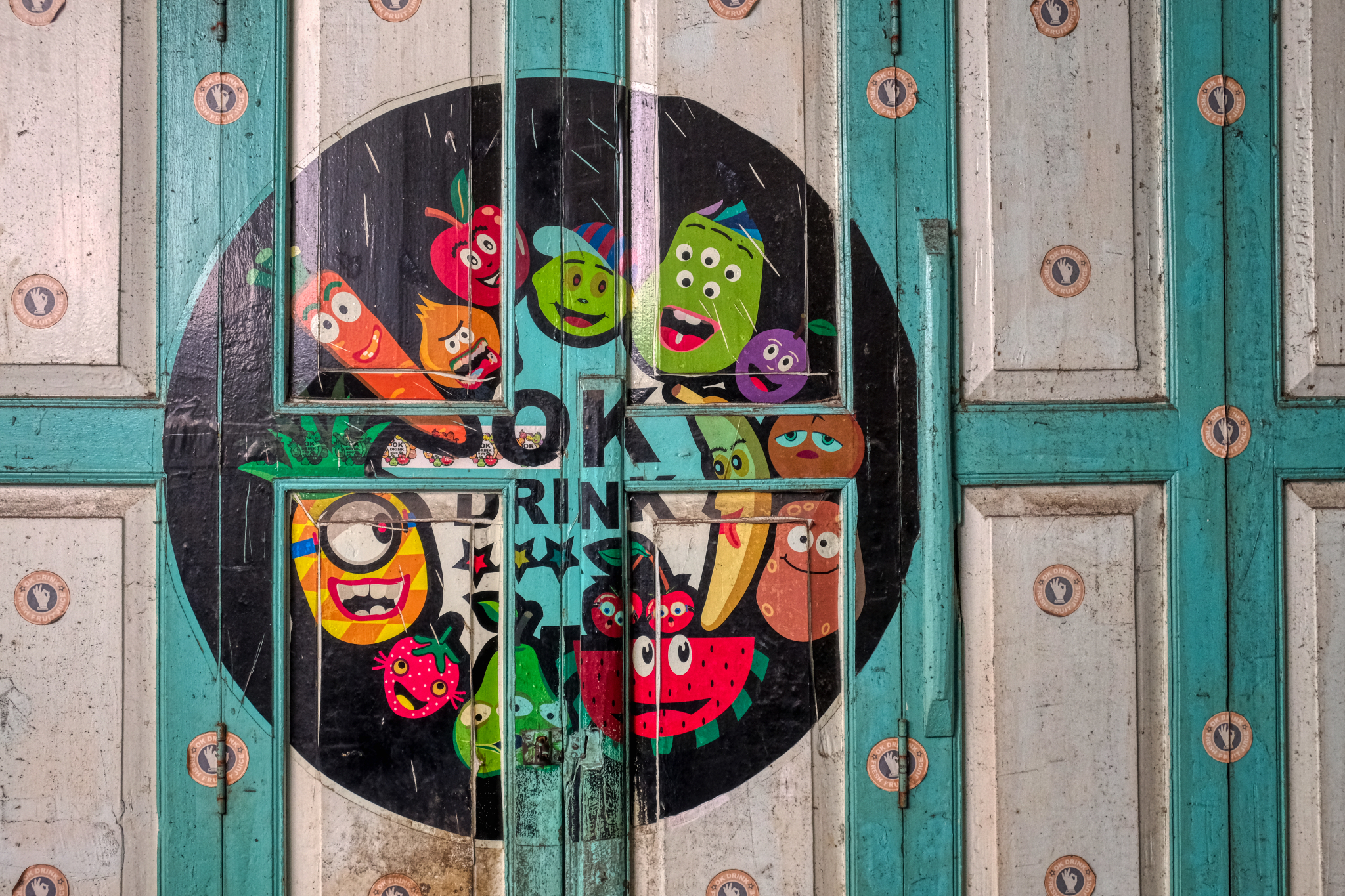 A colorful advertisement on the panel doors.
A colorful advertisement on the panel doors.
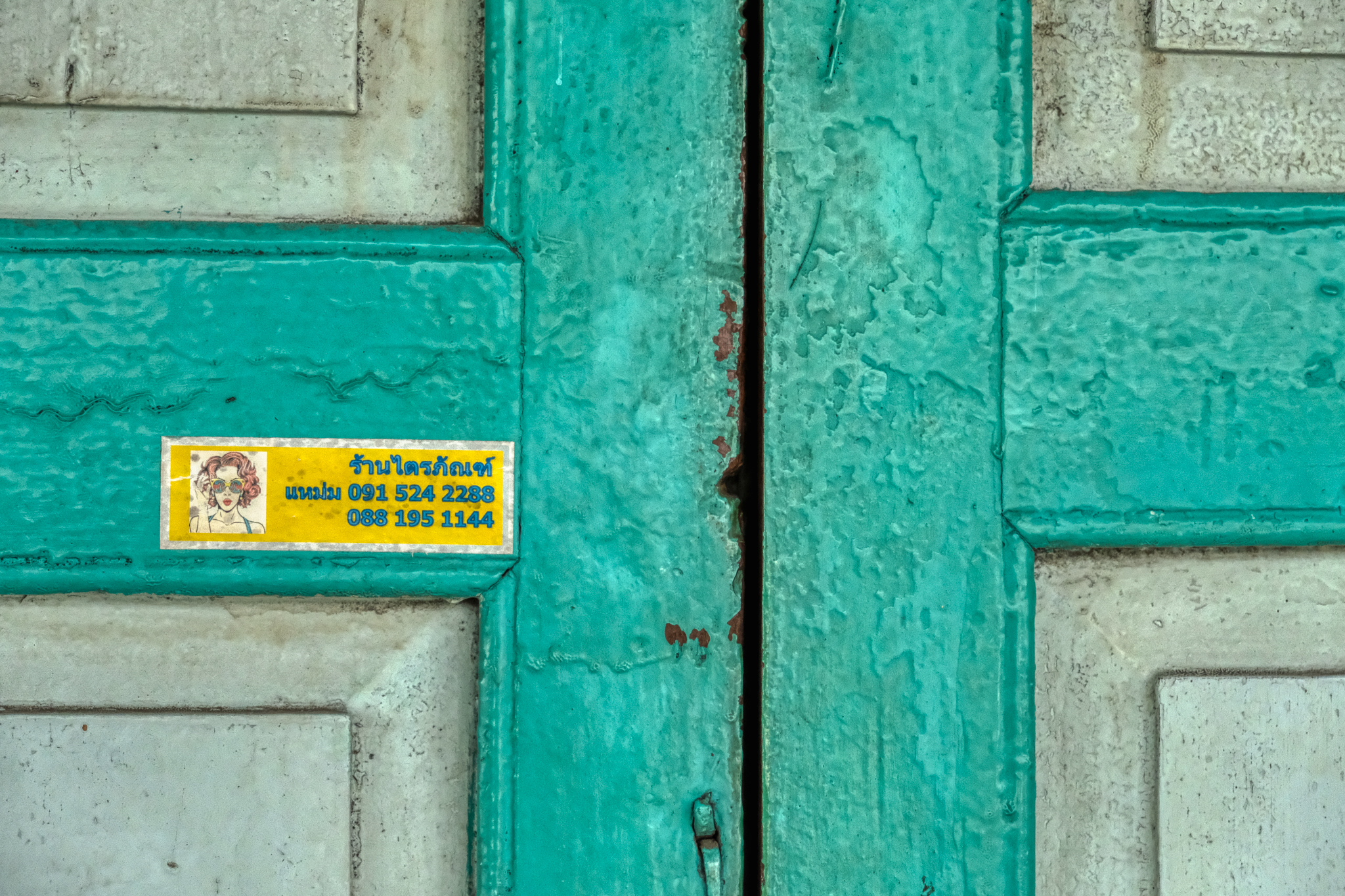 History in paint.
History in paint.
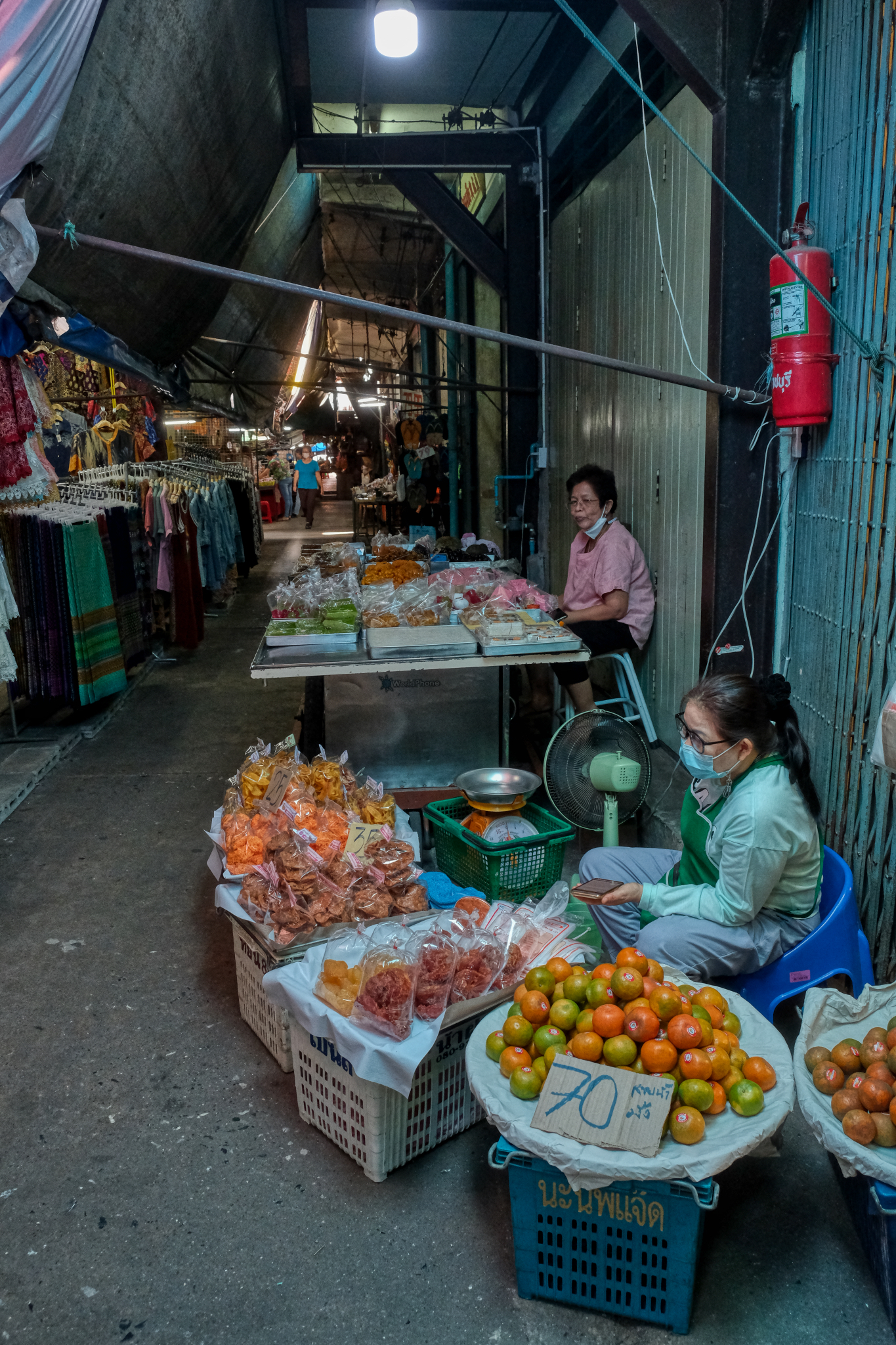 Small business in the alleys, which are themselves lined with very old small shops.
Small business in the alleys, which are themselves lined with very old small shops.
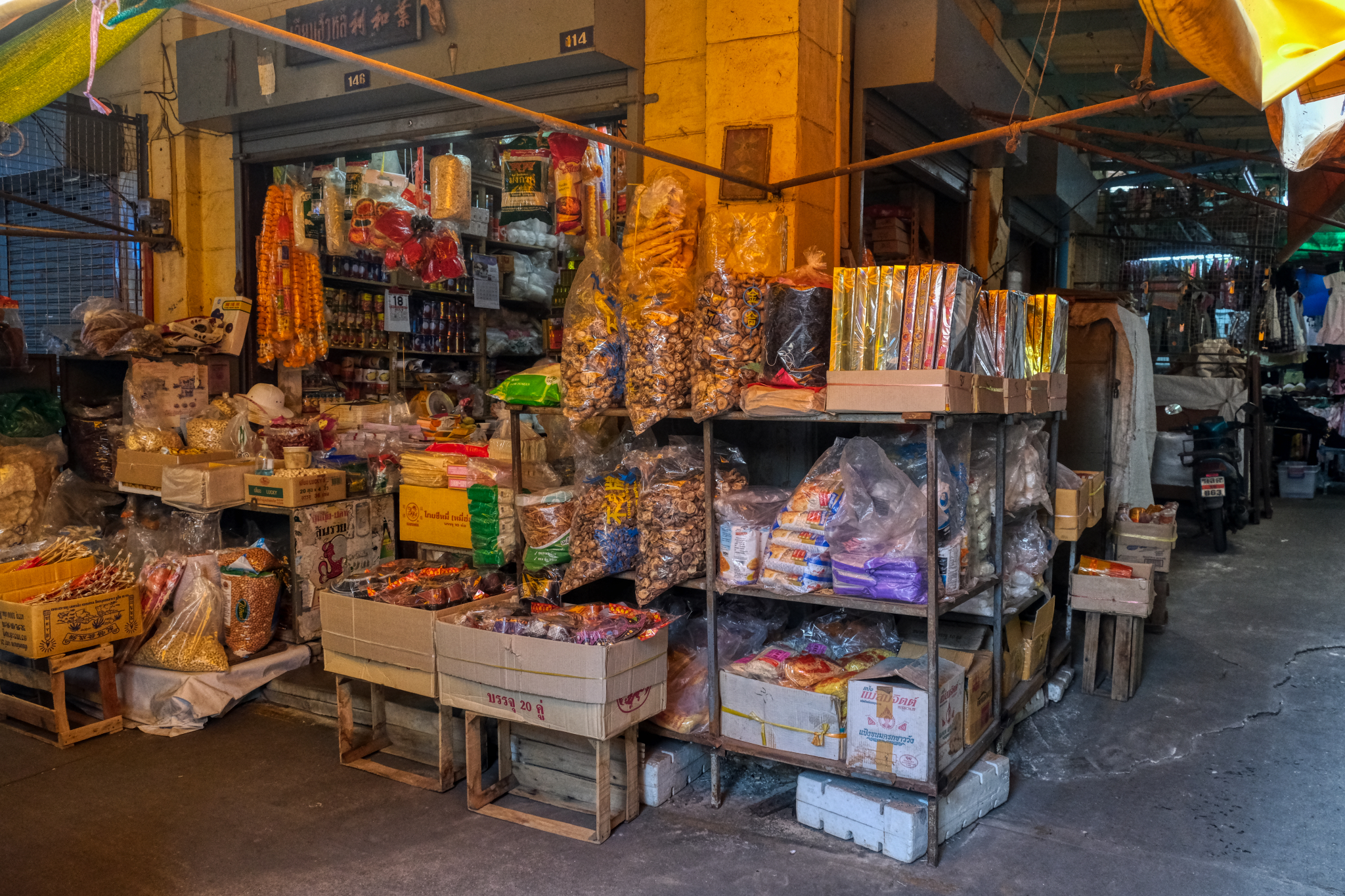 My first thought when seeing this shop was, 'supply and demand.' What kind of world is outside of this market can be deduced by what one sees for sale in it. There is an old pattern of consumption, imbedded in the cultural practices, the anthropology of food, that still demands these items.
My first thought when seeing this shop was, 'supply and demand.' What kind of world is outside of this market can be deduced by what one sees for sale in it. There is an old pattern of consumption, imbedded in the cultural practices, the anthropology of food, that still demands these items.
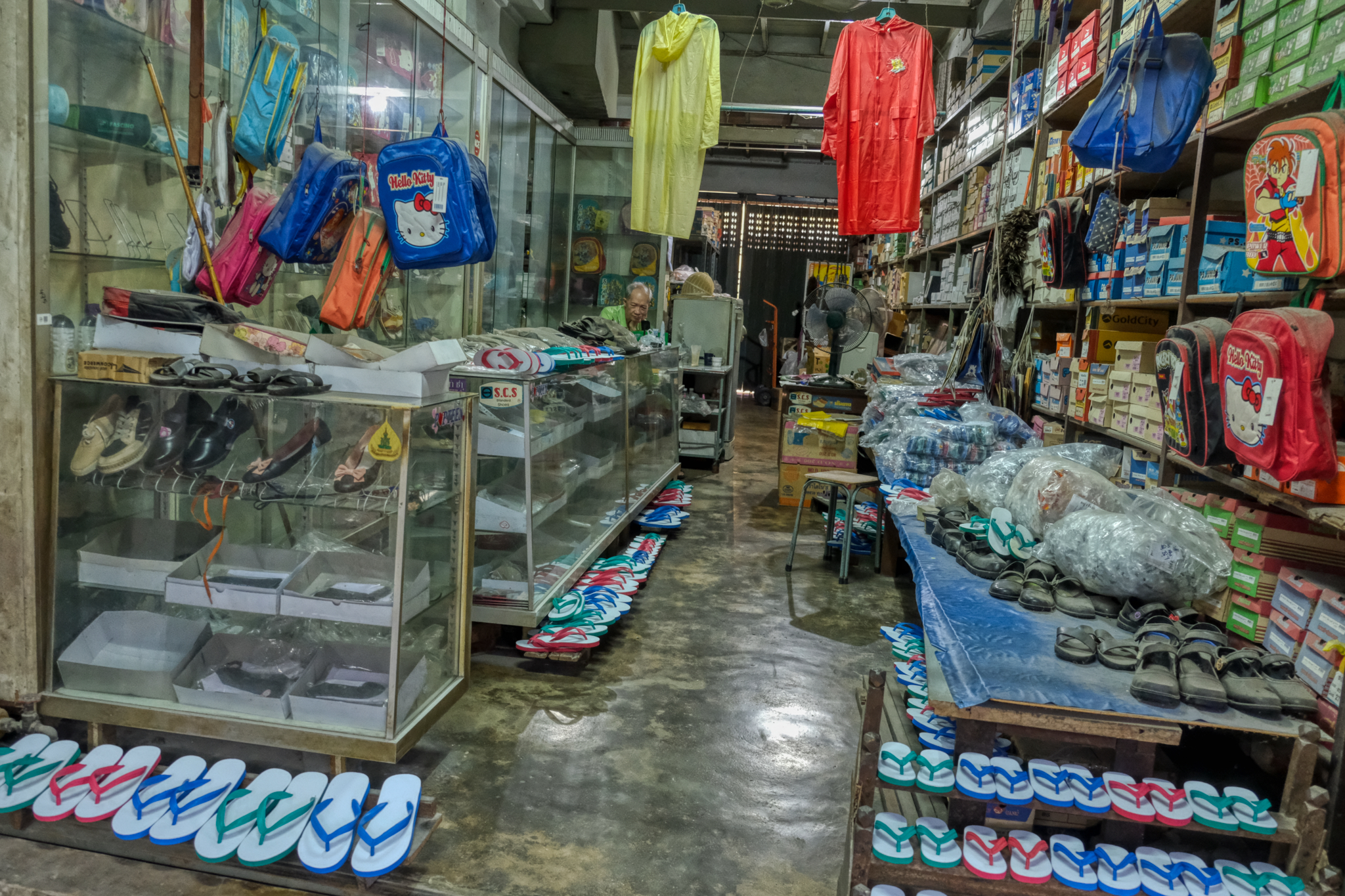 Times change. There was a time, maybe 50 years ago, when this shop was at the center of the Ratchaburi commercial center. You came here, and here only, if you wanted to buy a pair of new shoes. But the city grew in a different direction: what was the busy hub of activity has now became the backwater of the old town 'wet market.' This old man seems to have been here as long as the furniture. He doesn't even bother to dust off the shoes any more.
Times change. There was a time, maybe 50 years ago, when this shop was at the center of the Ratchaburi commercial center. You came here, and here only, if you wanted to buy a pair of new shoes. But the city grew in a different direction: what was the busy hub of activity has now became the backwater of the old town 'wet market.' This old man seems to have been here as long as the furniture. He doesn't even bother to dust off the shoes any more.
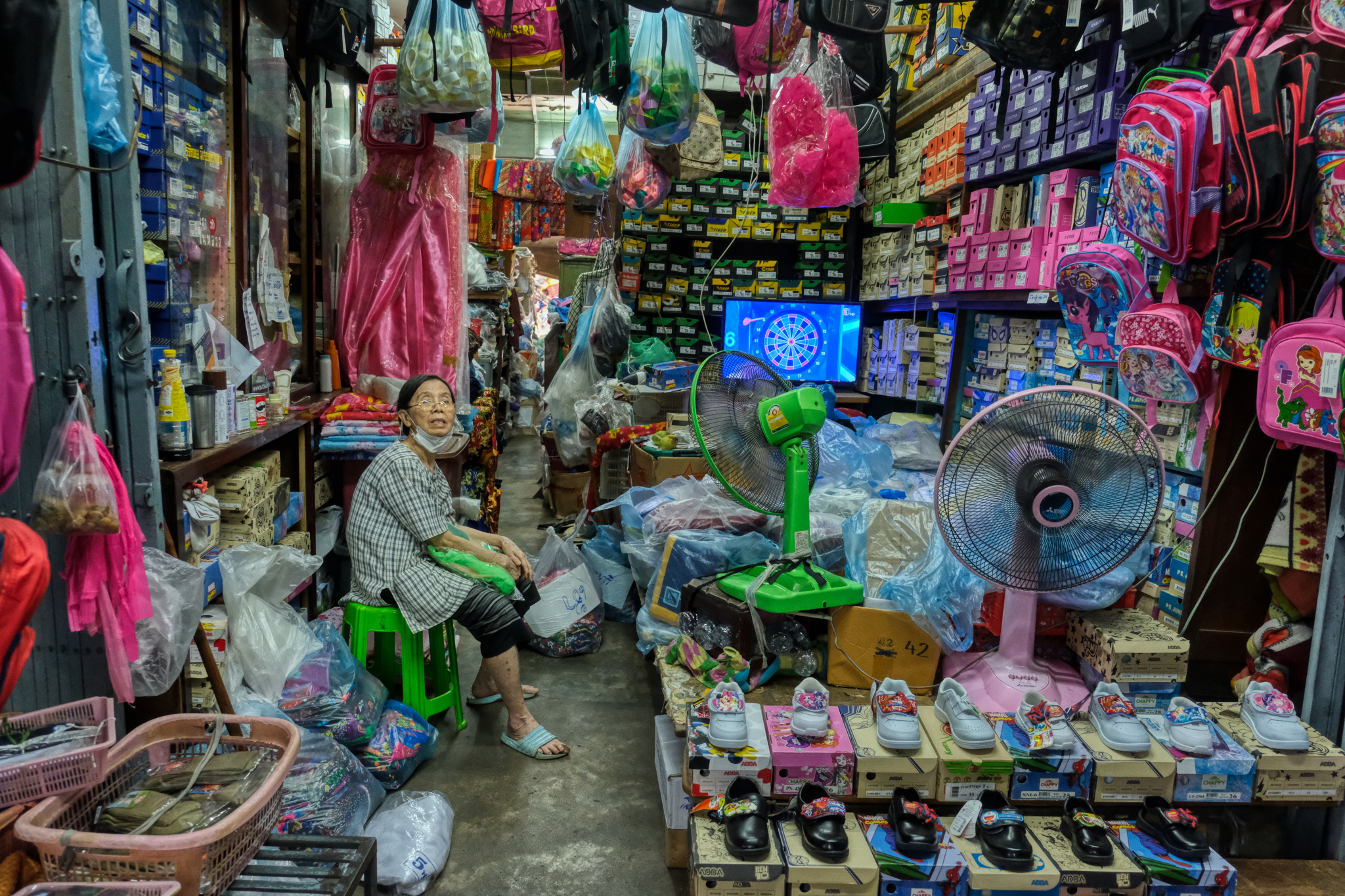 She is still hopeful and making an effort. These shops have suffered terribly during the pandemic: people do not like to congregate in the tight quarters of these narrow alleyways. I am sure she lives in the back of this shop.
She is still hopeful and making an effort. These shops have suffered terribly during the pandemic: people do not like to congregate in the tight quarters of these narrow alleyways. I am sure she lives in the back of this shop.
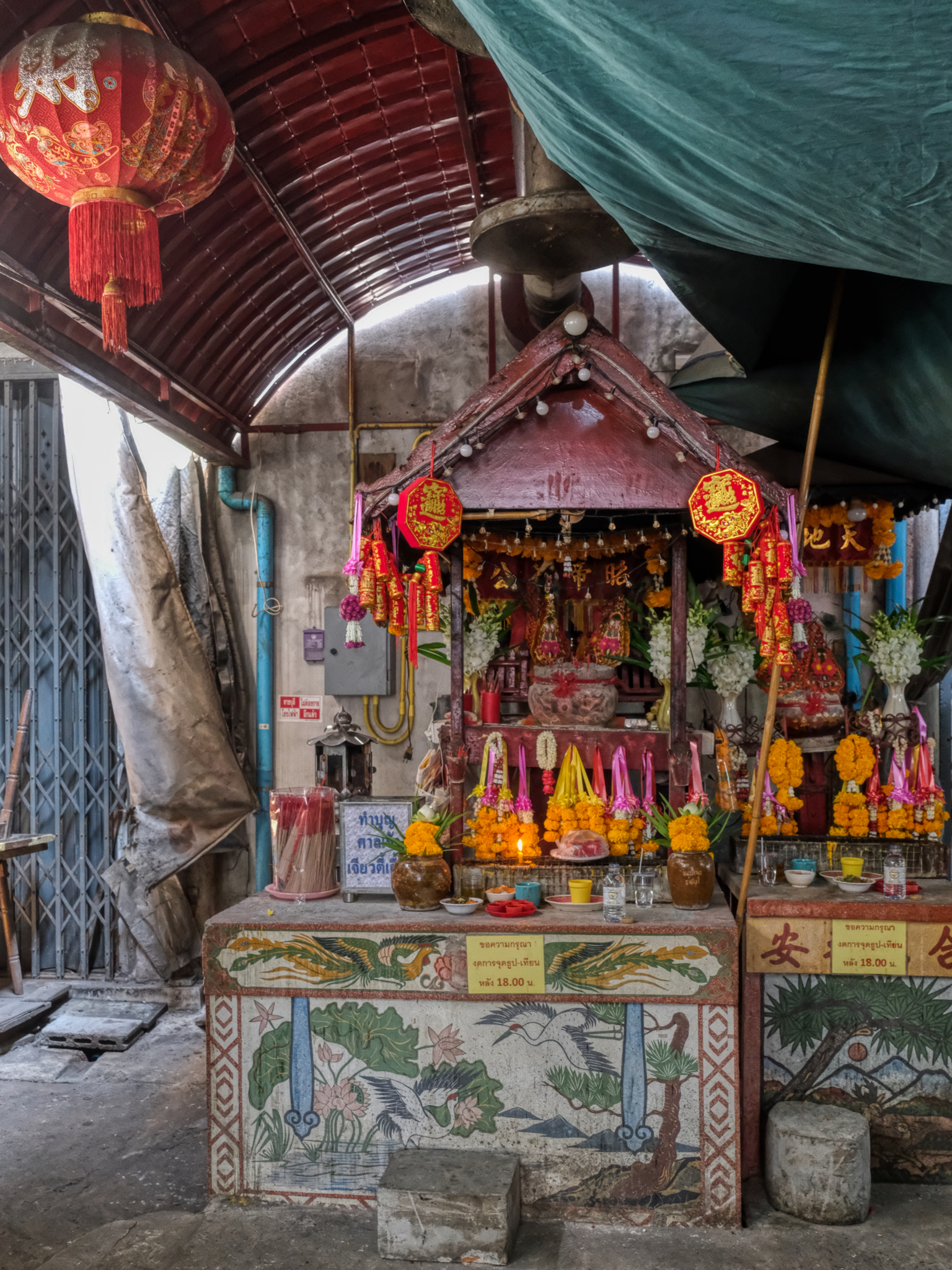 Tucked away deep in the old market is the spirit house/spirit altar for the shopkeepers to leave their offerings in hopes of better luck. The flowers and other offerings were all fresh from this very morning.
Tucked away deep in the old market is the spirit house/spirit altar for the shopkeepers to leave their offerings in hopes of better luck. The flowers and other offerings were all fresh from this very morning.
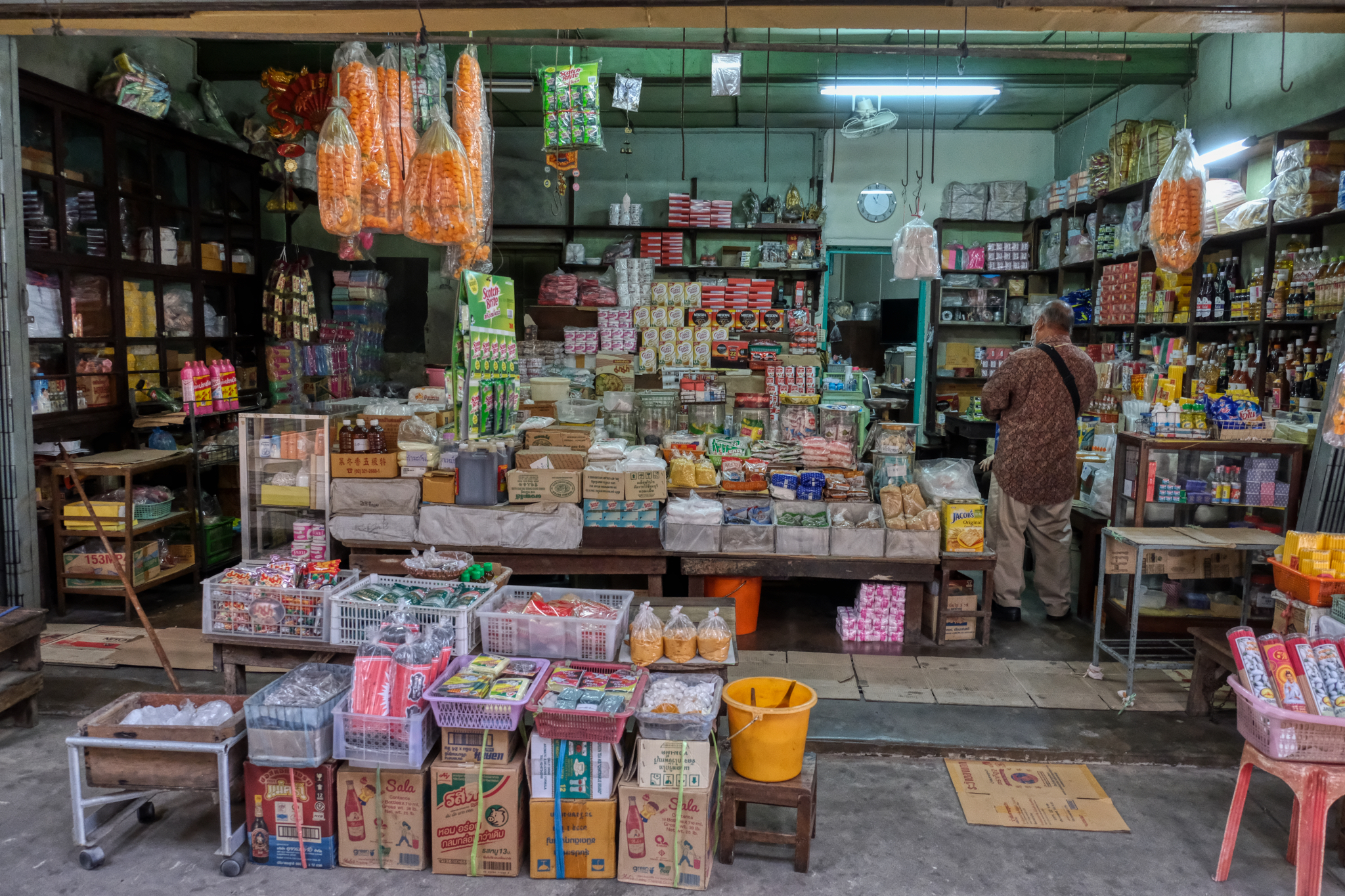 This dry goods shop in the old market seemed to be doing pretty good. You have to remember that less than a mile from this spot there are several multinational big box giant supermarkets. It is hard to understand how these small shops survive. I assume it survives by servicing those who work in the old market itself.
This dry goods shop in the old market seemed to be doing pretty good. You have to remember that less than a mile from this spot there are several multinational big box giant supermarkets. It is hard to understand how these small shops survive. I assume it survives by servicing those who work in the old market itself.
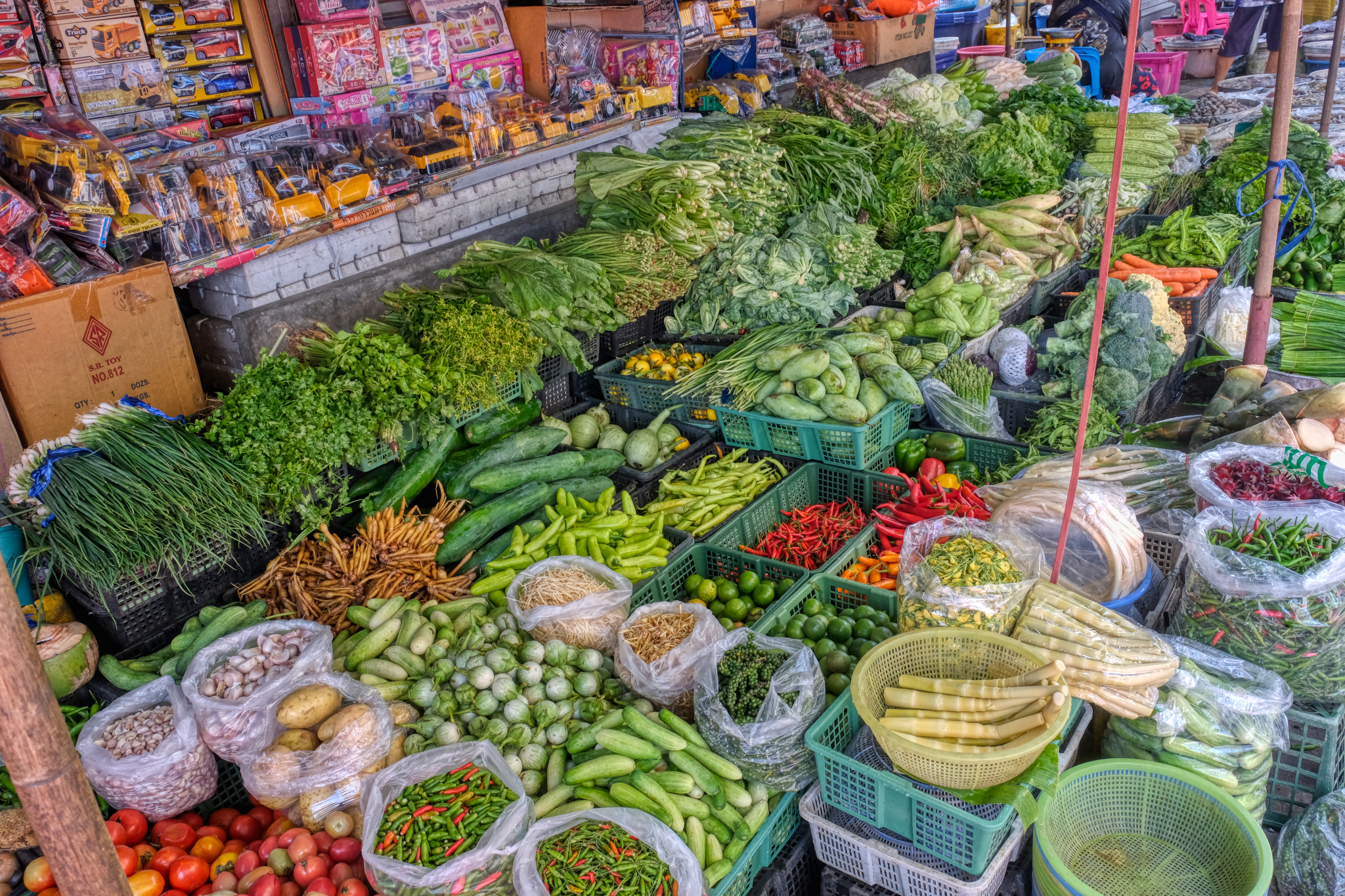 There were many sections of the old town market, and of course, one of them was for fresh fruits and vegetables. So delicious in Thailand.
There were many sections of the old town market, and of course, one of them was for fresh fruits and vegetables. So delicious in Thailand.
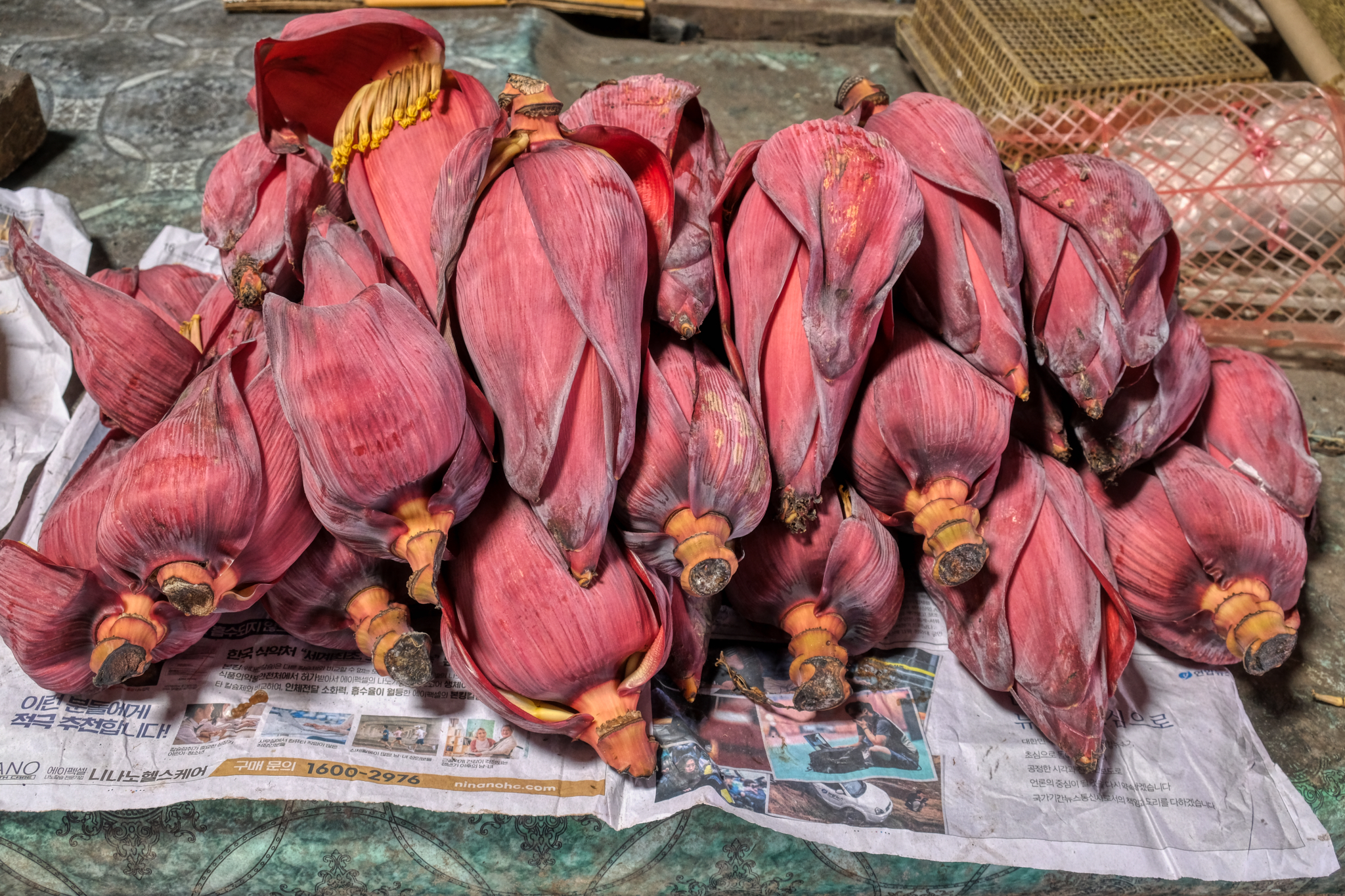 Banana flower hearts . . . used in some Thai dishes.
Banana flower hearts . . . used in some Thai dishes.
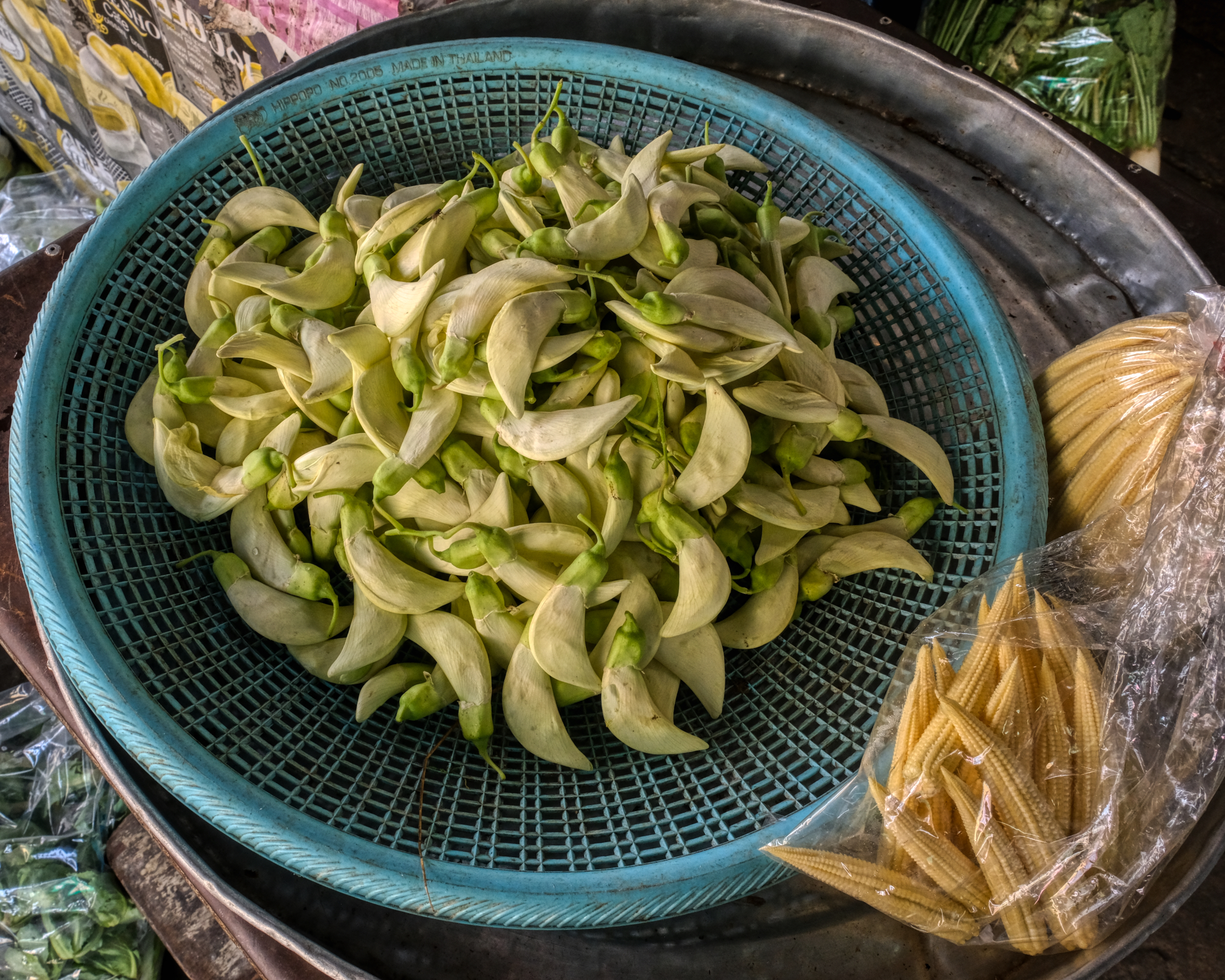 I had never seen this before . . . some kind of flower bud for use in one of the many thousands of Thai dishes.
I had never seen this before . . . some kind of flower bud for use in one of the many thousands of Thai dishes.
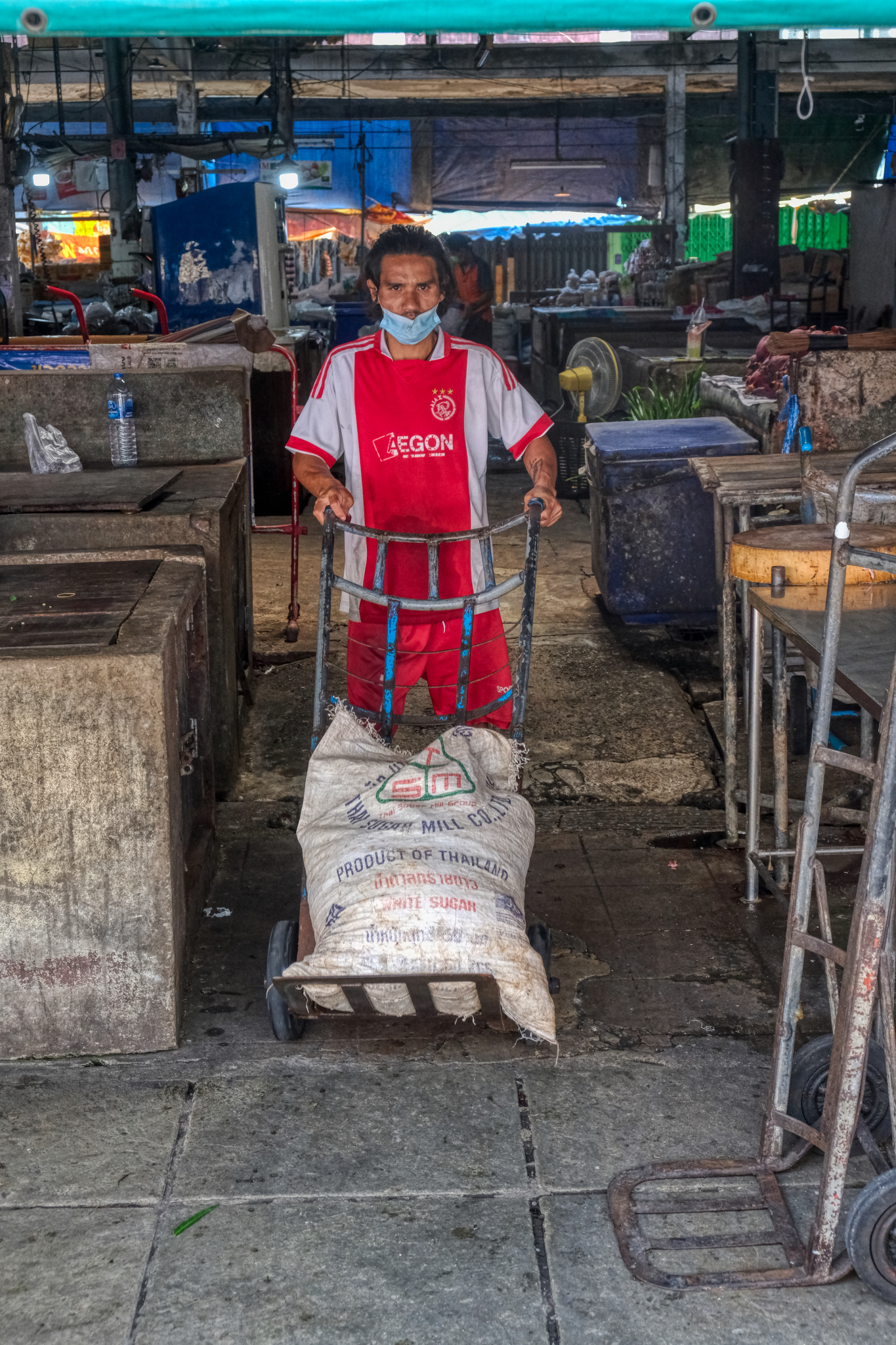 Although most of the market I saw so far was clean, neat, and recently refurbished, I eventually found the oldest part of the market. It was partially abandoned and the commerce there seemed to be left to the poorest people.
Although most of the market I saw so far was clean, neat, and recently refurbished, I eventually found the oldest part of the market. It was partially abandoned and the commerce there seemed to be left to the poorest people.
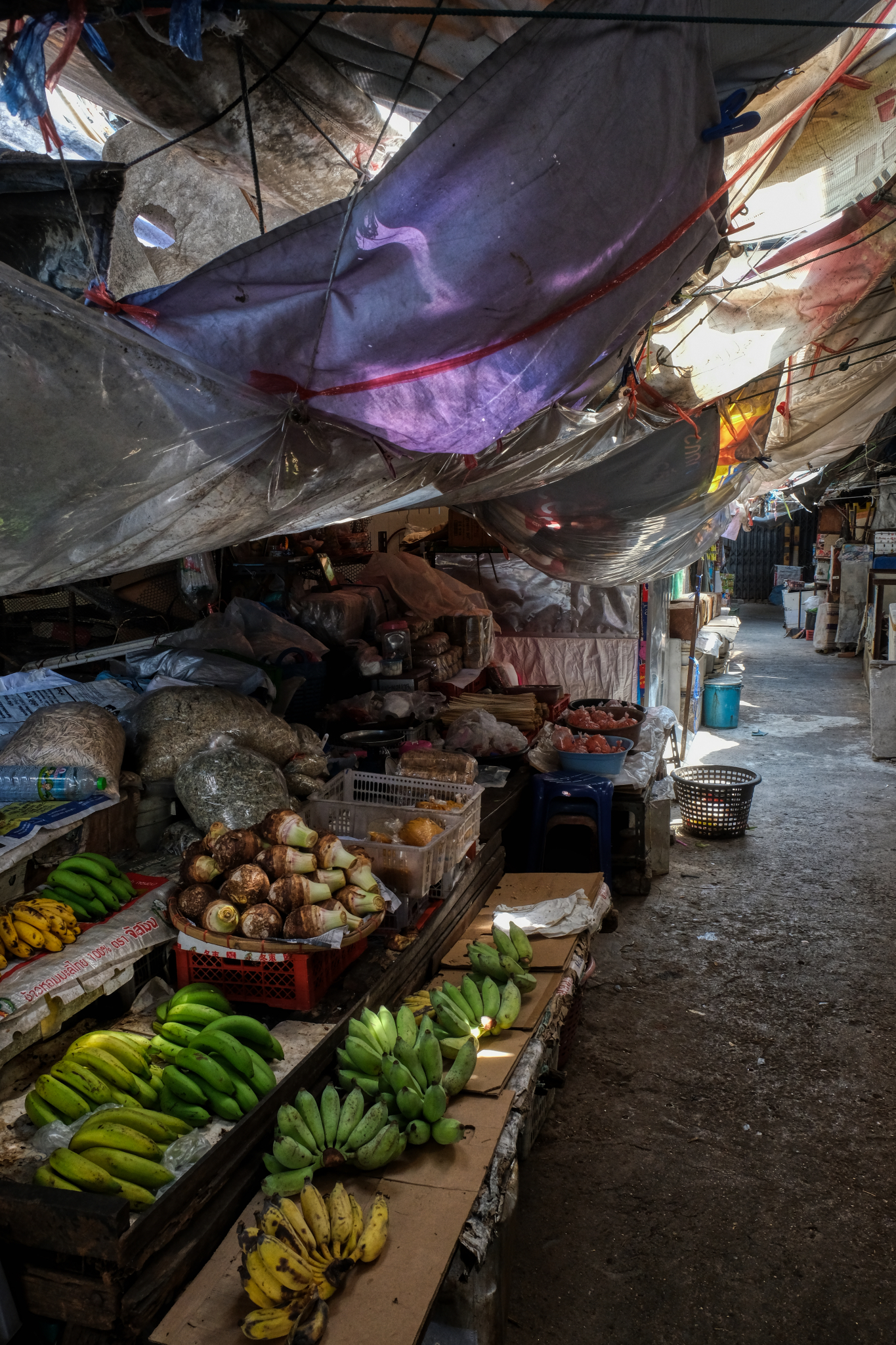 Old plastic rain flies over meagre offerings in the old, dead market. It is here we see the dilapidation caused by the corporate big box stores a couple of blocks away. I LOVE this photo.
Old plastic rain flies over meagre offerings in the old, dead market. It is here we see the dilapidation caused by the corporate big box stores a couple of blocks away. I LOVE this photo.
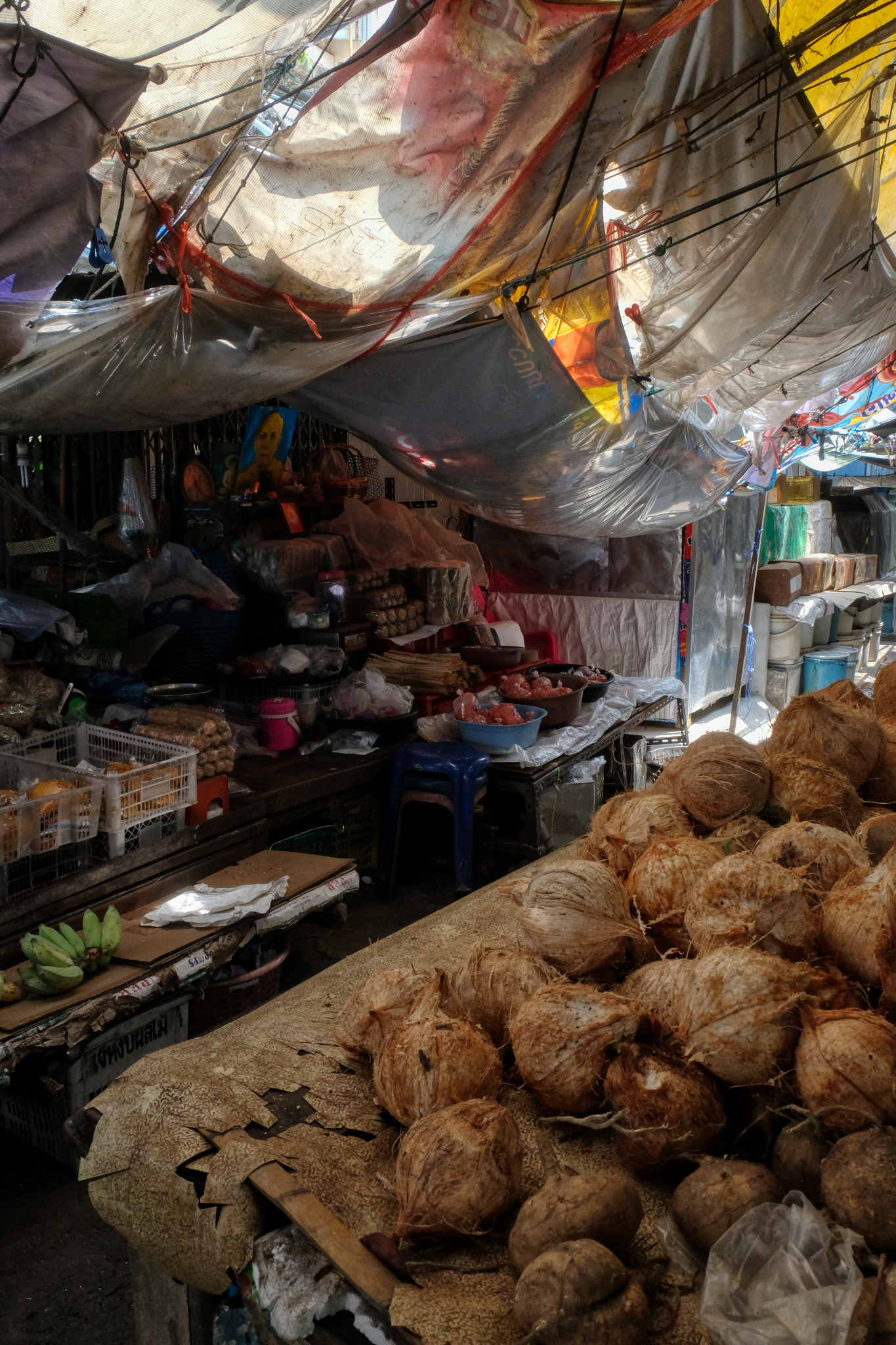 Old coconuts for sale.
Old coconuts for sale.
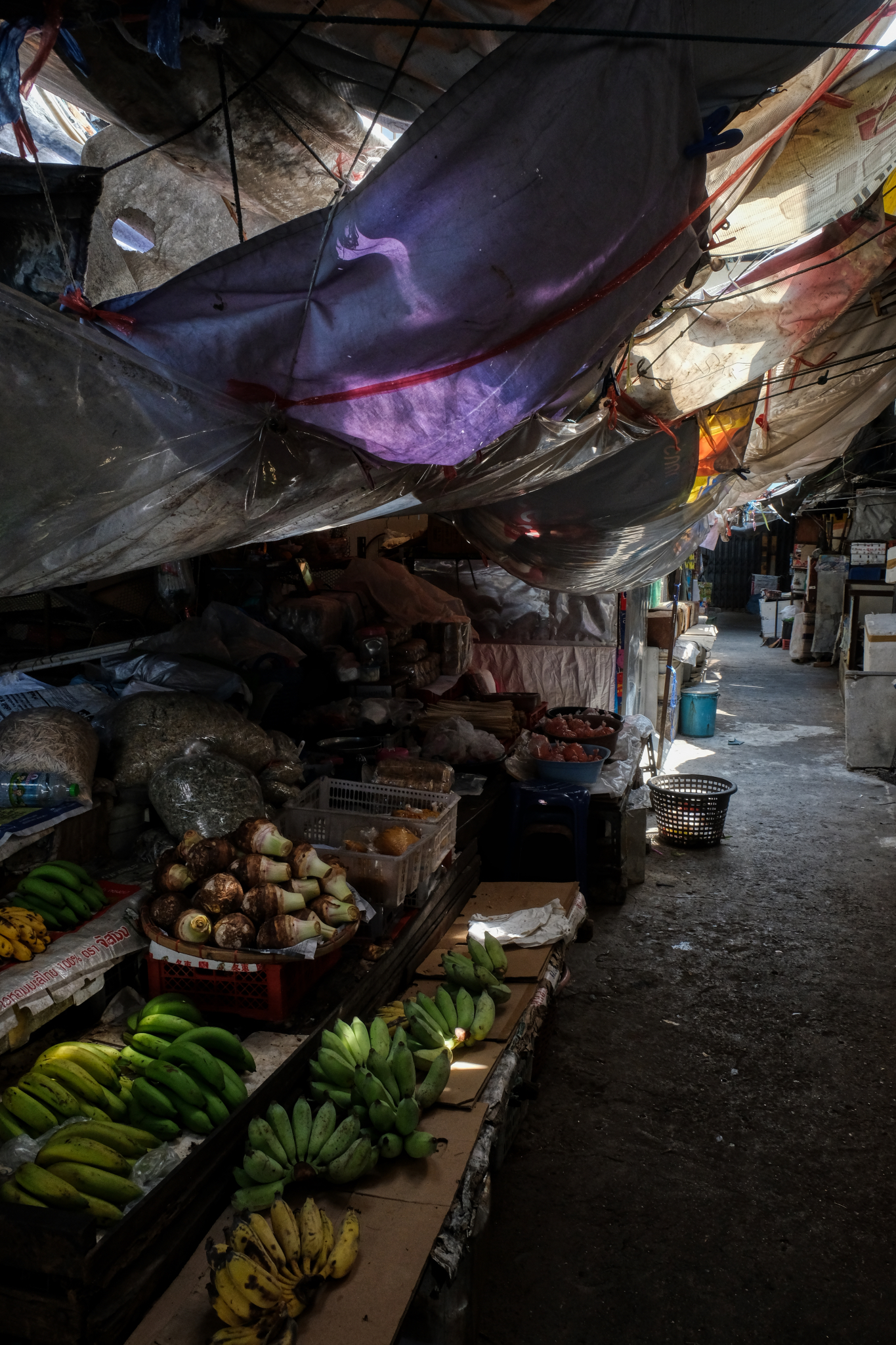 I was the ONLY person in this part of the market. Nobody was here, not even the merchants . . . at 10:00 in the morning.
I was the ONLY person in this part of the market. Nobody was here, not even the merchants . . . at 10:00 in the morning.
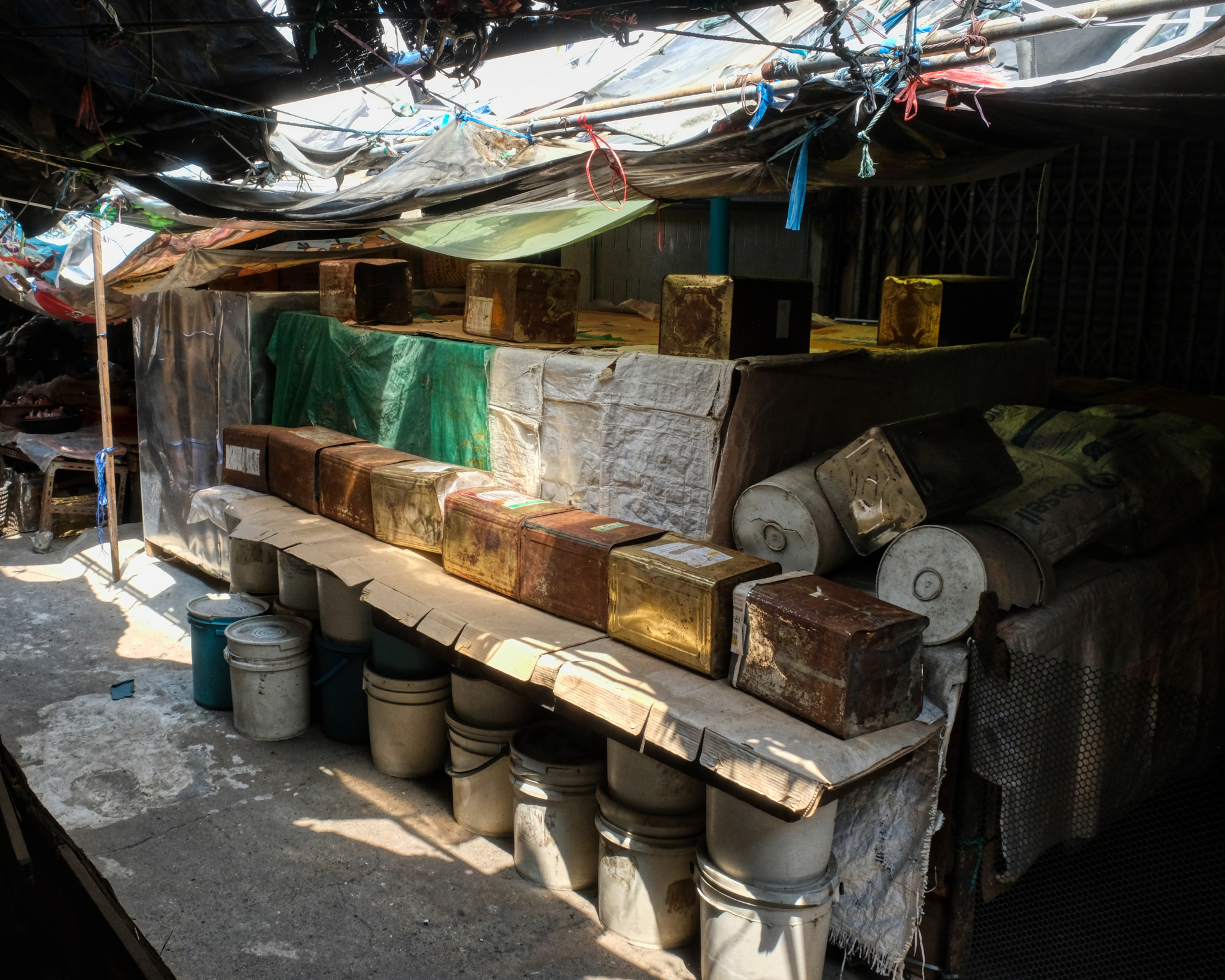 I tried to imagine what this 'business' was . . . but came up short.
I tried to imagine what this 'business' was . . . but came up short.
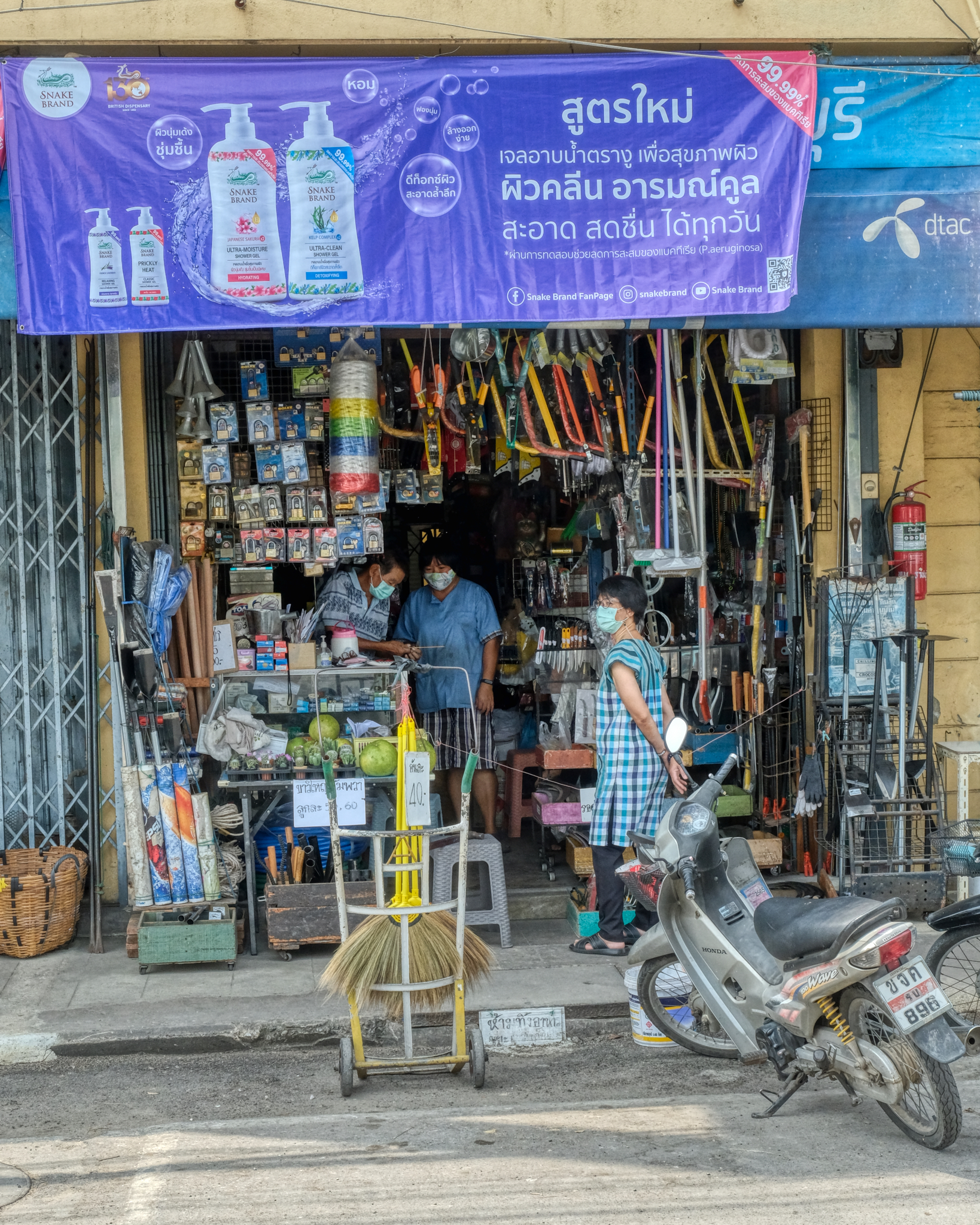
Outside of the inner alleyways of the old market, along the city streets, are more businesses. Here ,a hardware store.
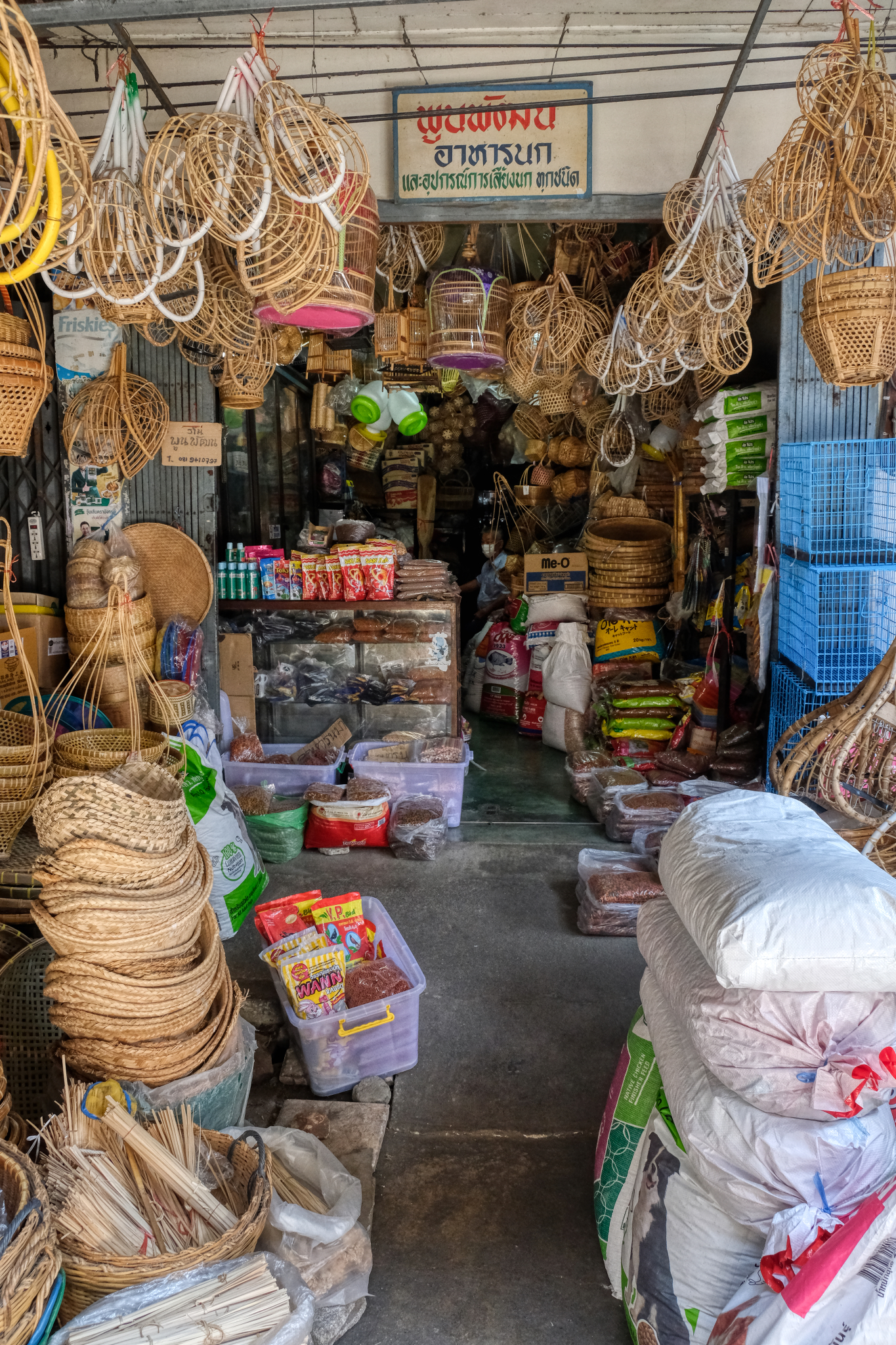 Shops that have everything a local resident would want and need.
Shops that have everything a local resident would want and need.
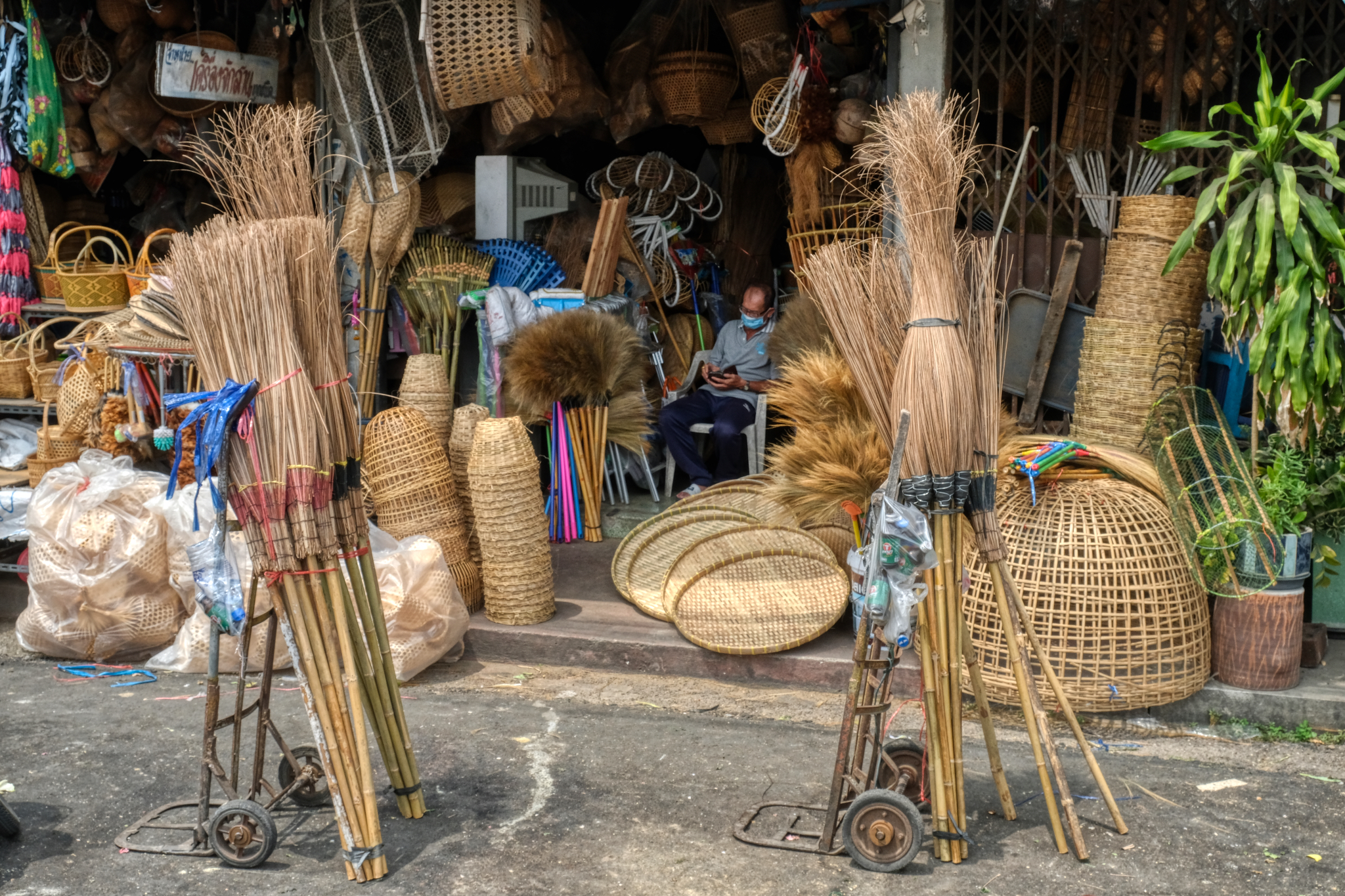 If it can be made out of straw, bamboo, or wicker . . . . they have it here.
If it can be made out of straw, bamboo, or wicker . . . . they have it here.
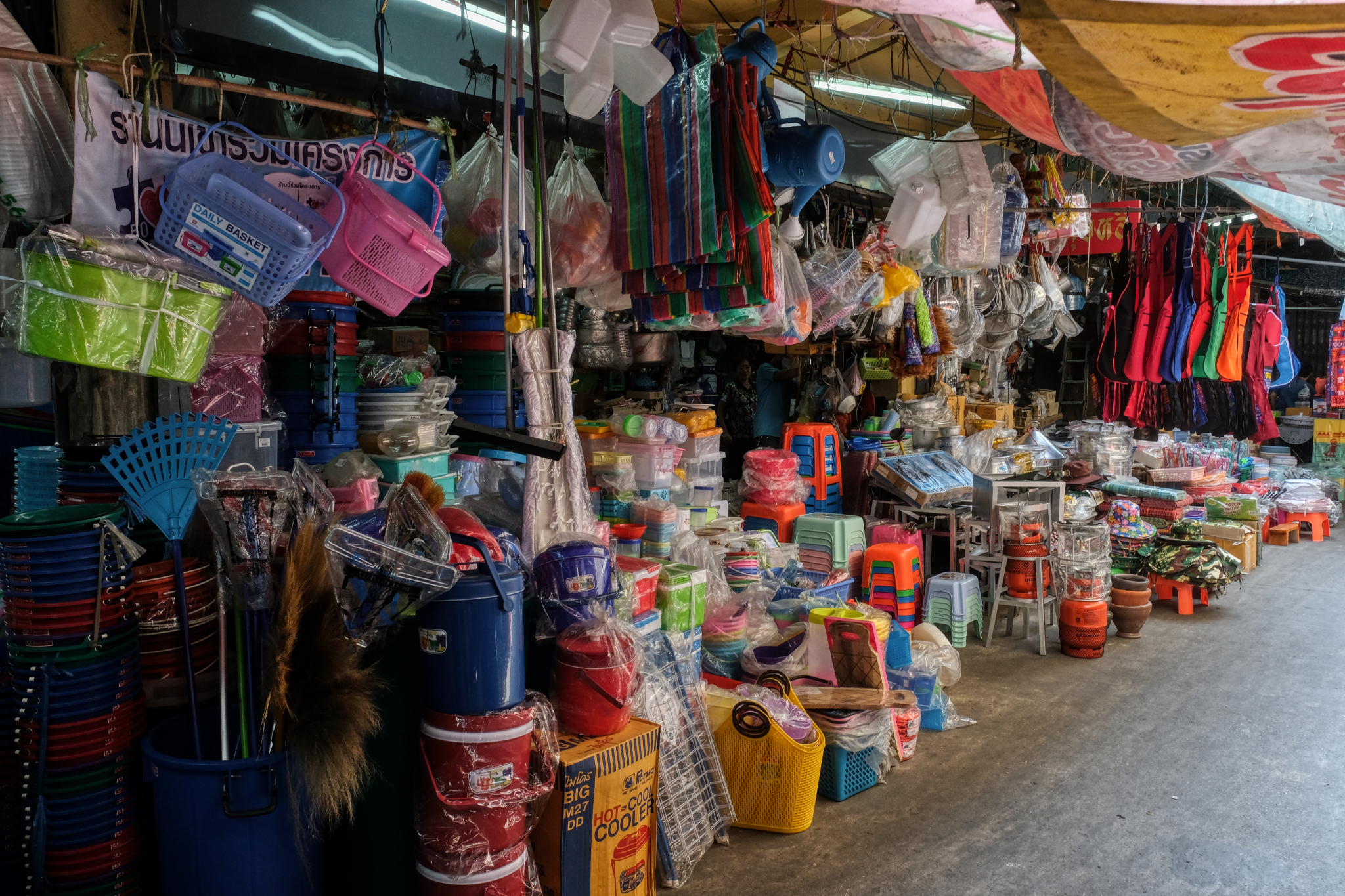 Of course, if it can be made out of straw, bamboo, or wicker . . . it can also be made out of plastic.
Of course, if it can be made out of straw, bamboo, or wicker . . . it can also be made out of plastic.
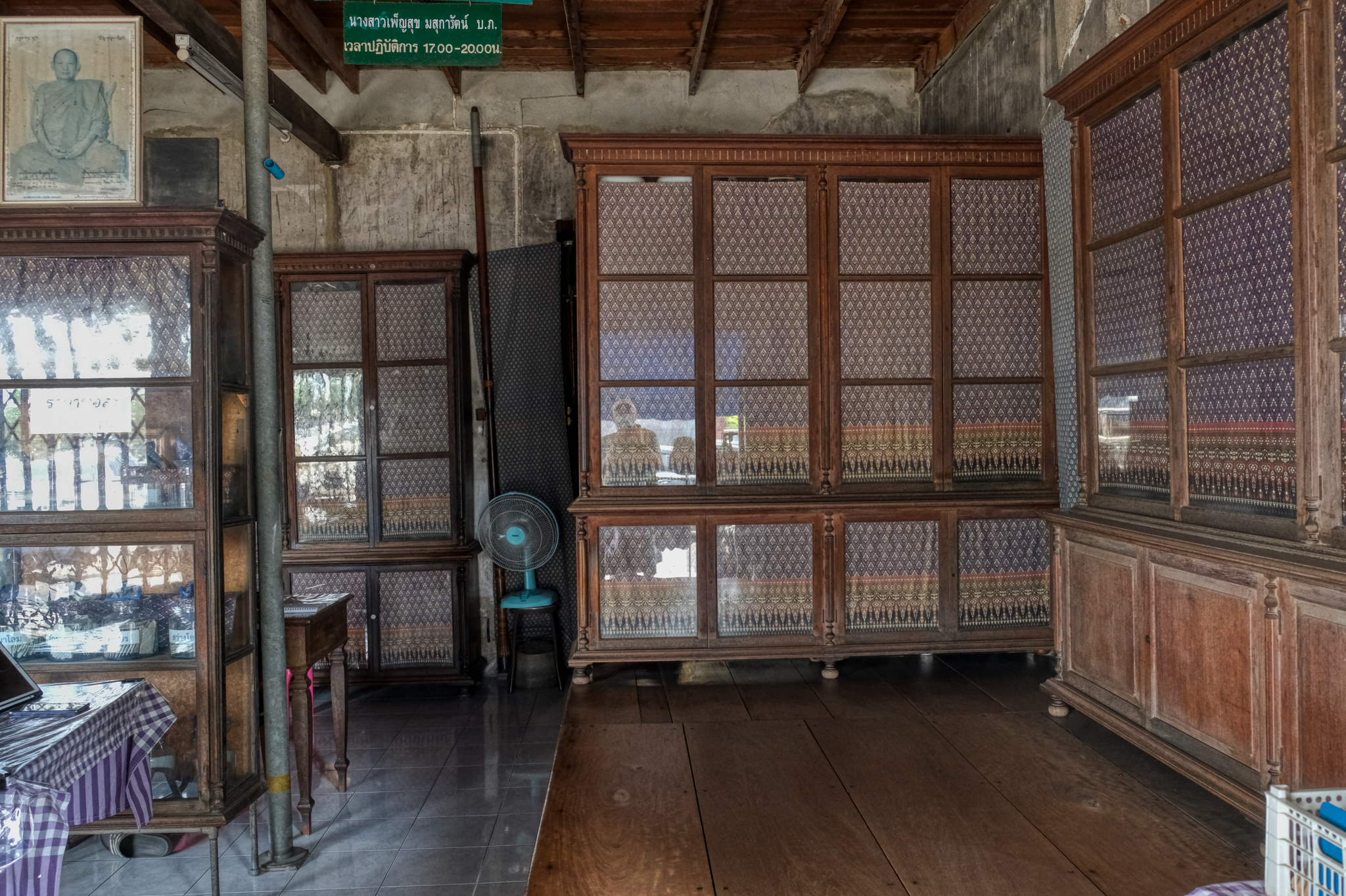 The owner of this shop told me it was restored to how it was when her family started it 100 years ago. A beautiful look into the past times in Thailand.
The owner of this shop told me it was restored to how it was when her family started it 100 years ago. A beautiful look into the past times in Thailand.
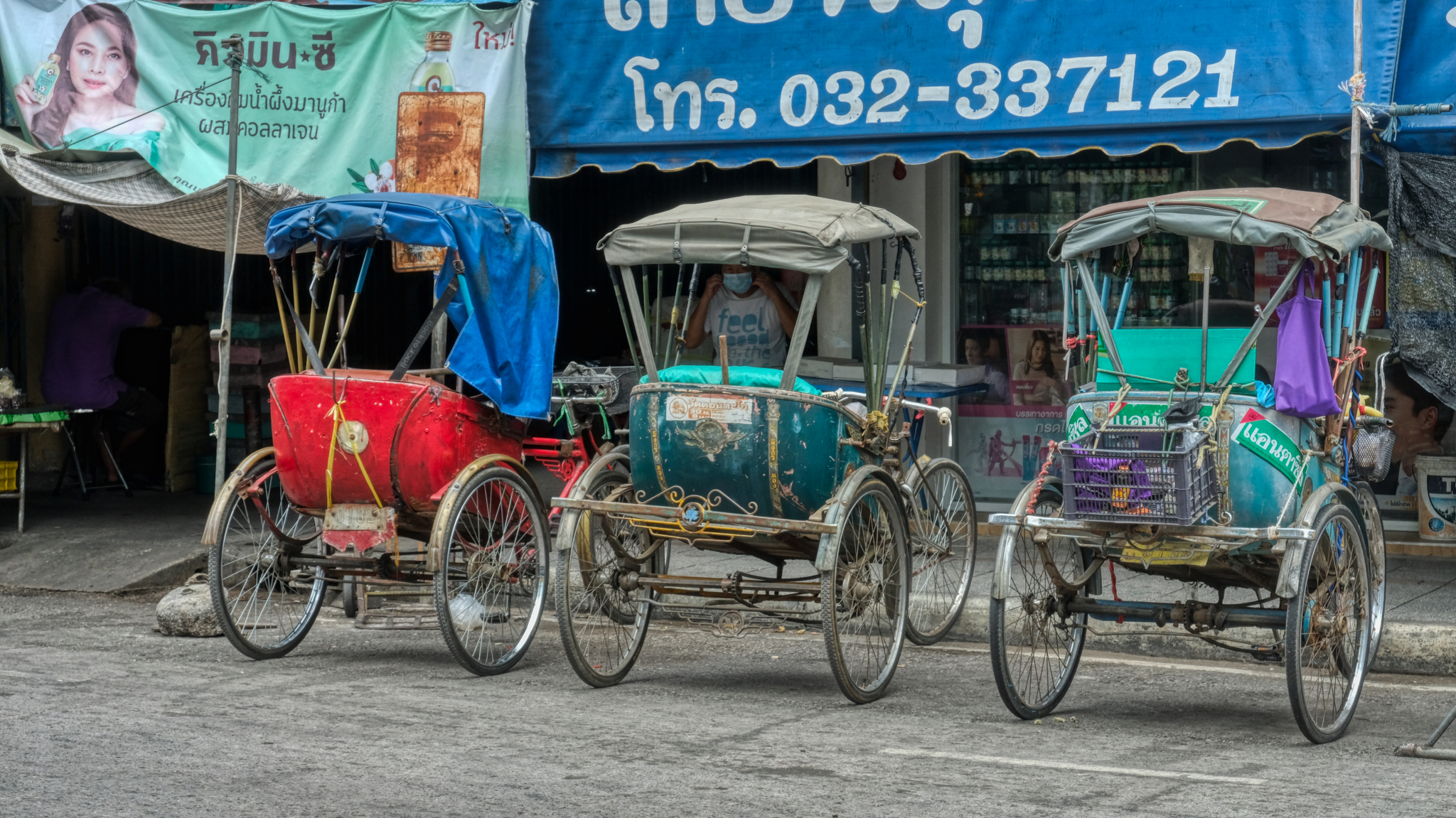 When I came to live in Thailand 26 years ago these samlors were ubiquitous. There would always be 20-30 of these 'pedal cabs' lied up next to the wet markets ready to take the customers home. Now it is rare to see them anywhere any more.
When I came to live in Thailand 26 years ago these samlors were ubiquitous. There would always be 20-30 of these 'pedal cabs' lied up next to the wet markets ready to take the customers home. Now it is rare to see them anywhere any more.
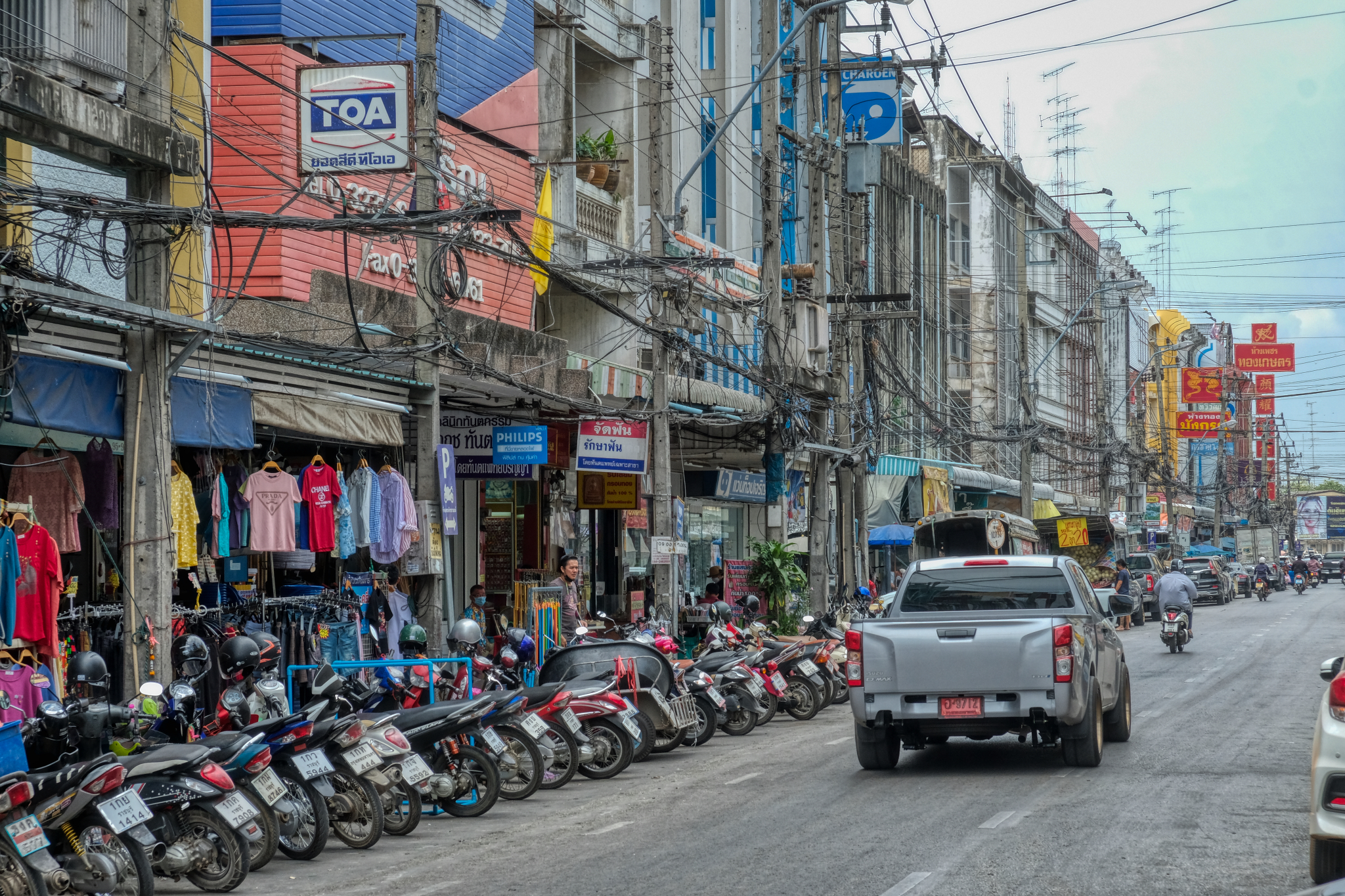 The "modern" Ratchiburi commercial center, dating from the 1970s and 1980s. Of course the true 'modern' Ratchiburi commercial zone is now located in the multinational Big Box stores and shopping malls that dot the major roads leading in and out of the town . . . and the Thais drive there in their pick-up trucks.
The "modern" Ratchiburi commercial center, dating from the 1970s and 1980s. Of course the true 'modern' Ratchiburi commercial zone is now located in the multinational Big Box stores and shopping malls that dot the major roads leading in and out of the town . . . and the Thais drive there in their pick-up trucks.
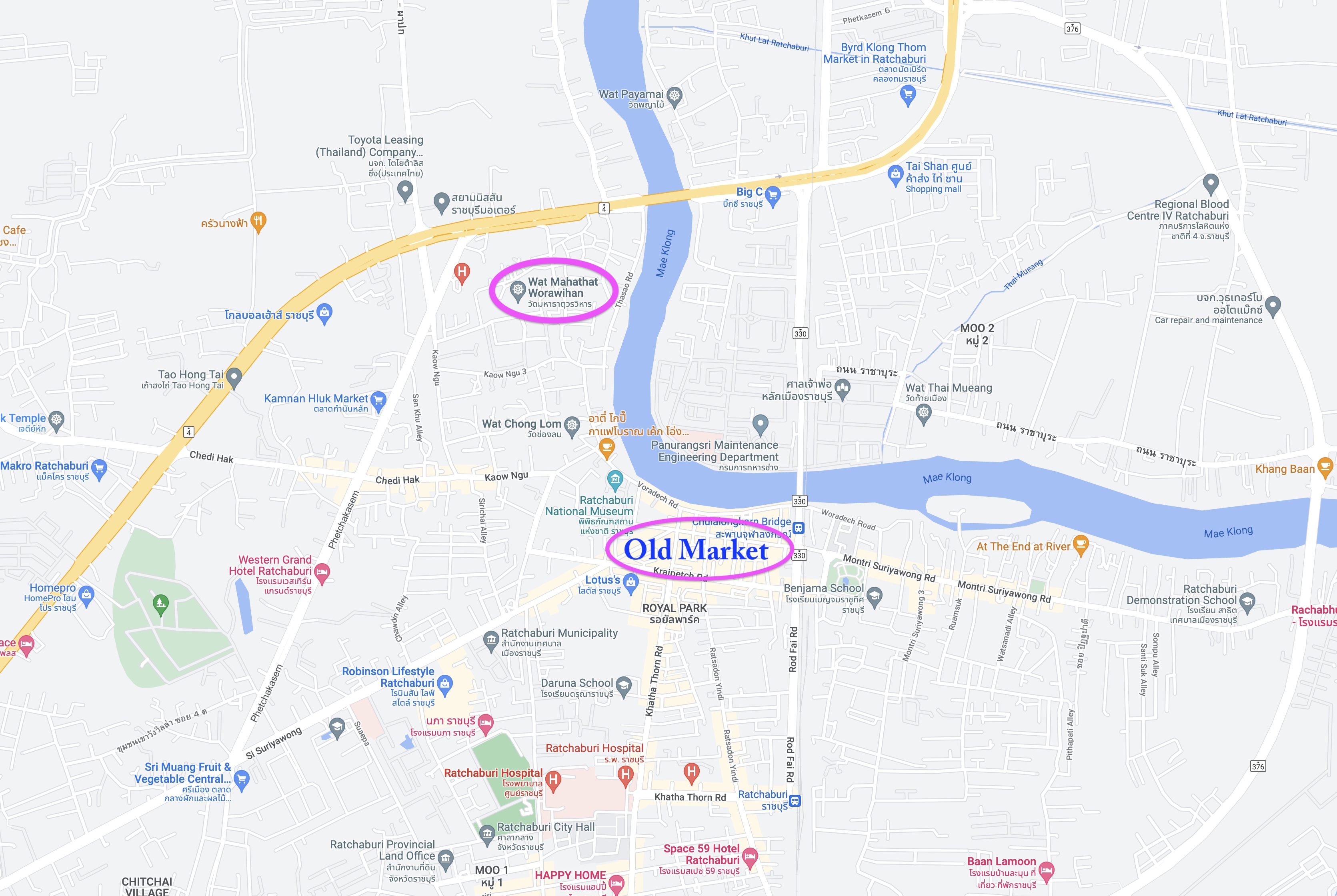 My last stop was at the amazing 10th century Wat Mahathat Worawihan.
My last stop was at the amazing 10th century Wat Mahathat Worawihan.
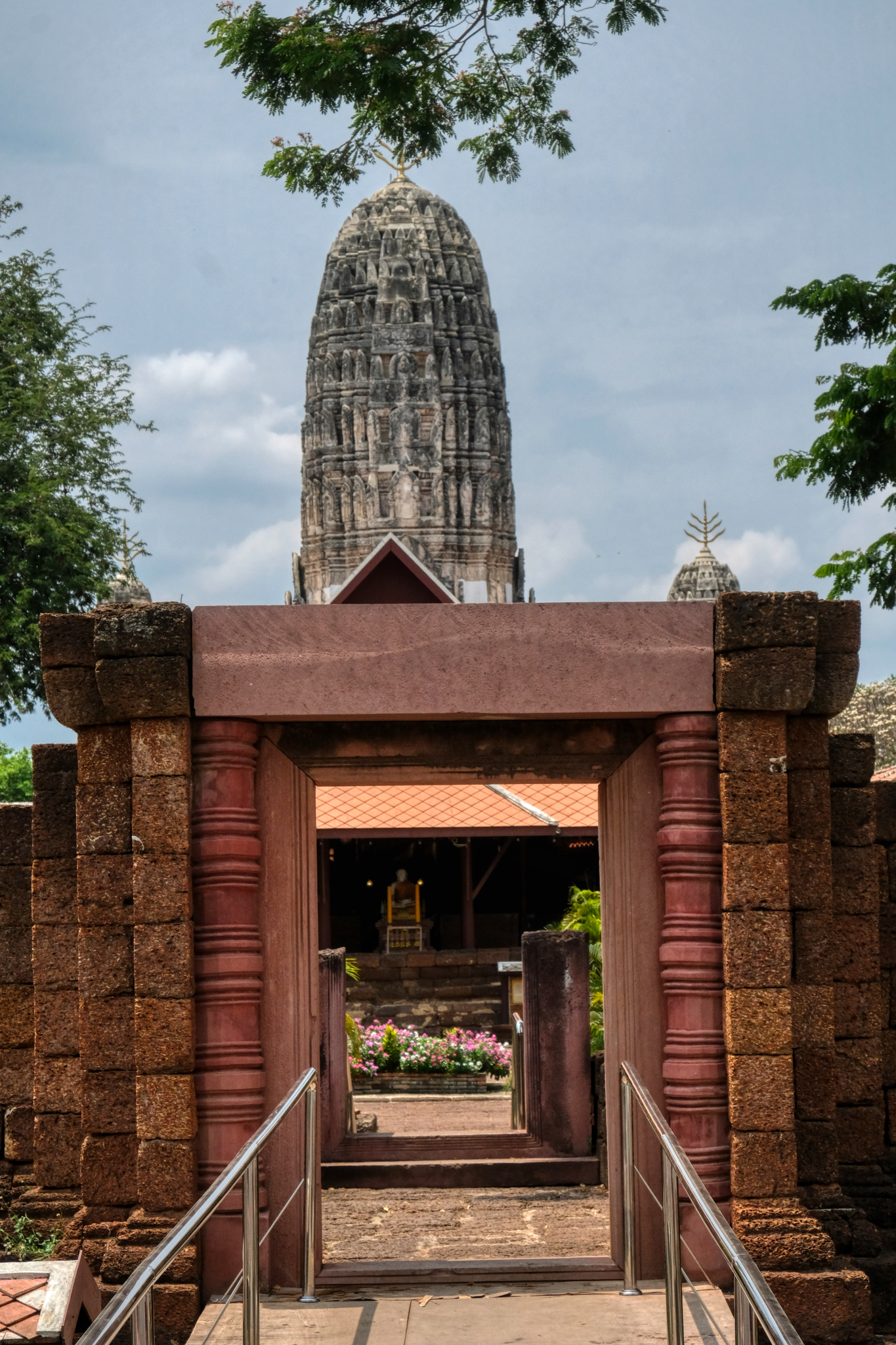 The front gate of Wat Mahathat Worawihan did not impress. But what was within astonished me.
The front gate of Wat Mahathat Worawihan did not impress. But what was within astonished me.
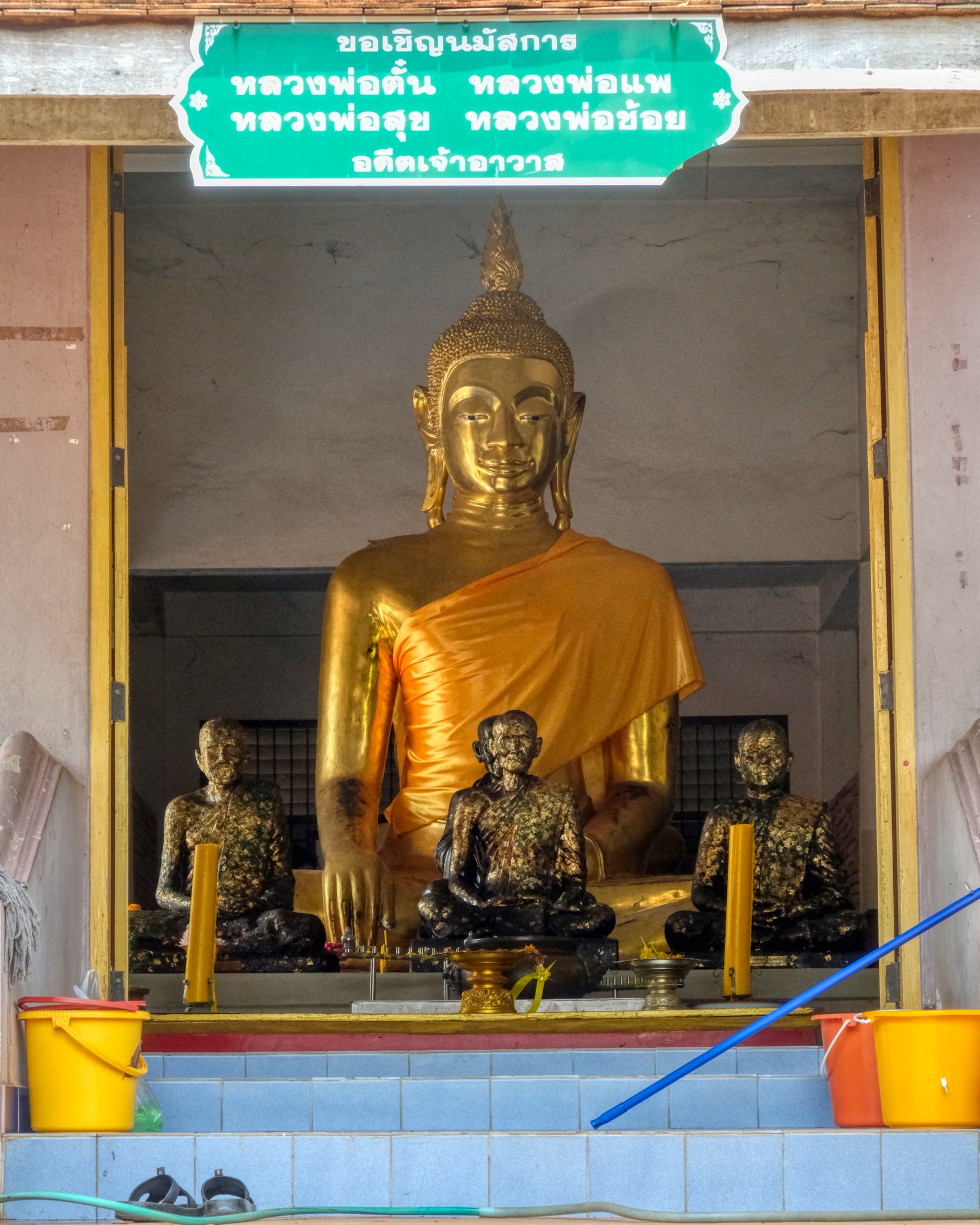 My first inkling about the beauty within this was was when I looked through a small building's window and saw this.
My first inkling about the beauty within this was was when I looked through a small building's window and saw this.
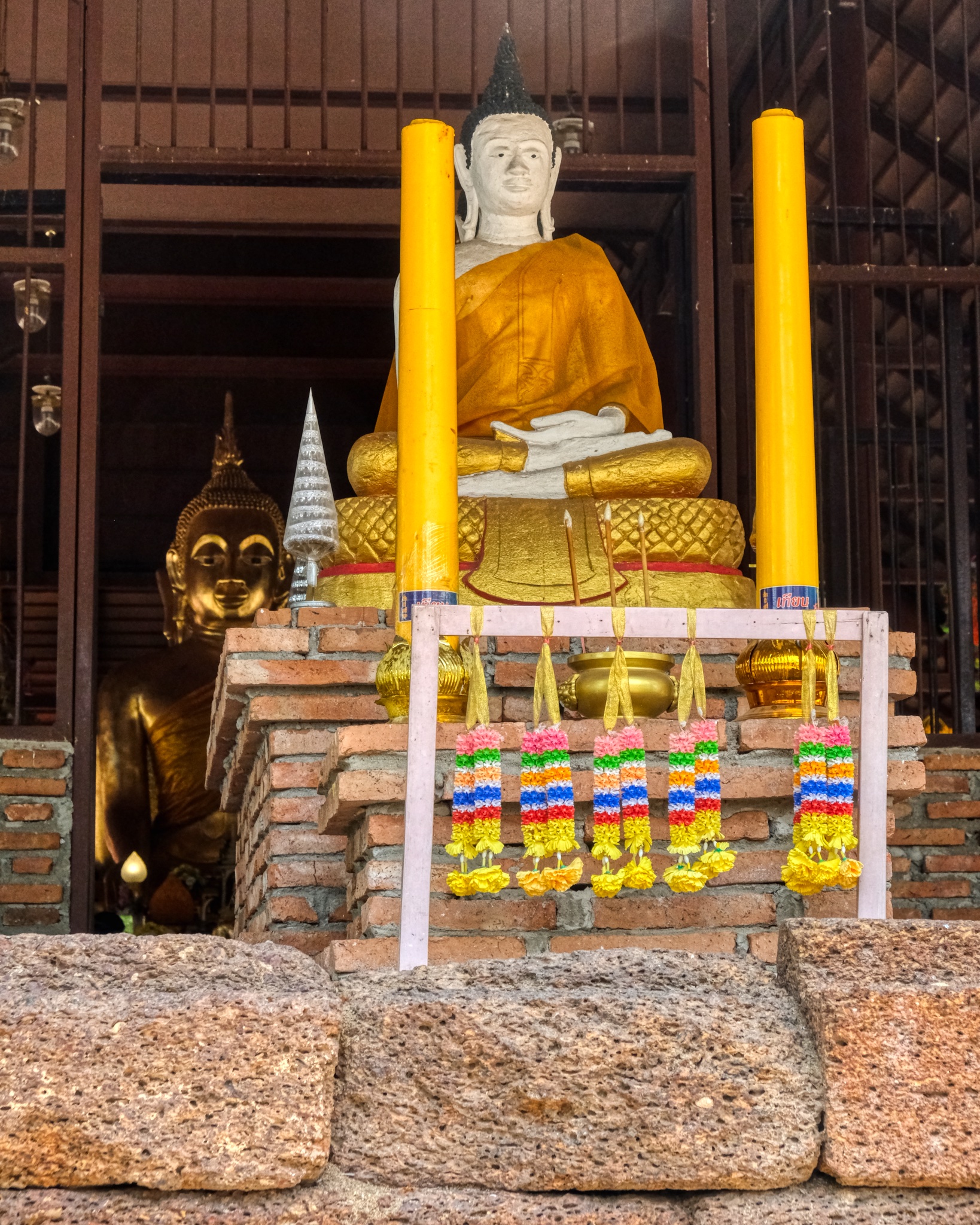 The sala/temple straight ahead looked inviting. I could see a large Buddha image within.
The sala/temple straight ahead looked inviting. I could see a large Buddha image within.
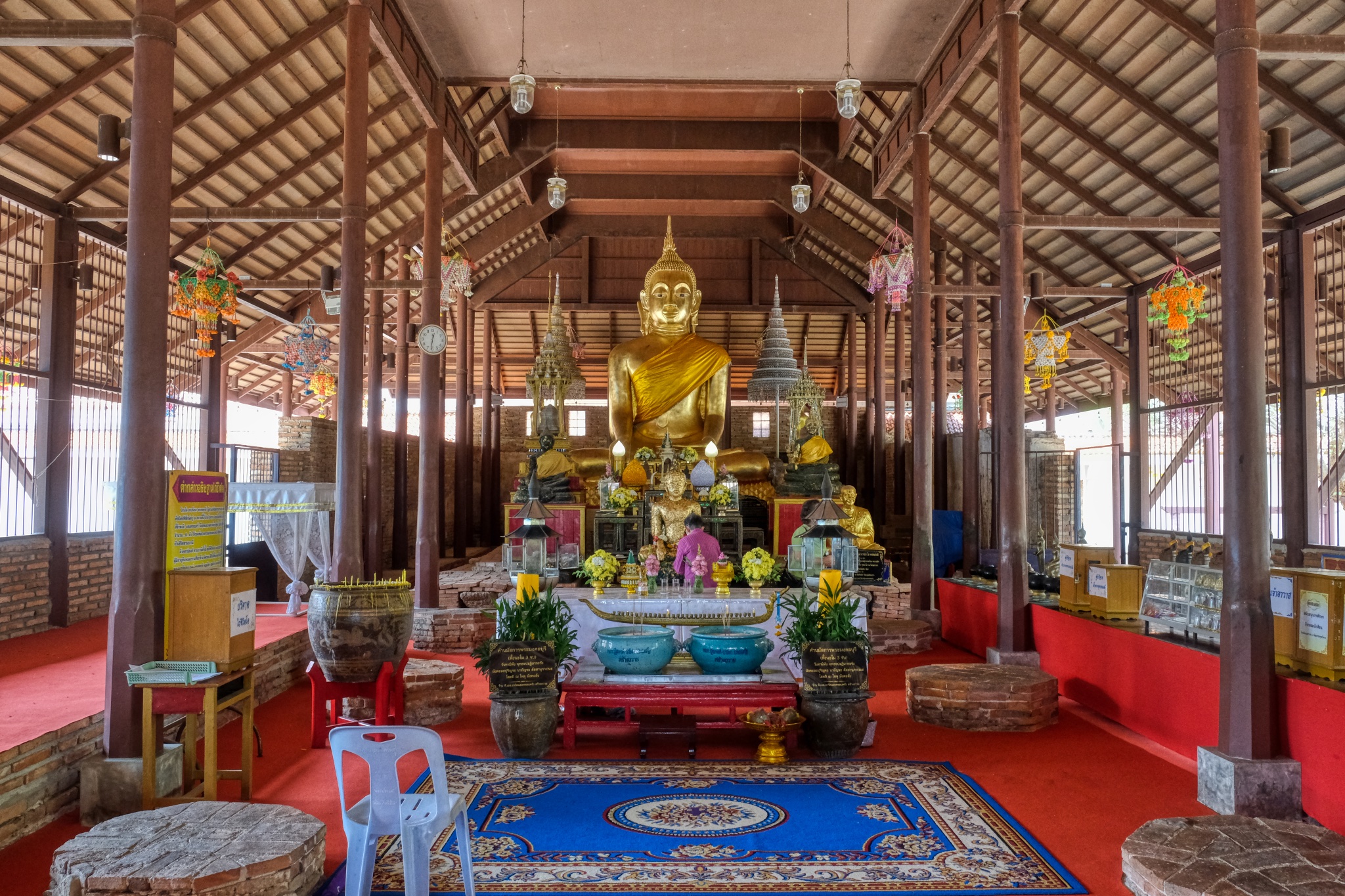 I took my shoes off and went in and discovered this remarkable spiritual space. If you look closely you can see the bases of the pillars that held up an earlier temple in the same location. "It is believed that this temple was built in the Dvaravati Period, around the 10th-11th Century, nearly the same time as when the old city of Ratchaburi was built. Later, a Khmer or Lop Buri sanctuary was built over the temple around the 13th Century to be the centre of the town according to the Khmer belief regarding the universe."
I took my shoes off and went in and discovered this remarkable spiritual space. If you look closely you can see the bases of the pillars that held up an earlier temple in the same location. "It is believed that this temple was built in the Dvaravati Period, around the 10th-11th Century, nearly the same time as when the old city of Ratchaburi was built. Later, a Khmer or Lop Buri sanctuary was built over the temple around the 13th Century to be the centre of the town according to the Khmer belief regarding the universe."
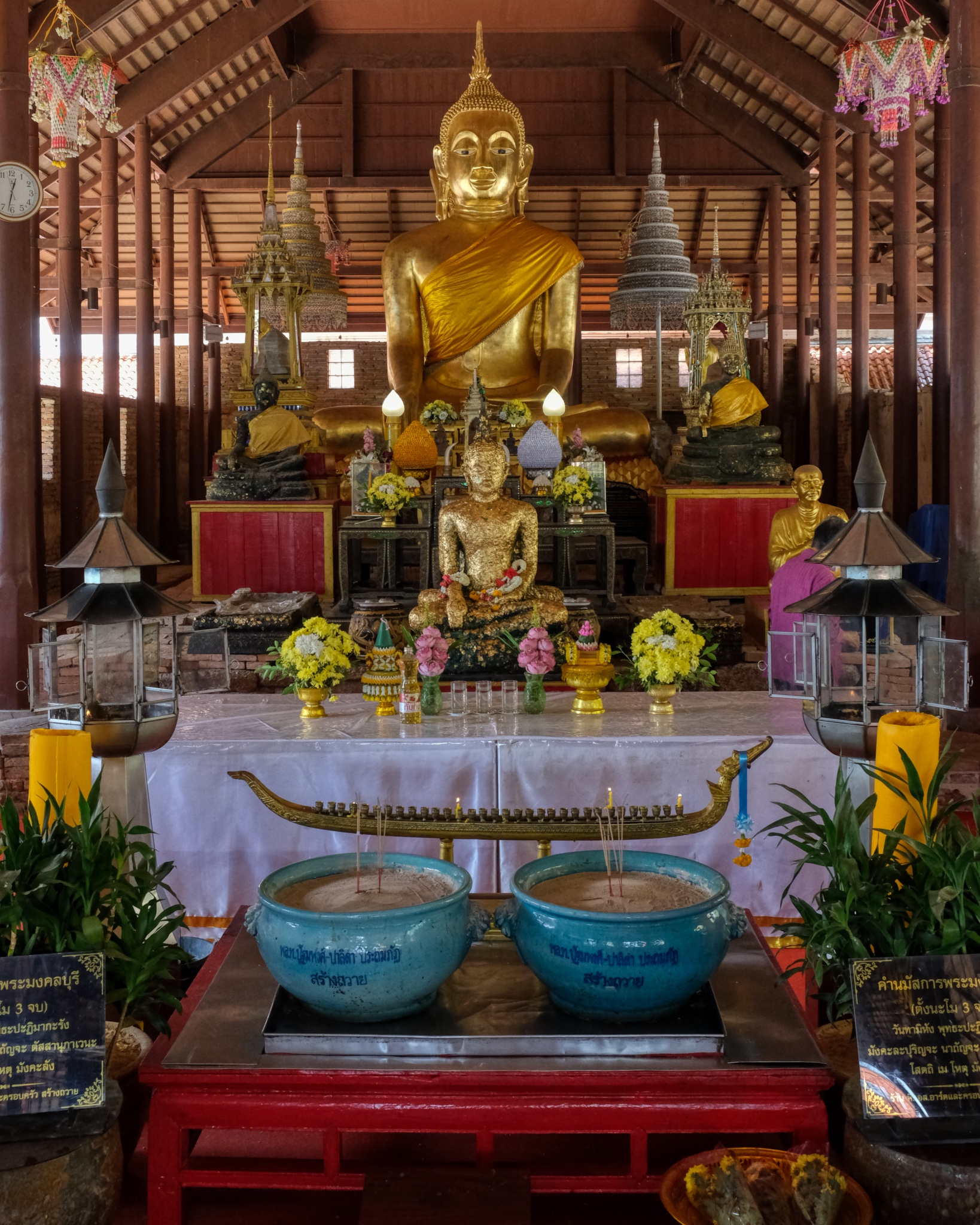 Exquisite Buddha images and a fine altar.
Exquisite Buddha images and a fine altar.
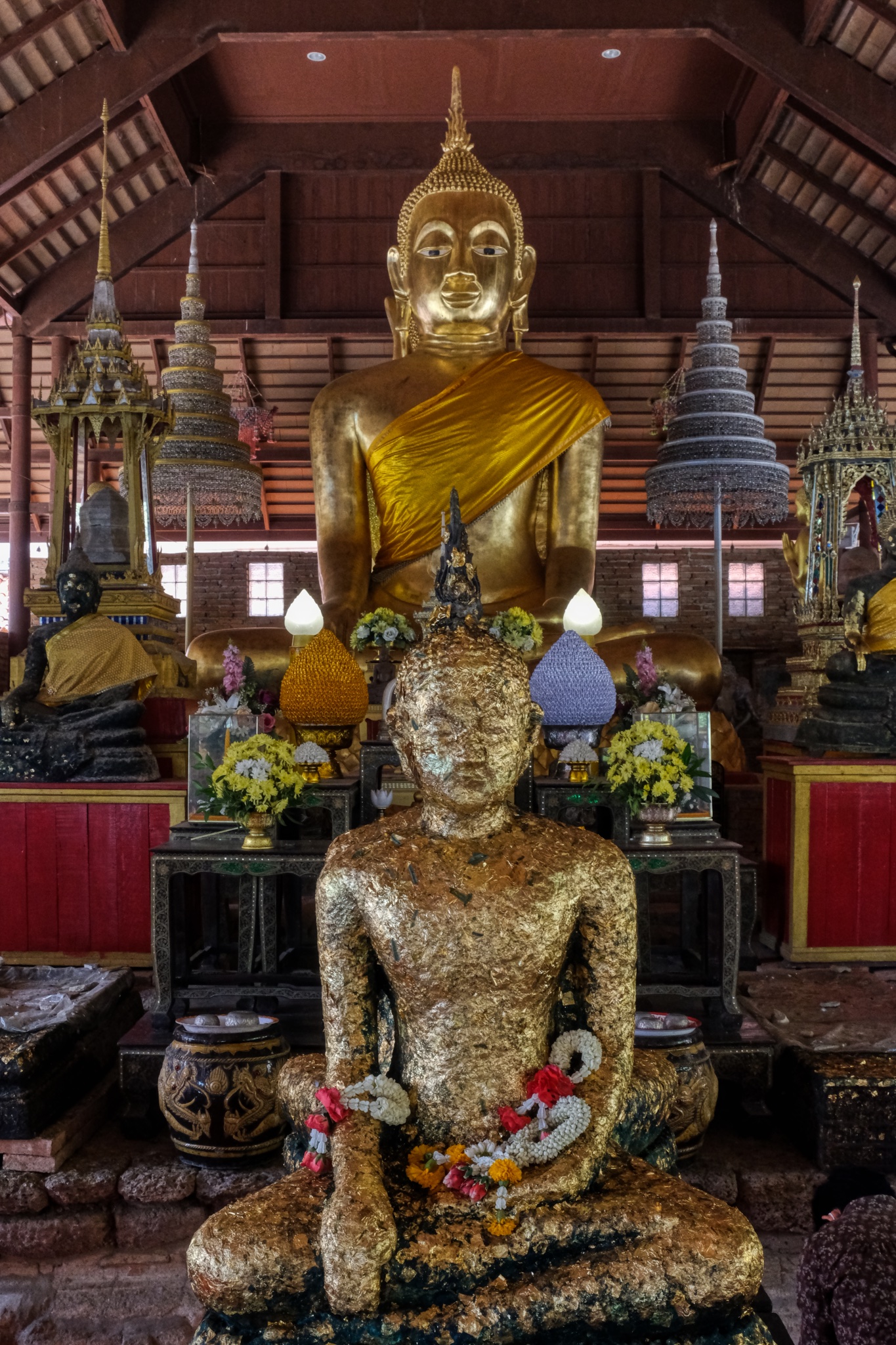 Buddha.
Buddha.
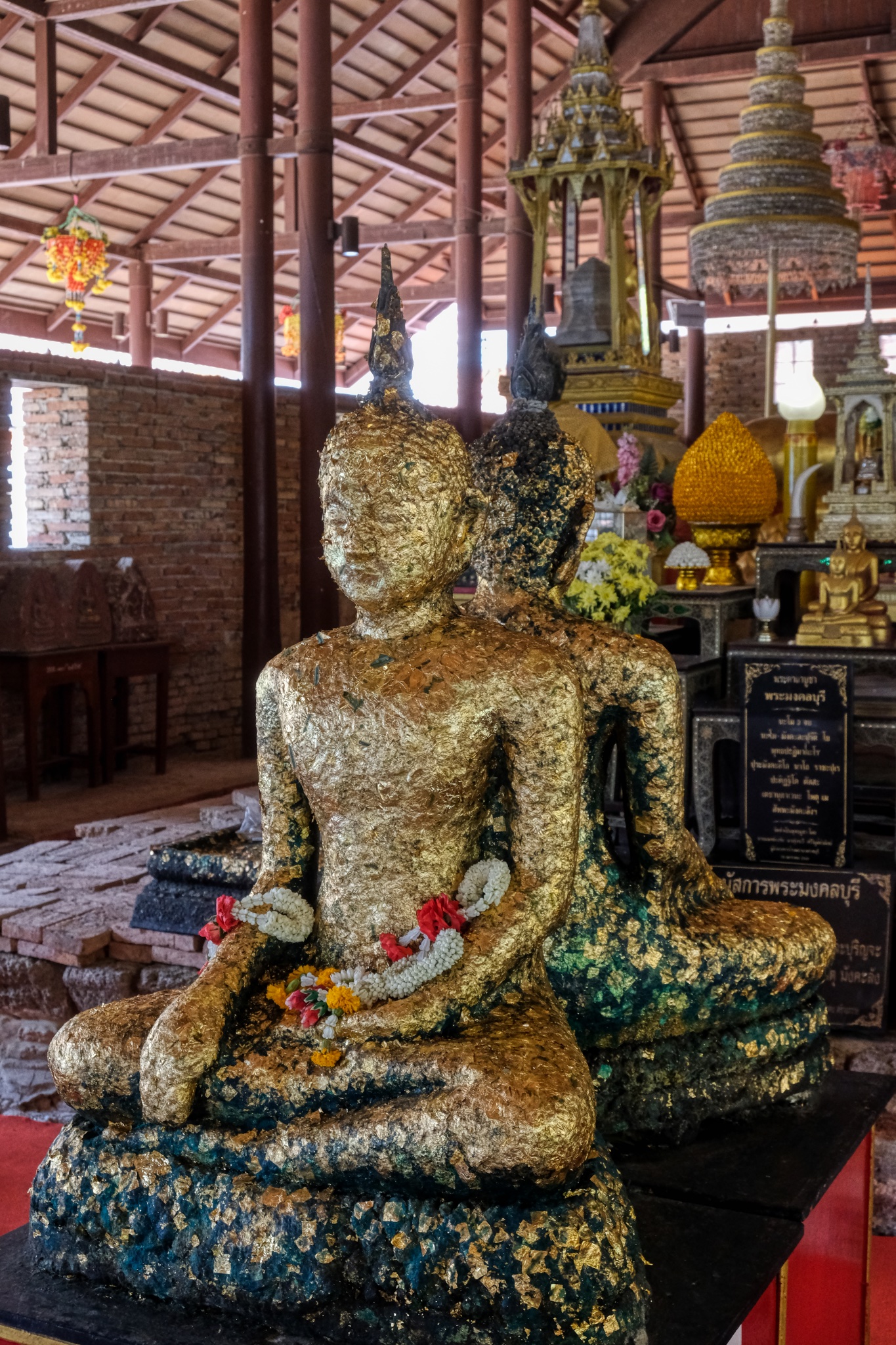 Devotees adorn Buddha images with gold leaf as a part of respectful practices. I was intrigued by these two Buddhas sitting back-to-back.
Devotees adorn Buddha images with gold leaf as a part of respectful practices. I was intrigued by these two Buddhas sitting back-to-back.
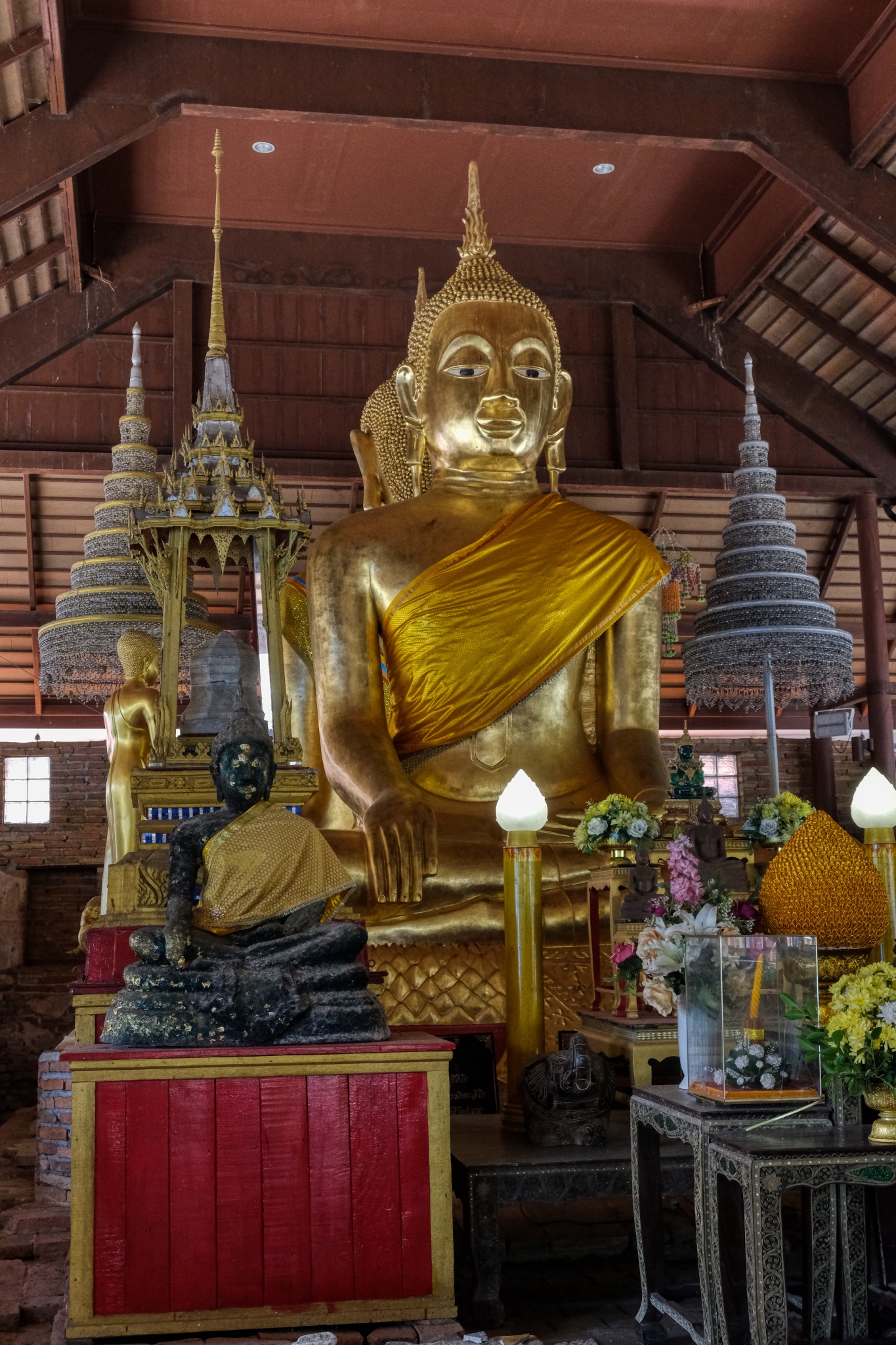 When I looked up at the main, large Buddha image I noticed that it was also a double Buddha. It is very unusual to see two Buddhas sitting back-to-back.
When I looked up at the main, large Buddha image I noticed that it was also a double Buddha. It is very unusual to see two Buddhas sitting back-to-back.
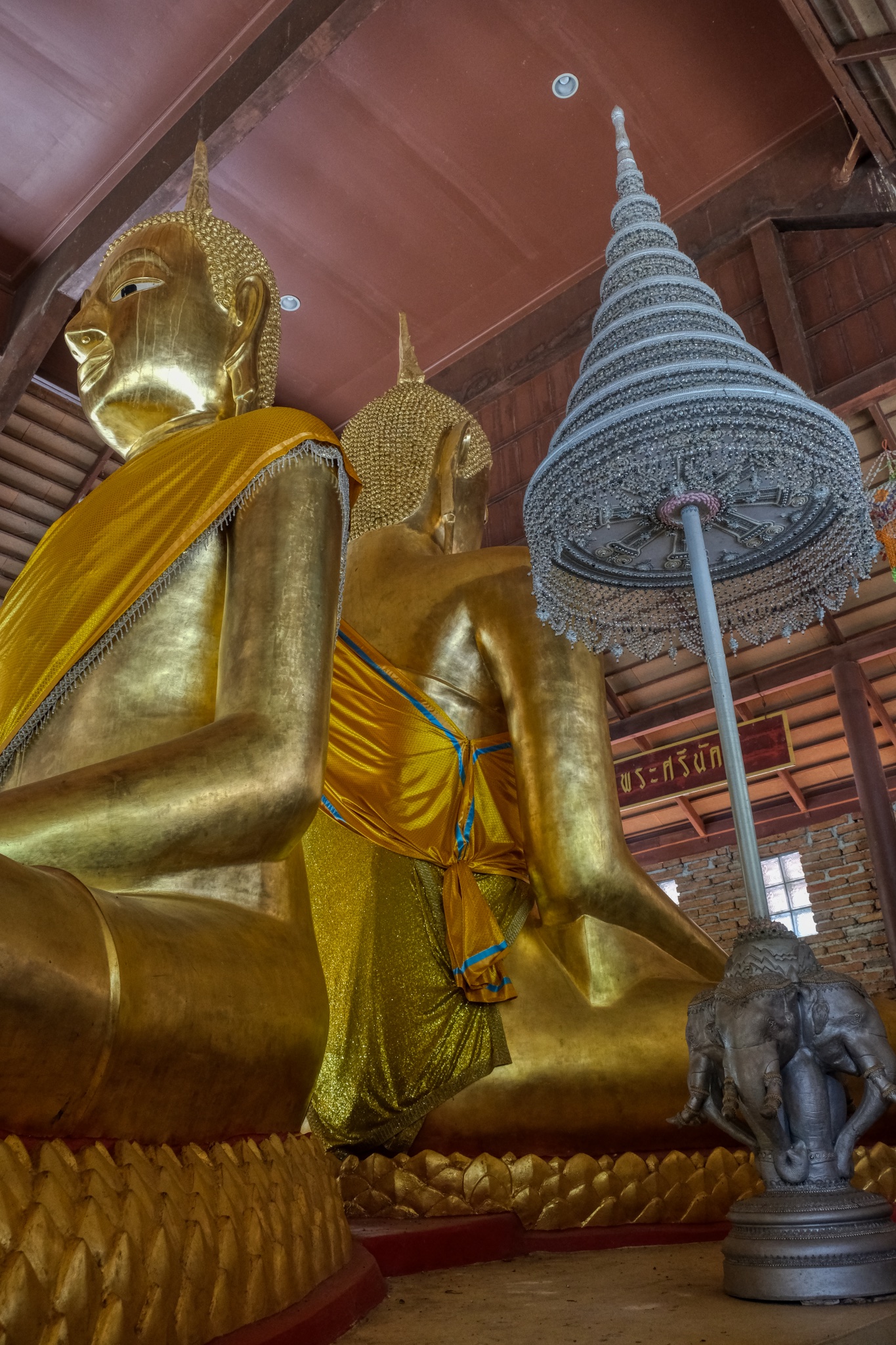 Normally only one Buddha sits in a Wat, and normally facing East.
Normally only one Buddha sits in a Wat, and normally facing East.
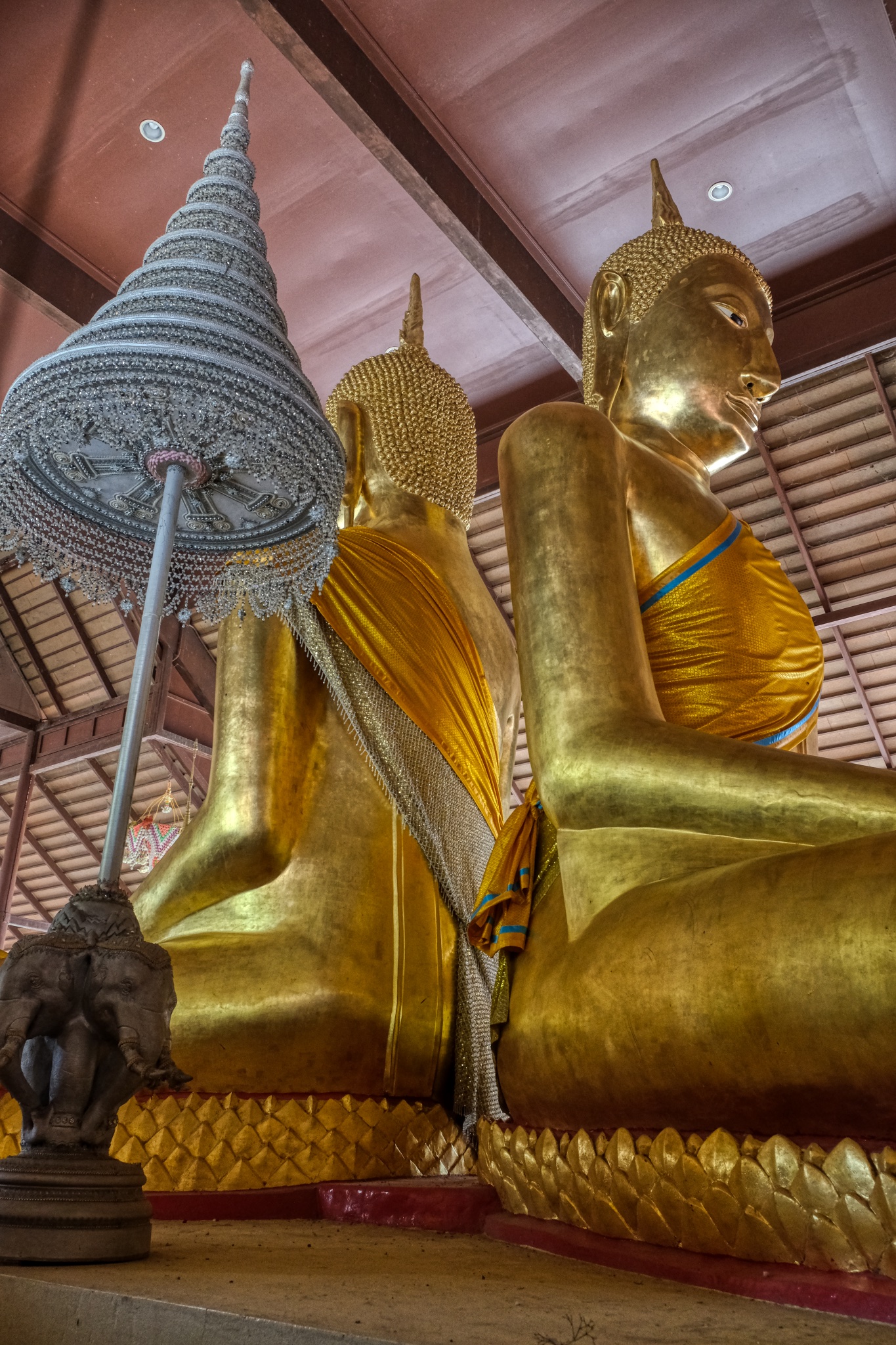 They were extraordinarily beautiful Buddhas. My research turned this up:"It is a stucco Buddha image in the gesture of subduing Mara, which has a lap width of 8 Sok 1 Khuep. Its characteristic is of the Pre-Ayutthaya art, with a Sukhothai style face. It has a long body but short knees. He turns his face to the east, and there is another Buddha image behind his back, turning its face to the opposite side or the west. This means we ask the Buddha’s blessing to prevent danger from the front as well as the back." (citation)
They were extraordinarily beautiful Buddhas. My research turned this up:"It is a stucco Buddha image in the gesture of subduing Mara, which has a lap width of 8 Sok 1 Khuep. Its characteristic is of the Pre-Ayutthaya art, with a Sukhothai style face. It has a long body but short knees. He turns his face to the east, and there is another Buddha image behind his back, turning its face to the opposite side or the west. This means we ask the Buddha’s blessing to prevent danger from the front as well as the back." (citation)
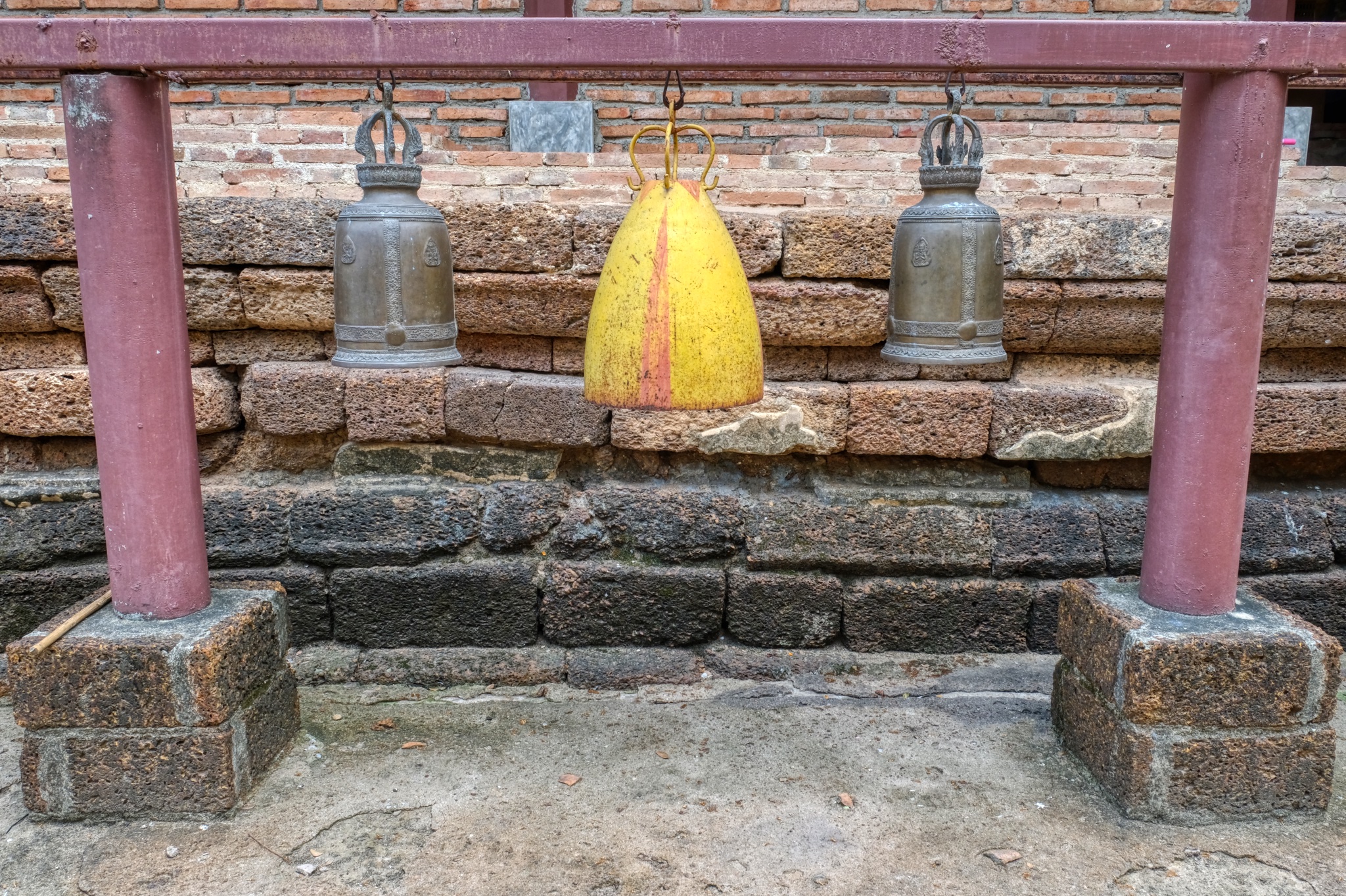 I left the Buddha hall to wander around the wat grounds.
I left the Buddha hall to wander around the wat grounds.
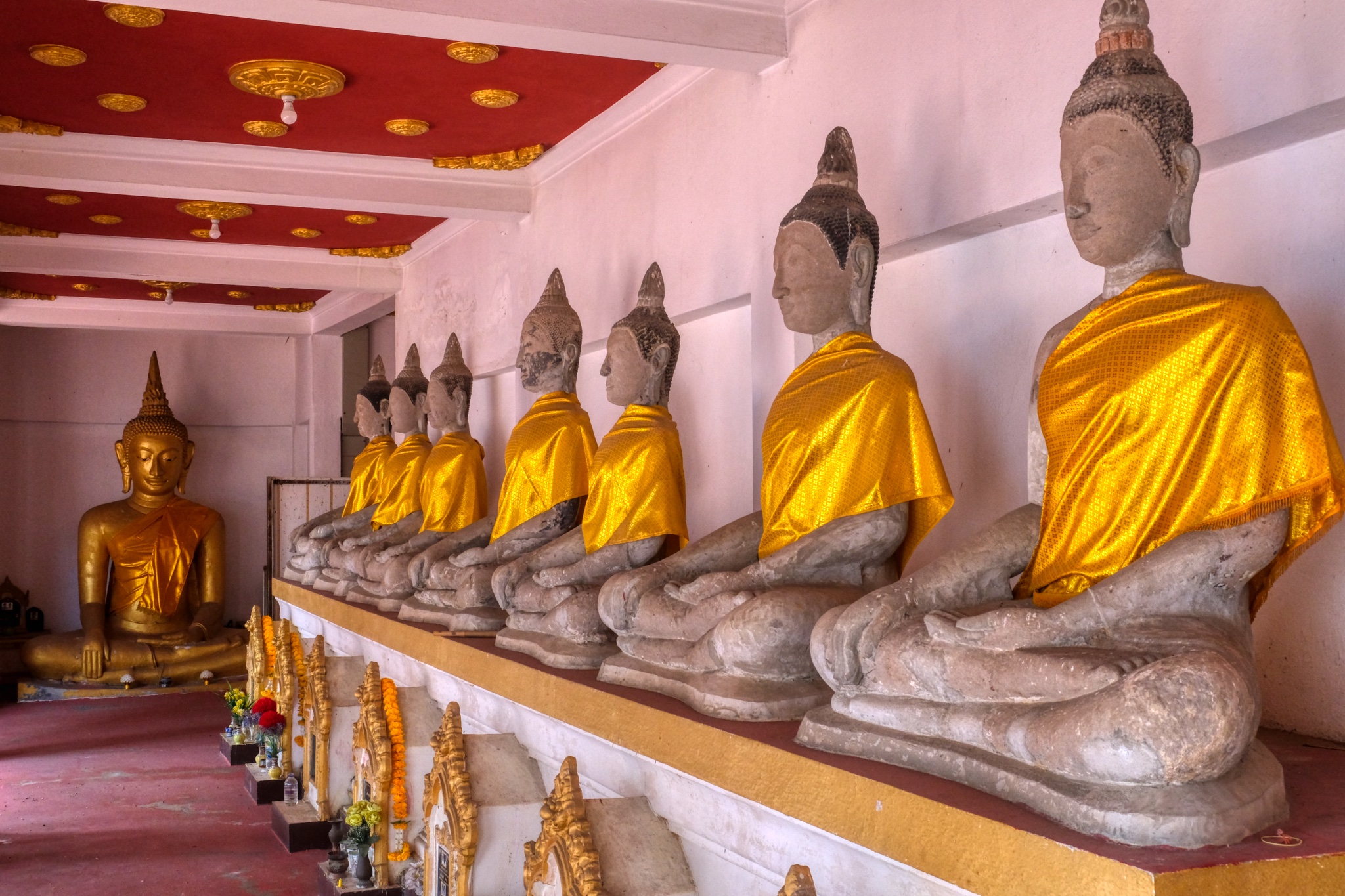 Like many Thai wats, there are covered halls lined with Buddha images, often as markers for the cremated remains of former monks and doners, as is the case here.
Like many Thai wats, there are covered halls lined with Buddha images, often as markers for the cremated remains of former monks and doners, as is the case here.
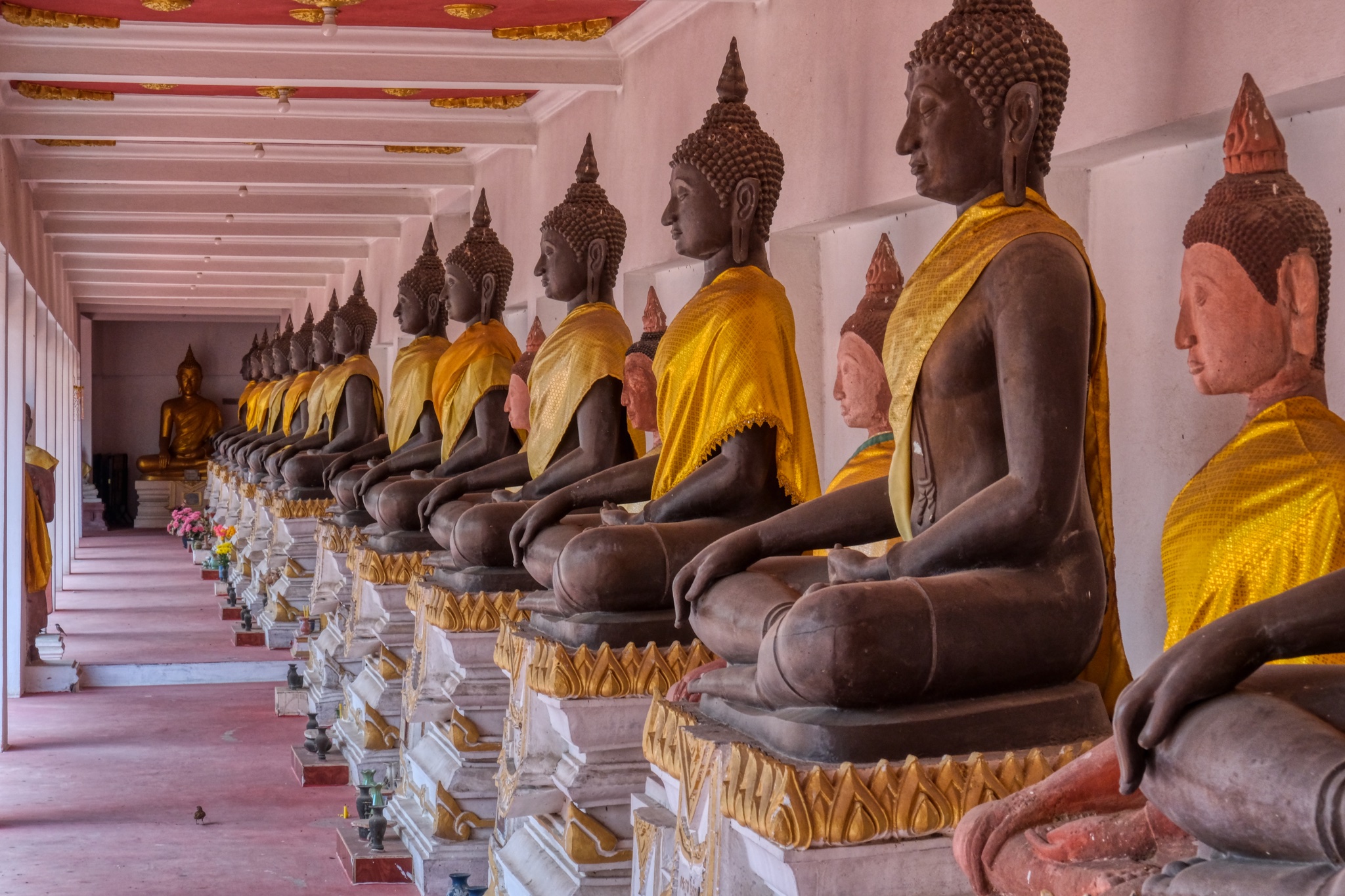 Such a beautiful sight.
Such a beautiful sight.
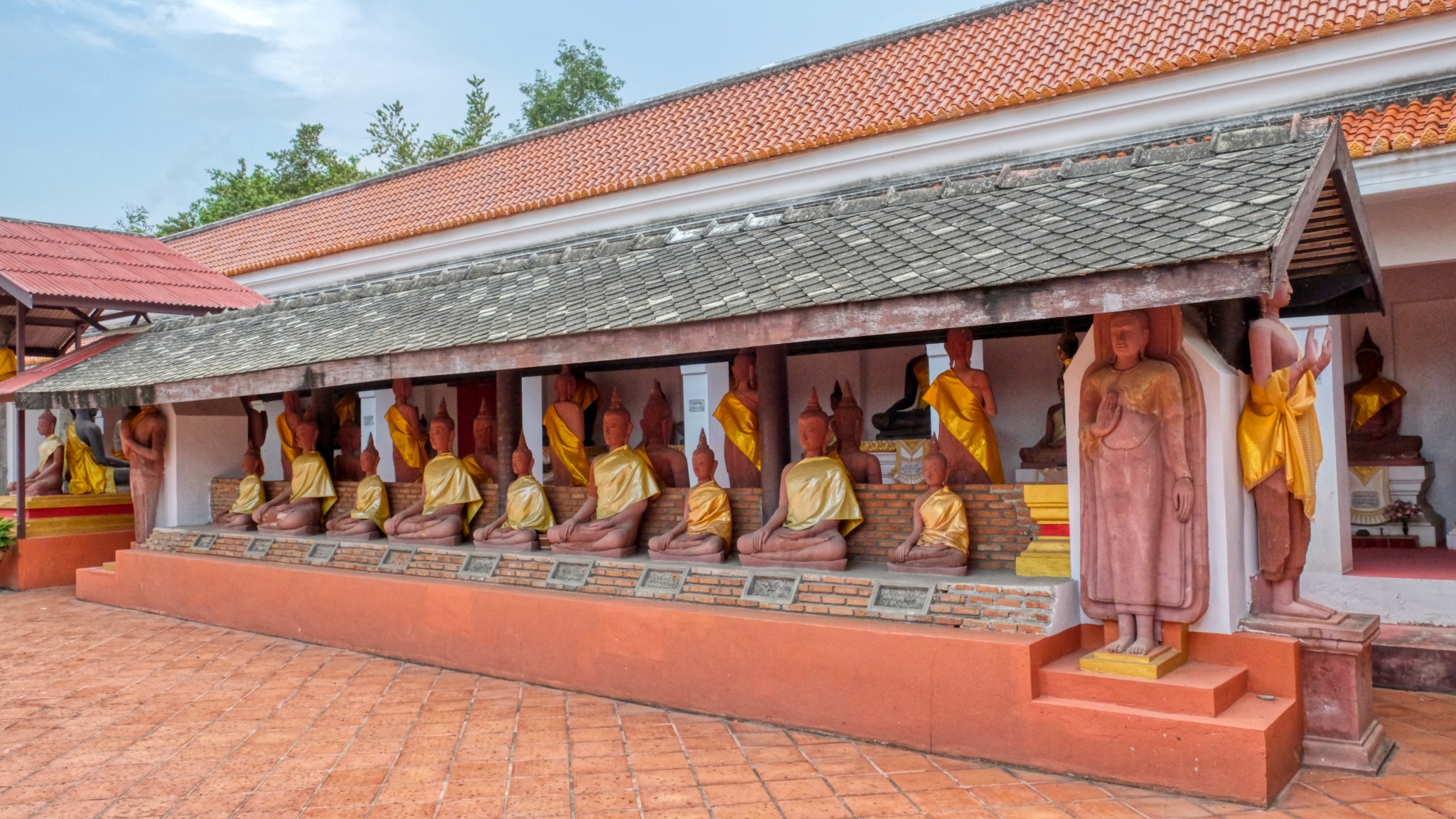 In fact, there are several rows of these grave marking Buddha statues.
In fact, there are several rows of these grave marking Buddha statues.
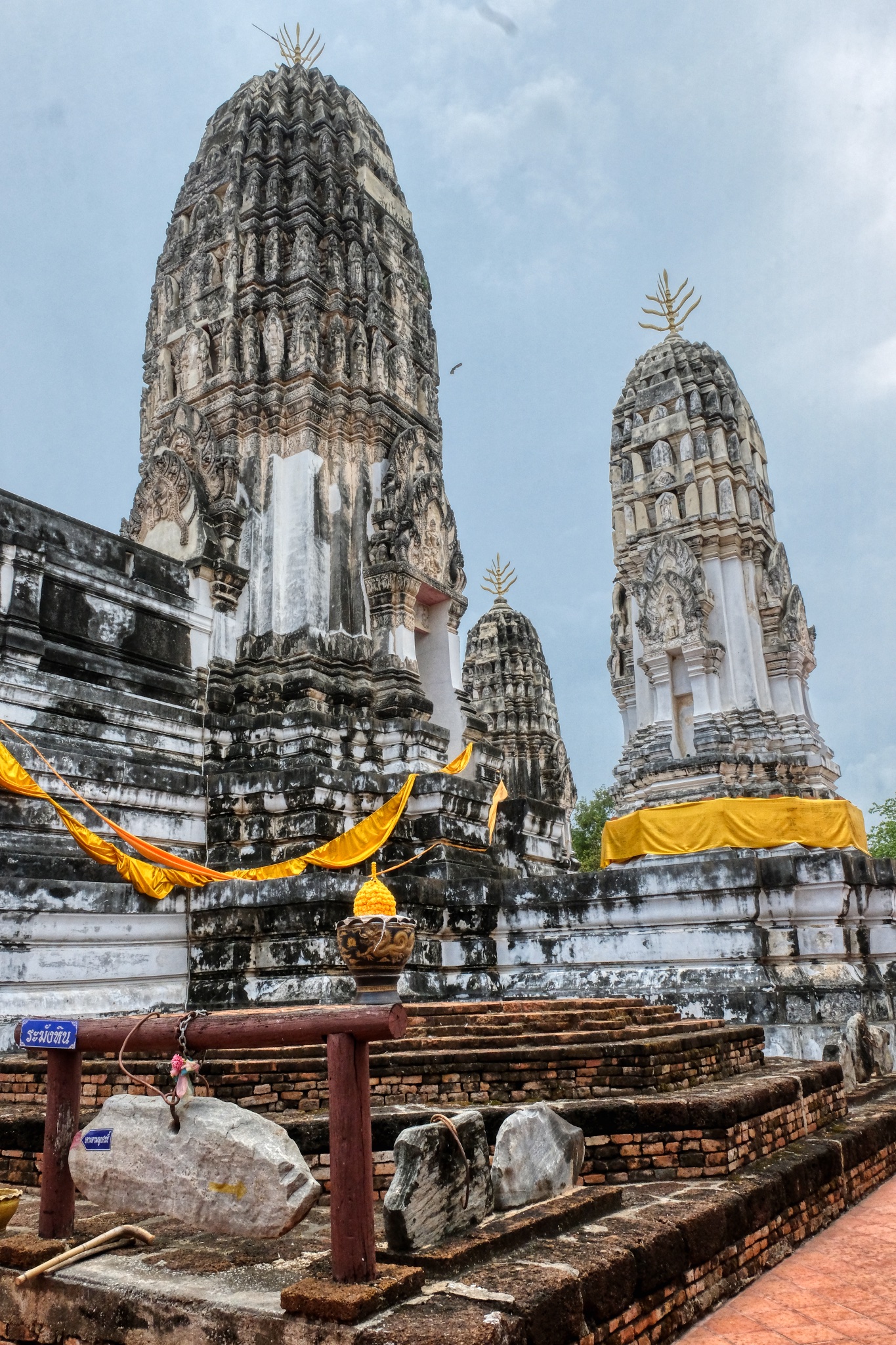 The Five Prangs. At the center of th Wat is a large courtyard enclosed by a cloister. At the center of the courtyard stand five massive parangs, known as "Phra Prang Ha Yod", or five peak prang. The Khmer/Lopburi style towers were constructed during the Sukhothai era.
The Five Prangs. At the center of th Wat is a large courtyard enclosed by a cloister. At the center of the courtyard stand five massive parangs, known as "Phra Prang Ha Yod", or five peak prang. The Khmer/Lopburi style towers were constructed during the Sukhothai era.
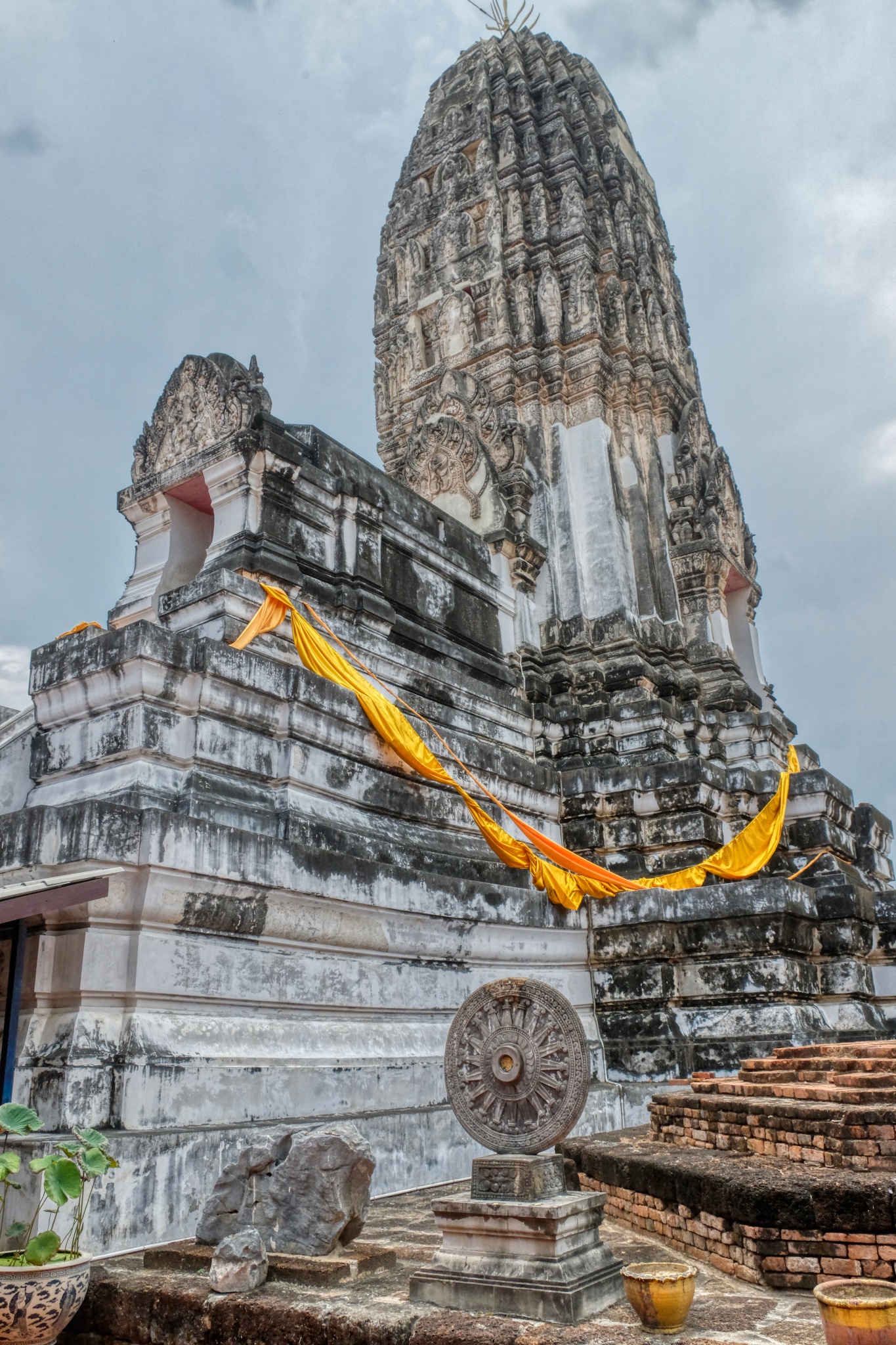
"Surrounded by four smaller ones, the tallest central prang rising over forty meters enshrines Buddha relics. Enshrined in large niches on all of its four faces are standing golden images of the Buddha. The brick plastered prangs, decorated with fine stucco work are topped with a trishula, a three pointed spear, the weapon of the Hindu God Shiva. Sheltering them is a small multi tiered ceremonial umbrella" (citation)
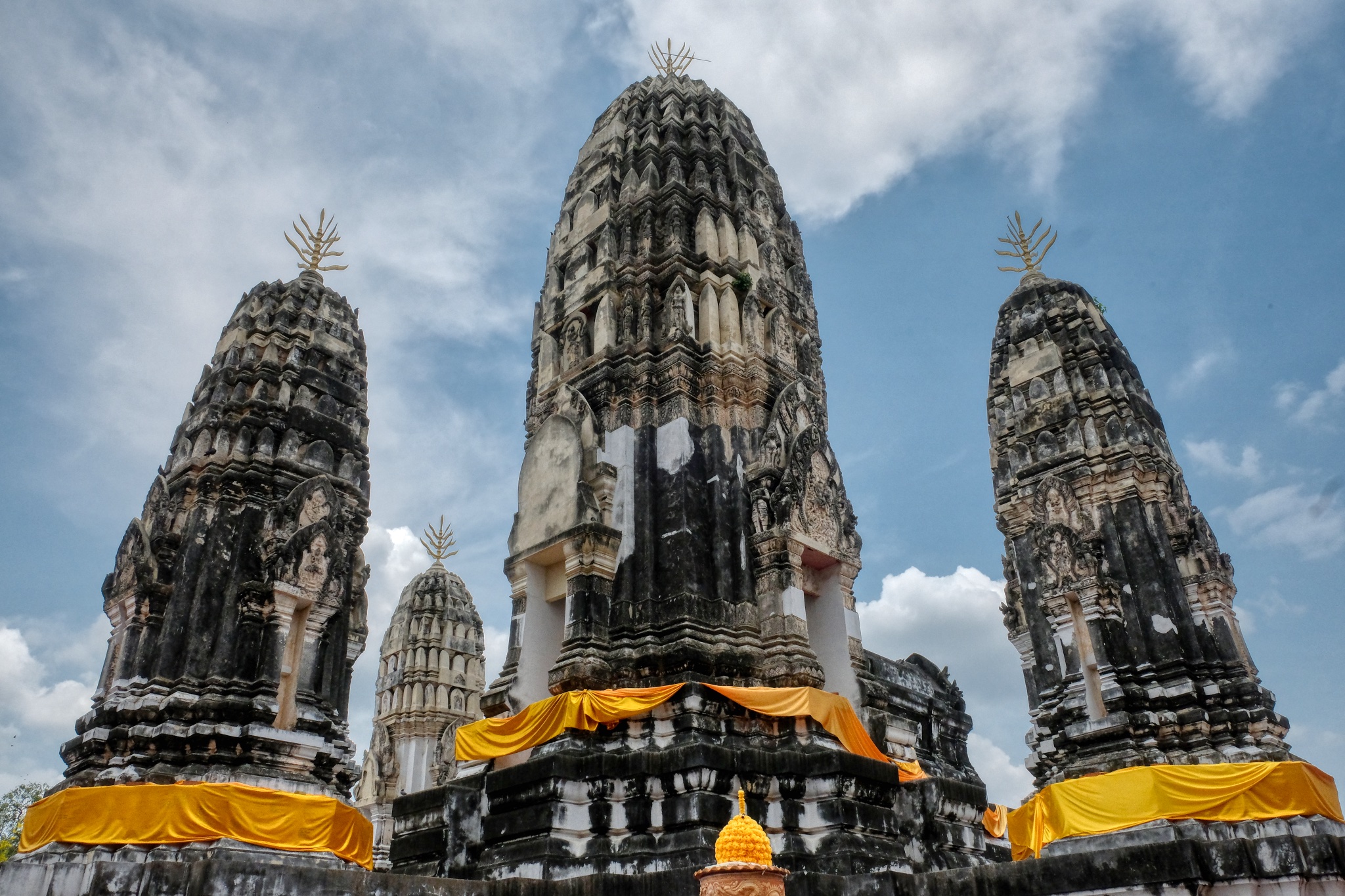 Extraordinary.
Extraordinary.
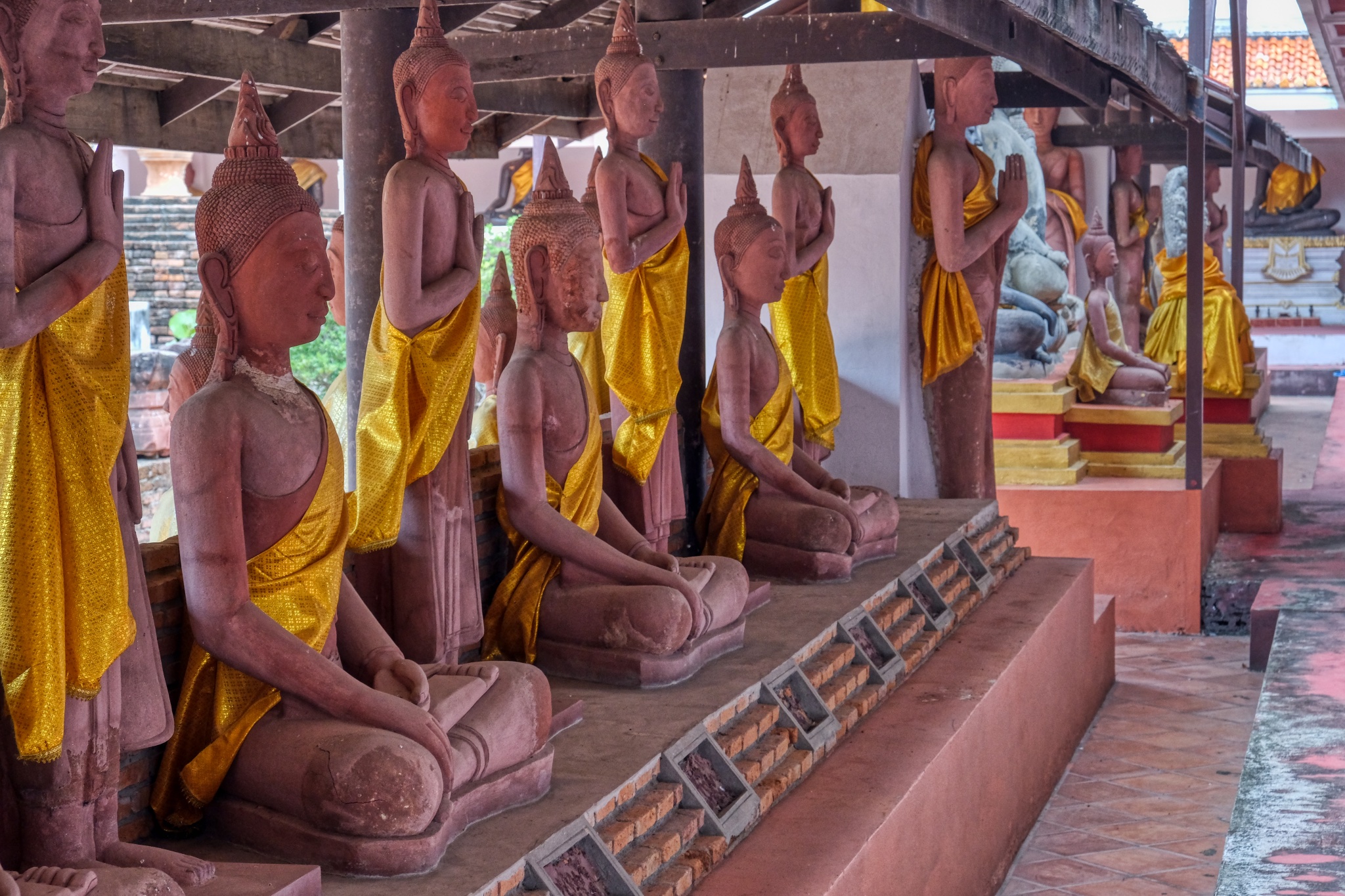 Ah! A phone message from my wife: she is on the 16th hole. Time for me to leave this amazing place. I headed back out along the Buddha colonnades.
Ah! A phone message from my wife: she is on the 16th hole. Time for me to leave this amazing place. I headed back out along the Buddha colonnades.
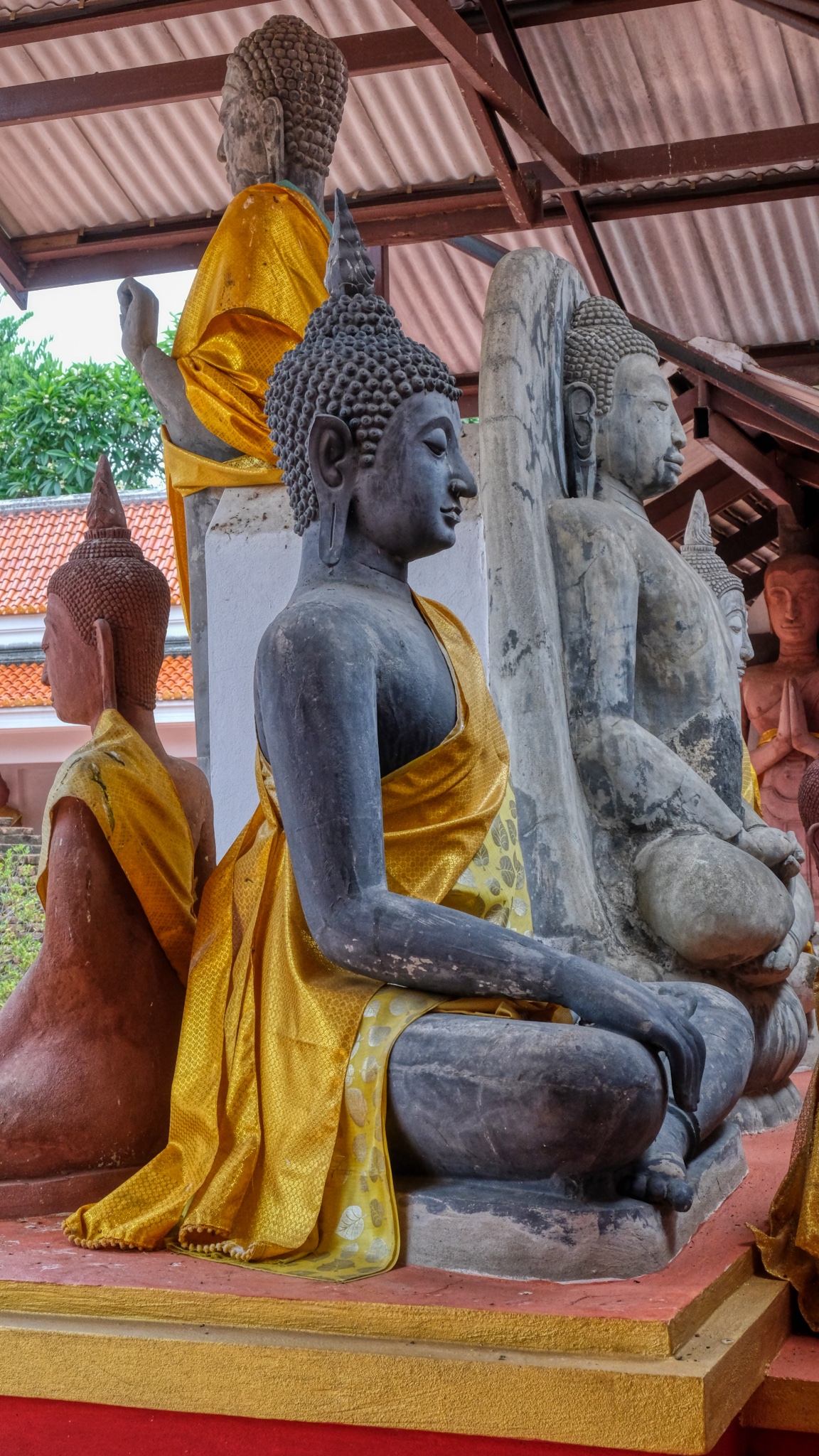 A wide variety of Buddha images present.
A wide variety of Buddha images present.
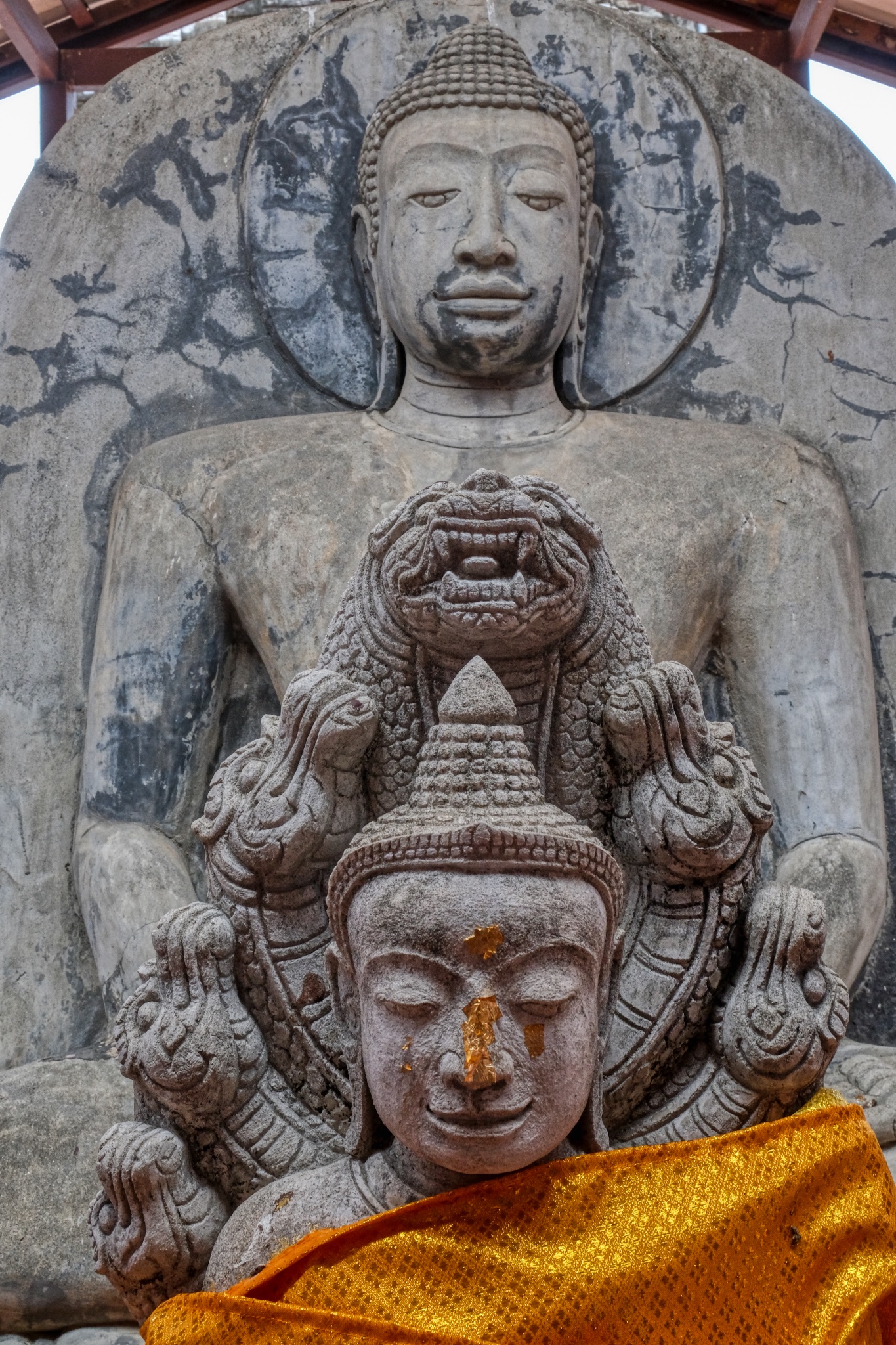 A fine reminder about my mortality and a questioning about what I am doing with my conscieness.
A fine reminder about my mortality and a questioning about what I am doing with my conscieness.
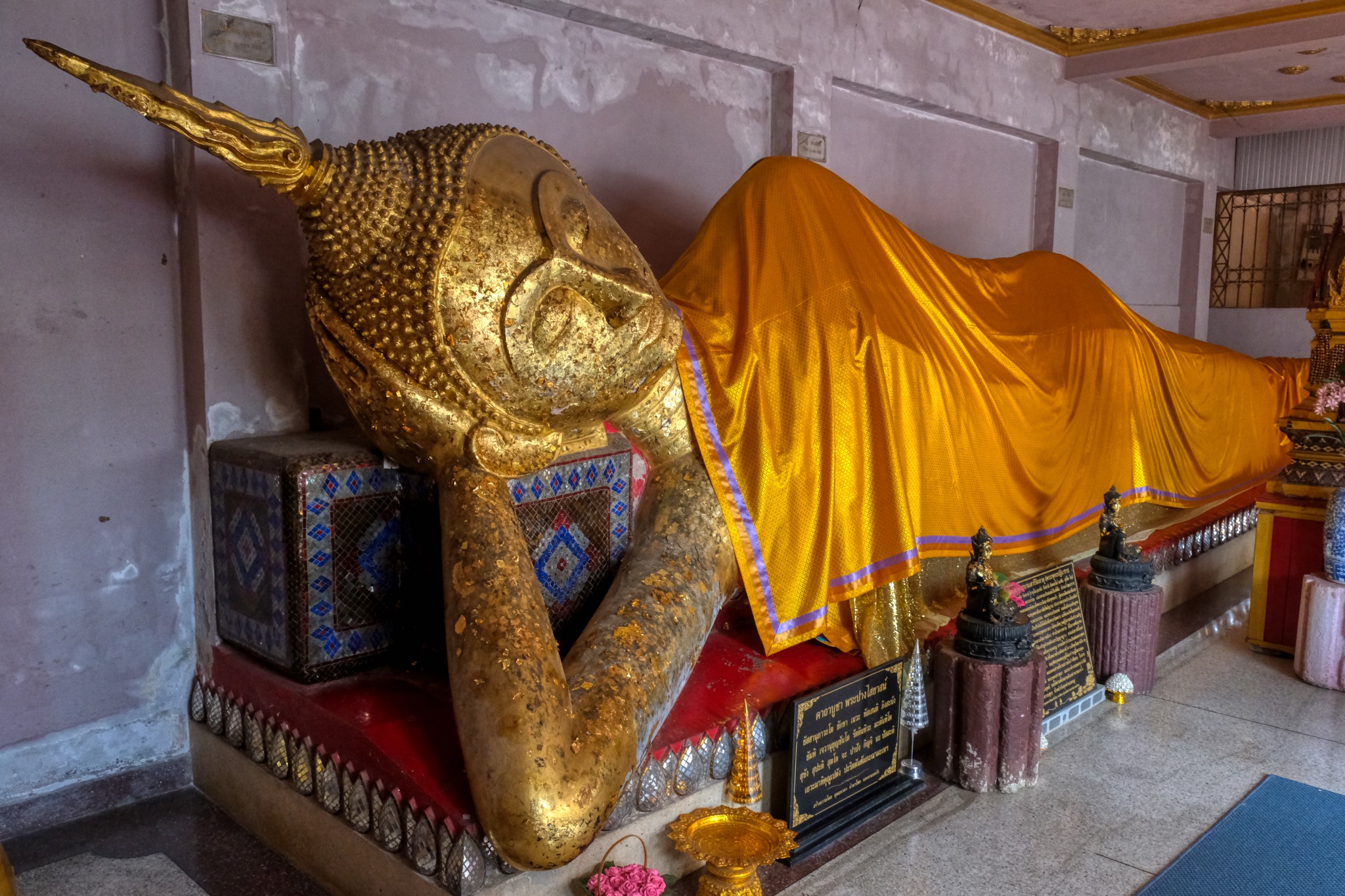 One last grotto . . . to visit a reclining Buddha.
One last grotto . . . to visit a reclining Buddha.
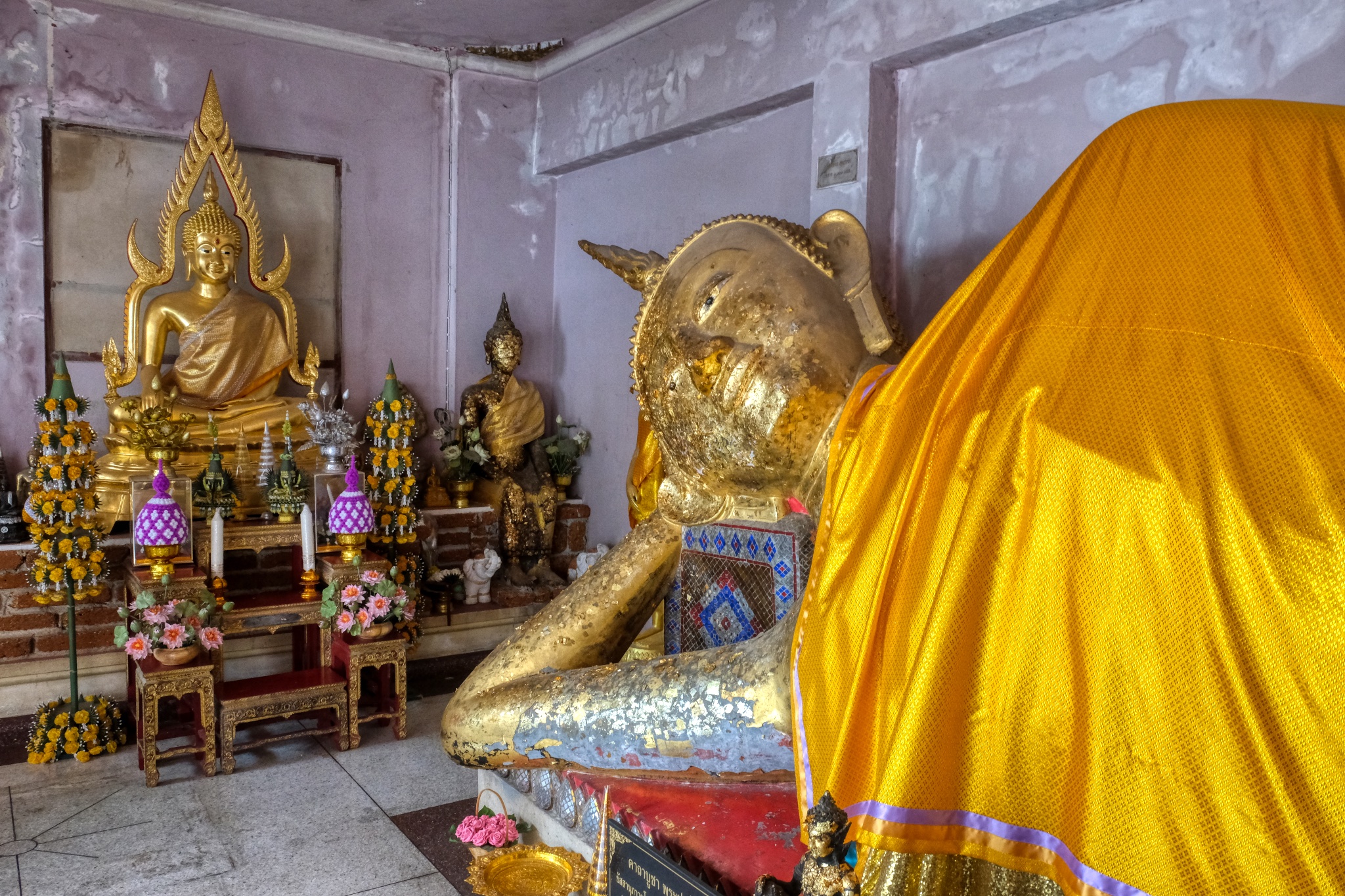 Such a beautiful display. An old 'nun' altar keeper offered me a bottle of water here, which I took. It was a hot day!
Such a beautiful display. An old 'nun' altar keeper offered me a bottle of water here, which I took. It was a hot day!
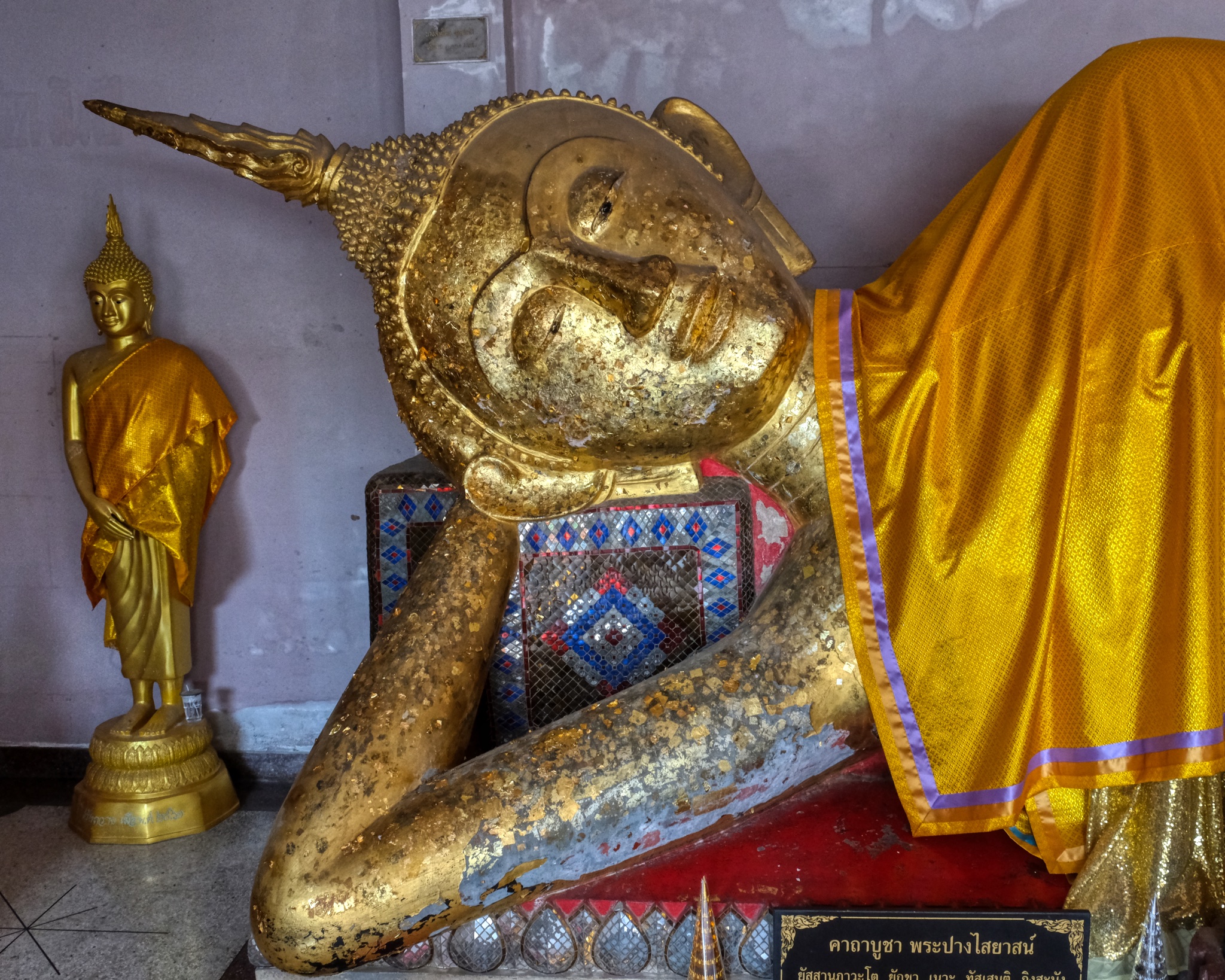 I lingered in this space to pay my respect to the Buddha. I also left my donation here.
I lingered in this space to pay my respect to the Buddha. I also left my donation here.
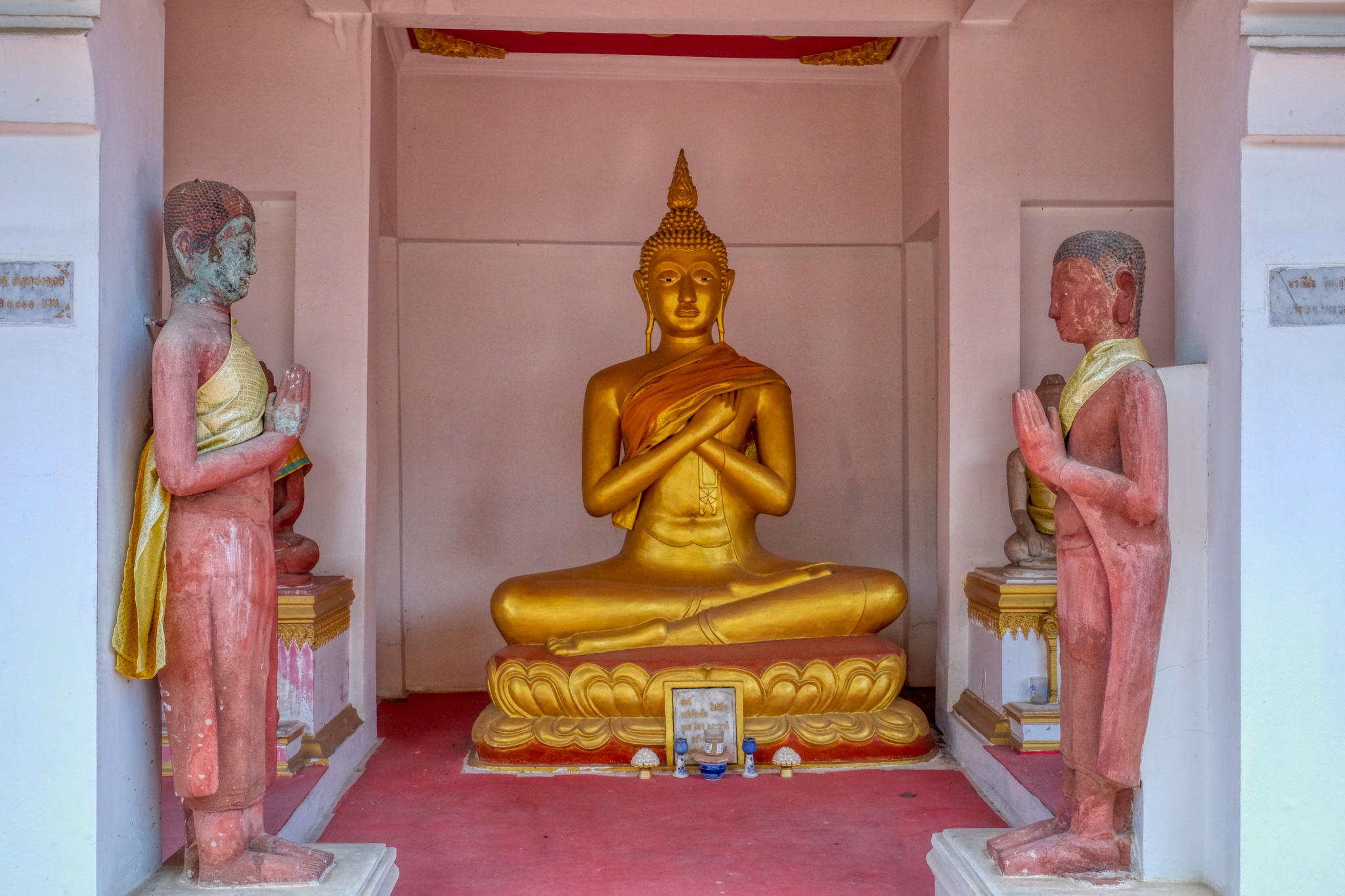 My last stop. Then the 25 minute drive to pick up my wife at the golf course and the 1 hour 45 minute drive back to Hua Hin. A wonderful day . . . .
My last stop. Then the 25 minute drive to pick up my wife at the golf course and the 1 hour 45 minute drive back to Hua Hin. A wonderful day . . . .
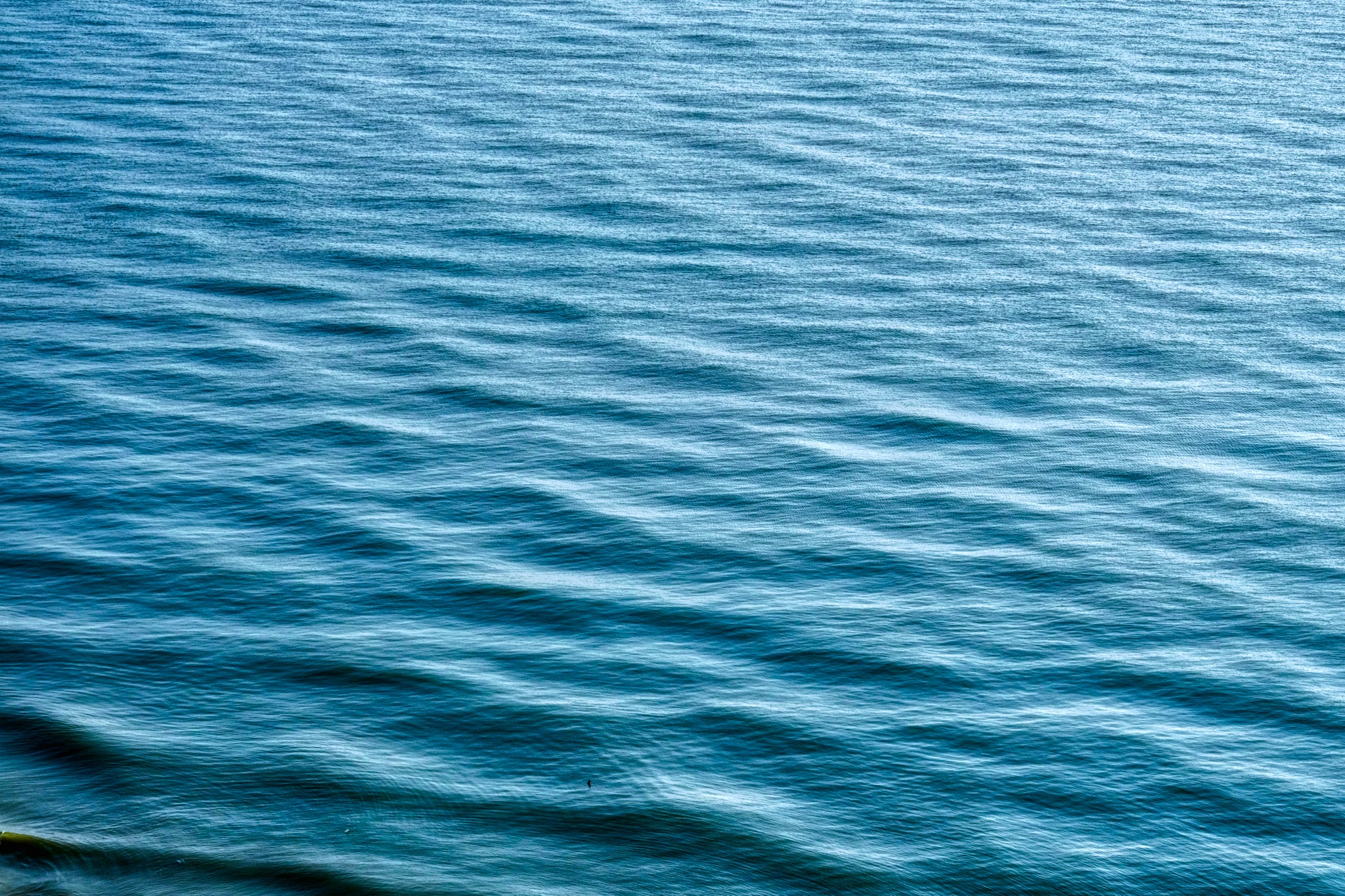 Back on the balcony for a gin & tonic and this strange blue sea . . .
Back on the balcony for a gin & tonic and this strange blue sea . . .
A Petchaburi, Thailand 'Photo Ramble'
 Wednesday, March 17, 2021 at 4:03PM
Wednesday, March 17, 2021 at 4:03PM A 'photo ramble' blog entry in four parts: The Old Town of Petchaburi, The Buddhist Temples (Wats) of Petchaburi Town, Two Old Fishing Ports in Petchaburi Province, and Salt Pan Workers in Petchaburi Province.
PART 1: THE OLD TOWN
 Petchaburi is a provincial capital located between Bangkok and the beach towns of Cha Am and Hua Hin. It is a very small city that I pass by whenever I go to Hua Hin for a beach getaway from the pace of urban Bangkok . . . but I never stop to see what is there . . . until my old friend, John Stiles, and I decided to take a "photo ramble" there last week. [The 11th century Wat Mahathat Worawihan in the background.]
Petchaburi is a provincial capital located between Bangkok and the beach towns of Cha Am and Hua Hin. It is a very small city that I pass by whenever I go to Hua Hin for a beach getaway from the pace of urban Bangkok . . . but I never stop to see what is there . . . until my old friend, John Stiles, and I decided to take a "photo ramble" there last week. [The 11th century Wat Mahathat Worawihan in the background.]
 Petchaburi is only two hours away on good divided highway from home . . . and seemingly in a different decade.
Petchaburi is only two hours away on good divided highway from home . . . and seemingly in a different decade.
 We arrived and parked, as we planned to spend the day on foot. At first look, Petchaburi looks like a lot of old Thai market towns. An old, somewhat worn out downtown area with lots of 'street life' - civic culture. In Thai, Phetchaburi means "city of diamonds".
We arrived and parked, as we planned to spend the day on foot. At first look, Petchaburi looks like a lot of old Thai market towns. An old, somewhat worn out downtown area with lots of 'street life' - civic culture. In Thai, Phetchaburi means "city of diamonds".
 There are some interesting old buildings with a lot of character . . .
There are some interesting old buildings with a lot of character . . .
 . . . and ample material for one of my favorite photographic subjects: old door portraits.
. . . and ample material for one of my favorite photographic subjects: old door portraits.
 A magnificent old door with its life story written all over it.
A magnificent old door with its life story written all over it.
 Old Thai market towns have a special dilapidated charm I really enjoy.
Old Thai market towns have a special dilapidated charm I really enjoy.
 A corner coffee shop. We stopped here for iced coffee with milk. Very good.
A corner coffee shop. We stopped here for iced coffee with milk. Very good.
 The Petchaburi clothing shops spill right out onto the sidewalks.
The Petchaburi clothing shops spill right out onto the sidewalks.
 Buddhist votive offerings shops near the main city center Wat (temple).
Buddhist votive offerings shops near the main city center Wat (temple).
 These old wooden shop houses are slowly disappearing in Thailand's larger towns and cities.
These old wooden shop houses are slowly disappearing in Thailand's larger towns and cities.
 Our casual stroll brought us into an area of old alleys and a wet market.
Our casual stroll brought us into an area of old alleys and a wet market.
 We were literally stopped in our tracks when we rounded a corner into this narrow alley . . . and found a street full of art. Fantastic!
We were literally stopped in our tracks when we rounded a corner into this narrow alley . . . and found a street full of art. Fantastic!
 This was such a whimsical painting, made more so by the actual, real door knob that had been mounted in the wall!
This was such a whimsical painting, made more so by the actual, real door knob that had been mounted in the wall!
 The wall art was wonderfully integrated into the structures of the alley.
The wall art was wonderfully integrated into the structures of the alley.
 Dragon art . . .
Dragon art . . .
 A drayman starting his rounds in front of a fish mural. Wonderful!
A drayman starting his rounds in front of a fish mural. Wonderful!
 There was a 'missing building' in the art alley . . . no problem: paint the revered former King of Thailand on the exposed end . . .
There was a 'missing building' in the art alley . . . no problem: paint the revered former King of Thailand on the exposed end . . .
 There seemed to be a "pet" theme across much of the alley art work.
There seemed to be a "pet" theme across much of the alley art work.
 Scrumptious and stylish . . .
Scrumptious and stylish . . .
 A wall of sweet kitties.
A wall of sweet kitties.
 None of this Petchaburi alley art was signed, but we guessed that these two lovely people were the artists.
None of this Petchaburi alley art was signed, but we guessed that these two lovely people were the artists.
 Refreshed with Art, we walked on through the alleys of old Petchaburi town.
Refreshed with Art, we walked on through the alleys of old Petchaburi town.
 There were many very old shops in Peetchaburi . . . from a time before big box franchises and bar code stock control.
There were many very old shops in Peetchaburi . . . from a time before big box franchises and bar code stock control.
 I had the feeling that this woman has been sitting in this auto parts shop for a very, very long time.
I had the feeling that this woman has been sitting in this auto parts shop for a very, very long time.
 A city fabric shop . . . with cushions and plastic door mats.
A city fabric shop . . . with cushions and plastic door mats.
 My friend John among the basketry taking candid street photos.
My friend John among the basketry taking candid street photos.
 Our wanderings brought us to the Petchaburi River, which bisects the city.
Our wanderings brought us to the Petchaburi River, which bisects the city.
 We stopped here for a delicious lunch of noodle soup. Gotta love Thai street food!
We stopped here for a delicious lunch of noodle soup. Gotta love Thai street food!
 We left the old town and its interesting old alleys to explore the many Wats.
We left the old town and its interesting old alleys to explore the many Wats.
PART 2: THE BUDDHIST TEMPLES
 Wat Khoi on the outskirts of Petchaburi, near the hilltop Wat.
Wat Khoi on the outskirts of Petchaburi, near the hilltop Wat.
 Wat Khoi is a very special and architecturally unique Wat.
Wat Khoi is a very special and architecturally unique Wat.
 Wat Khoi is in the shadow of the Petchaburi hilltop Phra Nakhon Khiri (Khao Wang).
Wat Khoi is in the shadow of the Petchaburi hilltop Phra Nakhon Khiri (Khao Wang).
 There is a very beautiful Kuan Yin statue in the garden of Wat Khoi.
There is a very beautiful Kuan Yin statue in the garden of Wat Khoi.
 Wat Khoi had these amazing. worked metal bas reliefs of Thai people across a wall.
Wat Khoi had these amazing. worked metal bas reliefs of Thai people across a wall.
 The 500 year old Wat Sa-Bua was once a center of Buddhist evangelism in southern Thailand.
The 500 year old Wat Sa-Bua was once a center of Buddhist evangelism in southern Thailand.
 Two kind Wat Sa-Bua monks opened up the ancient Wat for us to take photos. Thank you.
Two kind Wat Sa-Bua monks opened up the ancient Wat for us to take photos. Thank you.
 This black Buddha statue is said to be even older than the Wat, +500 years old.
This black Buddha statue is said to be even older than the Wat, +500 years old.
 An amazing tree on the Wat grounds . . . and a monkey!
An amazing tree on the Wat grounds . . . and a monkey!
 Wat Sa-Bua is built up against a wooded hill with many monkeys scampering all over!
Wat Sa-Bua is built up against a wooded hill with many monkeys scampering all over!
 This ornery fellow let me know I was getting close enough.
This ornery fellow let me know I was getting close enough.
 The rocky hillside behind Wat Sa-Bua haad fantastic old chedis.
The rocky hillside behind Wat Sa-Bua haad fantastic old chedis.
 A beautiful and highly revered chedi.
A beautiful and highly revered chedi.
 We enjoyed our time at Wat Sa-Bua, but walked on up the road to see more Wats nearby . . .
We enjoyed our time at Wat Sa-Bua, but walked on up the road to see more Wats nearby . . .
 The area near the hill attracted many monkeys . . . some ventured out into the nearby neighborhood on a monkey elevated highway!
The area near the hill attracted many monkeys . . . some ventured out into the nearby neighborhood on a monkey elevated highway!
 Yep, just a monkey hanging out on your roof.
Yep, just a monkey hanging out on your roof.
 We drove up a small drive along the hillside hoping it would take us to the uppermost temples, but the road did not go all the way up. No problem, we found Wat Rattana Trai on the way.
We drove up a small drive along the hillside hoping it would take us to the uppermost temples, but the road did not go all the way up. No problem, we found Wat Rattana Trai on the way.
 There was a marvelous old Wat at this hillside Buddhist compound.
There was a marvelous old Wat at this hillside Buddhist compound.
 The beautiful arches and lighting made for perfect portraits. [Your humble photographer.]
The beautiful arches and lighting made for perfect portraits. [Your humble photographer.]
 John and I took turns posing for portraits.
John and I took turns posing for portraits.
 I appreciate old doors, but this one was very special . . .
I appreciate old doors, but this one was very special . . .
 Exquisitely inlaid door panels.
Exquisitely inlaid door panels.
 There were many chedis up the hillside behind Wat Rattana Trai. So interesting.
There were many chedis up the hillside behind Wat Rattana Trai. So interesting.
 We walked back out through the beautiful arches to move on to the city center . . . and the big Wat there.
We walked back out through the beautiful arches to move on to the city center . . . and the big Wat there.
 Near the center of the old city we found the gate to the 11th century Wat Mahathat Worawihan.
Near the center of the old city we found the gate to the 11th century Wat Mahathat Worawihan.
 This ancient Wat had amazing old structures as well as new buildings, like this one. These are living, contemporary places of devotion, not abandoned museums.
This ancient Wat had amazing old structures as well as new buildings, like this one. These are living, contemporary places of devotion, not abandoned museums.
 And we were not disappointed in the ancient temples still in perfect repair. So beautiful.
And we were not disappointed in the ancient temples still in perfect repair. So beautiful.
 Lovely artistry.
Lovely artistry.
 A large Buddha image in one of the many small temple buildings within the grounds of Wat Mahathat Worawihan.
A large Buddha image in one of the many small temple buildings within the grounds of Wat Mahathat Worawihan.
 The Wat temples were very crowed that day with devotees on Makha Bucha Day, a celebration of the ideal Buddhist community started by Buddha Gotama.
The Wat temples were very crowed that day with devotees on Makha Bucha Day, a celebration of the ideal Buddhist community started by Buddha Gotama.
 This temple entry . . . . stunning artistry.
This temple entry . . . . stunning artistry.
 Gorgeous Buddhist art.
Gorgeous Buddhist art.
 There were many monks around the Wat on this special day conducting blessings to the followers.
There were many monks around the Wat on this special day conducting blessings to the followers.
 This monk arrived at the temple and asked the 20 or so devotees to leave for a few minutes while he vacuumed.
This monk arrived at the temple and asked the 20 or so devotees to leave for a few minutes while he vacuumed.
 A 1000 year old window. Magnificent.
A 1000 year old window. Magnificent.
 An ancient founders' marker stone tablet.
An ancient founders' marker stone tablet.
 In our wanderings a round the Wat we came across this interesting building.
In our wanderings a round the Wat we came across this interesting building.
 Inside we found the monk meeting hall where the monks would gather every morning to take teachings from the Abbot.
Inside we found the monk meeting hall where the monks would gather every morning to take teachings from the Abbot.
PART 3: THE FISHING PORTS
 Rather than drive back to Bangkok, we spent the night just outside of Hua Hin. We woke up early to catch the sunrise along the road home. We stopped on this bridge over a canal for wonderful sunrise photos.
Rather than drive back to Bangkok, we spent the night just outside of Hua Hin. We woke up early to catch the sunrise along the road home. We stopped on this bridge over a canal for wonderful sunrise photos.
 Looking west along the same canal in the hot and humid misty Thai morning.
Looking west along the same canal in the hot and humid misty Thai morning.
 The next morning heading back to Bangkok along the tiny local farm roads, we happened upon two fishing ports, the first of which was very small.
The next morning heading back to Bangkok along the tiny local farm roads, we happened upon two fishing ports, the first of which was very small.
 I love these colorful Thai wooden fishing/squid boats.
I love these colorful Thai wooden fishing/squid boats.
 The first roadside fishing port was very small and seemingly very poor.
The first roadside fishing port was very small and seemingly very poor.
 These fishermen festoon their fishing boats' bows with colorful streamers for good luck.
These fishermen festoon their fishing boats' bows with colorful streamers for good luck.
 Where you have fishing boats and fish . . . you have cats.
Where you have fishing boats and fish . . . you have cats.
 There was a primitive charm to this old, unnamed fishing port.
There was a primitive charm to this old, unnamed fishing port.
 The second port we 'discovered', Moo 2 (Bang Tabun, Ban Laem District, Petchaburi Province), was an industrial fishing port. Bigger boats, lots of warehouses and clean, orderly docks.
The second port we 'discovered', Moo 2 (Bang Tabun, Ban Laem District, Petchaburi Province), was an industrial fishing port. Bigger boats, lots of warehouses and clean, orderly docks.
 A very busy port with boats coming and going all the time.
A very busy port with boats coming and going all the time.
 A delightful nautical scene.
A delightful nautical scene.
 Industrial squid boats with their outrigger bright light booms folded in. They catch squid by putting out very bright amber or green lights to lure the squid to the surface where the deck crew scoops them up with net scoops on long poles.
Industrial squid boats with their outrigger bright light booms folded in. They catch squid by putting out very bright amber or green lights to lure the squid to the surface where the deck crew scoops them up with net scoops on long poles.
 There were only a few of these small boats here.
There were only a few of these small boats here.
 I could have stood on this bridge watching the fishing boats come and go all day. But we needed to move on.
I could have stood on this bridge watching the fishing boats come and go all day. But we needed to move on.
 Before leaving the Moo 2 fishing port we explored a nearby Wat with amazing carvings on the roof ends.
Before leaving the Moo 2 fishing port we explored a nearby Wat with amazing carvings on the roof ends.
PART 4: SALT PAN WORKERS
 Back on the small coastal road we drove into a salt pan area with many white egrets.
Back on the small coastal road we drove into a salt pan area with many white egrets.
 We saw many of these old salt warehouses bursting at the seams out in the salt pans as we drove along . . . and wondered if there would be salt harvesting.
We saw many of these old salt warehouses bursting at the seams out in the salt pans as we drove along . . . and wondered if there would be salt harvesting.
 It wasn't long before we found the salt workers toiling in the heat to remove the salt, two baskets-full at a time.
It wasn't long before we found the salt workers toiling in the heat to remove the salt, two baskets-full at a time.
 Damp salt cones, raked by a previous crew, await portage.
Damp salt cones, raked by a previous crew, await portage.
 Hard work: scooping damp salt into your baskets and lugging it out to the road . . . but still a friendly spirit.
Hard work: scooping damp salt into your baskets and lugging it out to the road . . . but still a friendly spirit.
 The 'salt boss' keeping track of basket loads . . . many Thais wear these masks when working in the sun . . . they do not want their skin to become dark.
The 'salt boss' keeping track of basket loads . . . many Thais wear these masks when working in the sun . . . they do not want their skin to become dark.
 There was a steady line of salt porters delivering their loads from the pans.
There was a steady line of salt porters delivering their loads from the pans.
 No reason to not be colorful and stylish . . . .
No reason to not be colorful and stylish . . . .
 Reflecting on our experience, we had a wonder-full 36 hours in Petchaburi city and province. Did I really just say that?
Reflecting on our experience, we had a wonder-full 36 hours in Petchaburi city and province. Did I really just say that?
Visitors From Abroad . . . Another Hua Hin Area Ramble!
 Wednesday, March 25, 2020 at 5:15PM
Wednesday, March 25, 2020 at 5:15PM All in a day . . . all within 20 miles . . .
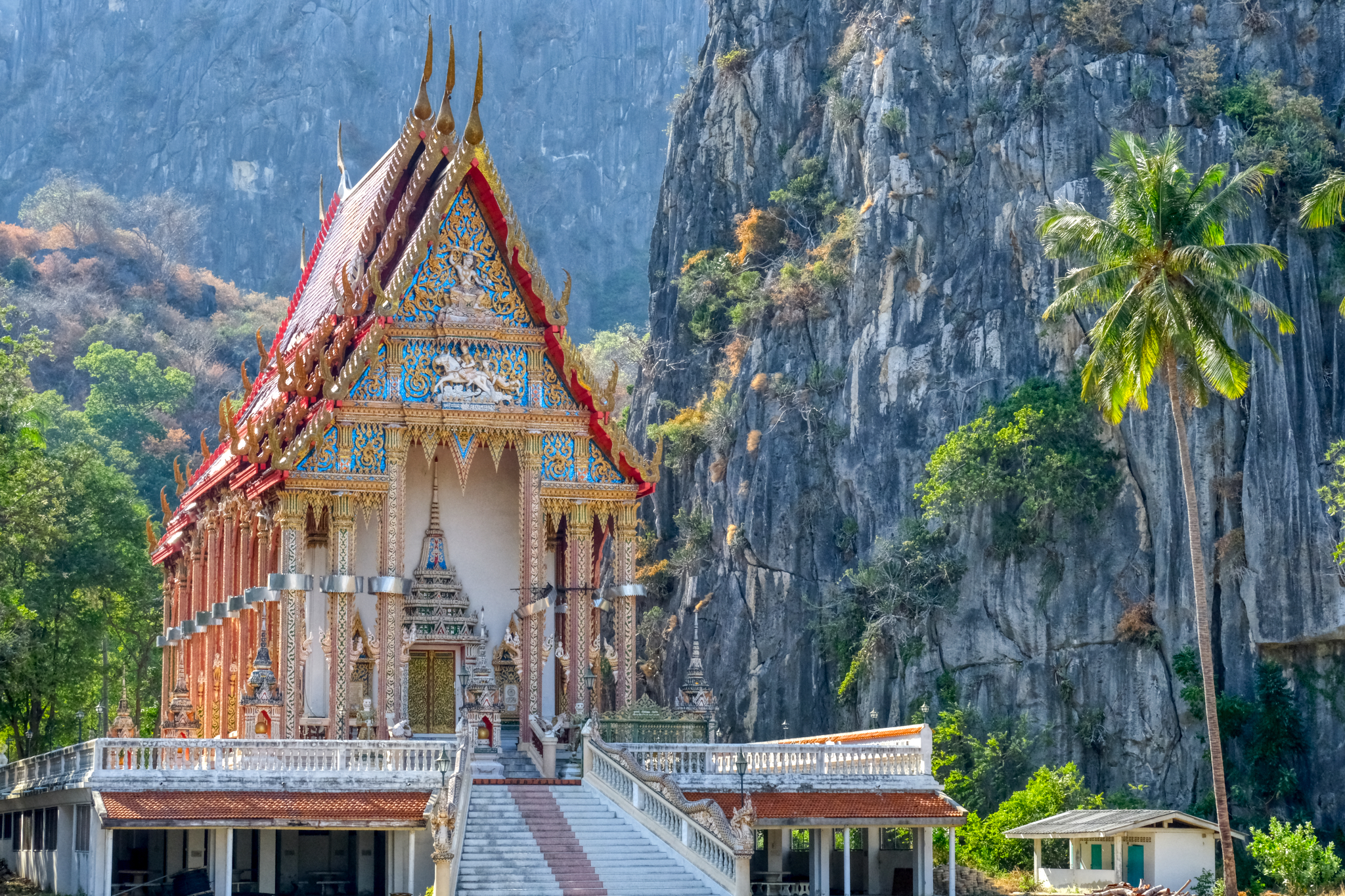 It's always great to have visitors from abroad come to Thailand . . . I get to take day trips out and about . . . usually to places I have never been, so we can explore together.
It's always great to have visitors from abroad come to Thailand . . . I get to take day trips out and about . . . usually to places I have never been, so we can explore together.
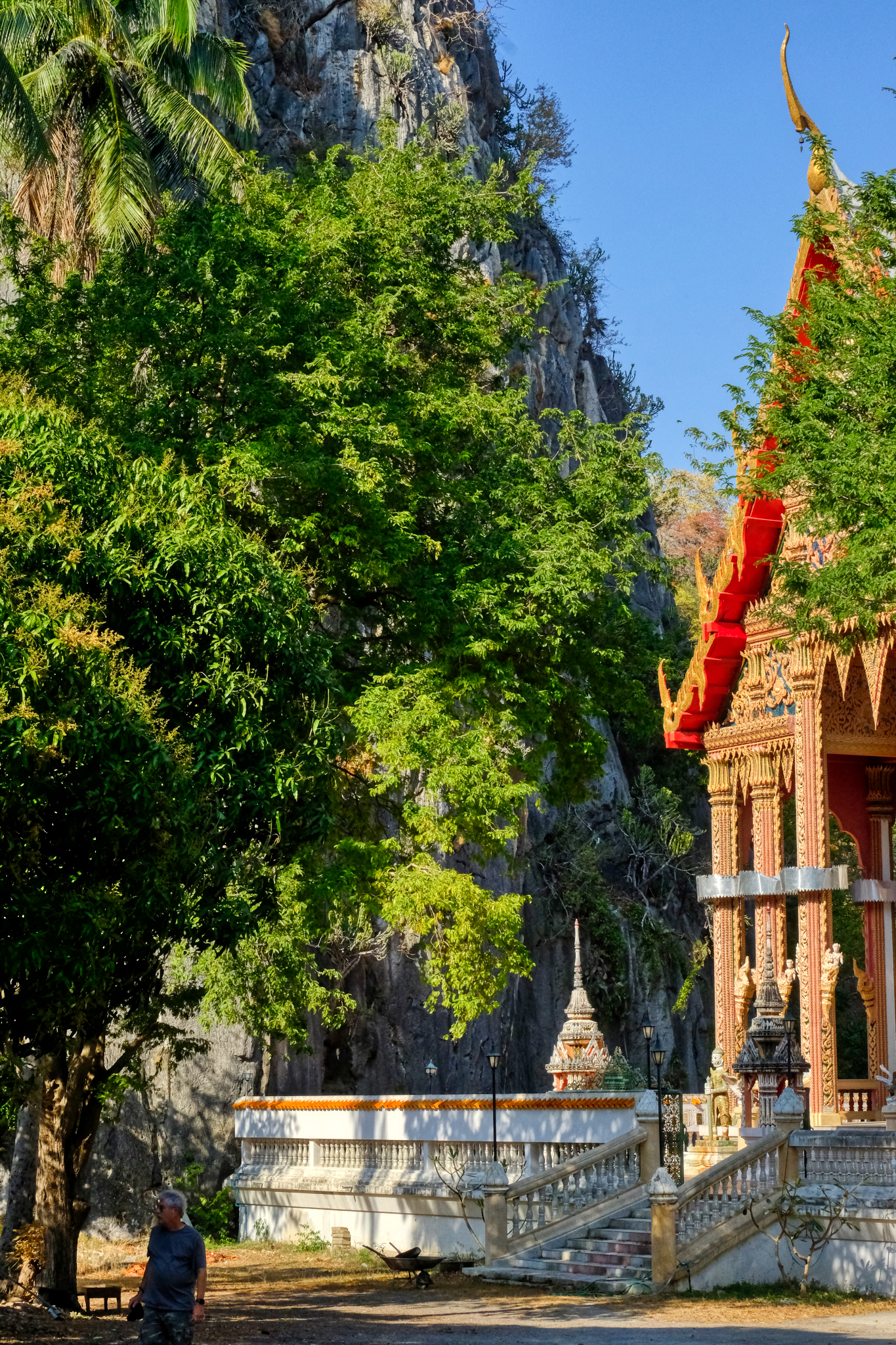 This Buddhist temple (wat) up against steep cliffs is one of my favorites. I pass it often when I am down Hua Hin way . . . but decided to stop and take a look again. Glad we did.
This Buddhist temple (wat) up against steep cliffs is one of my favorites. I pass it often when I am down Hua Hin way . . . but decided to stop and take a look again. Glad we did.
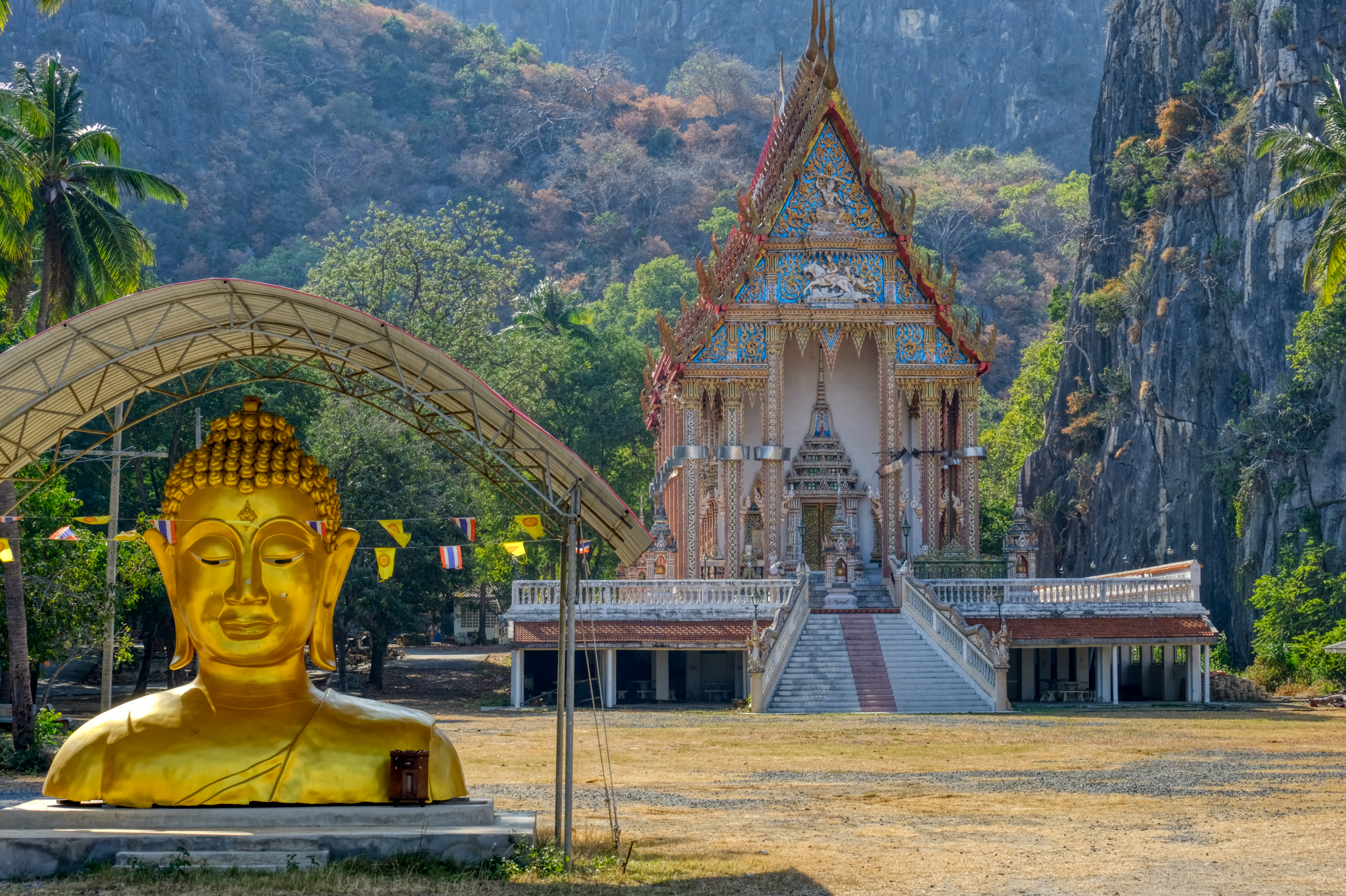
Such a lovely wat . . . looks like they are going to assemble a new giant Buddha image soon.
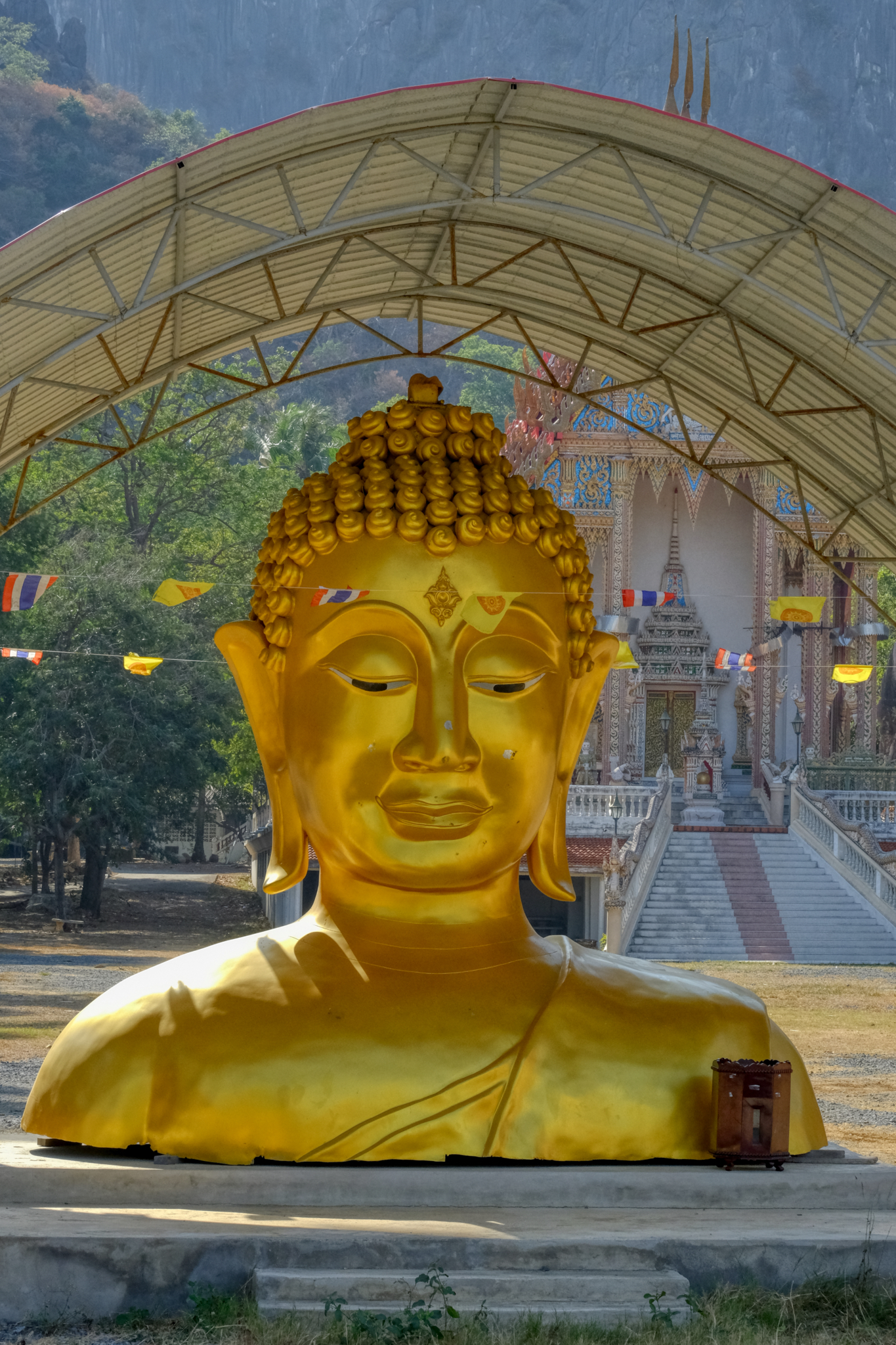
Beautiful workmanship . . . .
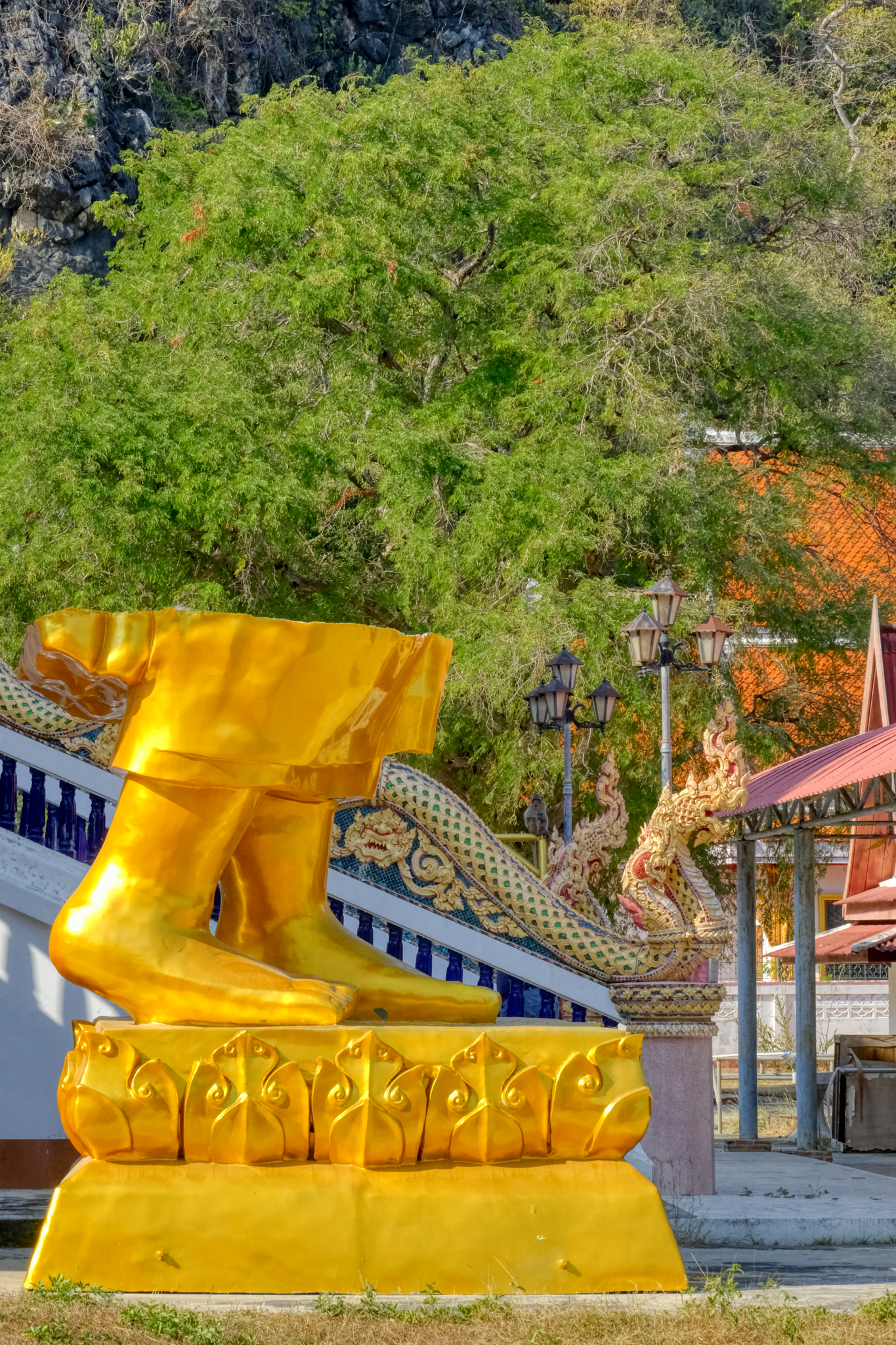
Ah! Looks like a standing Buddha image going up.
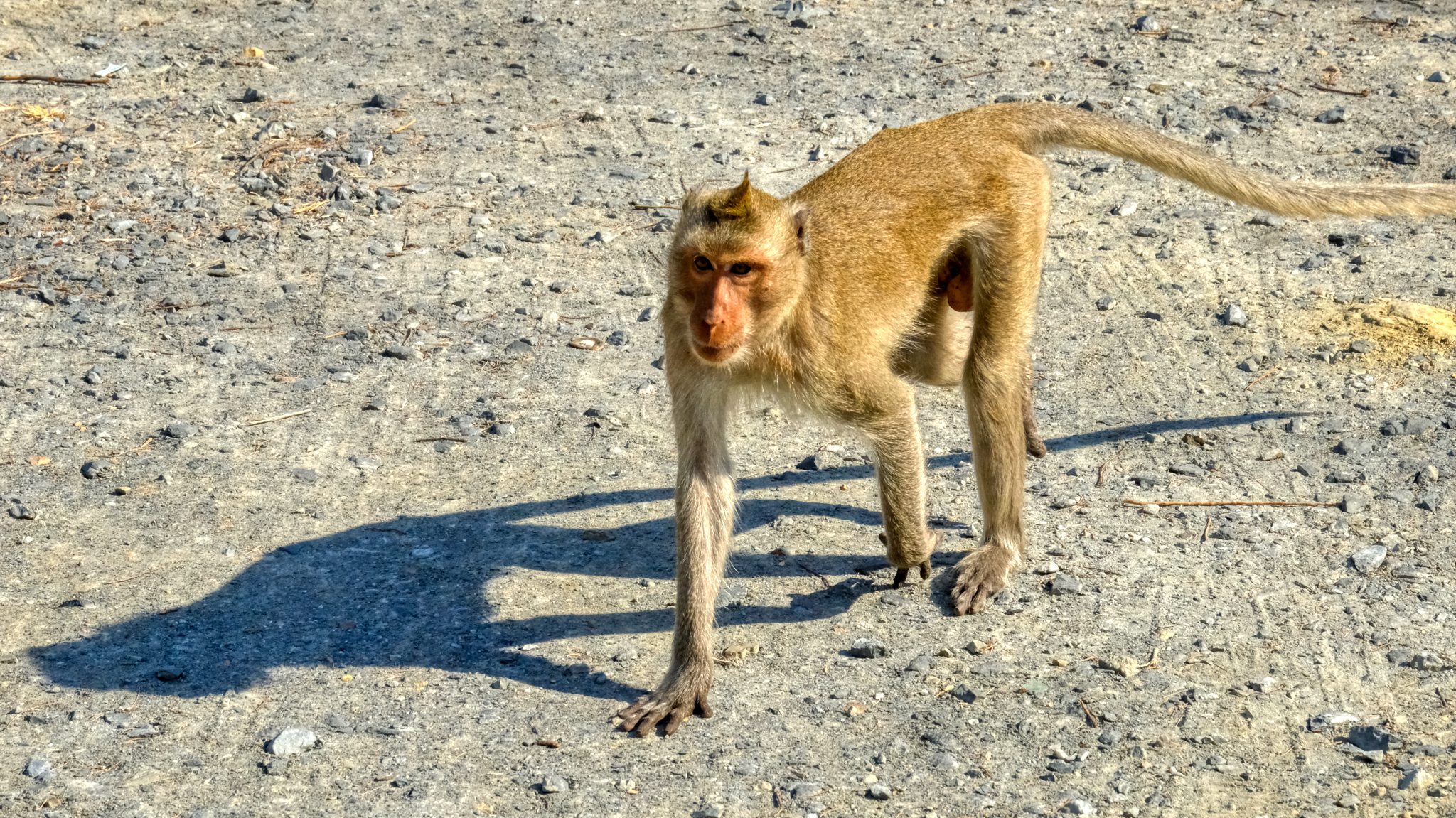 This such an interesting wat . . . lots to see here . . . including a pack of very curious monkeys.
This such an interesting wat . . . lots to see here . . . including a pack of very curious monkeys.
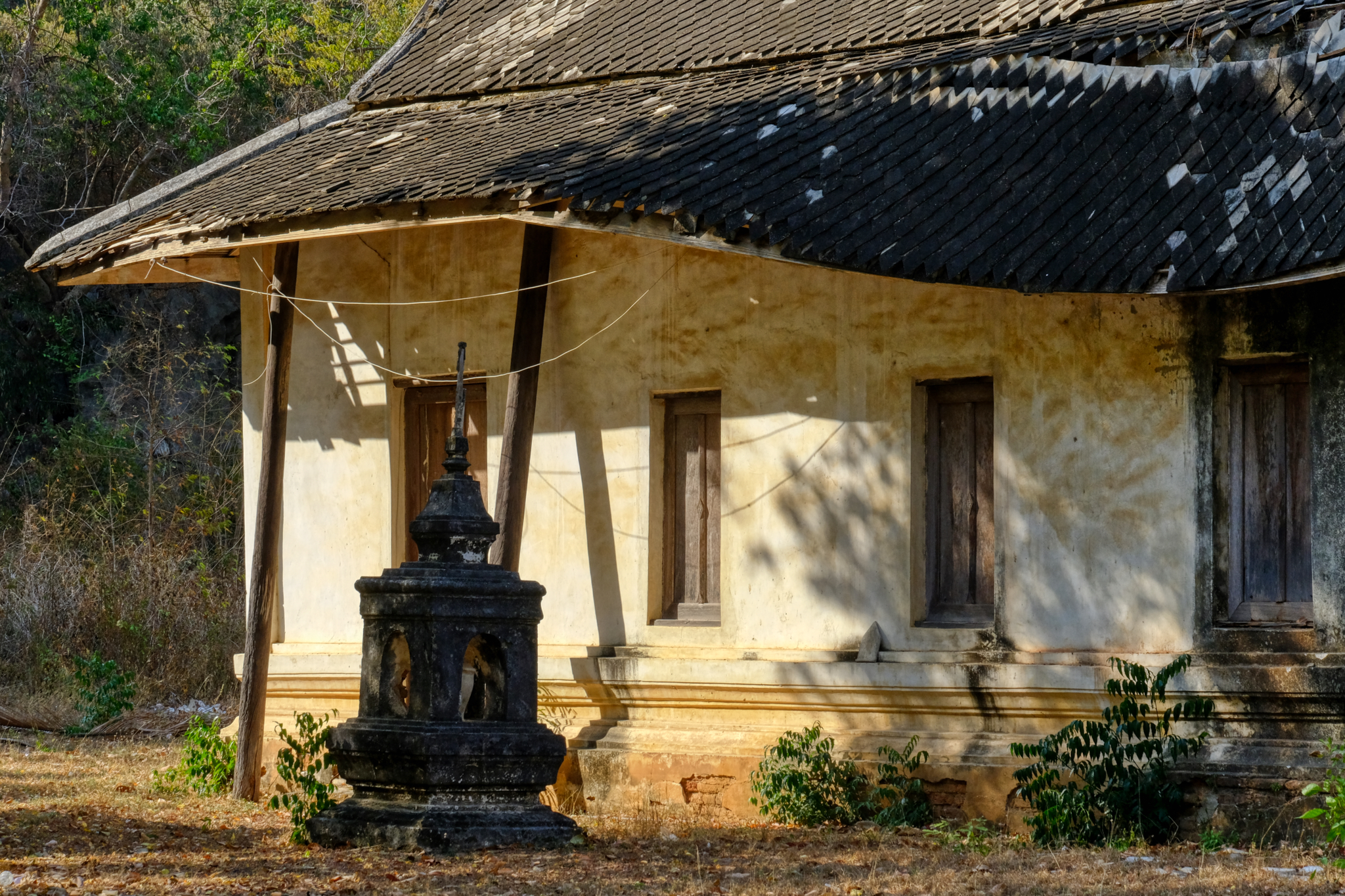 As is often the case at Thai wats, the new buildings are built in front of the older, perhaps original temple structures.
As is often the case at Thai wats, the new buildings are built in front of the older, perhaps original temple structures.
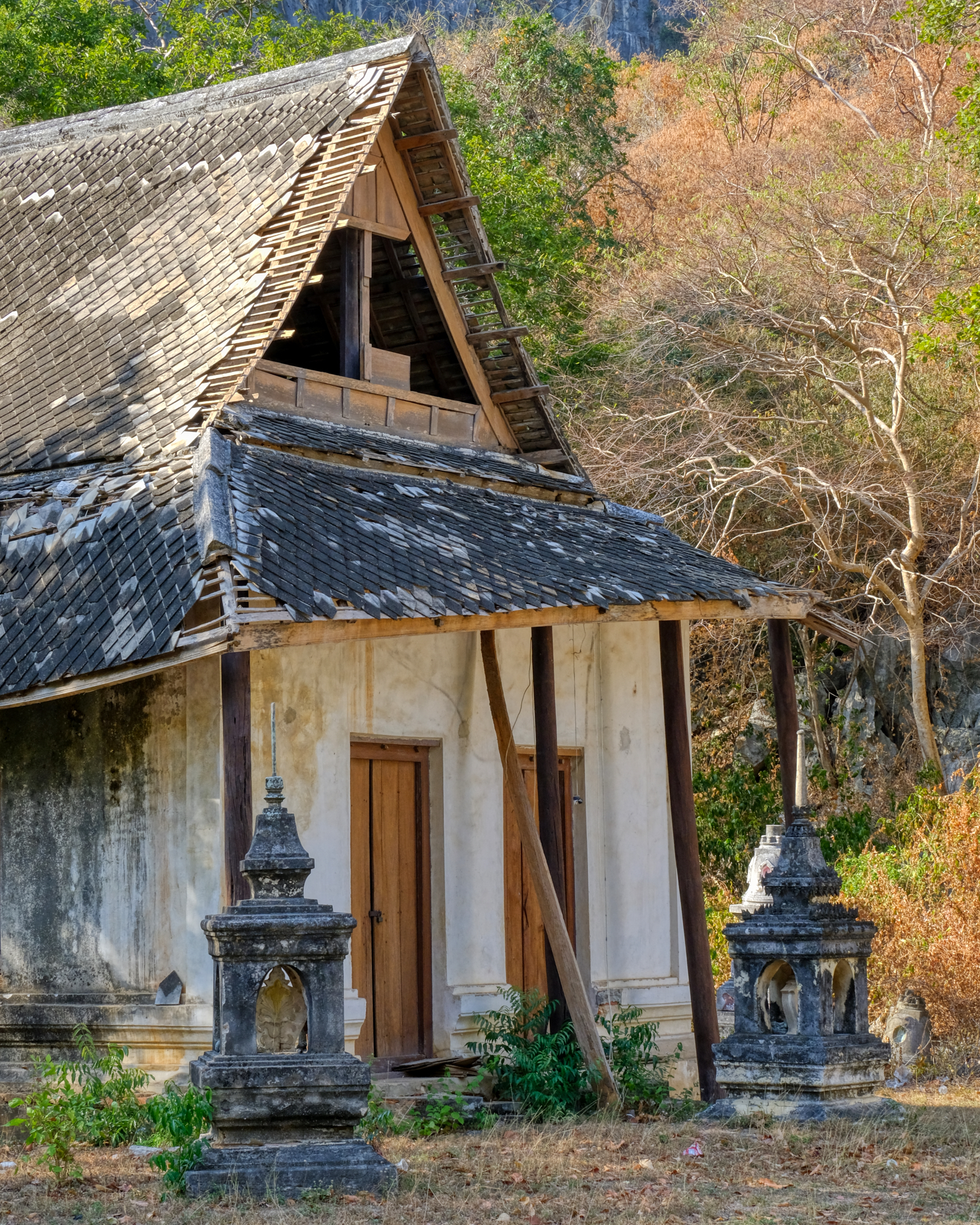 The patina!
The patina!
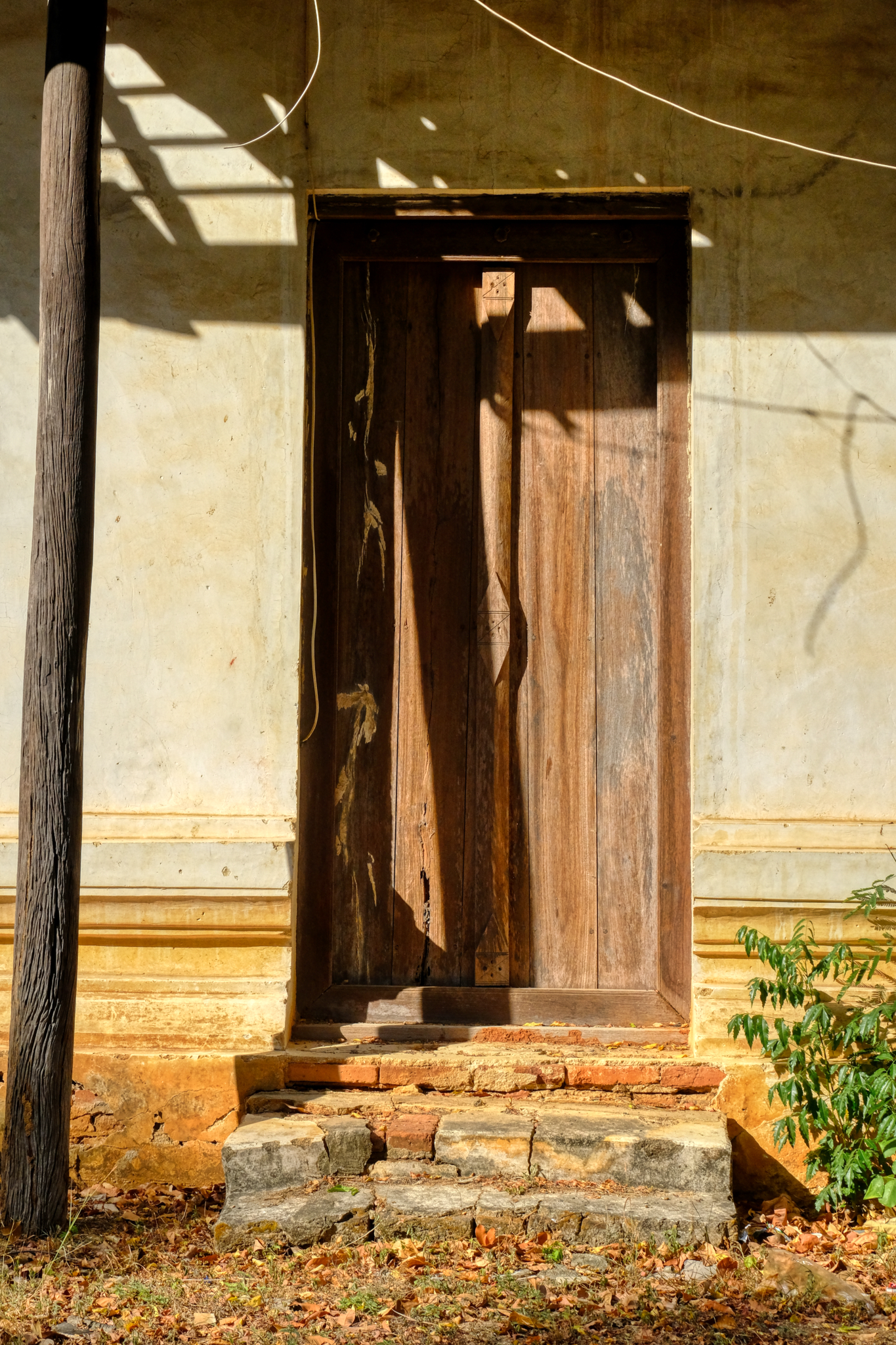 Lovely textures in the filtered afternoon light.
Lovely textures in the filtered afternoon light.
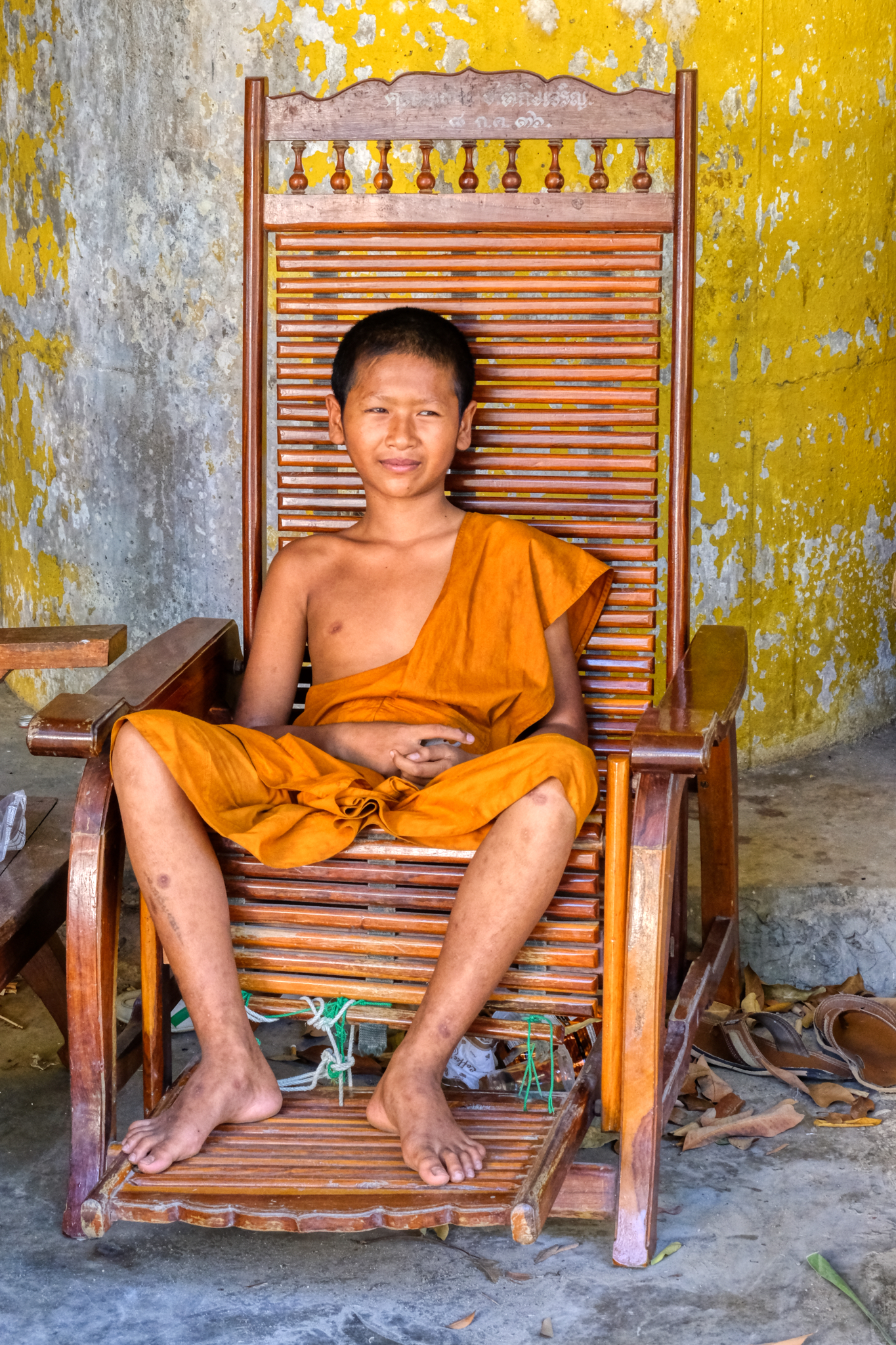 I was surprised to see this young monk! There weren't any other monks at this wat. He kindly gave me permission for so photos. I made sure he saw me put money in the donation box.
I was surprised to see this young monk! There weren't any other monks at this wat. He kindly gave me permission for so photos. I made sure he saw me put money in the donation box.
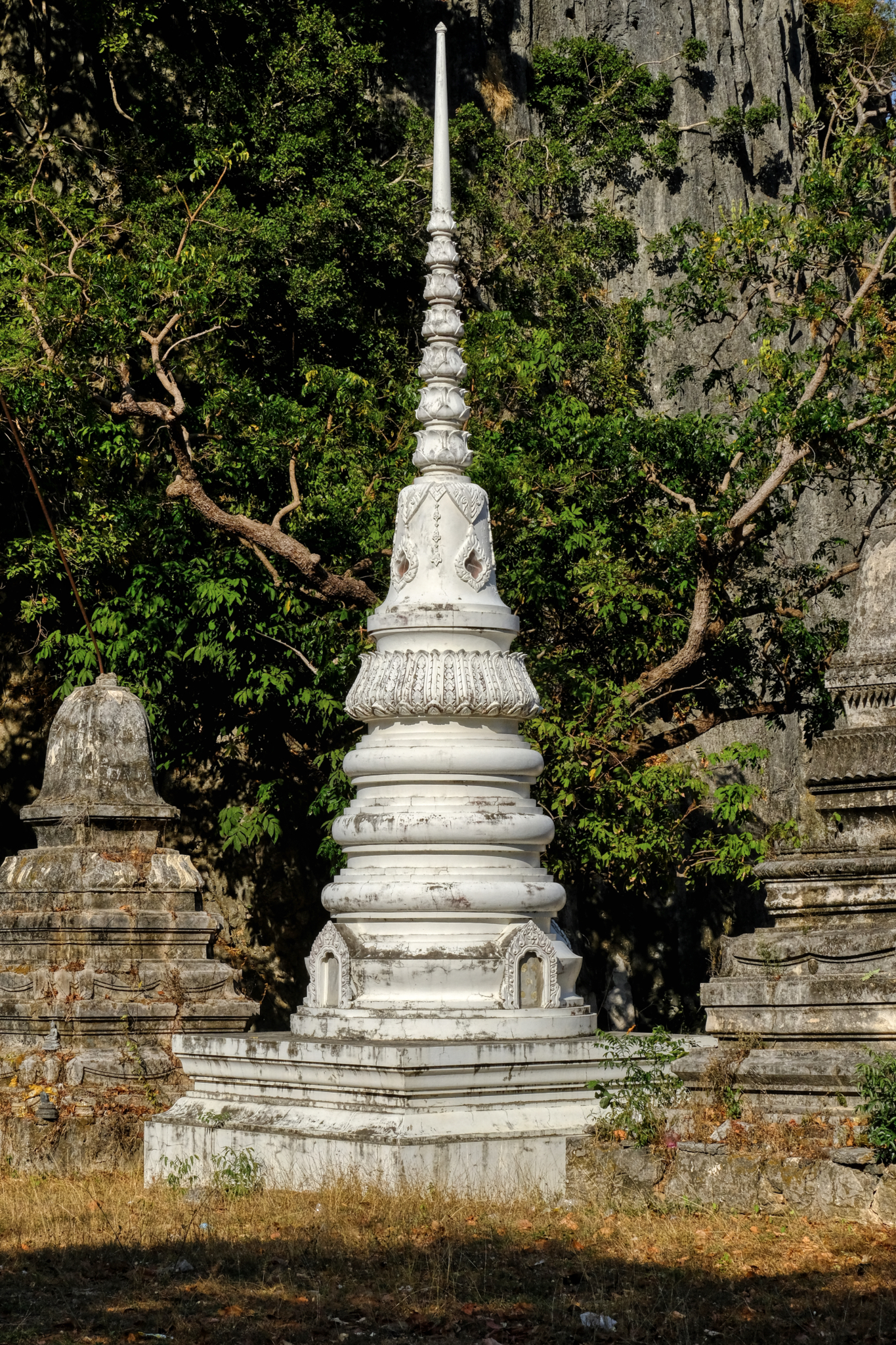 A large, old chedi on the temple grounds. Perhaps a previous revered head monk's final resting place.
A large, old chedi on the temple grounds. Perhaps a previous revered head monk's final resting place.
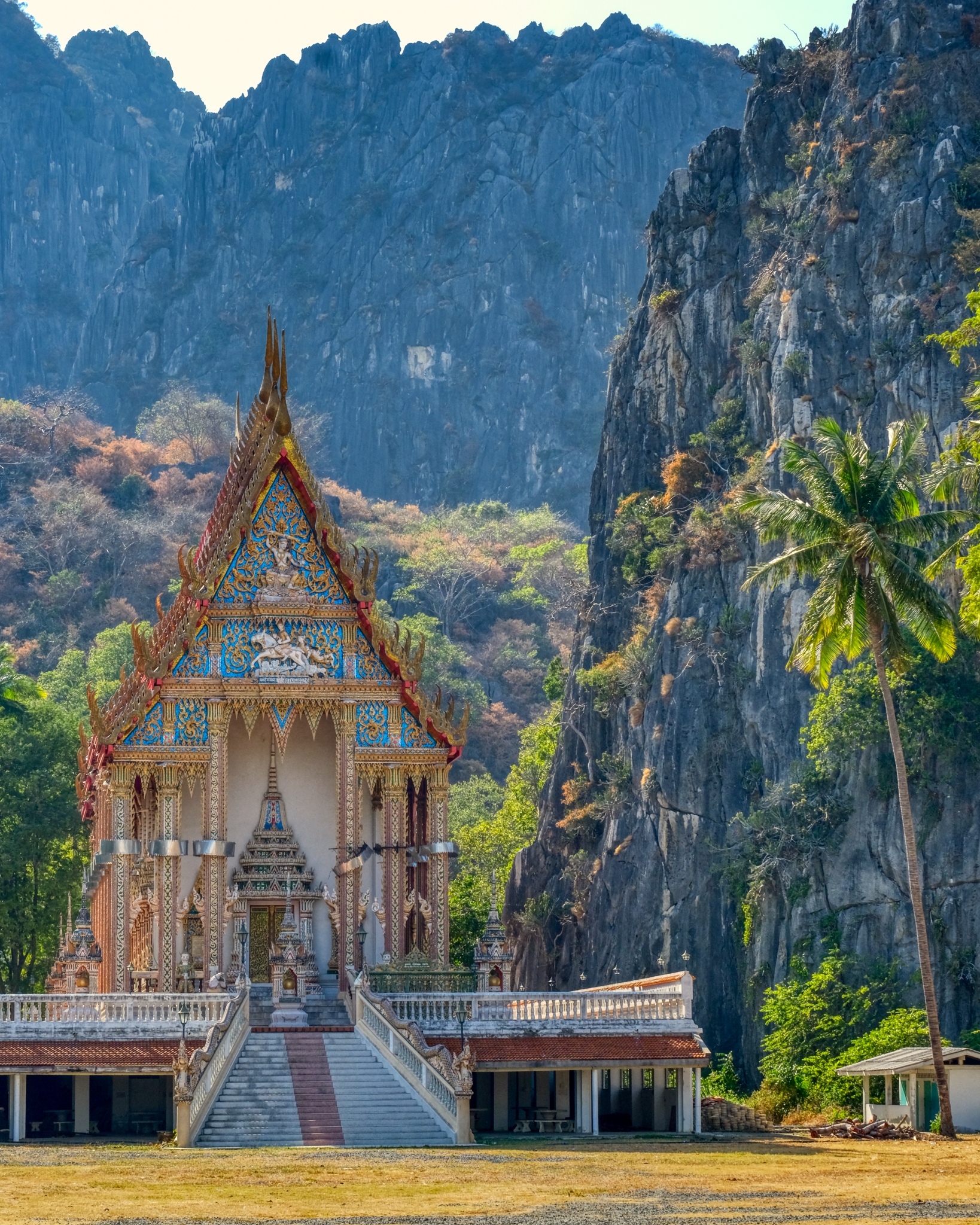 One last look at this fantastic cliff side wat.
One last look at this fantastic cliff side wat.
----------------------------------------------------------------
Wat Huai Sai Tai Temple
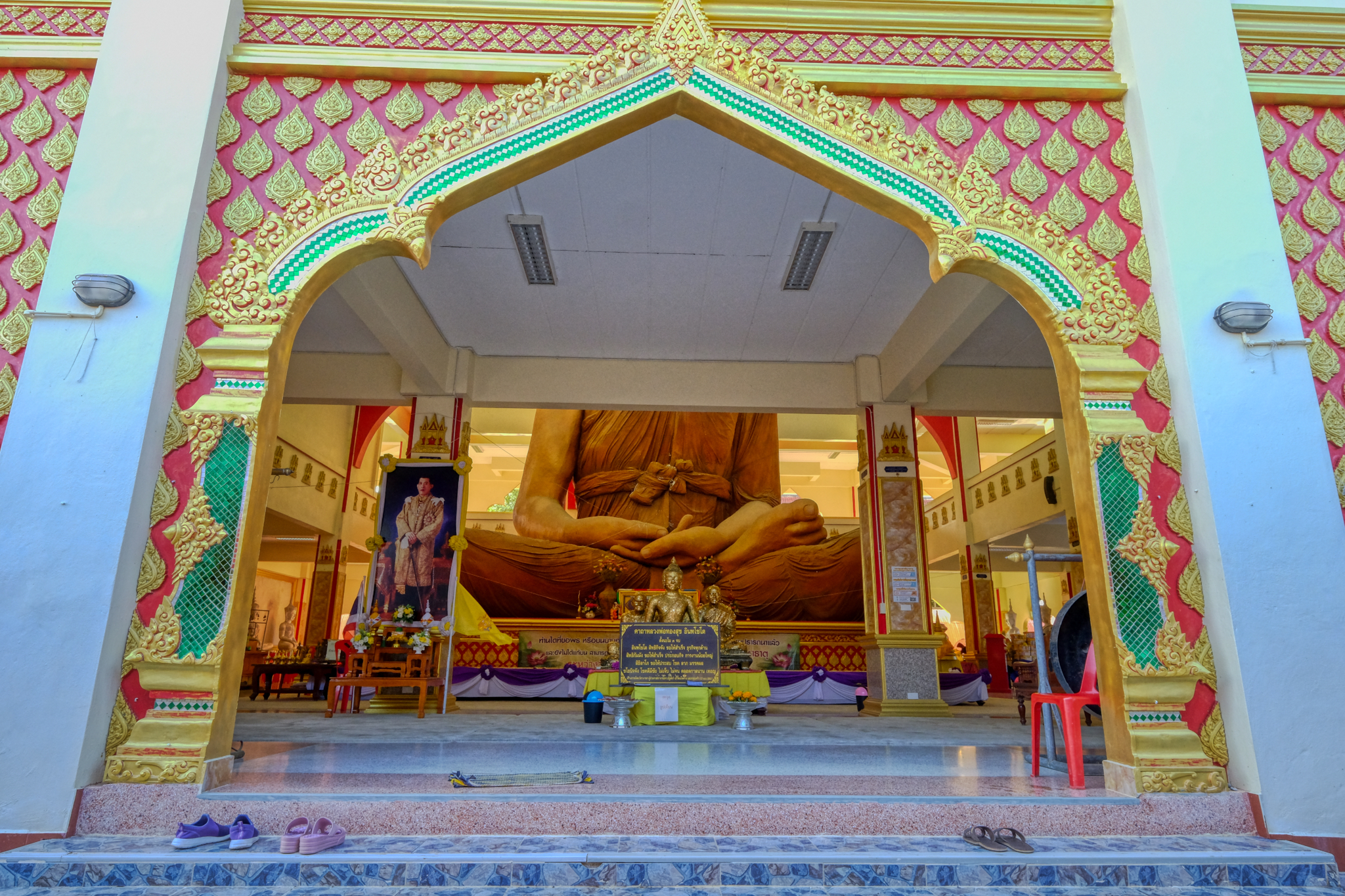 On the way back from our hilltop chedi, I wanted to stop and show my friend the Colossus of Hua Hin at Wat Hui Sai Tai!
On the way back from our hilltop chedi, I wanted to stop and show my friend the Colossus of Hua Hin at Wat Hui Sai Tai!
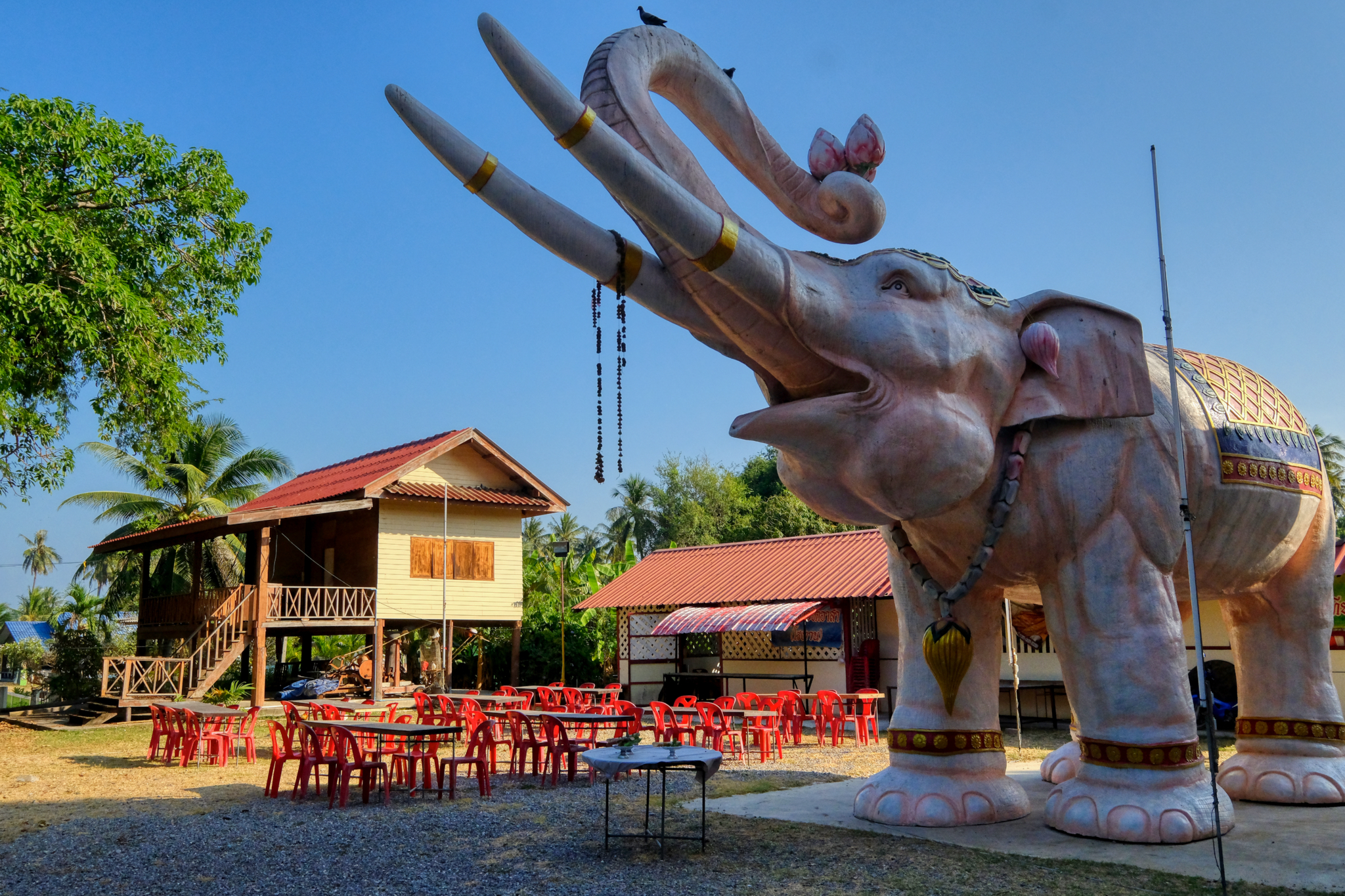 Such a lovely and strange place . . .
Such a lovely and strange place . . .
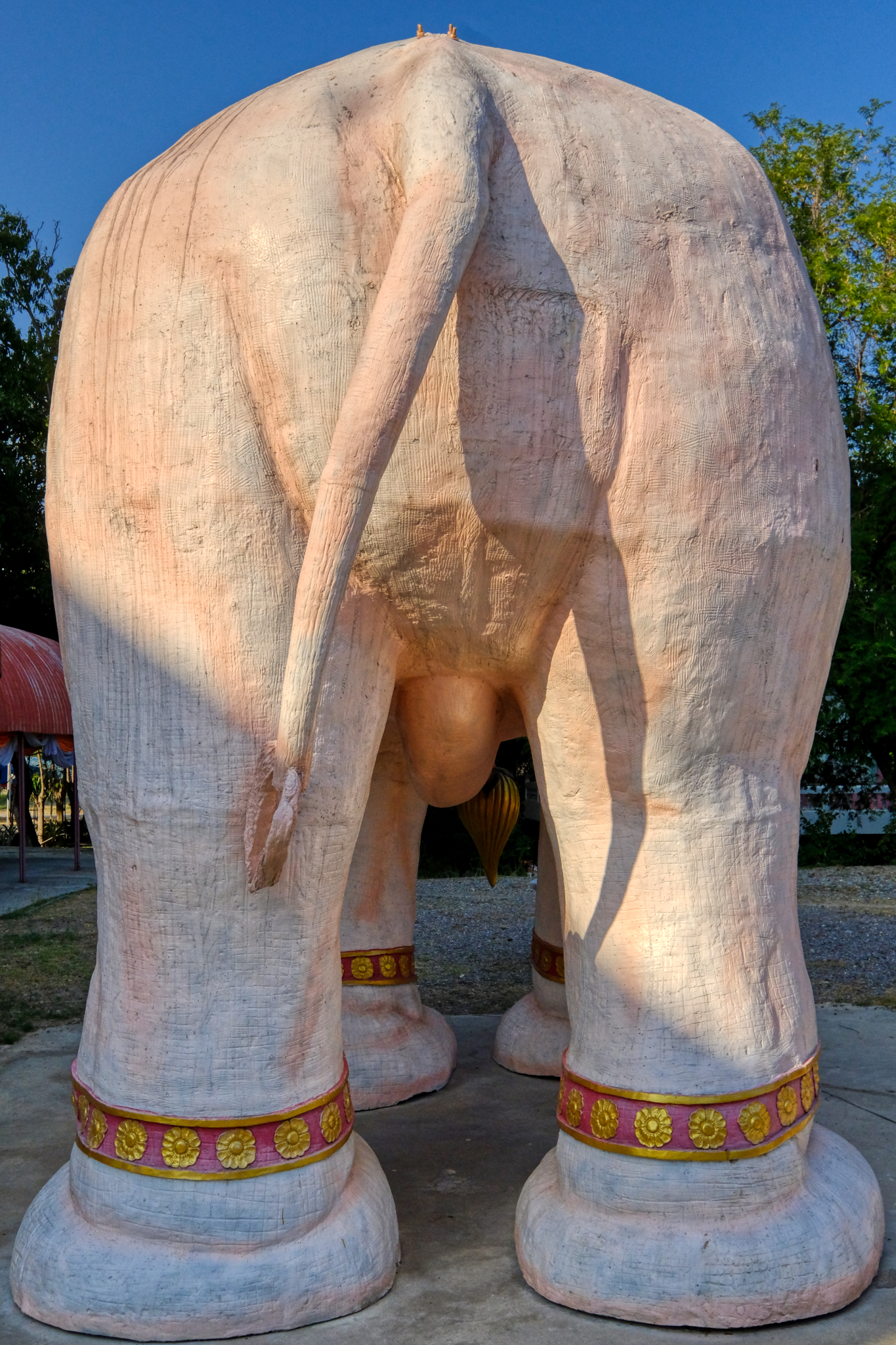 Yep . . . a cement elephant's butt.
Yep . . . a cement elephant's butt.
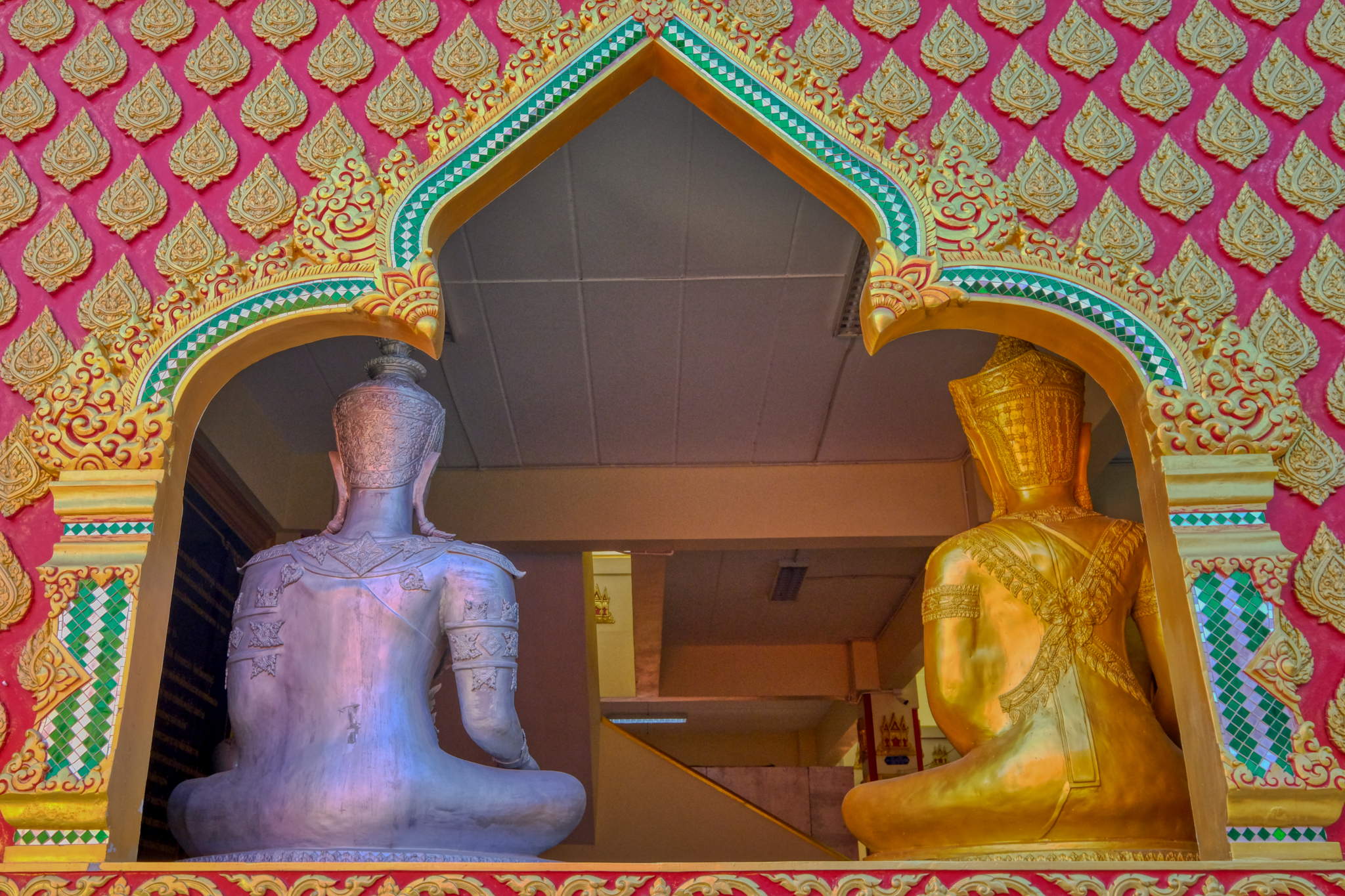 The spaces and surfaces around the outside of the temple were beautifully decorated.
The spaces and surfaces around the outside of the temple were beautifully decorated.
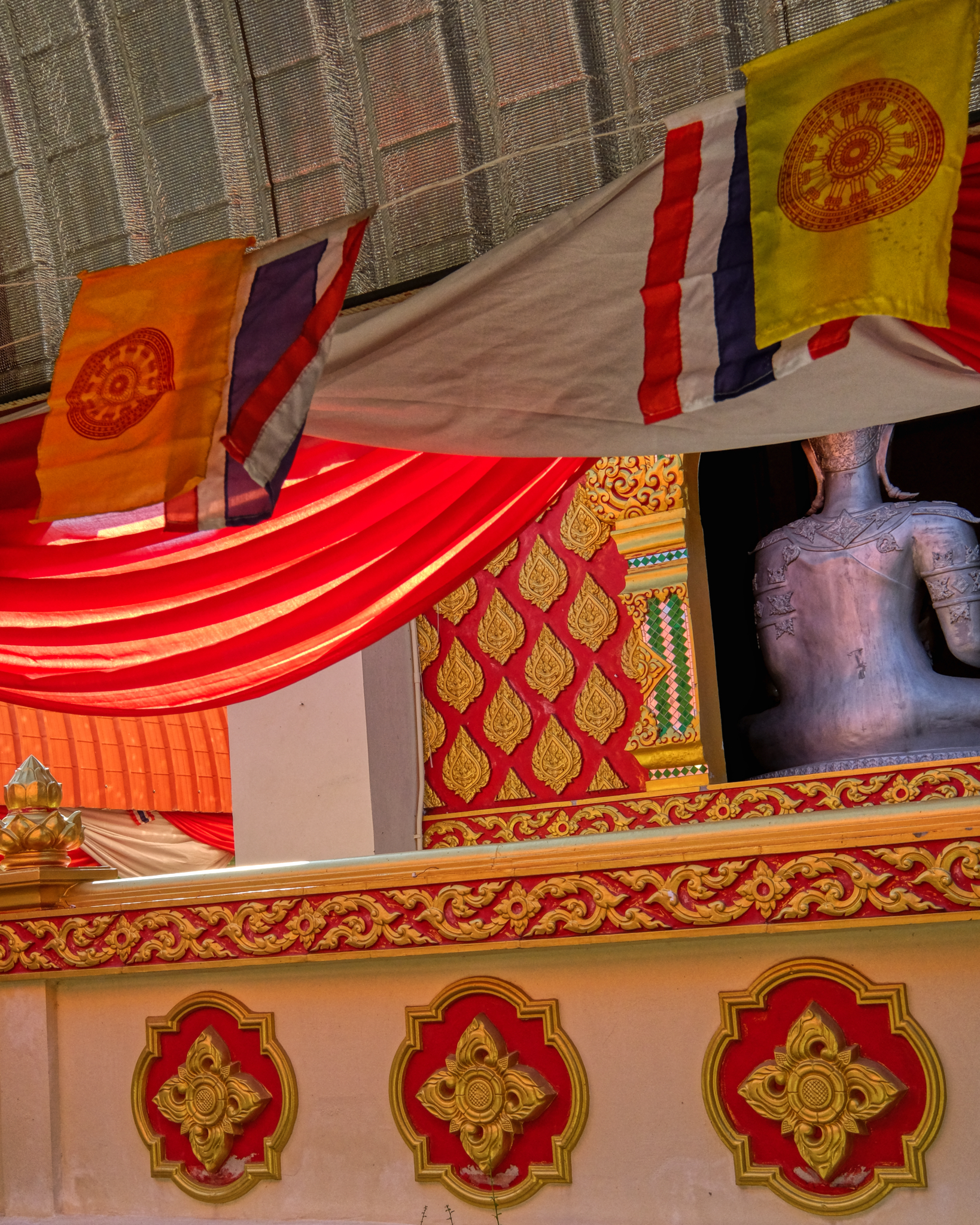 The exterior details were aesthetically very pleasing.
The exterior details were aesthetically very pleasing.
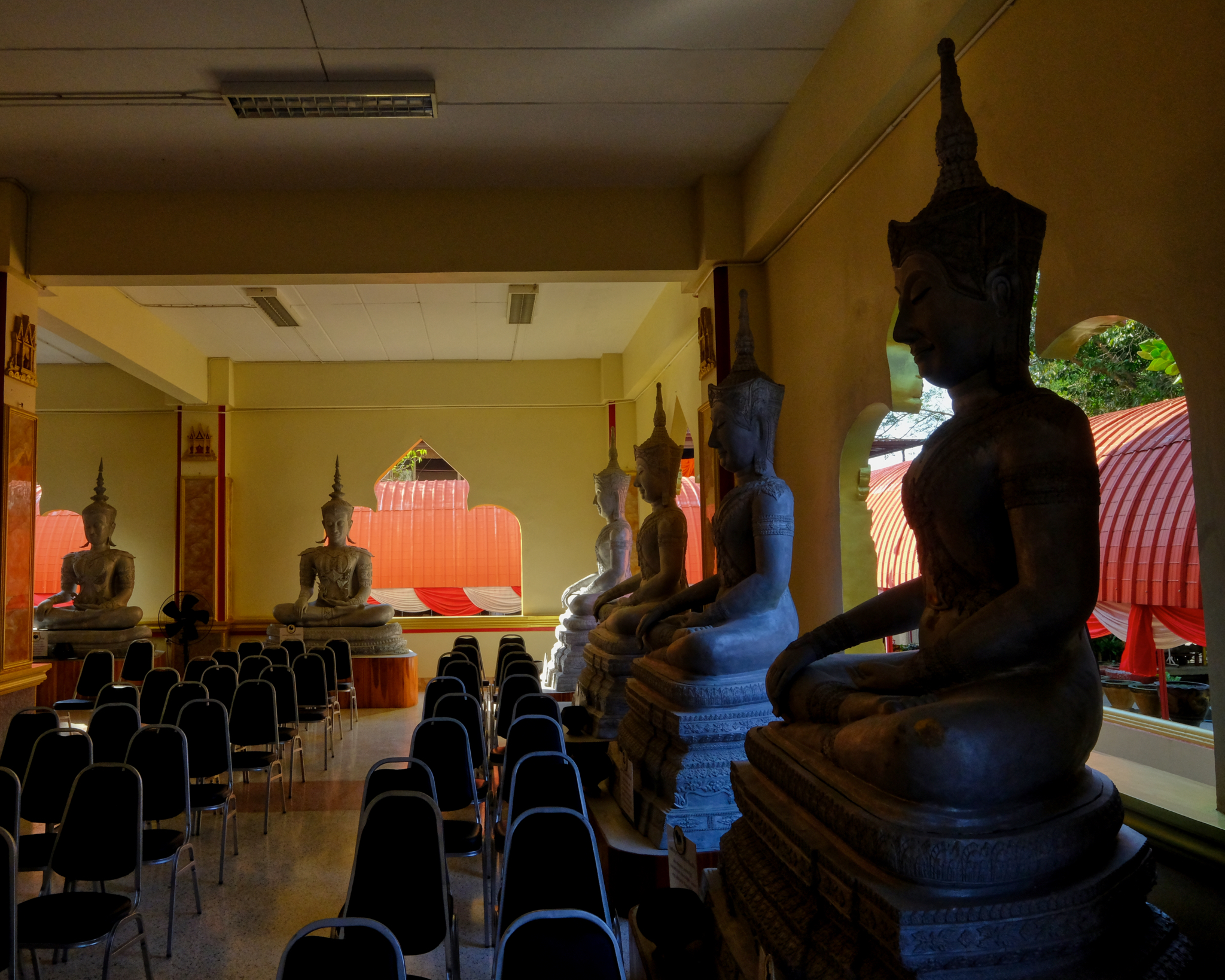 Of course, we had not come to just admire the exterior decor . . . it was what was inside that attracted us . . .
Of course, we had not come to just admire the exterior decor . . . it was what was inside that attracted us . . .
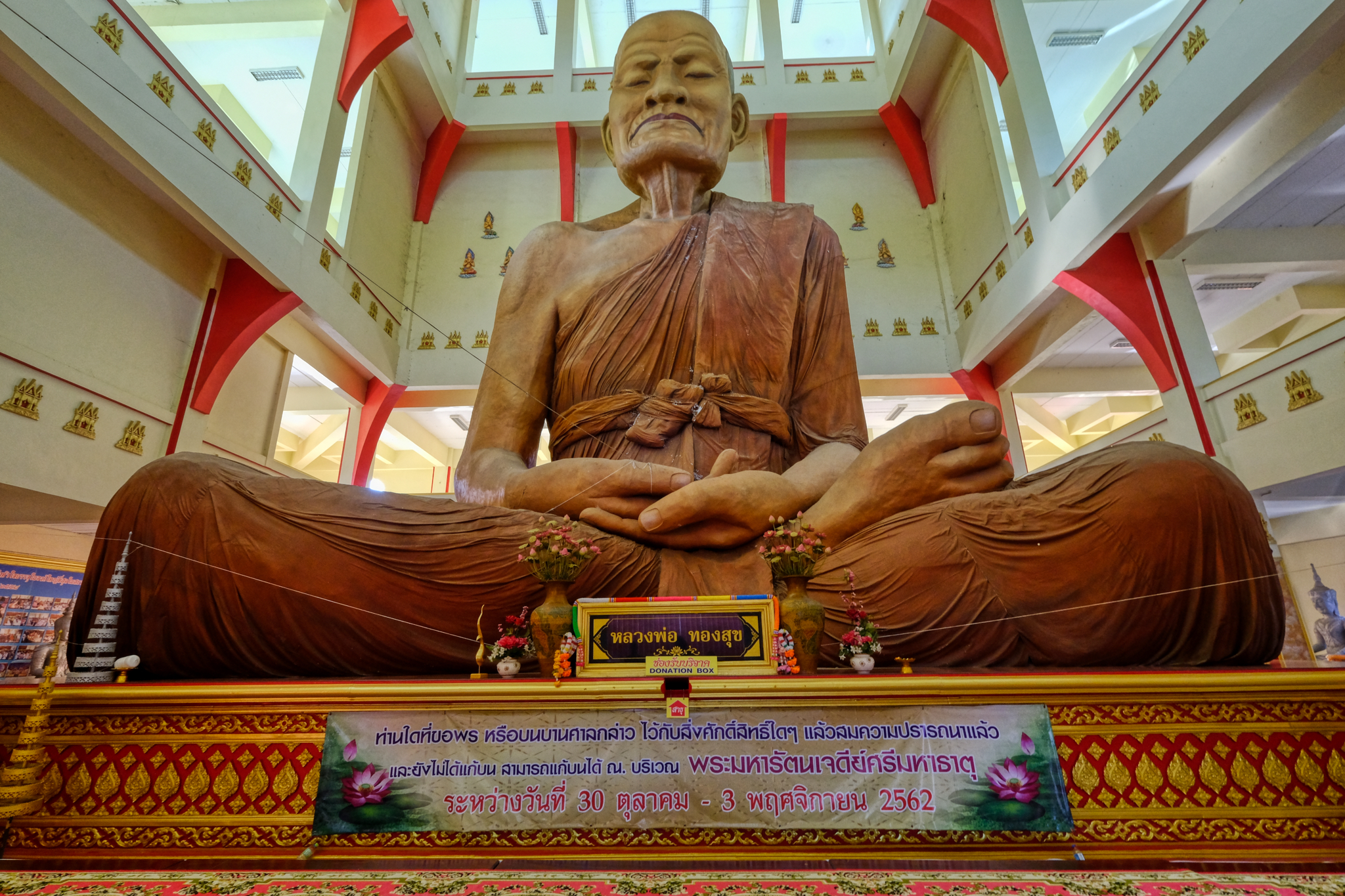 What attracted us was the colossal statue of the venerated monk, Luong Phor Thongsuk!
What attracted us was the colossal statue of the venerated monk, Luong Phor Thongsuk!
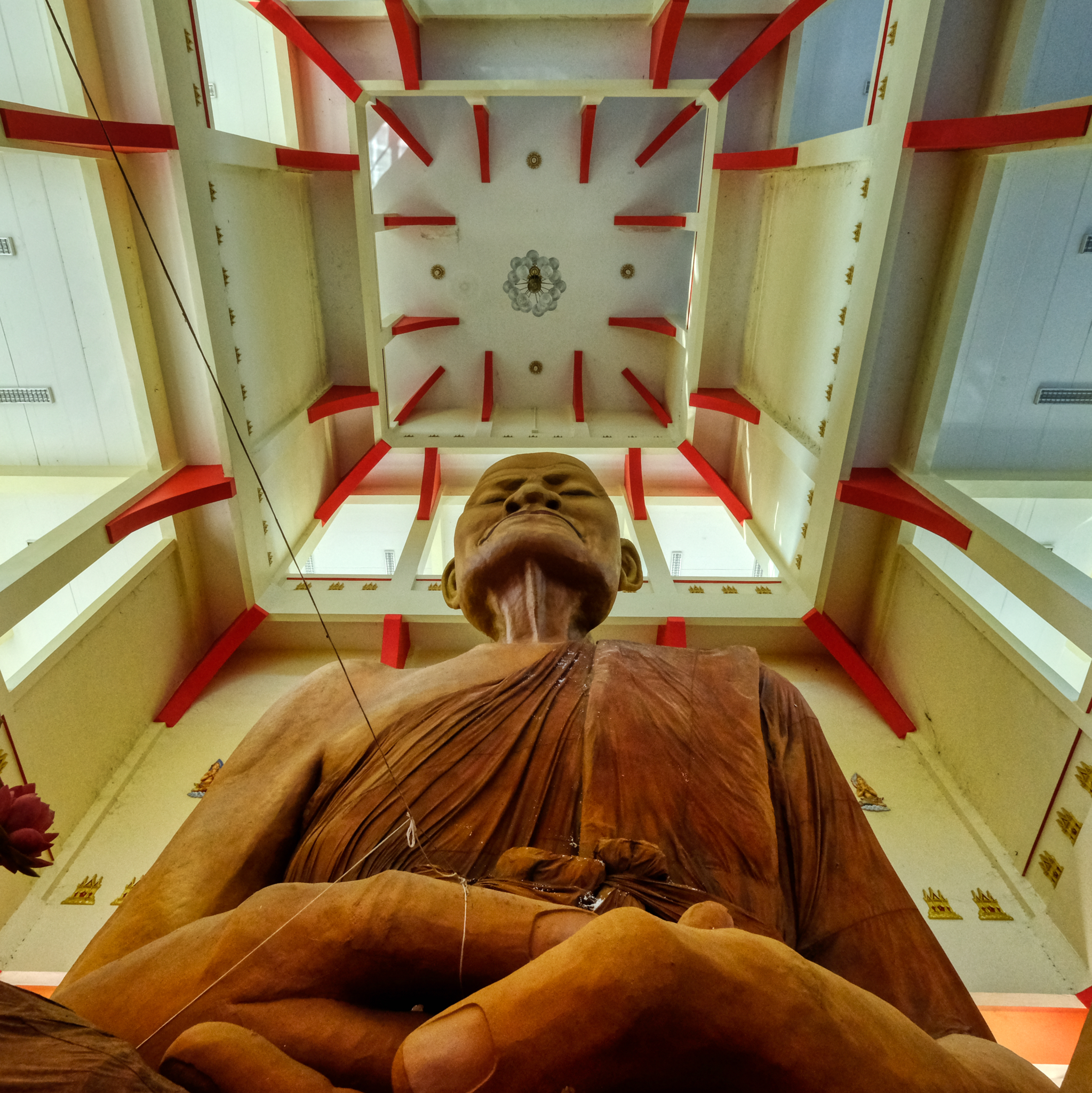 The giant Luang Phor Thongsuk in all his revered glory.
The giant Luang Phor Thongsuk in all his revered glory.
 The scale of this statue is incredible!
The scale of this statue is incredible!
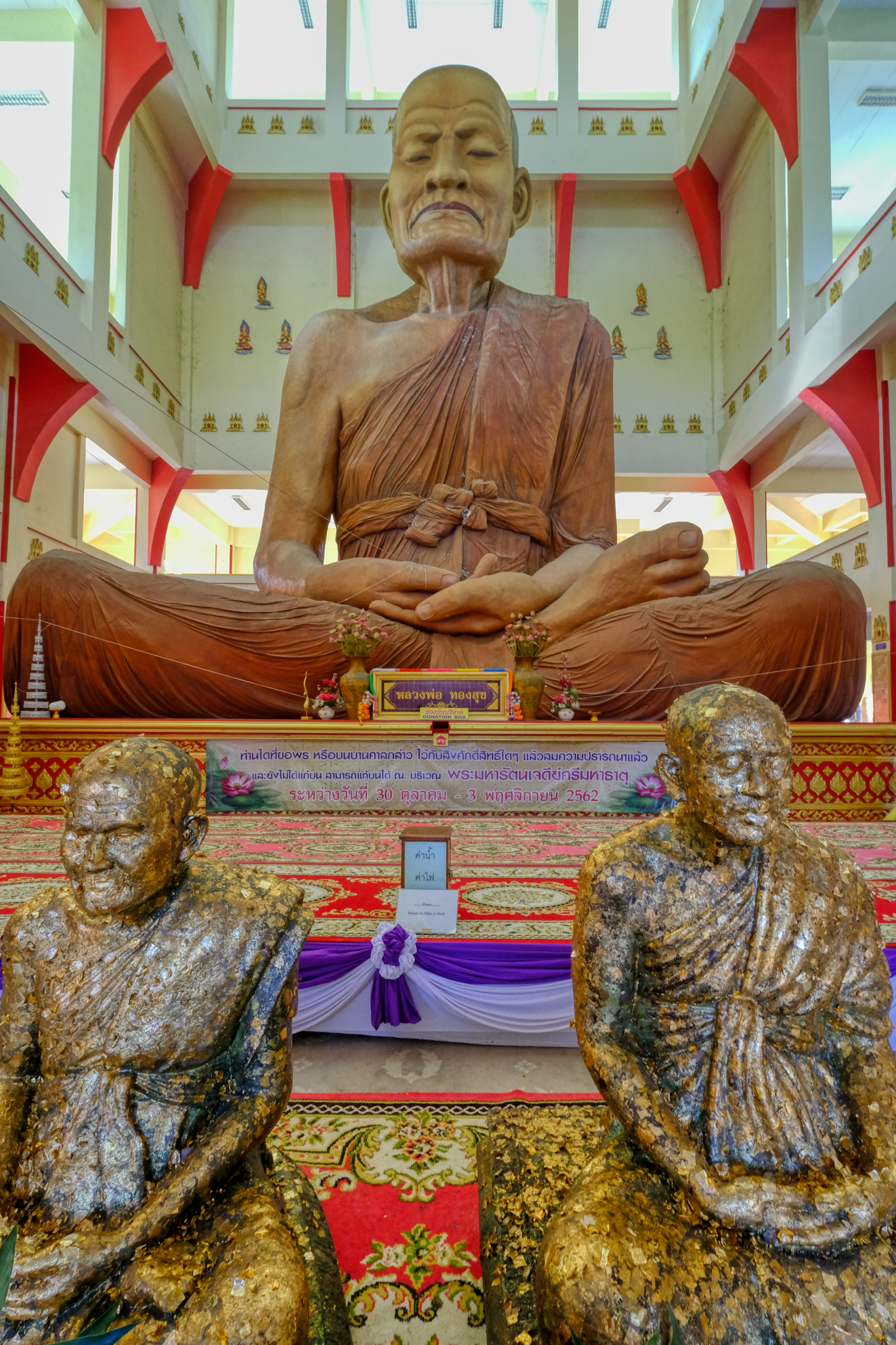 During our short visit here, many people came to pay their respects.
During our short visit here, many people came to pay their respects.
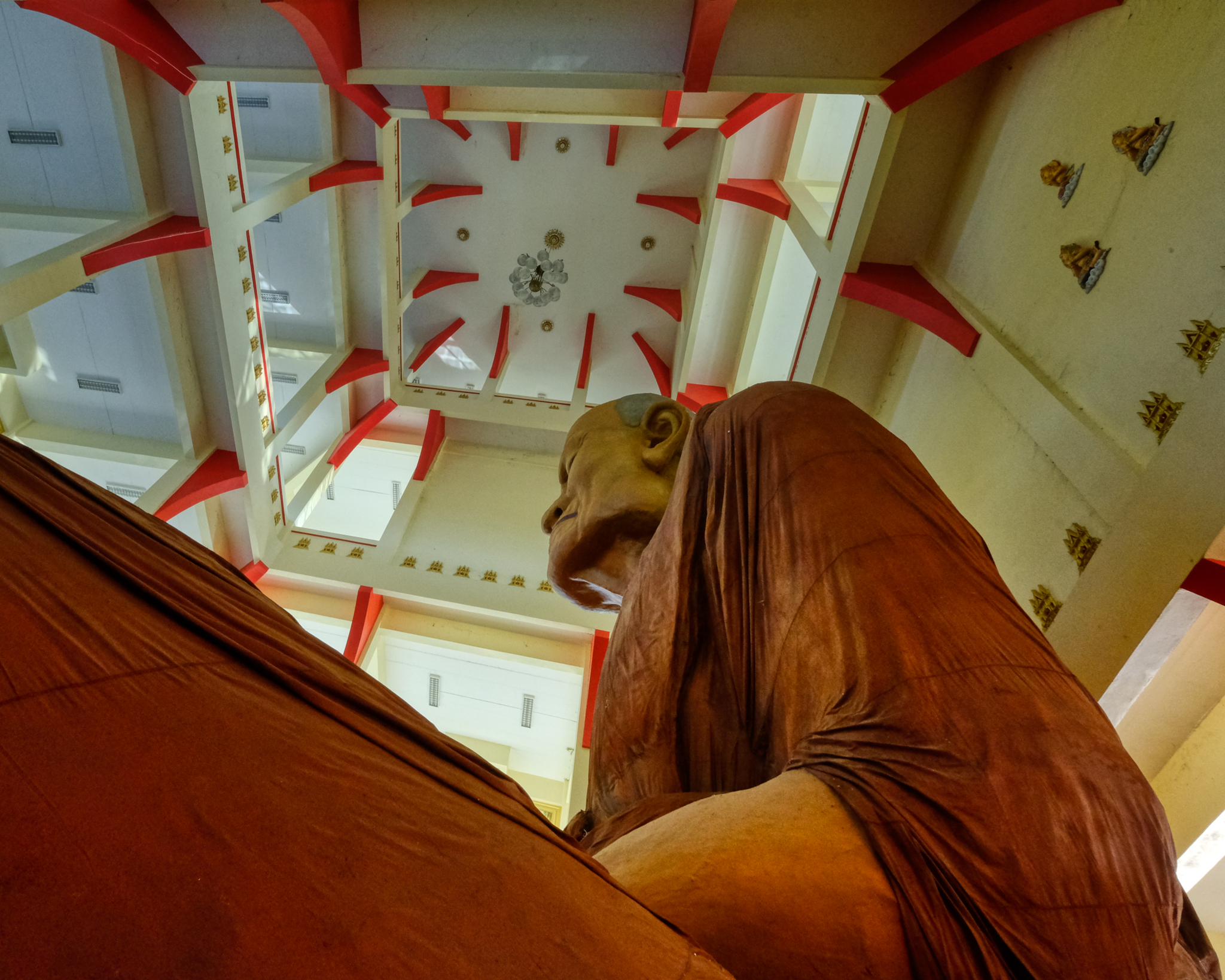 Our last look at the colossus!
Our last look at the colossus!
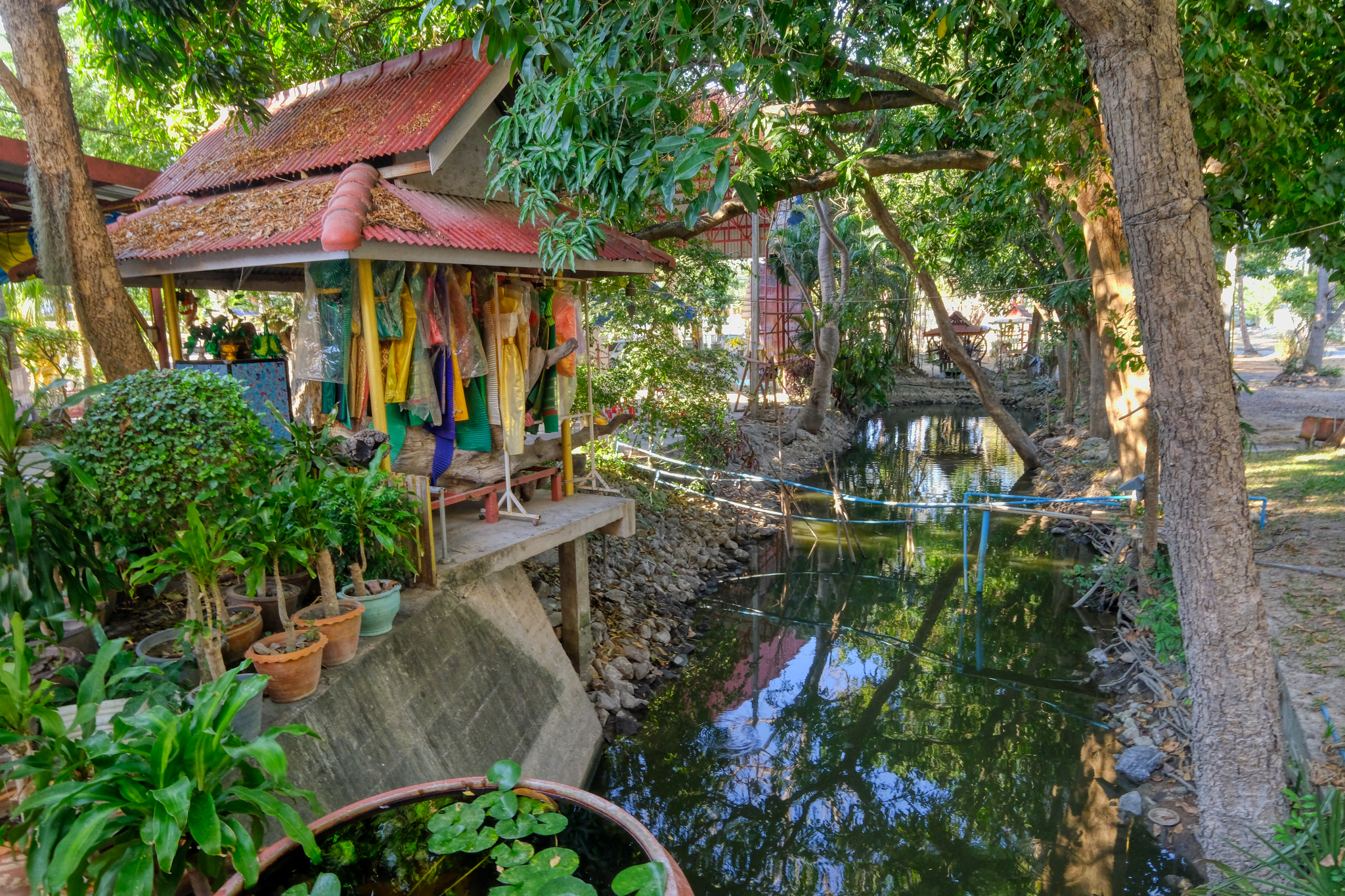 A marvelous spirit house on the grounds of Wat Hui Sai Tai.
A marvelous spirit house on the grounds of Wat Hui Sai Tai.
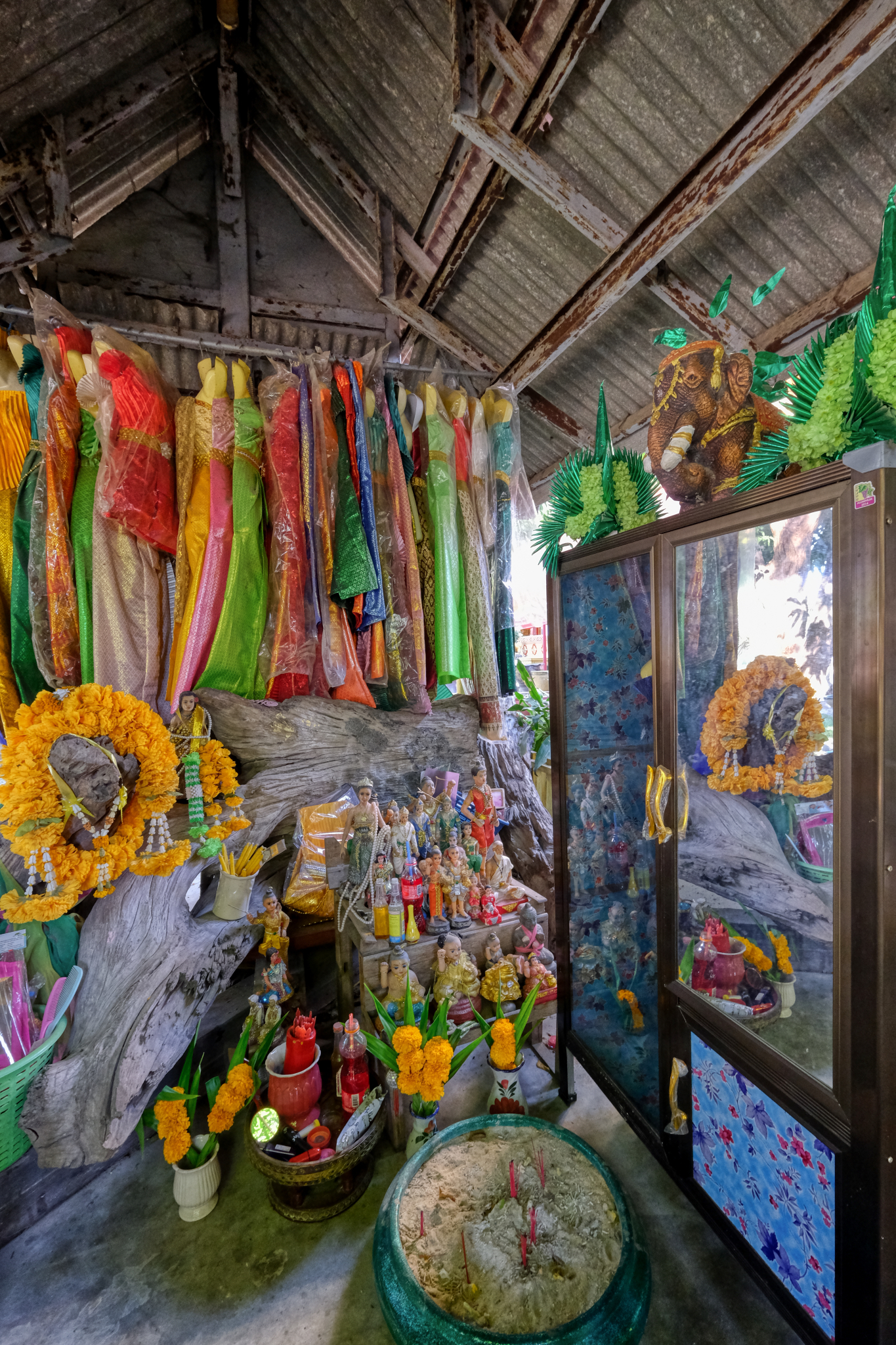 The inside of the wat spirit house . . . very well tended by the pilgrims.
The inside of the wat spirit house . . . very well tended by the pilgrims.
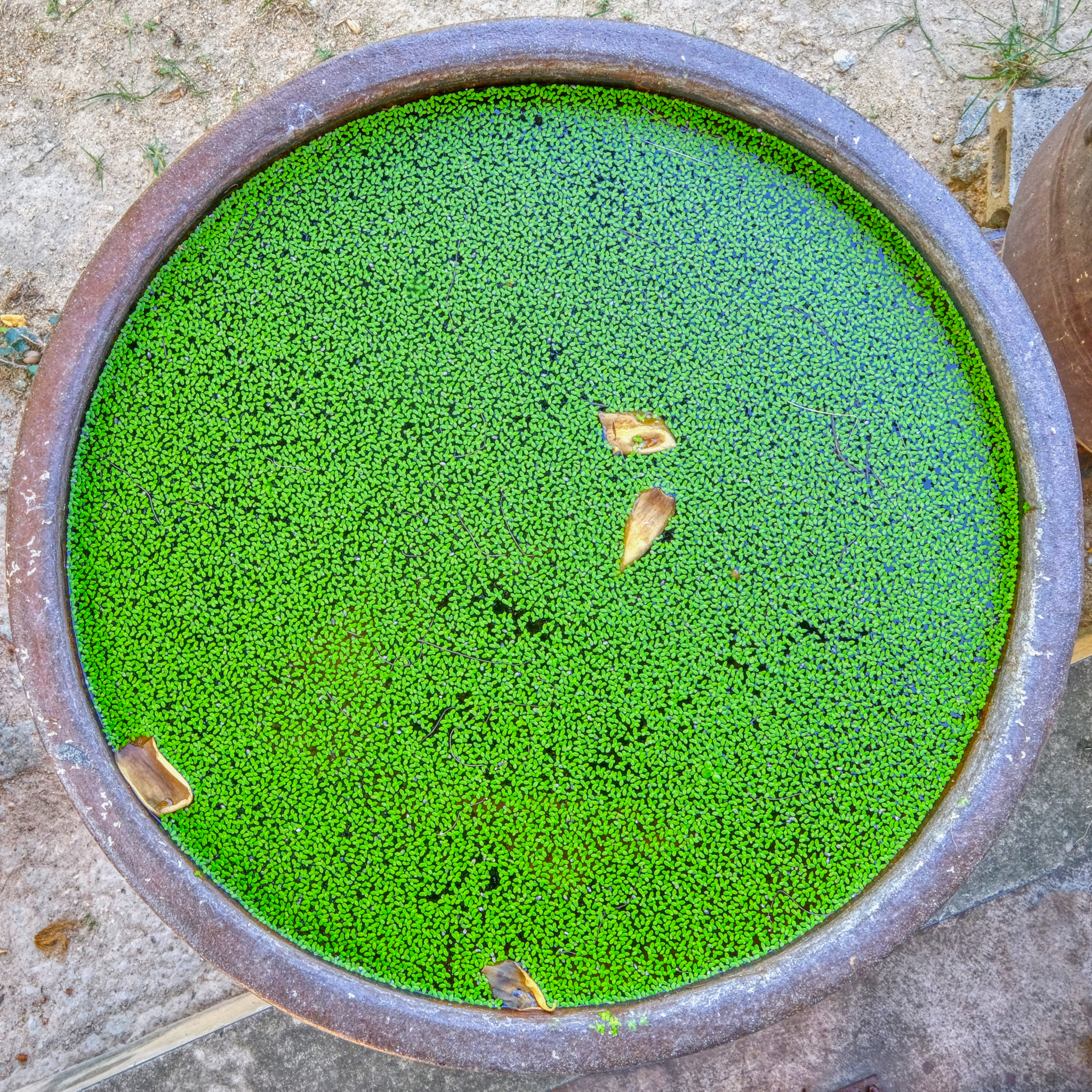 Beauty everywhere we pointed our cameras . . .
Beauty everywhere we pointed our cameras . . .
-----------------------------------------------------
An Old Fishing Village
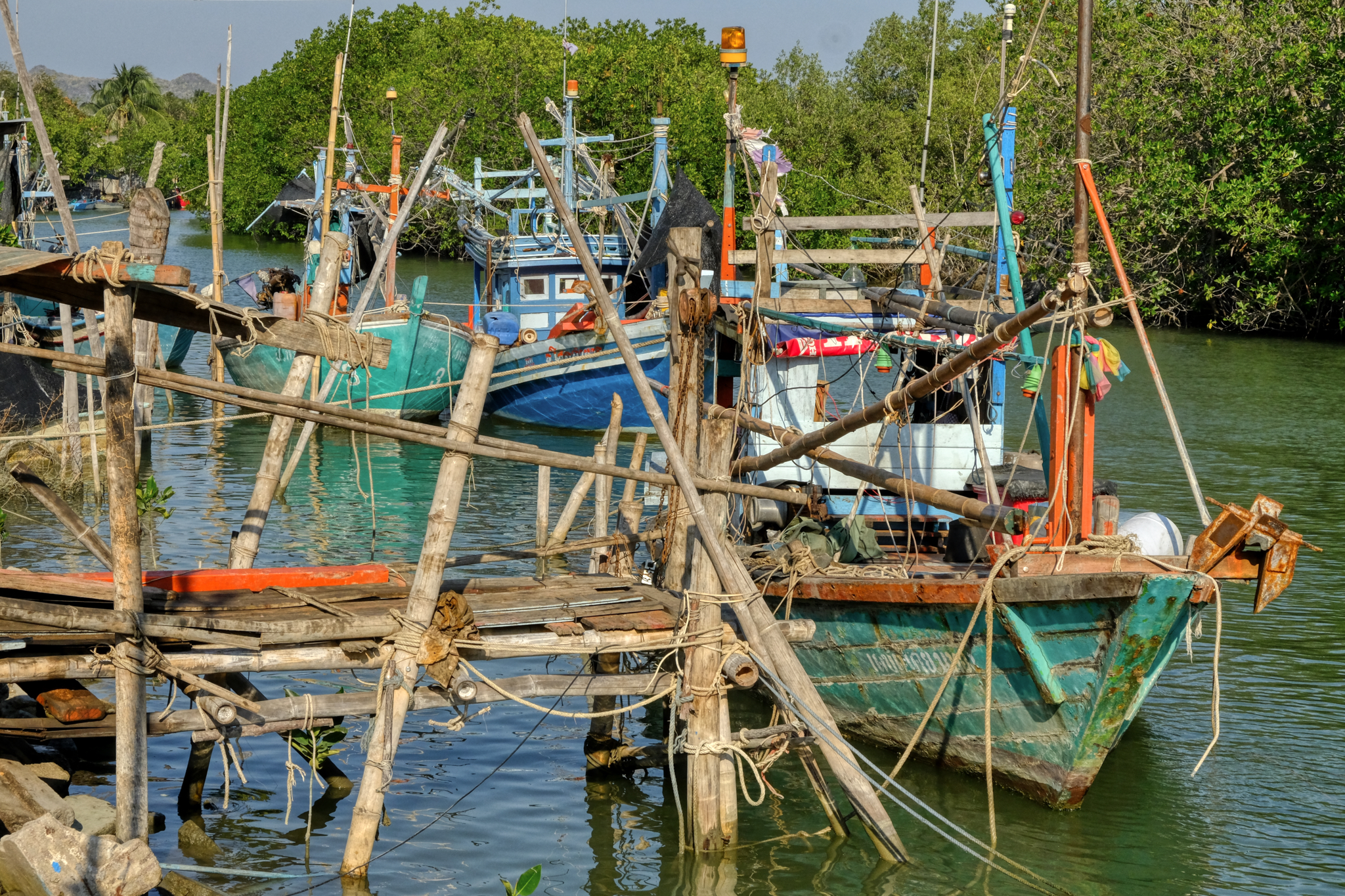 We headed up the road to our next destination, a beach about 20km away . . . but a quick glance on the GPS map showed a small village on an inlet . . . maybe a fishing village? YES!
We headed up the road to our next destination, a beach about 20km away . . . but a quick glance on the GPS map showed a small village on an inlet . . . maybe a fishing village? YES!
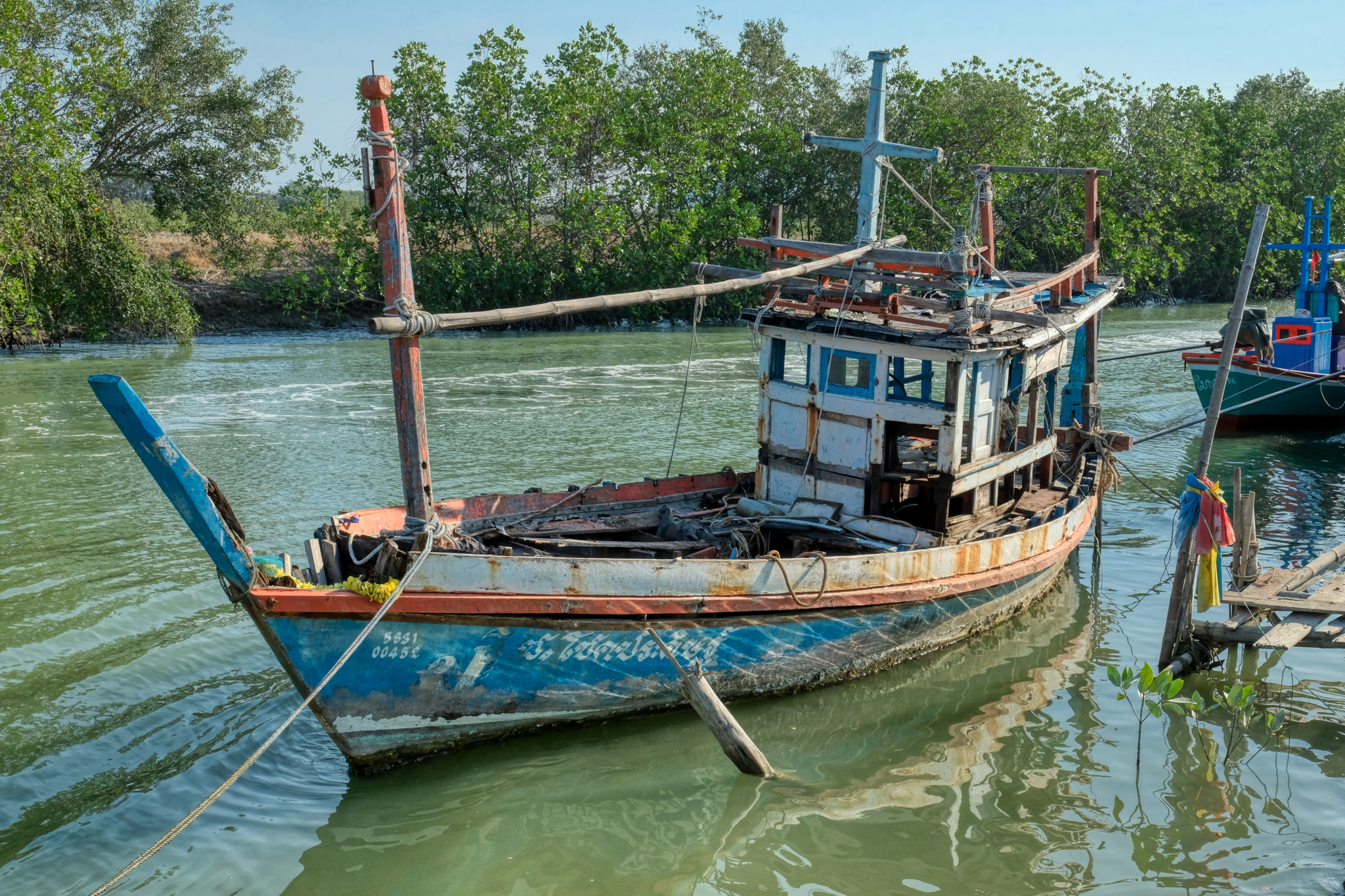 It was a very old fishing village . . . with a few very photogenic derelict old boats still dockside.
It was a very old fishing village . . . with a few very photogenic derelict old boats still dockside.
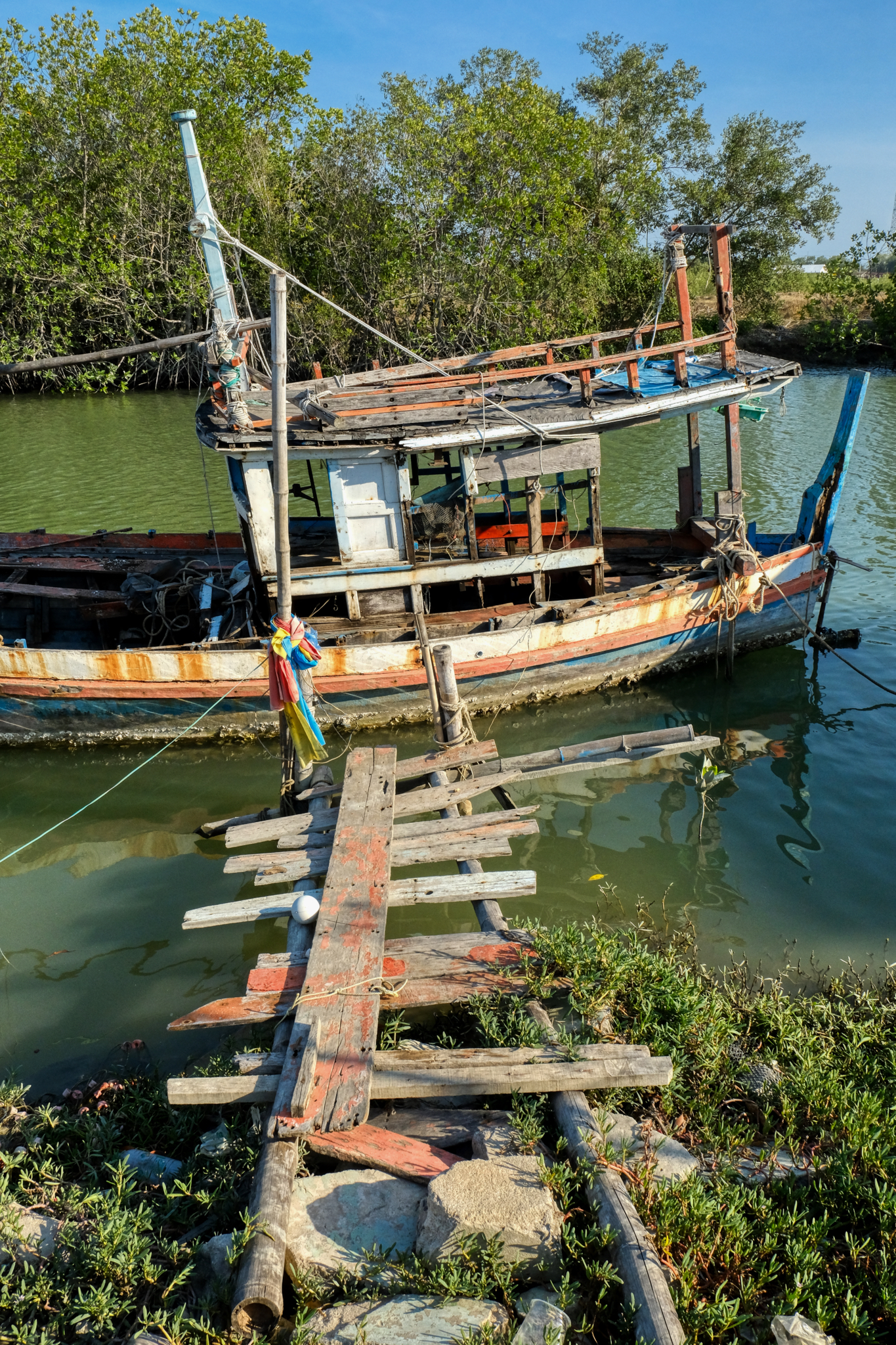 Did I say "old boat and old pier"? I meant to say "dilapidated pier and ghost ship"!
Did I say "old boat and old pier"? I meant to say "dilapidated pier and ghost ship"!
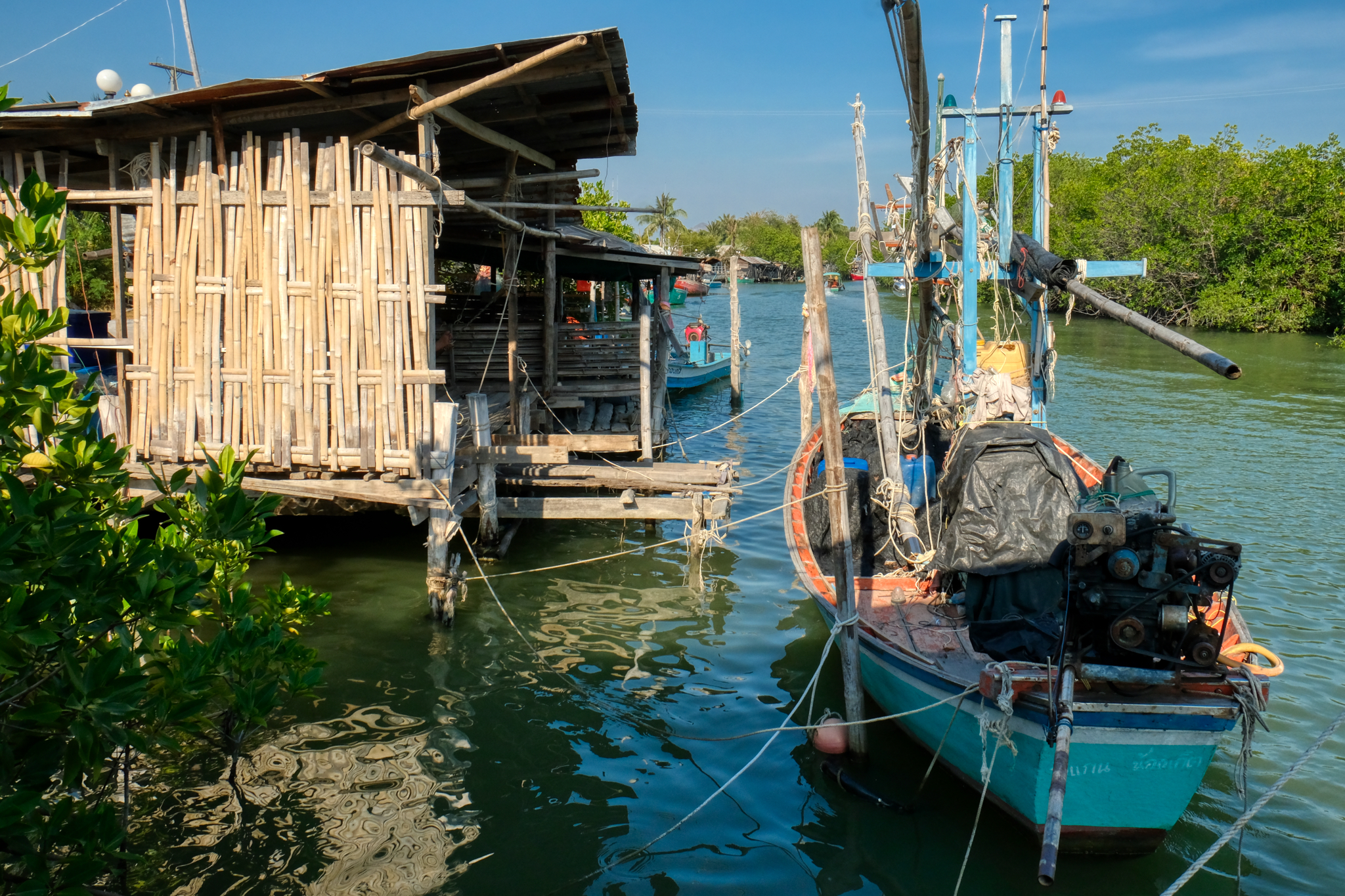 There were newer and older parts of this fishing village.
There were newer and older parts of this fishing village.
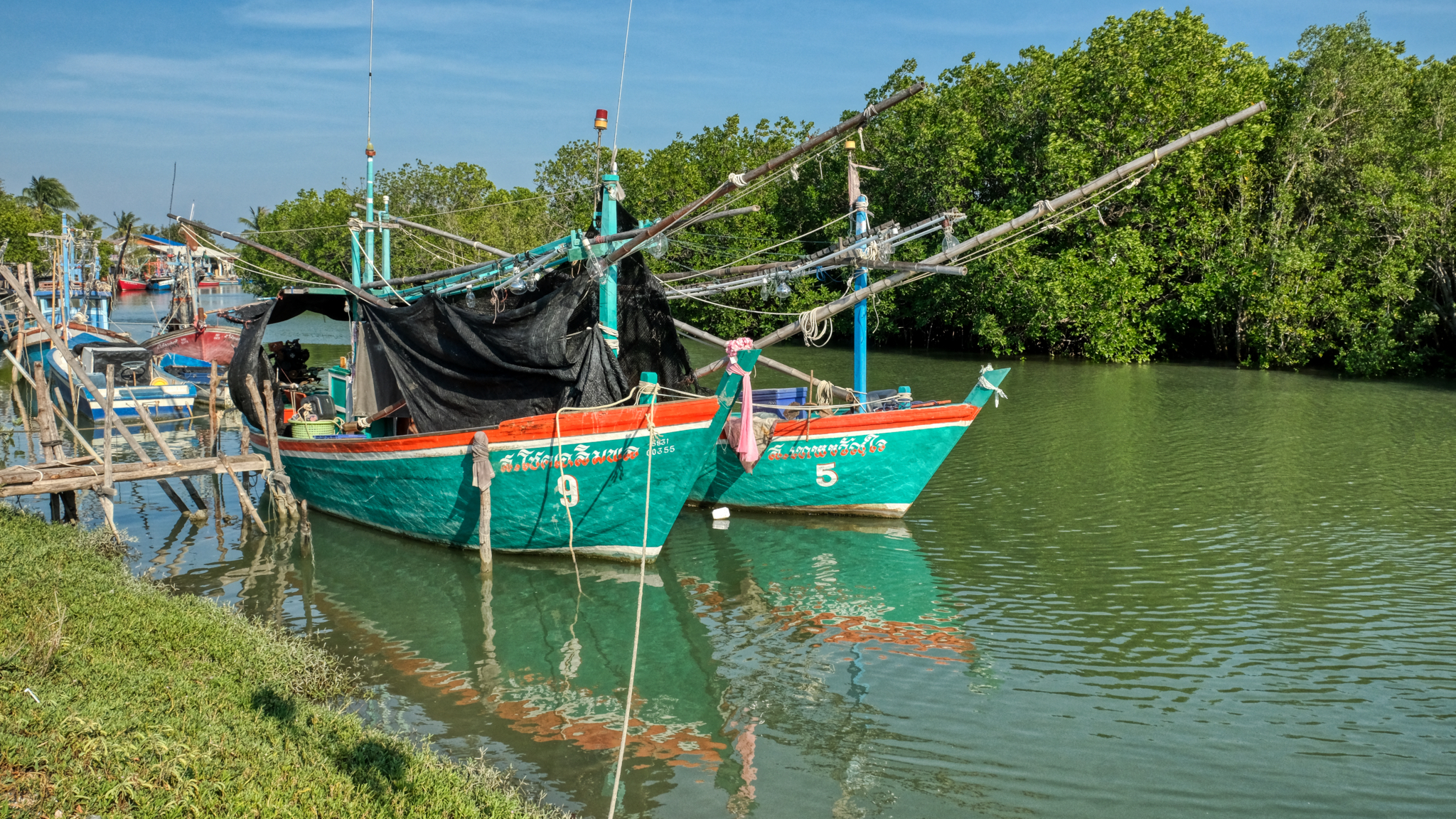 The village was very quiet this afternoon. These boats are rigged to catch squid . . . at night.
The village was very quiet this afternoon. These boats are rigged to catch squid . . . at night.
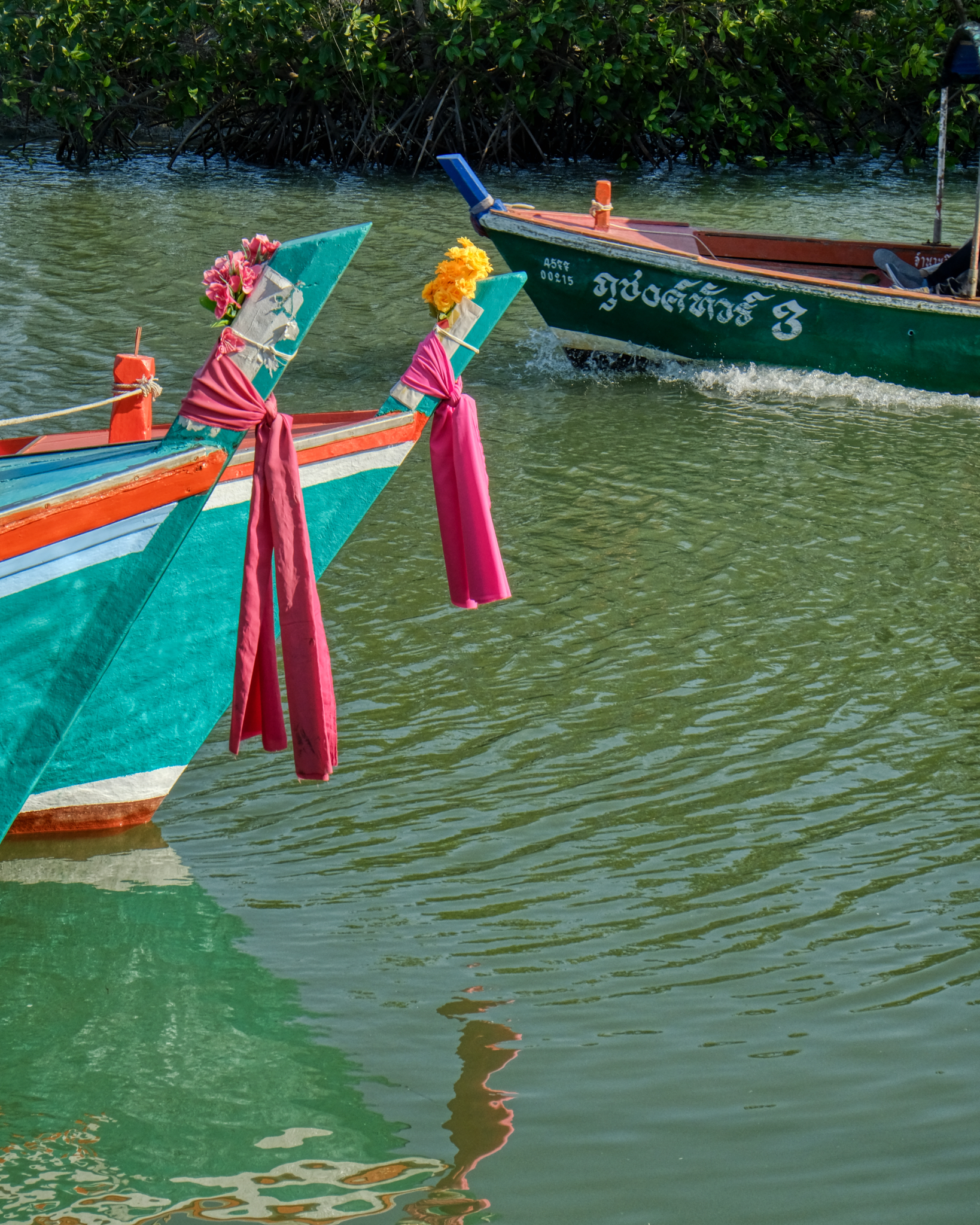 I love how the Thai fishermen decorate their boats . . . with these colorful votive blessings.
I love how the Thai fishermen decorate their boats . . . with these colorful votive blessings.
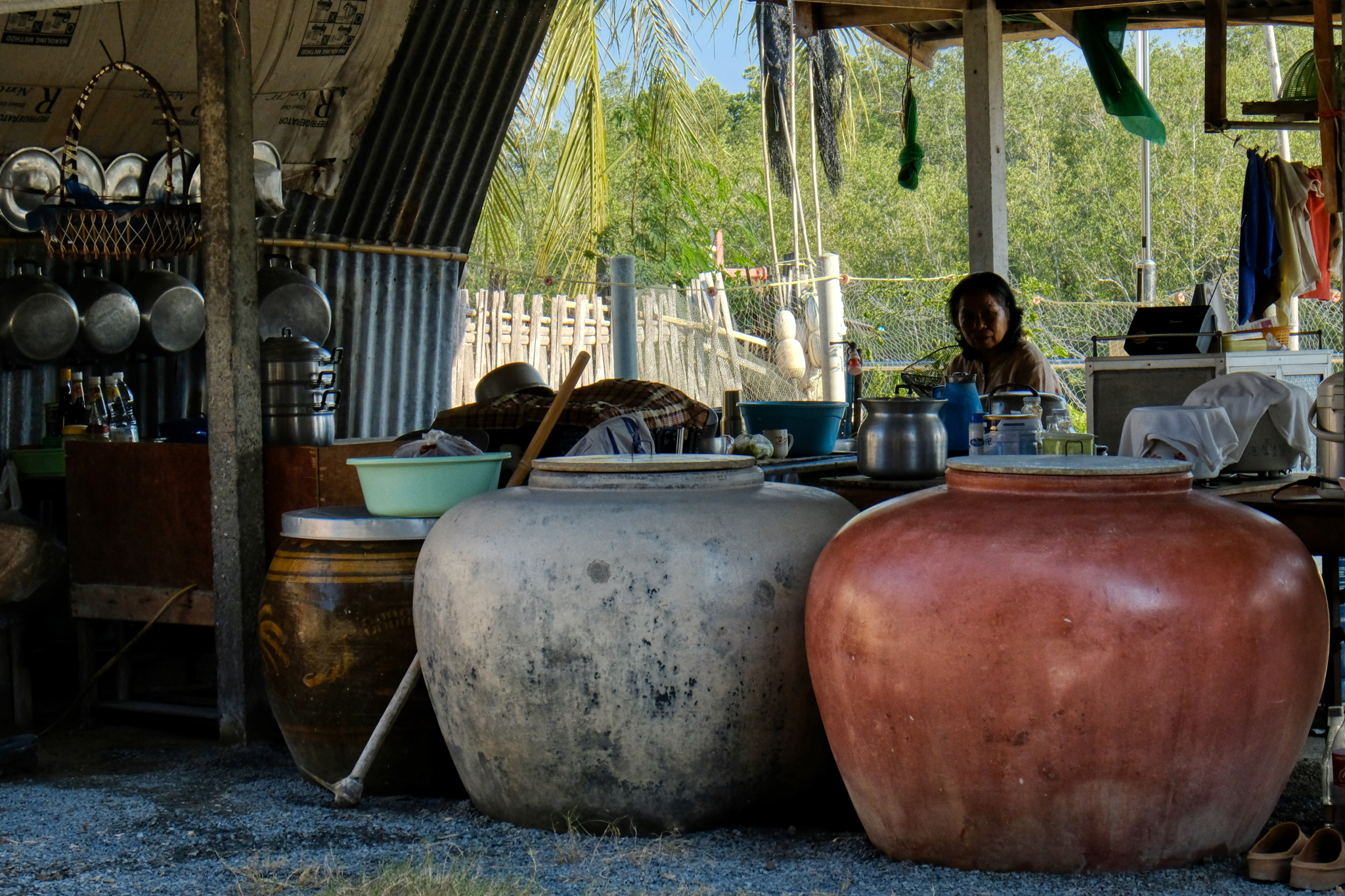 A village restaurateur. The large pots catch and hold rainwater.
A village restaurateur. The large pots catch and hold rainwater.
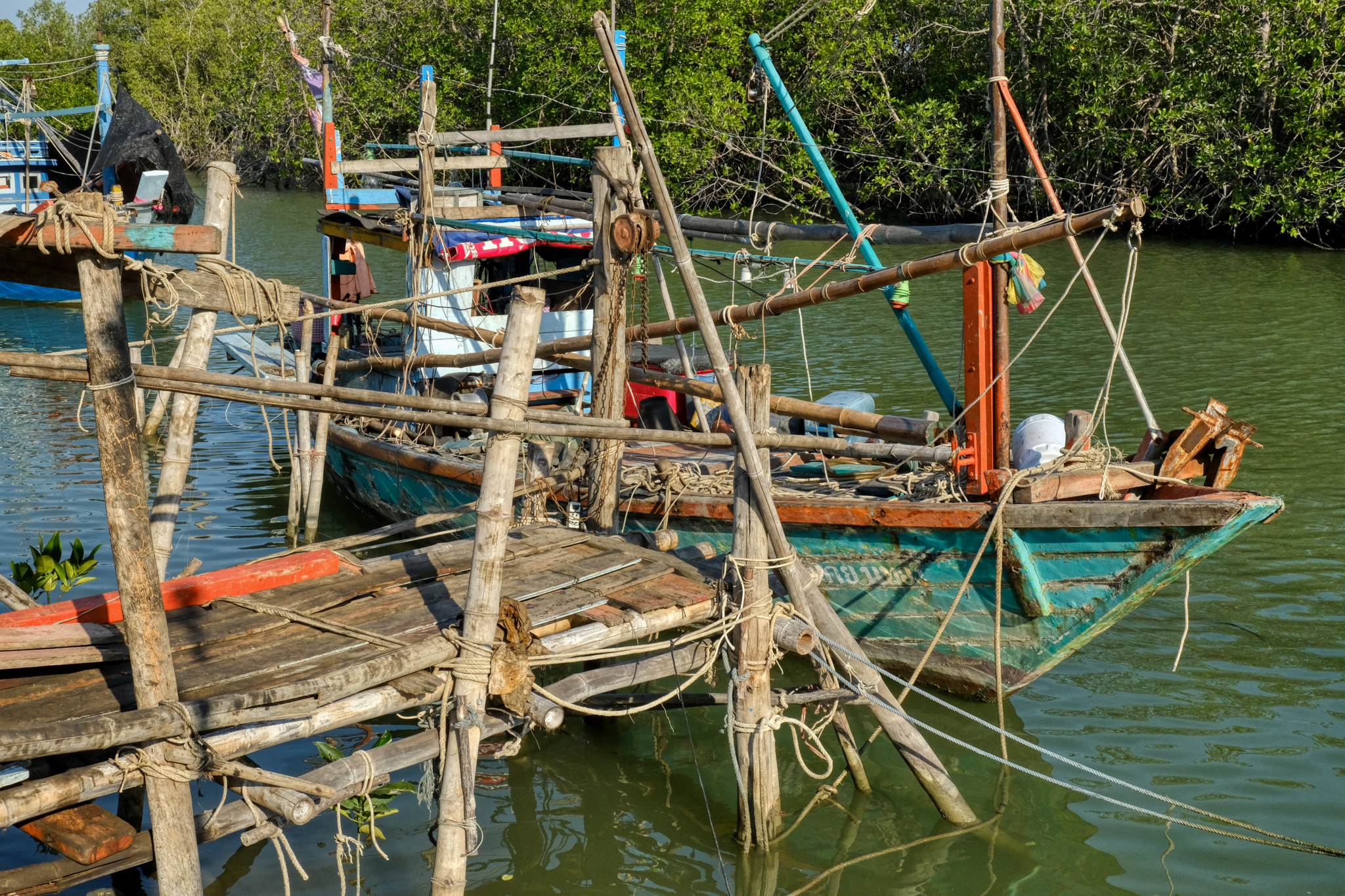 Such rich and complex images to capture here!
Such rich and complex images to capture here!
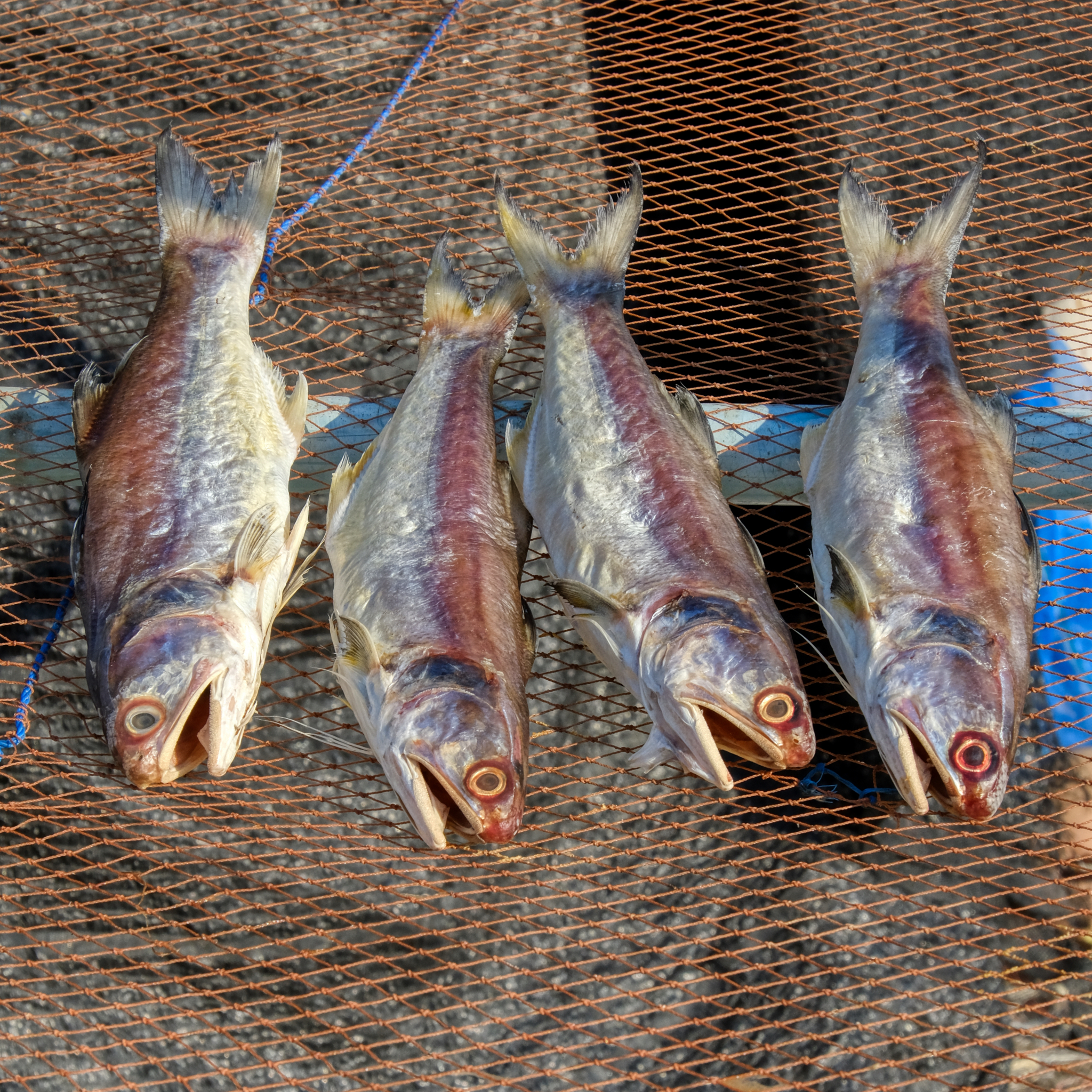 We saw this catch of the day in one of the fishermen's sheds.
We saw this catch of the day in one of the fishermen's sheds.
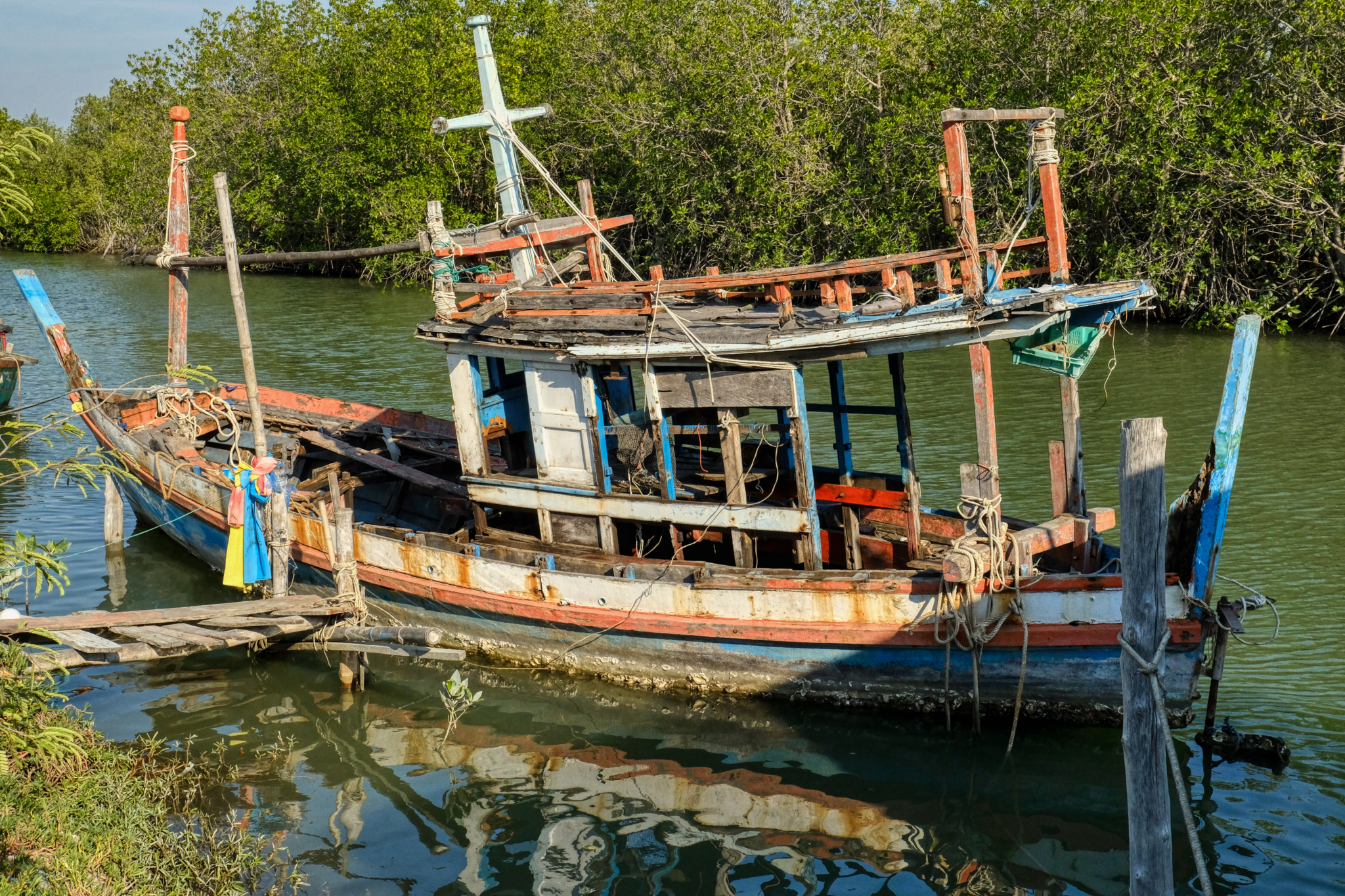 We could have stayed all day here . . . just taking photos . . . but there were other adventures in store for us on that day.
We could have stayed all day here . . . just taking photos . . . but there were other adventures in store for us on that day.
-------------------------------------------------
A Mangrove Forest Swamp Park
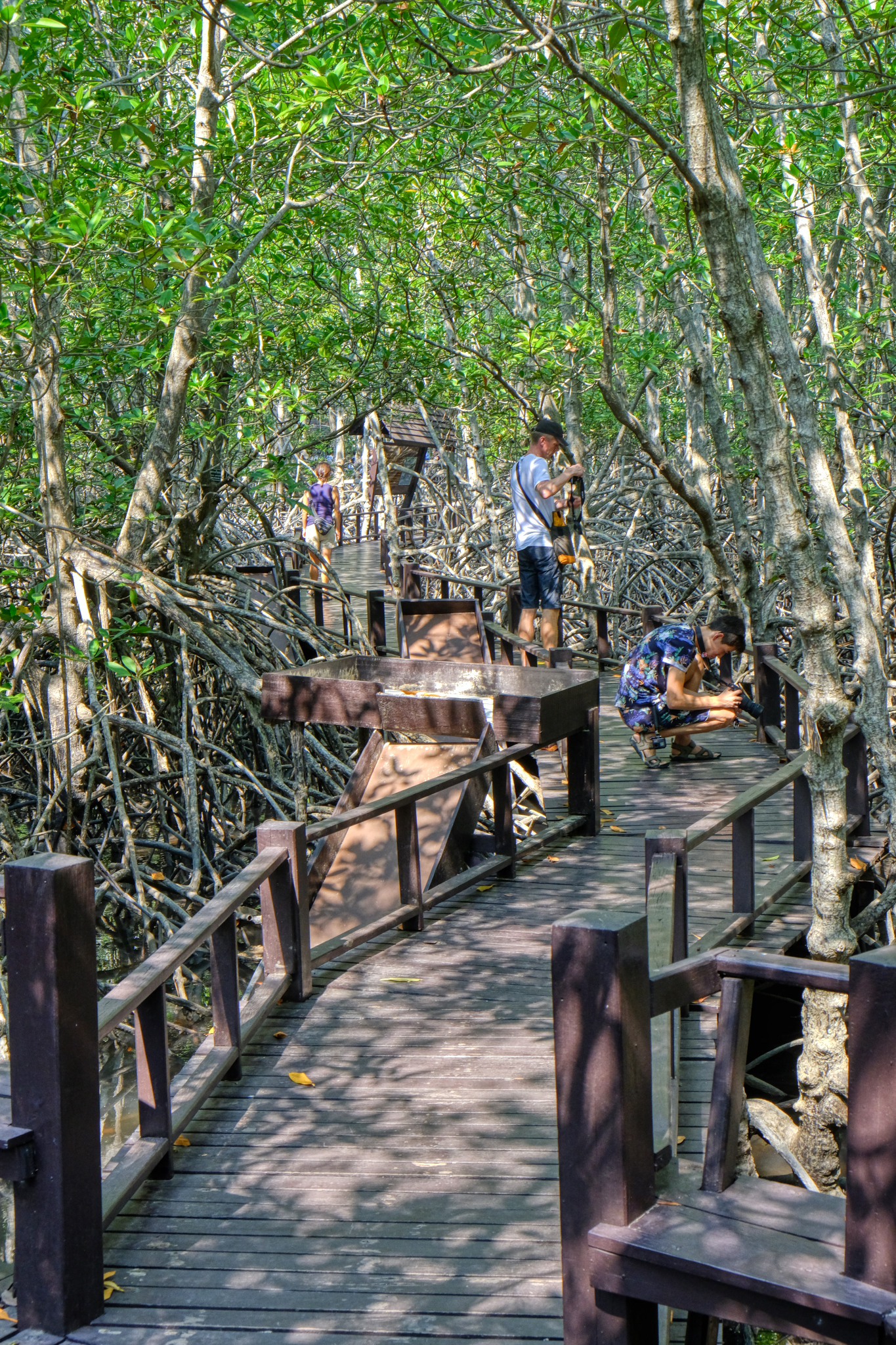 Our next stop was the beautifully developed, and very educational, Pran Buri Forest Park and Nature Reserve.
Our next stop was the beautifully developed, and very educational, Pran Buri Forest Park and Nature Reserve.
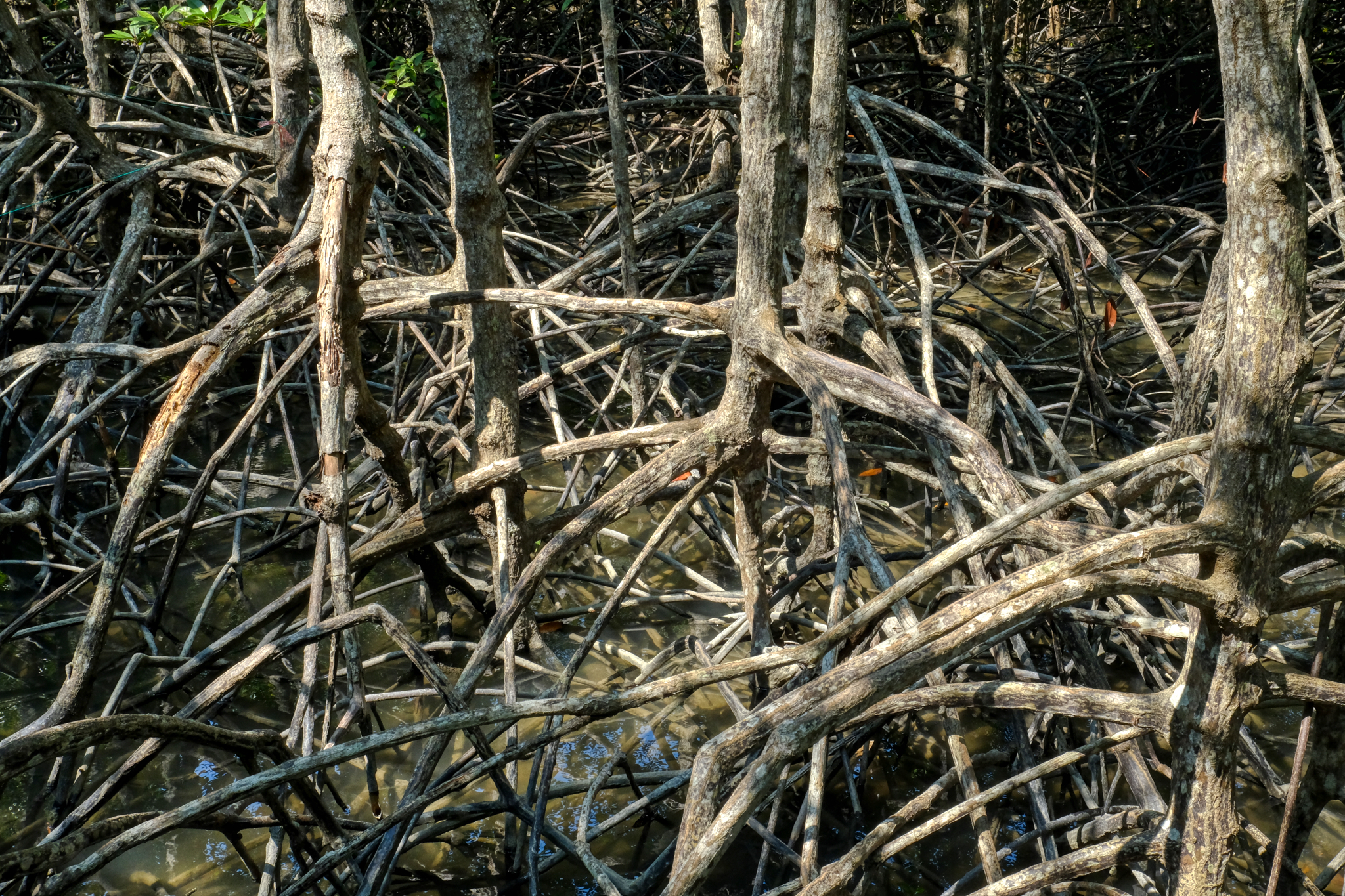 Mangrove forests are completely unique ecological environments.
Mangrove forests are completely unique ecological environments.
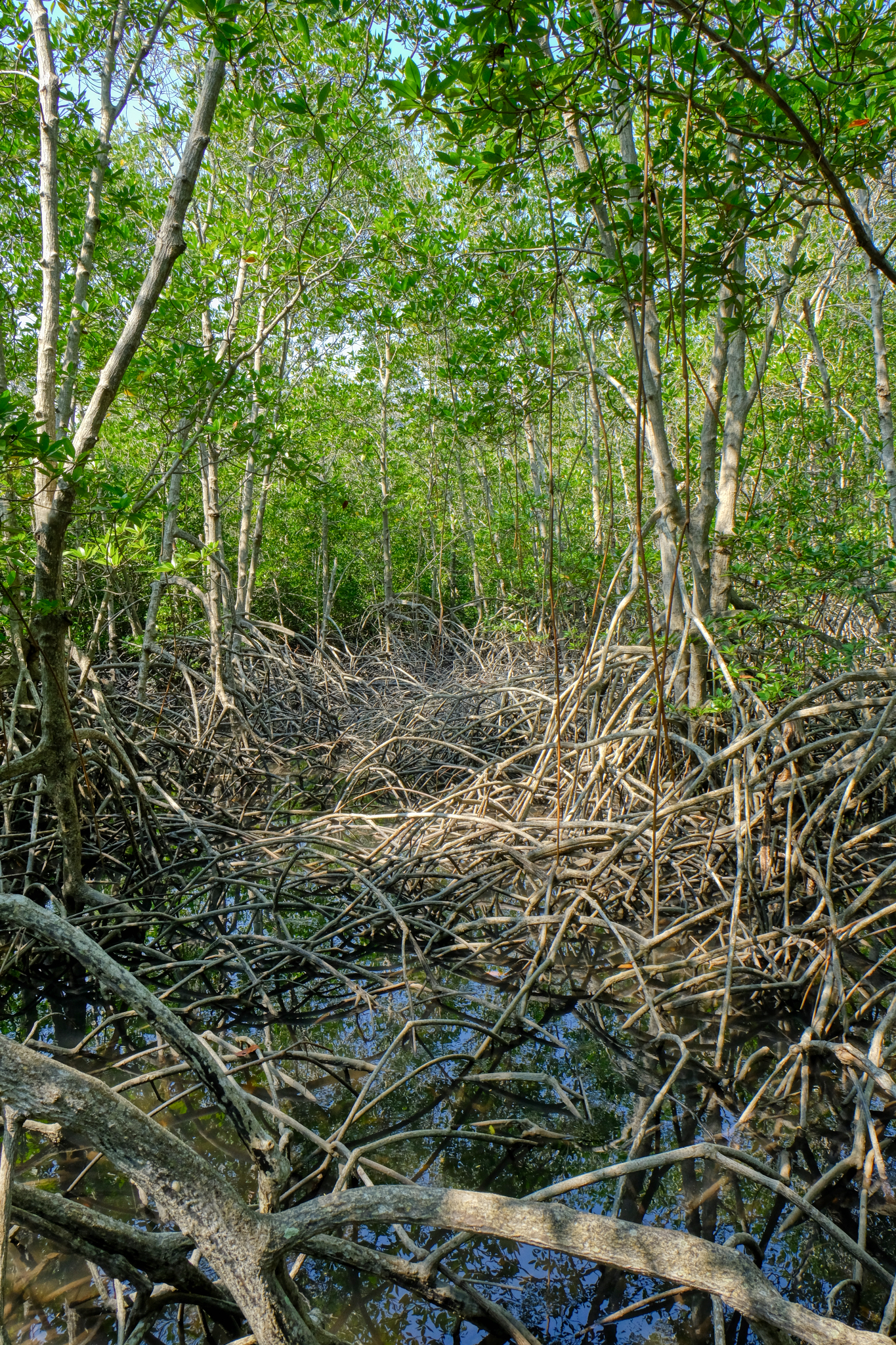 Mangroves grow in salt water estuarial swamps.
Mangroves grow in salt water estuarial swamps.
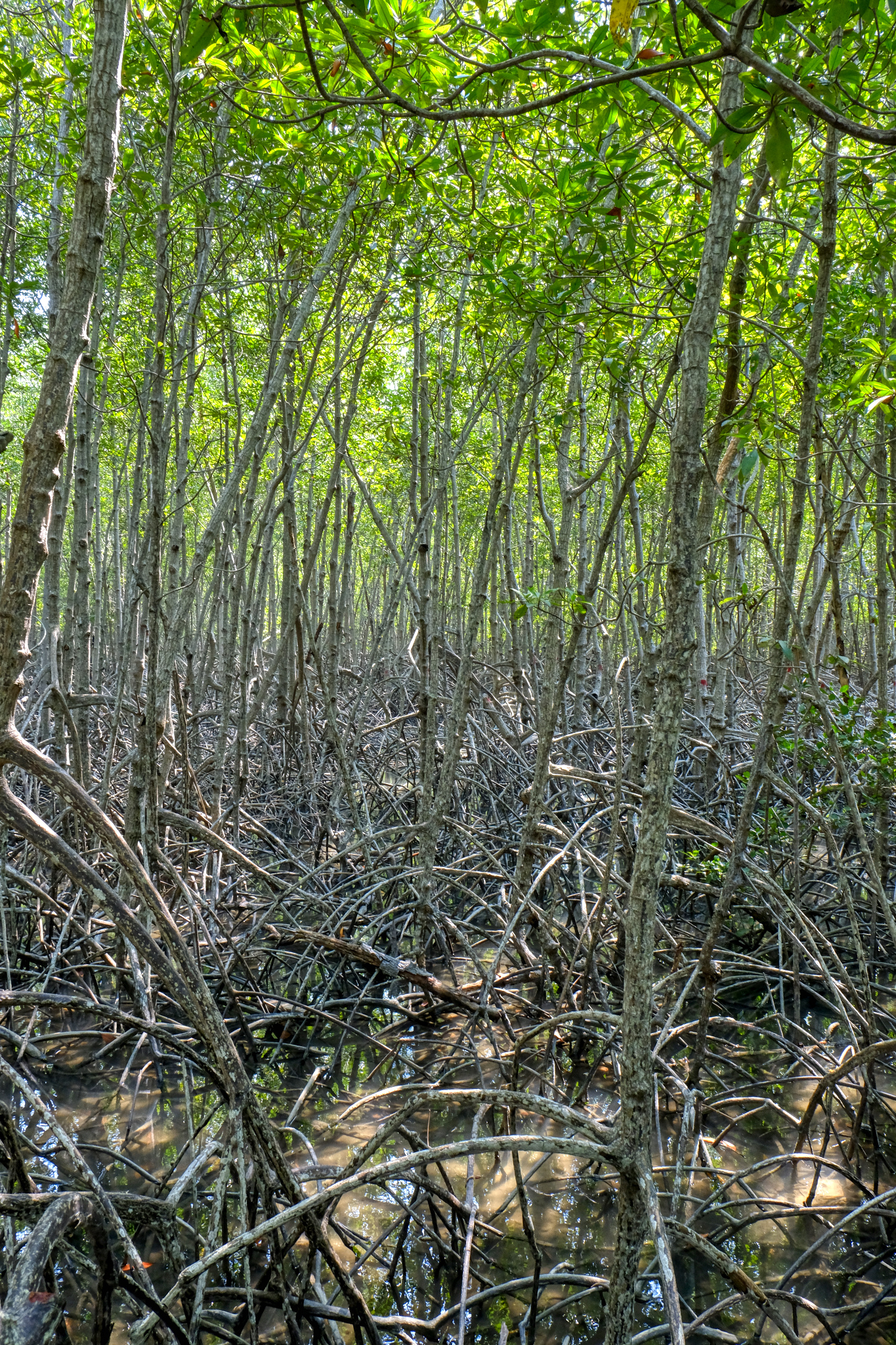 A phantasmagoria of twisted and gnarled complexity. Wonderful Nature.
A phantasmagoria of twisted and gnarled complexity. Wonderful Nature.
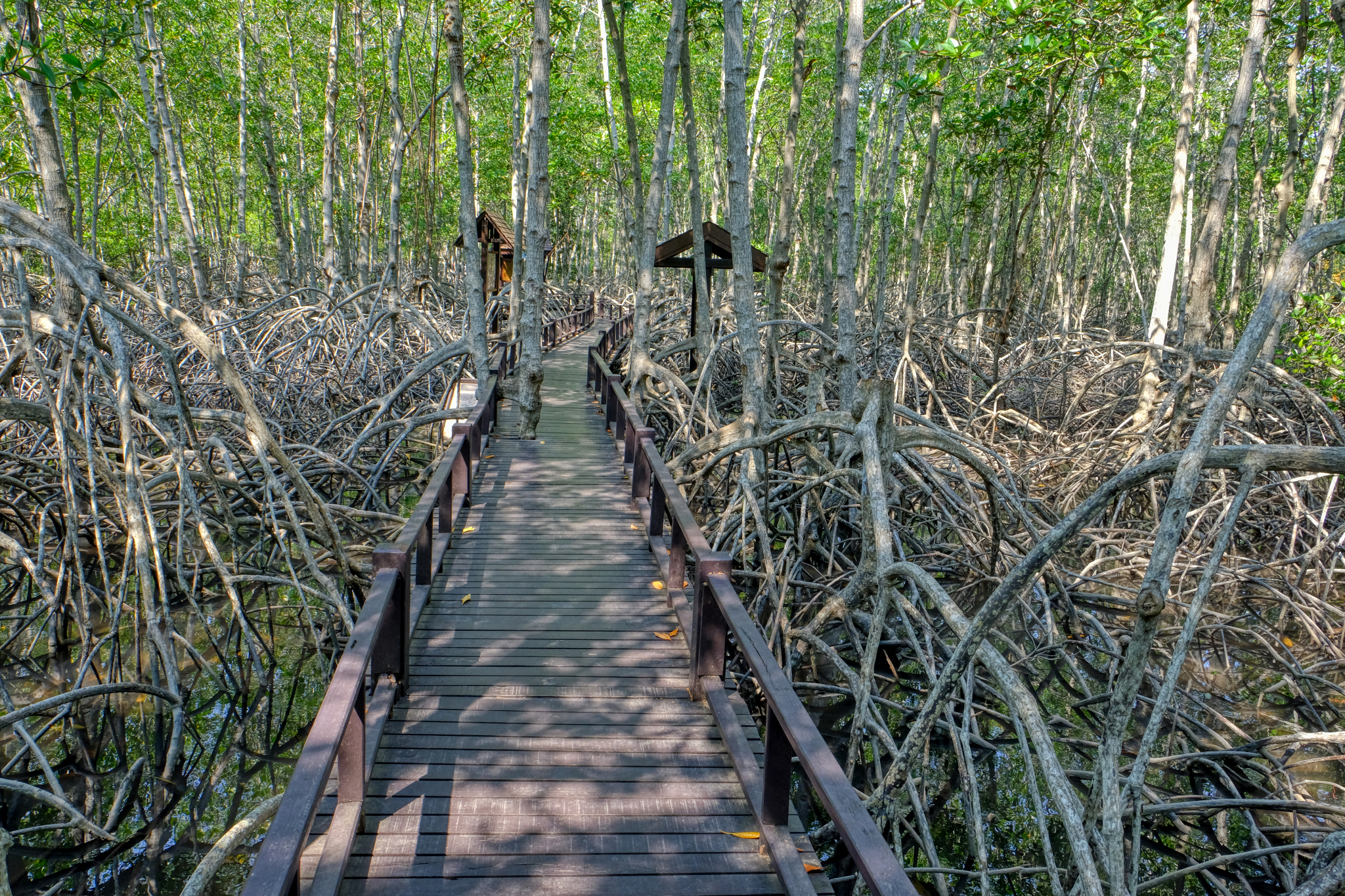 The park positioned bulletin boards (in Thai and English) along the way with informative graphics.
The park positioned bulletin boards (in Thai and English) along the way with informative graphics.
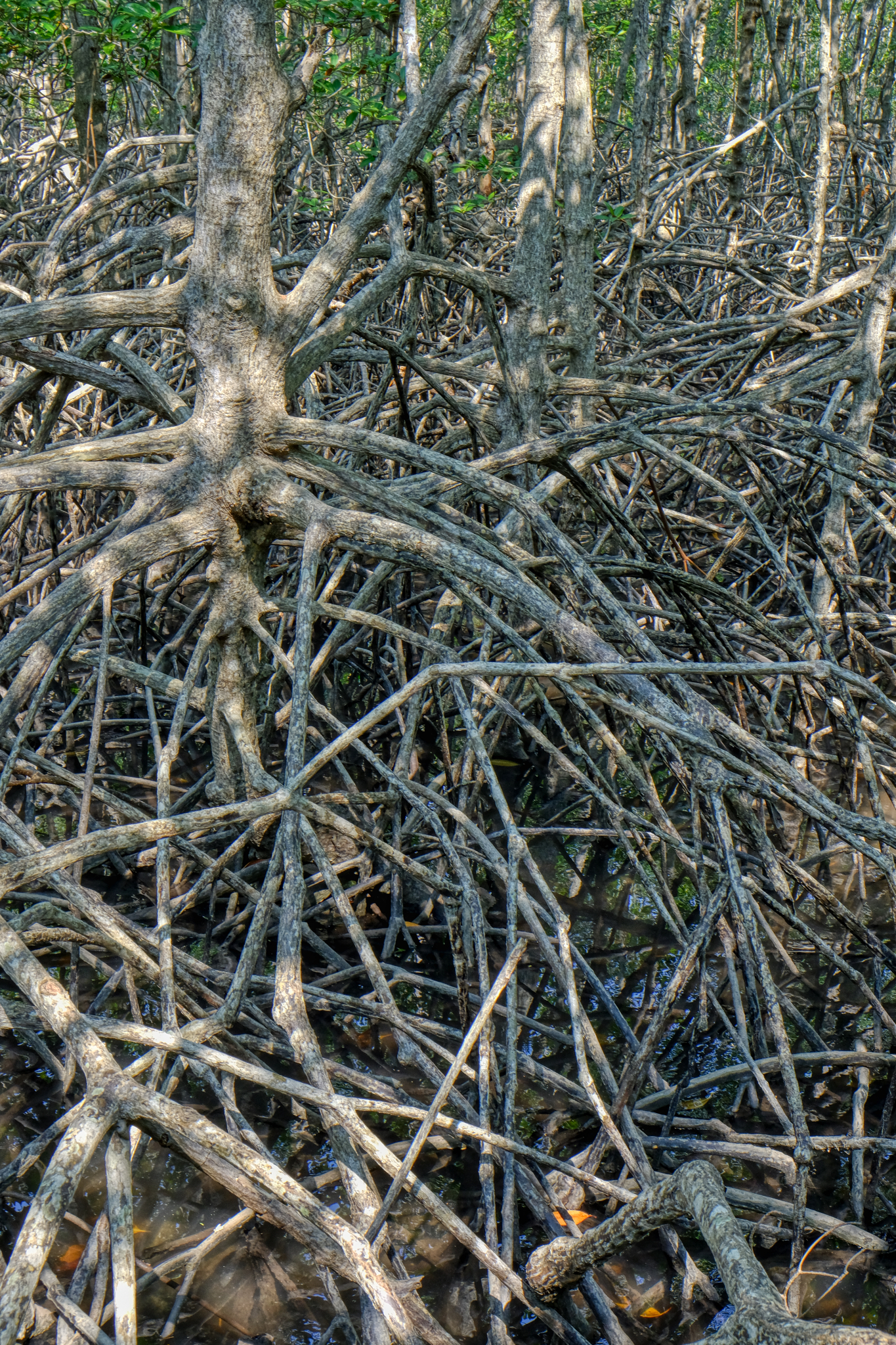 Mangrove roots grow in the transition between wet (at high tide) and exposed to the air (at low tide). The mangrove grows in salt water but has the ability to filter out the salt and deposit it on the root 'knees' to be dissolved off when the tide comes in. Amazing.
Mangrove roots grow in the transition between wet (at high tide) and exposed to the air (at low tide). The mangrove grows in salt water but has the ability to filter out the salt and deposit it on the root 'knees' to be dissolved off when the tide comes in. Amazing.
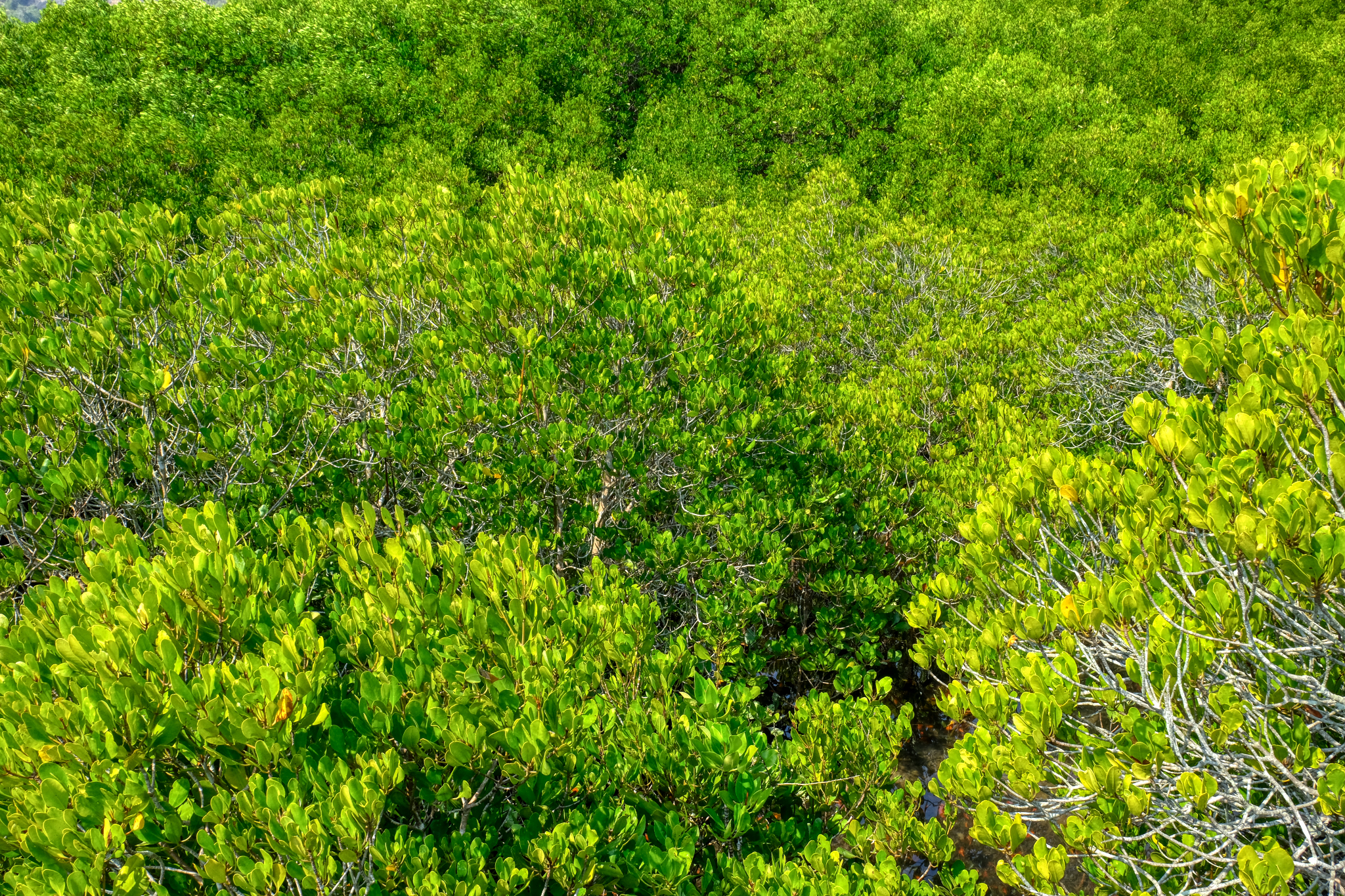 The park managers built a tall tower so that the mangrove forest could be seen from above.
The park managers built a tall tower so that the mangrove forest could be seen from above.
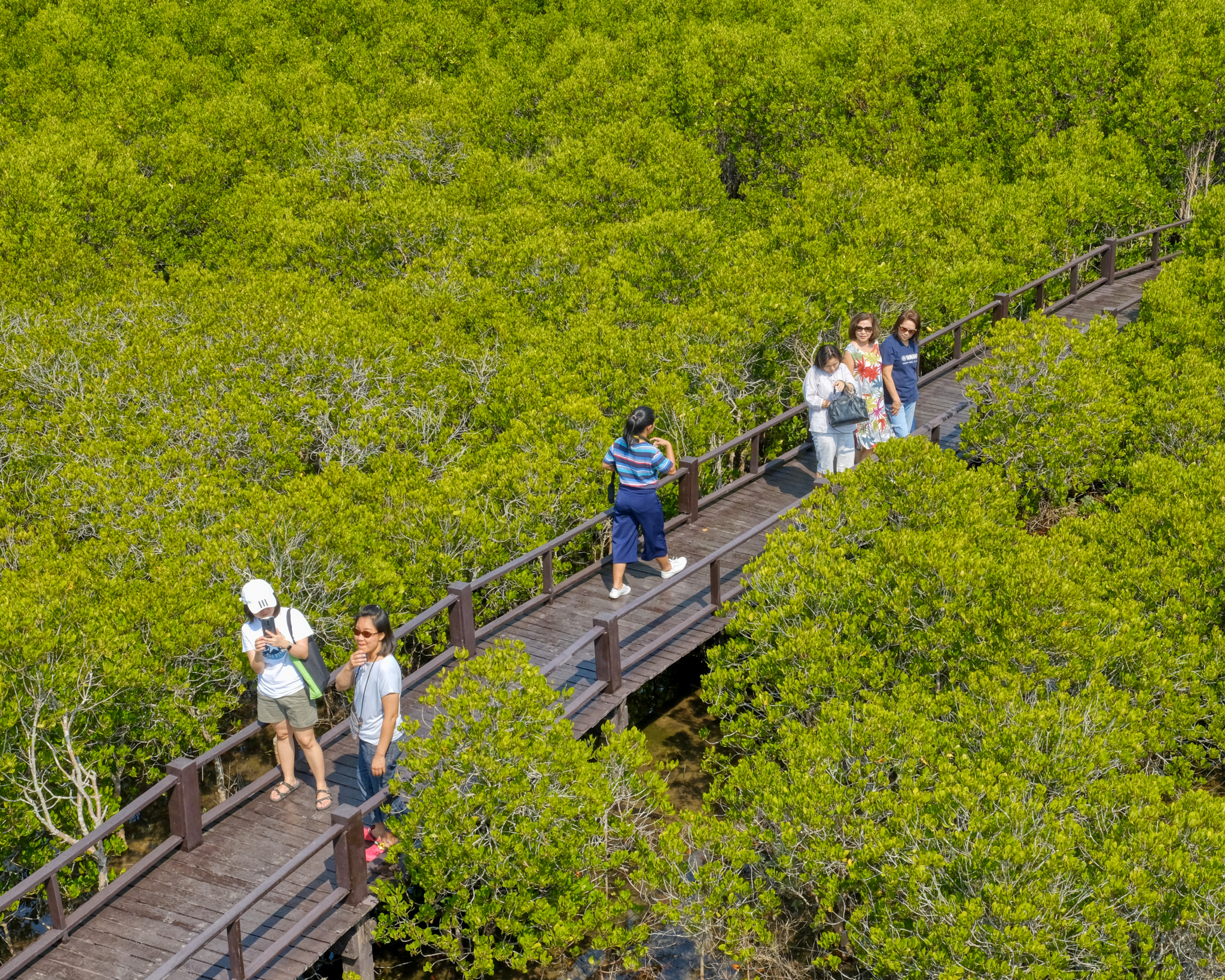 It was New Years' Eve, so there were quite a few day trippers from nearby Hua Hin.
It was New Years' Eve, so there were quite a few day trippers from nearby Hua Hin.
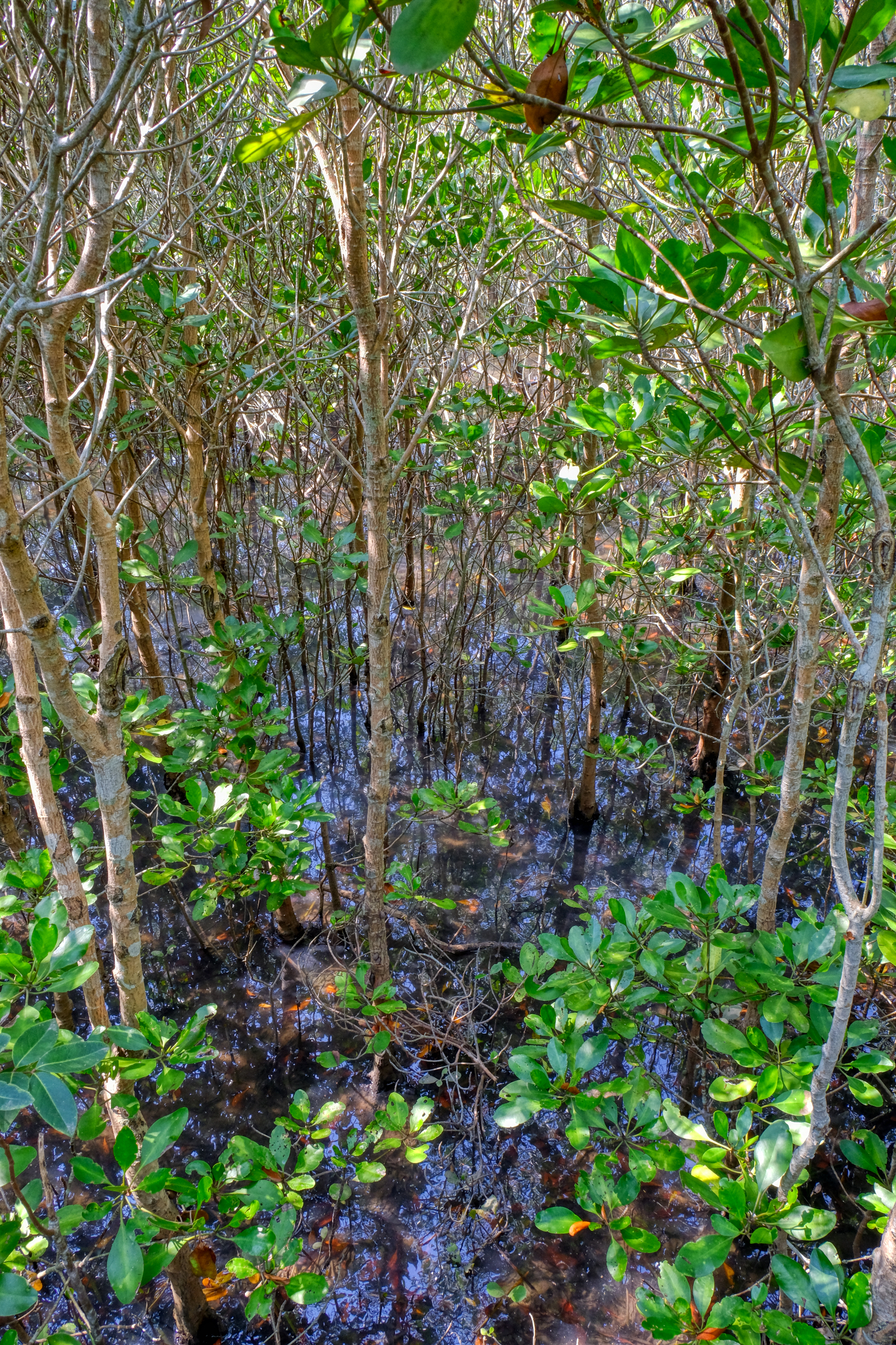 We wandered on along the elevated walkway. There seemed to be a change in the nature of the trees in the swamp.
We wandered on along the elevated walkway. There seemed to be a change in the nature of the trees in the swamp.
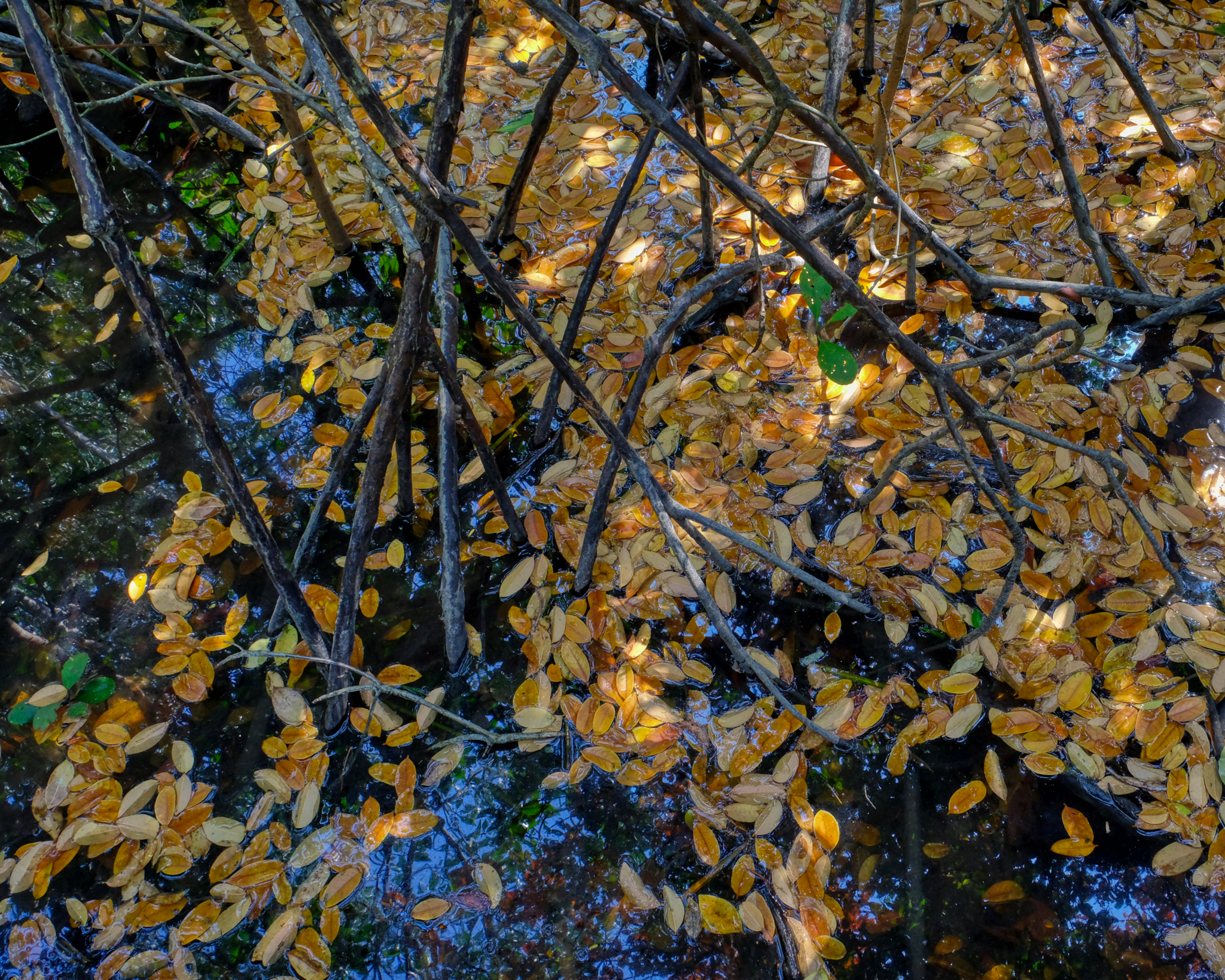 "Autumn" colors in the swamp. A blue sky reflected in the brackish waters.
"Autumn" colors in the swamp. A blue sky reflected in the brackish waters.
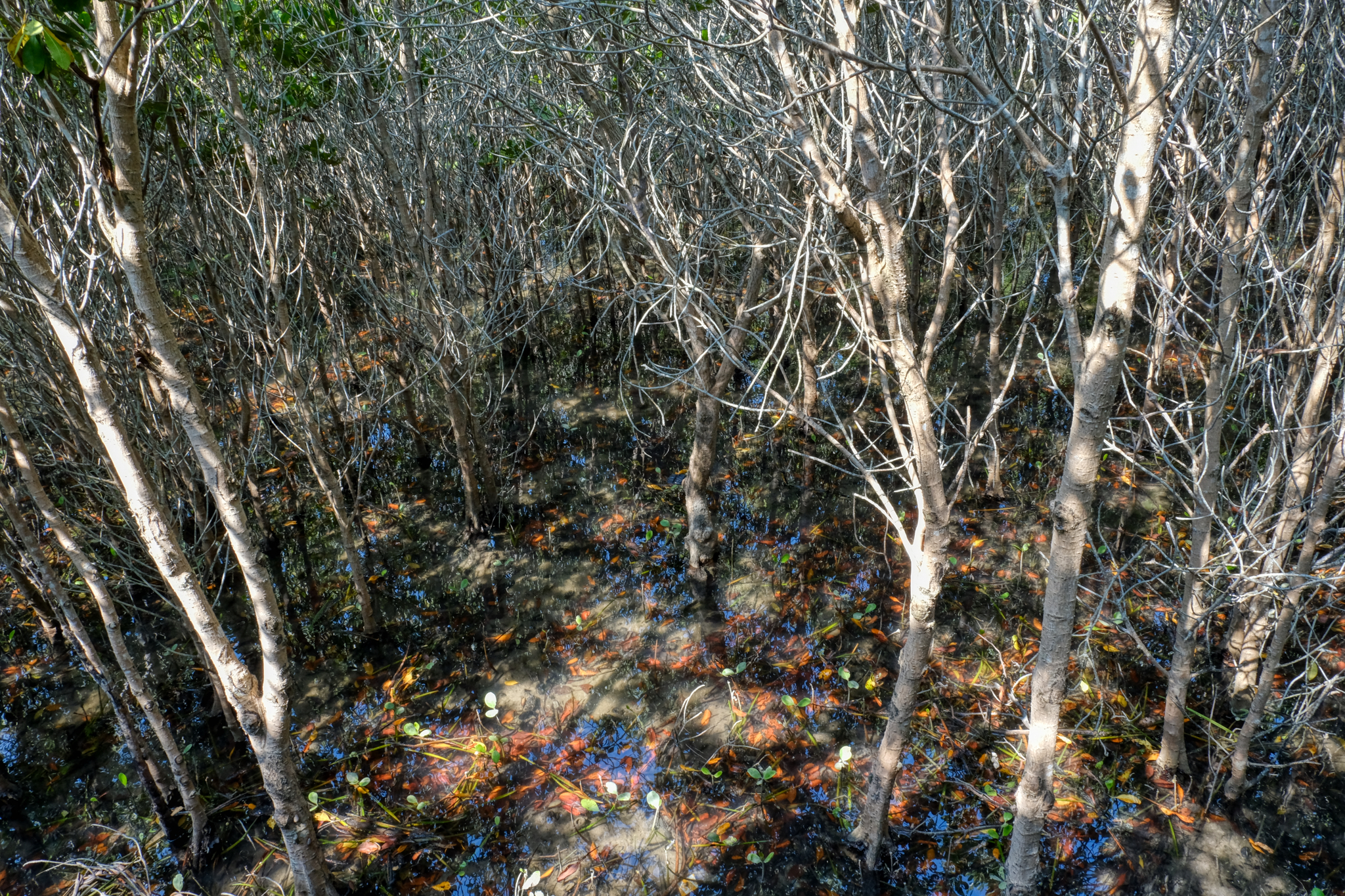 Beautiful complicated light on the complicated forest . . . truly marvelous.
Beautiful complicated light on the complicated forest . . . truly marvelous.
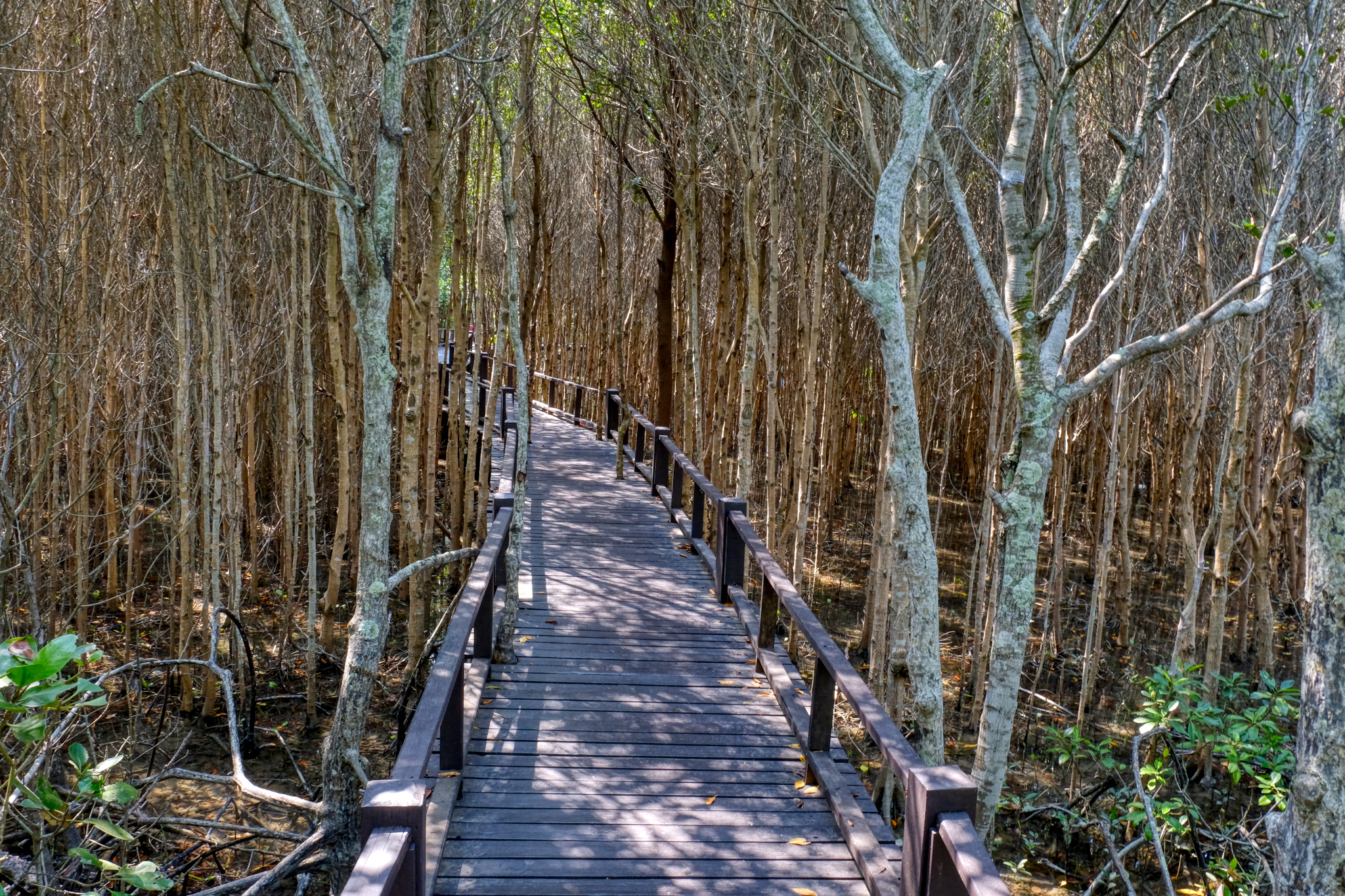 We walked on into a stand of densely packed trees . . . not mangrove, but growing in the salty water.
We walked on into a stand of densely packed trees . . . not mangrove, but growing in the salty water.
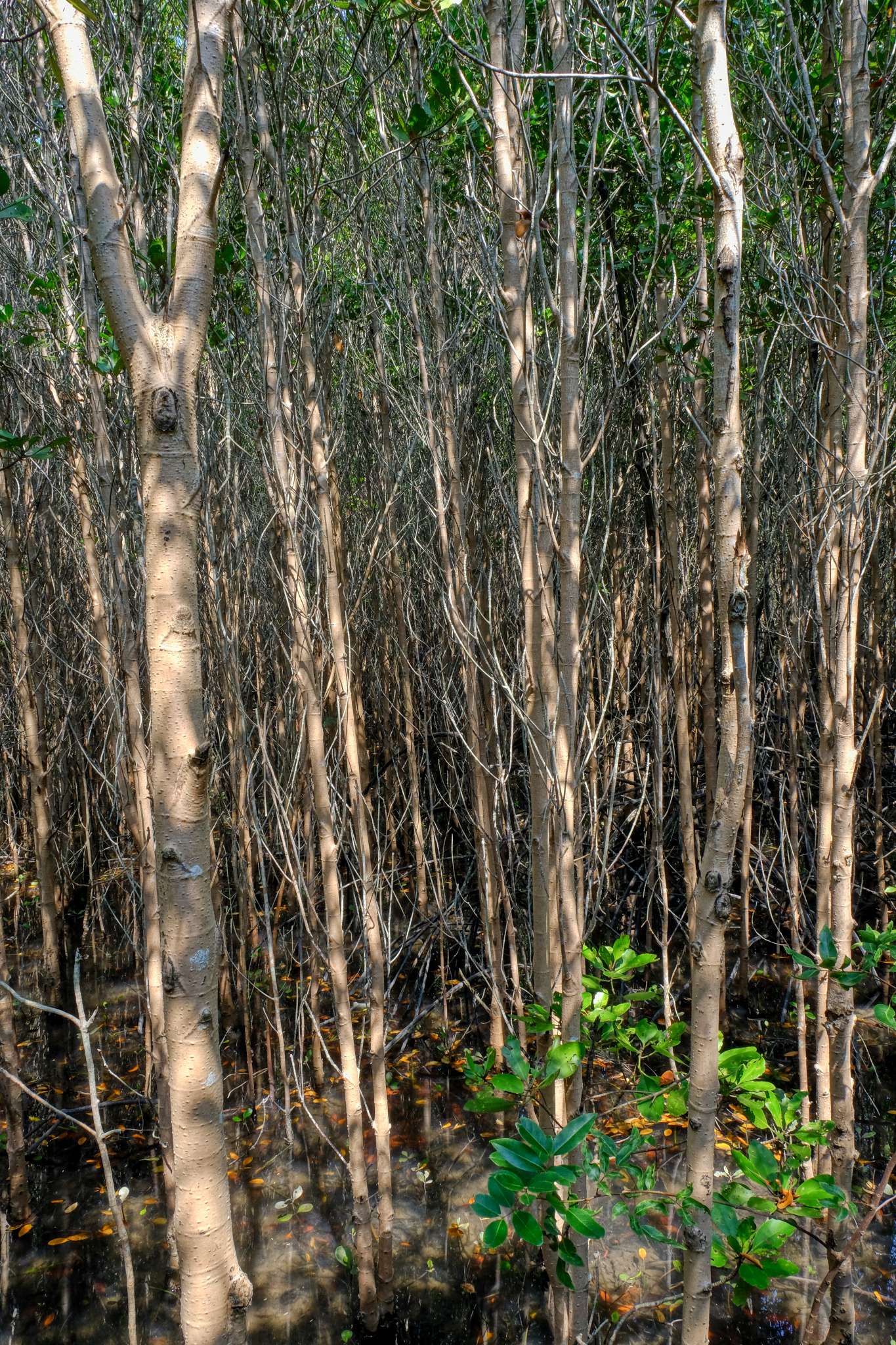 Ever-changing scenes . . .
Ever-changing scenes . . .
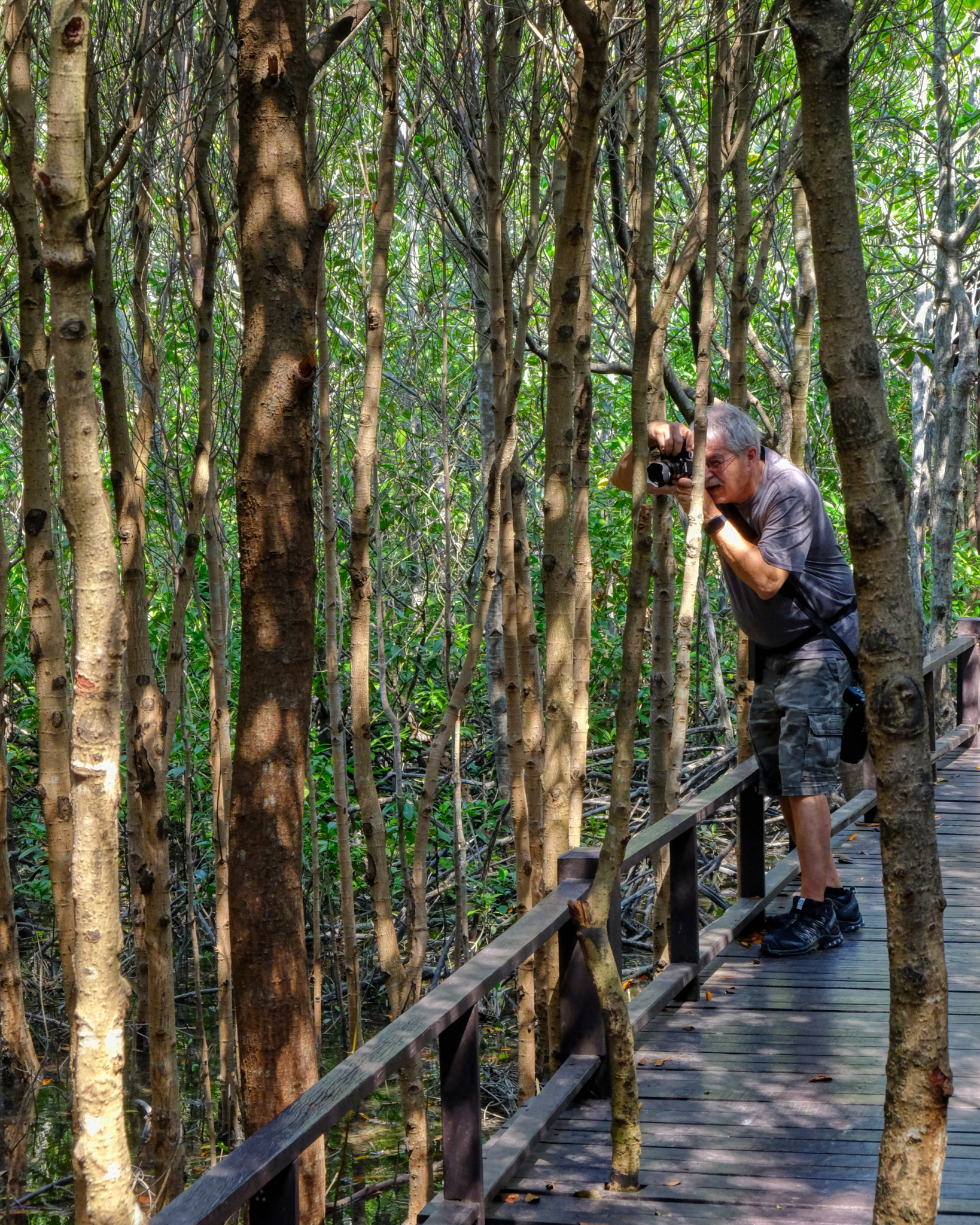 My friend enjoying the photographic opportunities.
My friend enjoying the photographic opportunities.
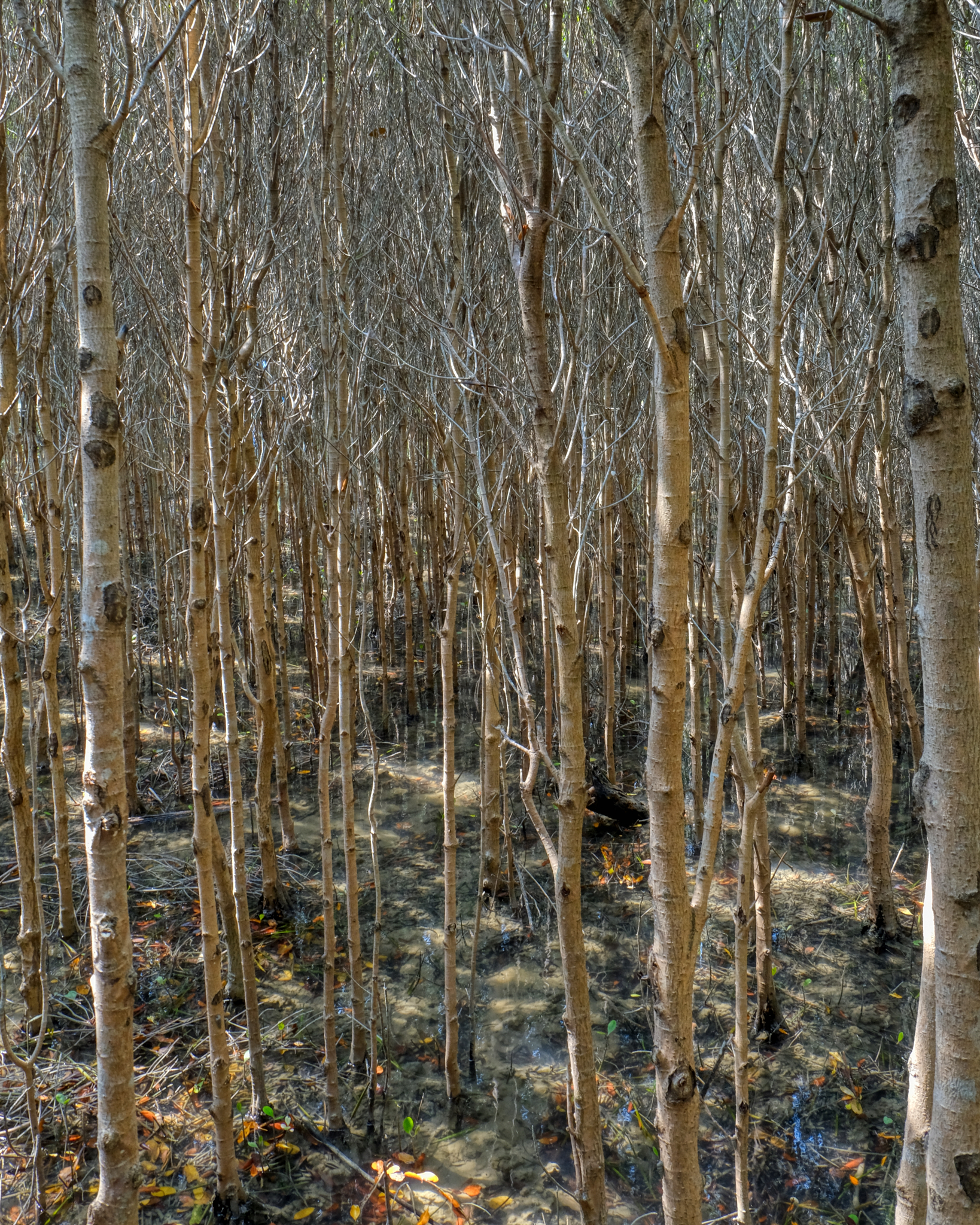 I do not know how these particular trees shed the salt.
I do not know how these particular trees shed the salt.
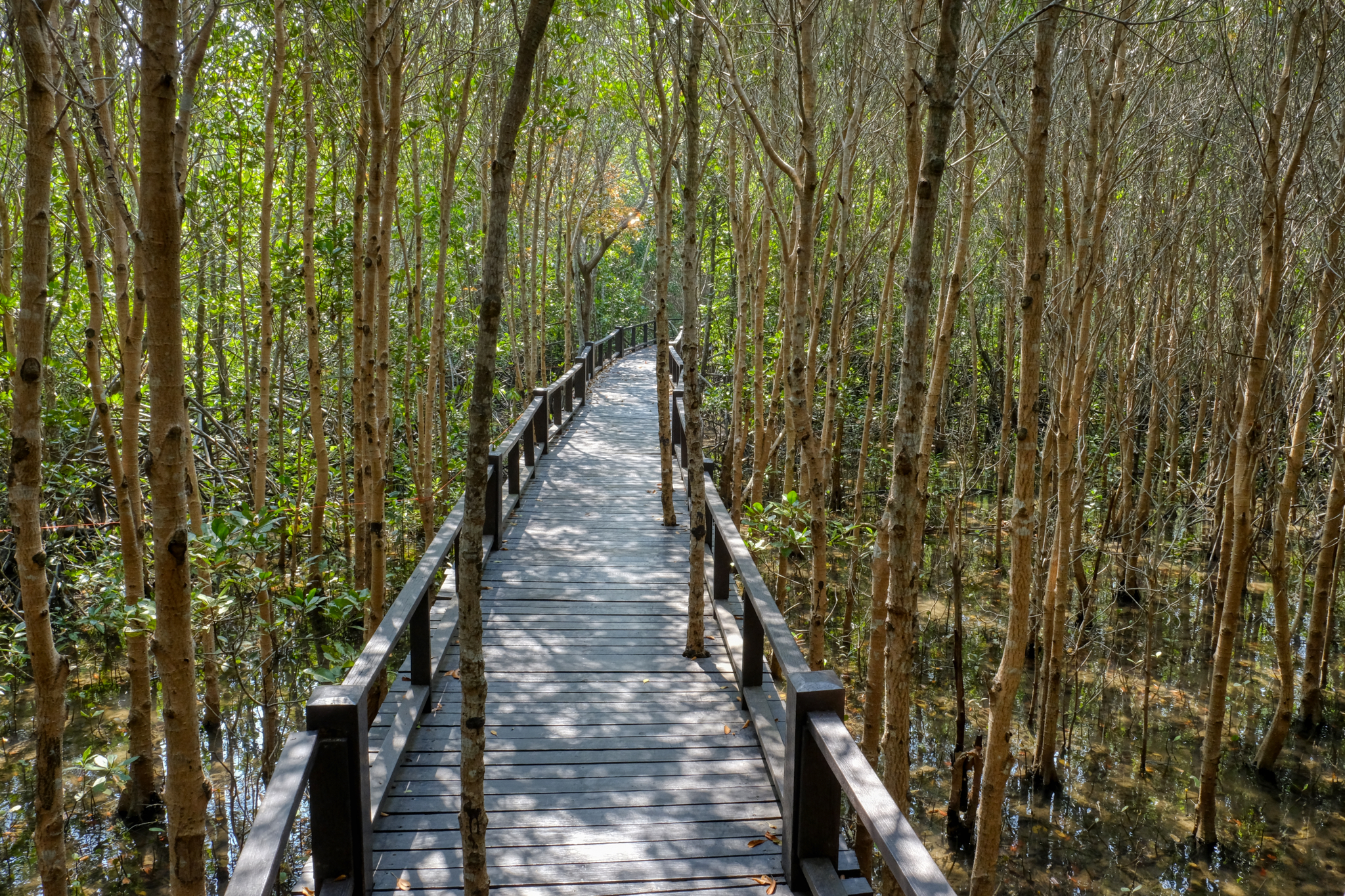 On we walked through a forest of thin trees growing in the saltwater marsh.
On we walked through a forest of thin trees growing in the saltwater marsh.
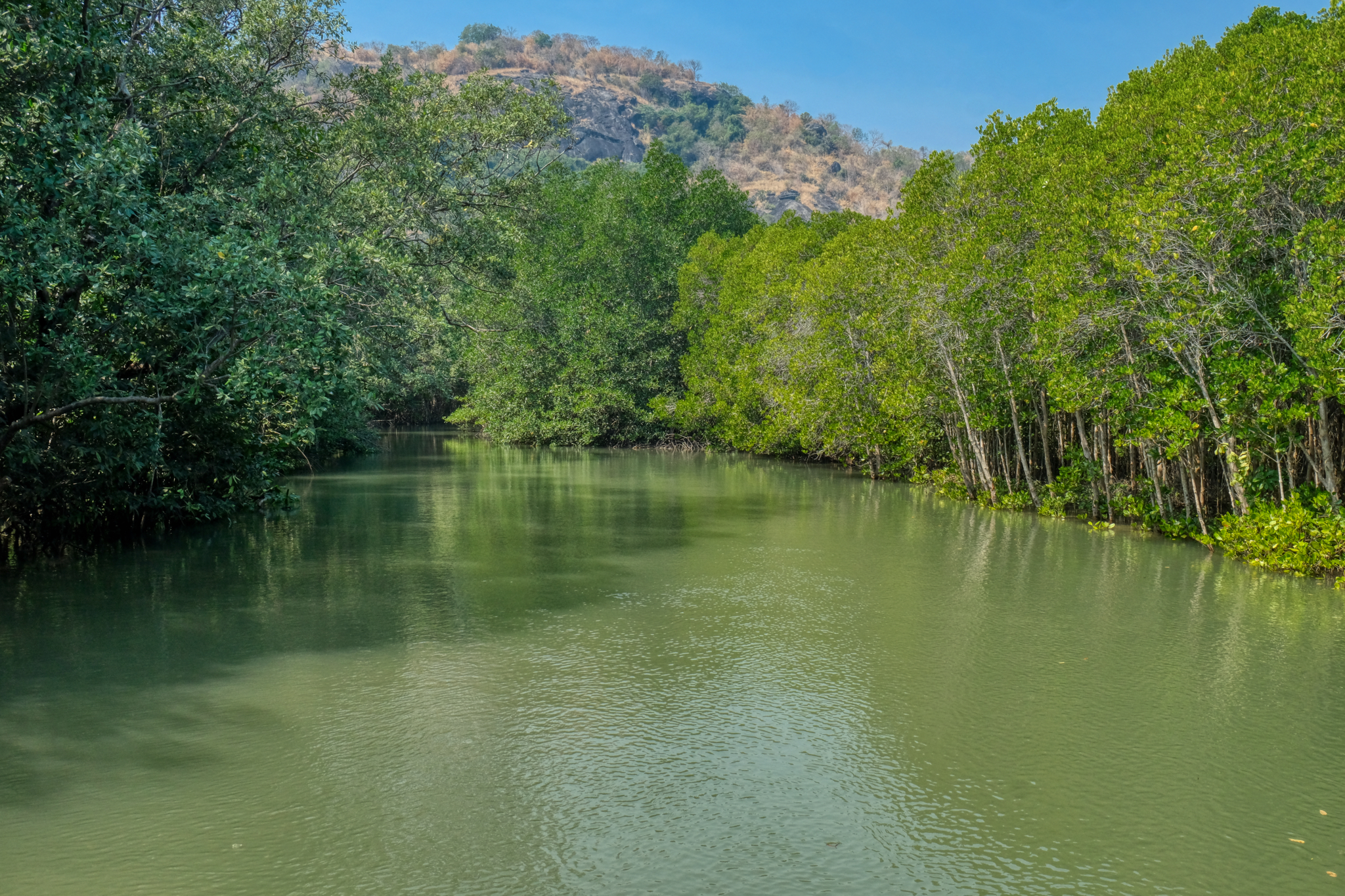 We came to a saltwater inlet. There was a pier offering boat rides, but there was a line of people waiting. We walked on . . . more [visual] adventures in store.
We came to a saltwater inlet. There was a pier offering boat rides, but there was a line of people waiting. We walked on . . . more [visual] adventures in store.
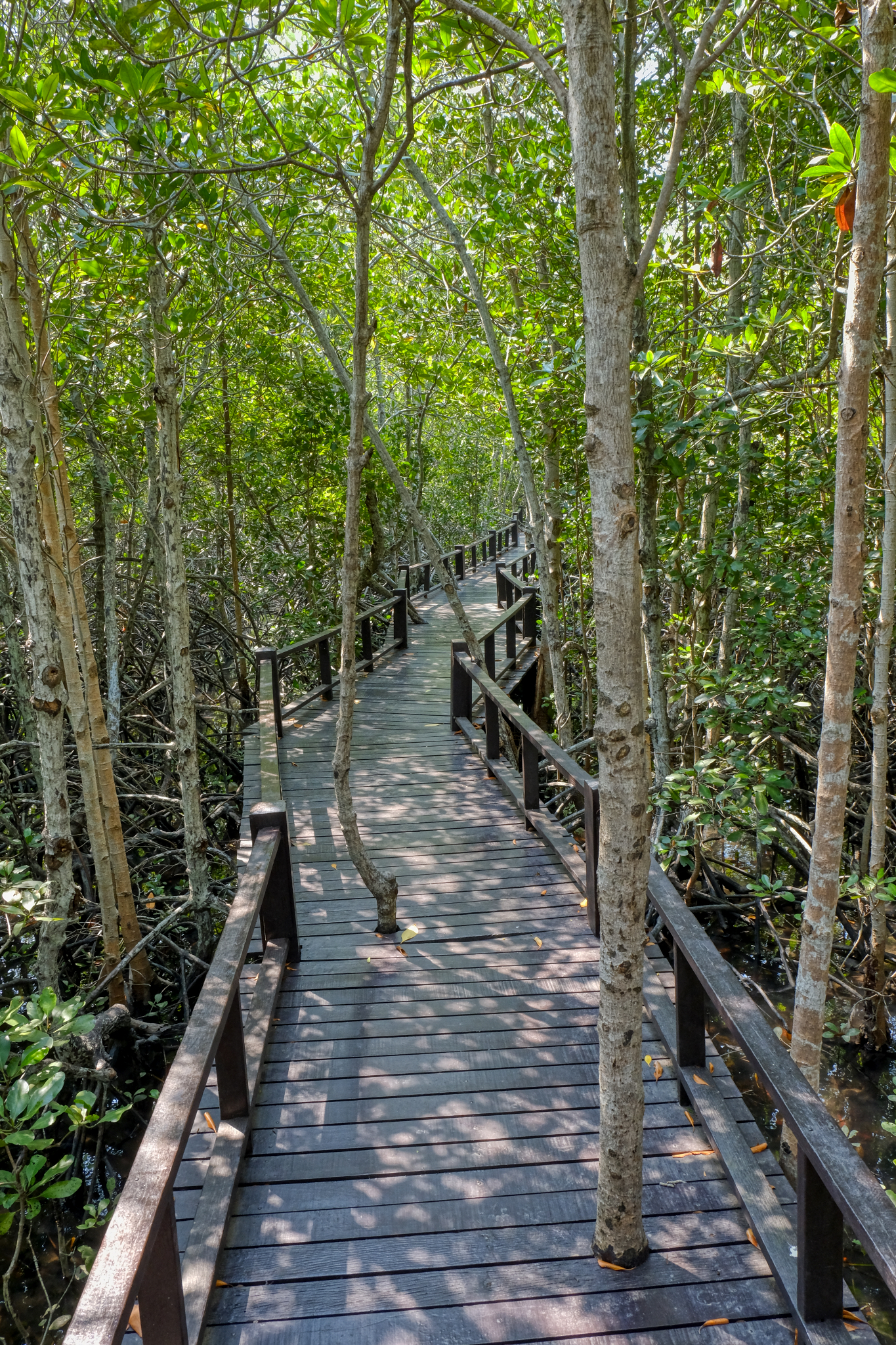 We walked the rest of the 2km walkway loop to the car . . .
We walked the rest of the 2km walkway loop to the car . . .
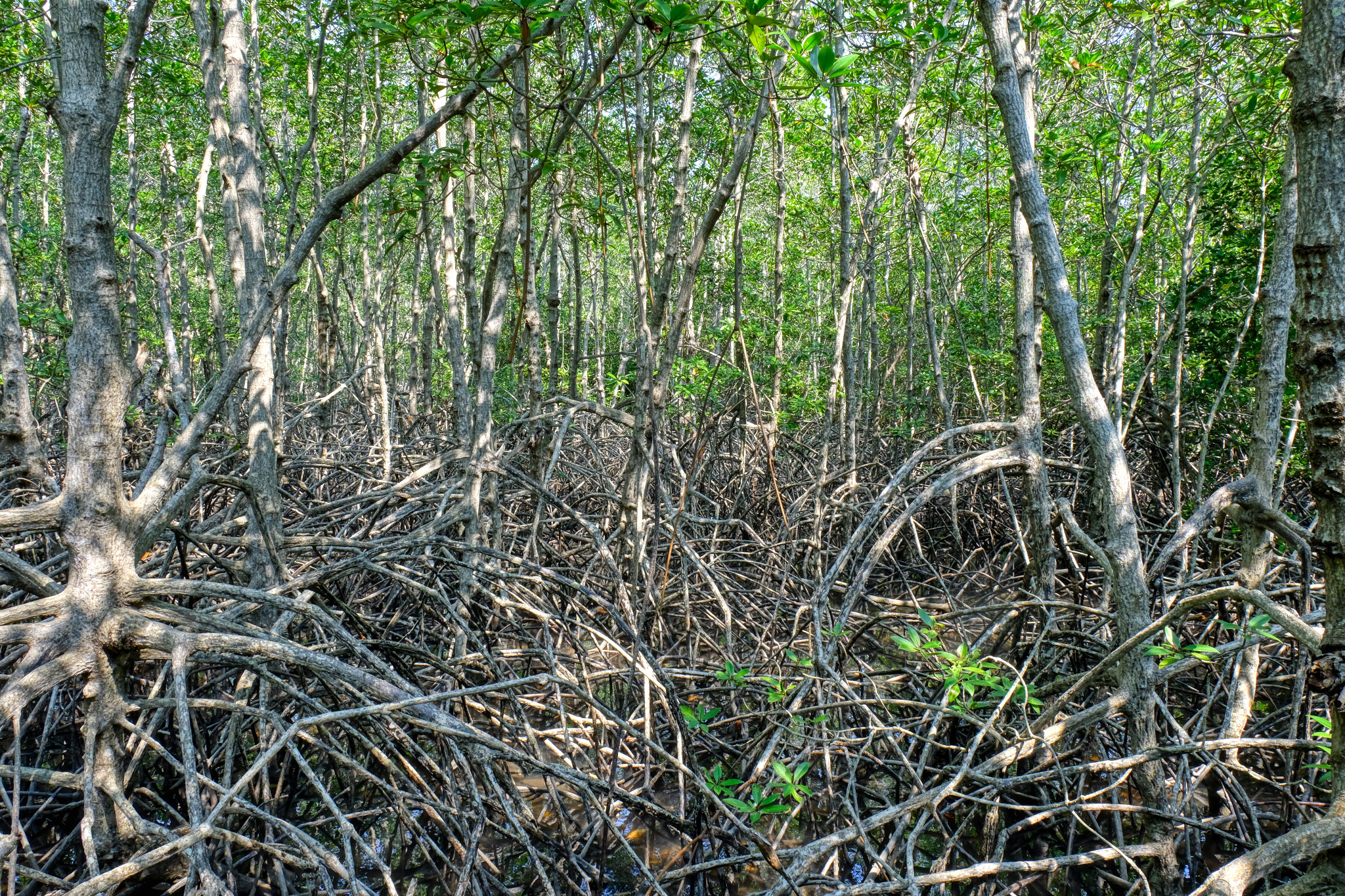 . . . and back through the tangled web of the mangrove knees.
. . . and back through the tangled web of the mangrove knees.
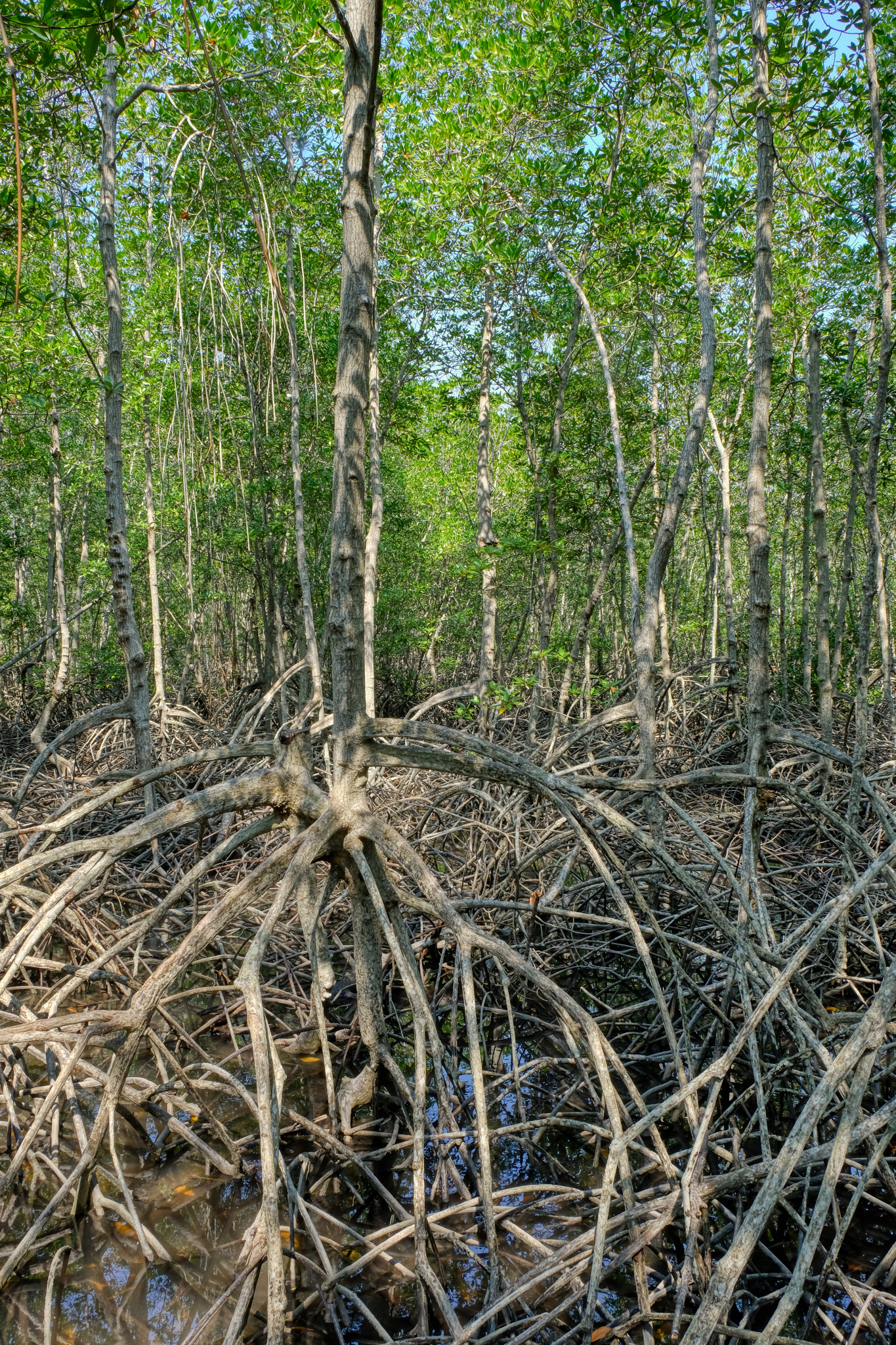 We spent a wonderful couple of hours being amazed by this fantastic environment . . and taking photographs to our hearts content.
We spent a wonderful couple of hours being amazed by this fantastic environment . . and taking photographs to our hearts content.
-----------------------------------------------------
A Fishing Port Village
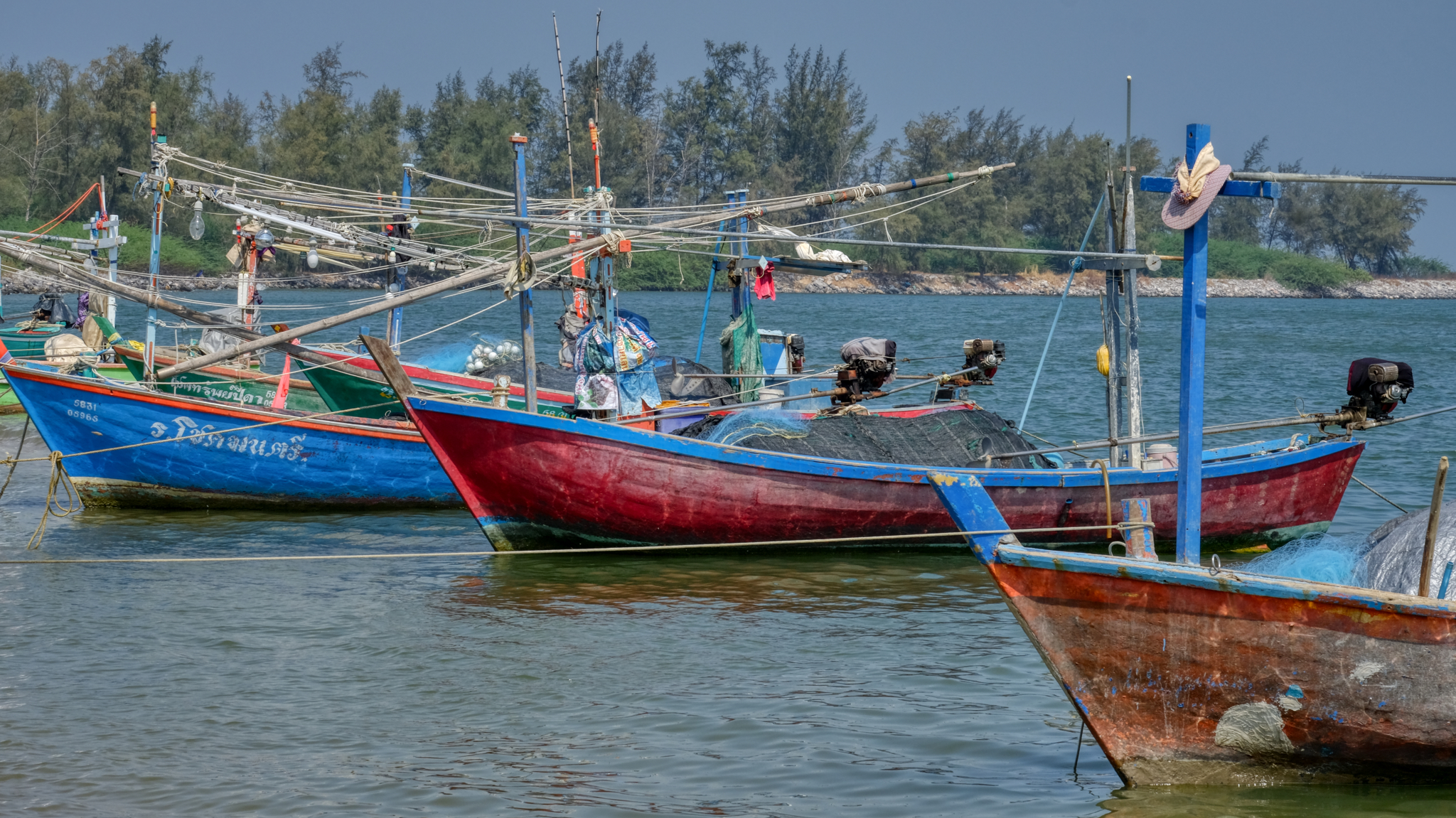 About a mile away from the mangrove forest park was another small fishing port.
About a mile away from the mangrove forest park was another small fishing port.
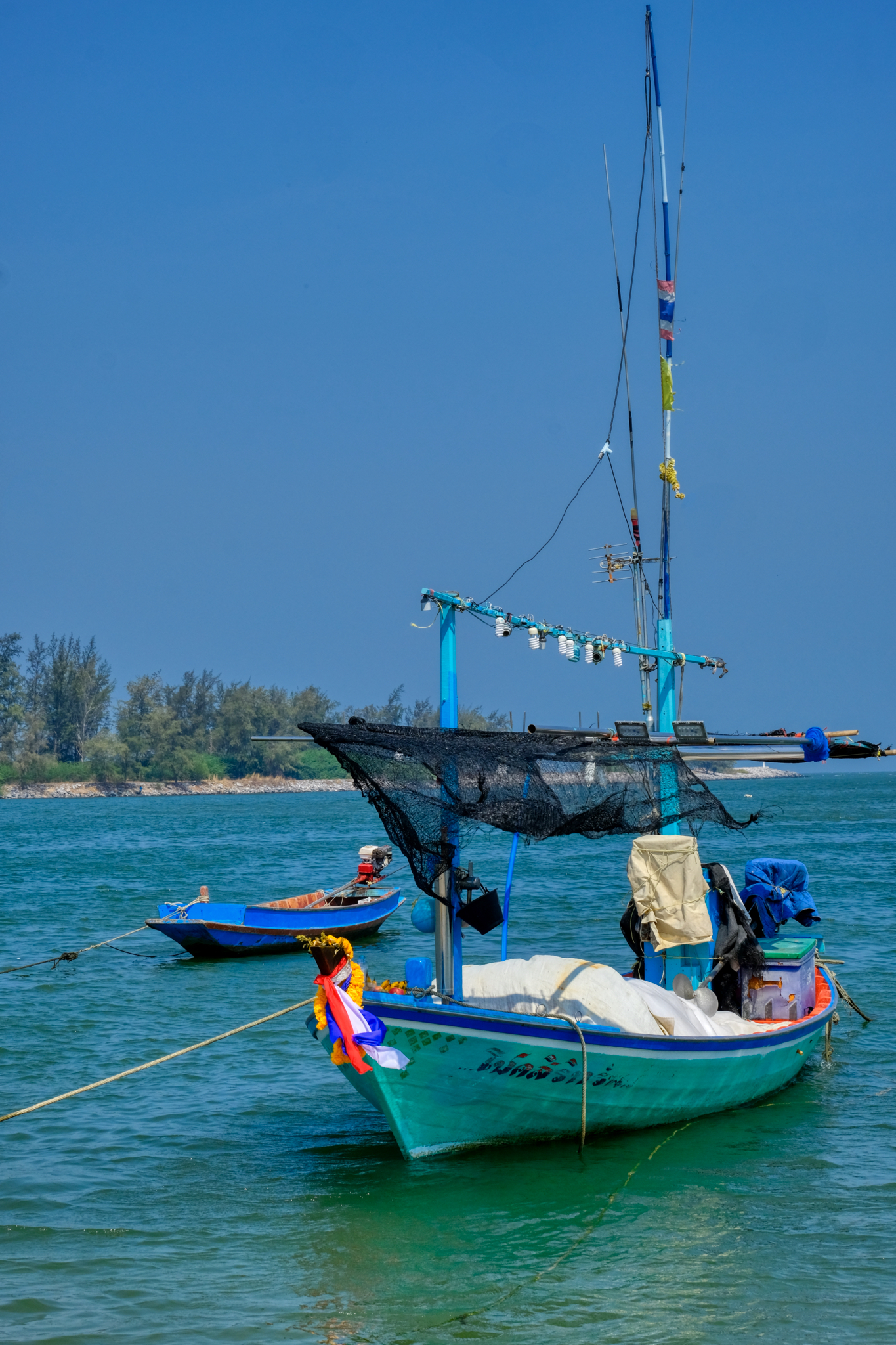 A beautiful day with colorful boats . . . what's not to like?
A beautiful day with colorful boats . . . what's not to like?
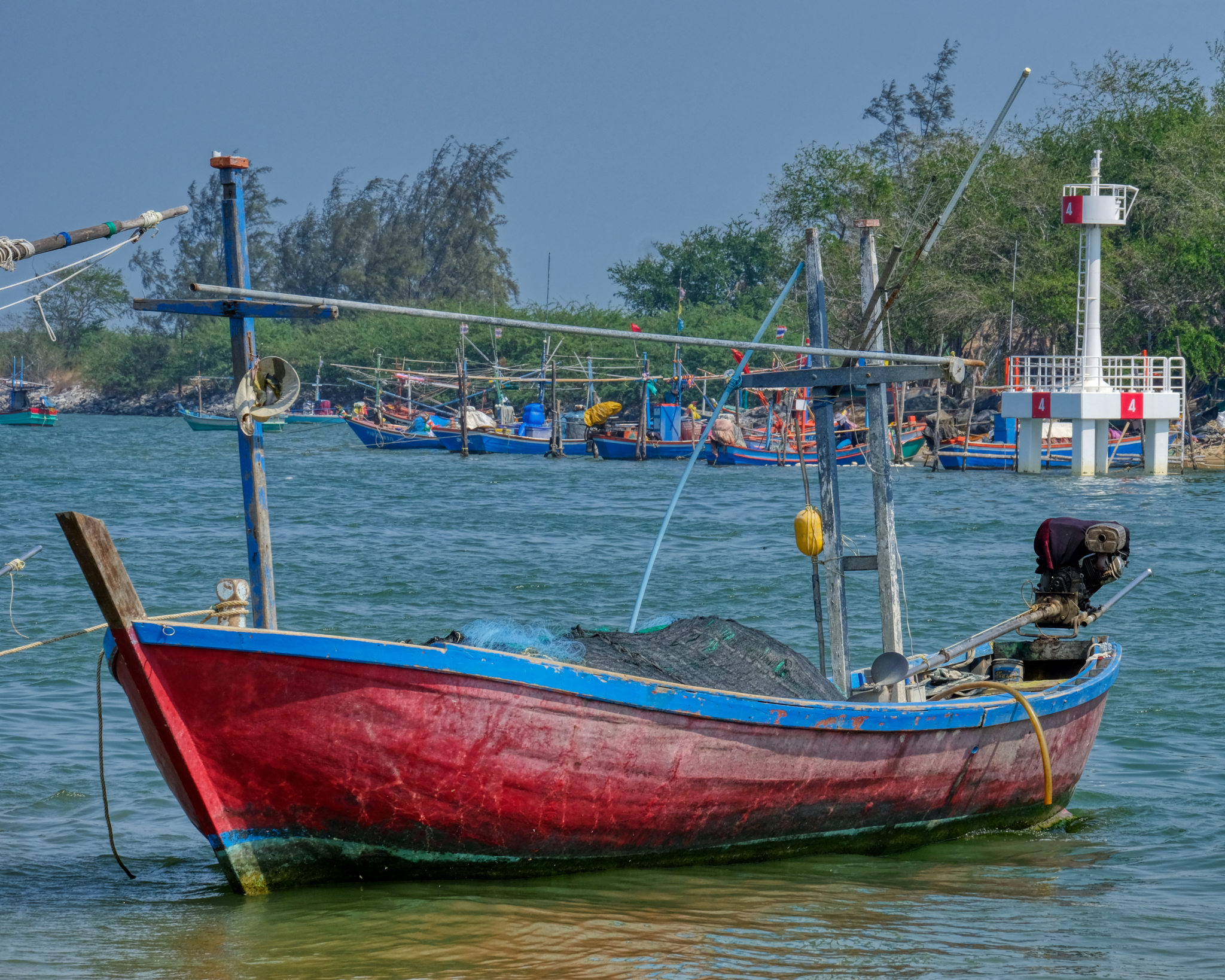 Small squid boats and large 'company boats" . . .
Small squid boats and large 'company boats" . . .
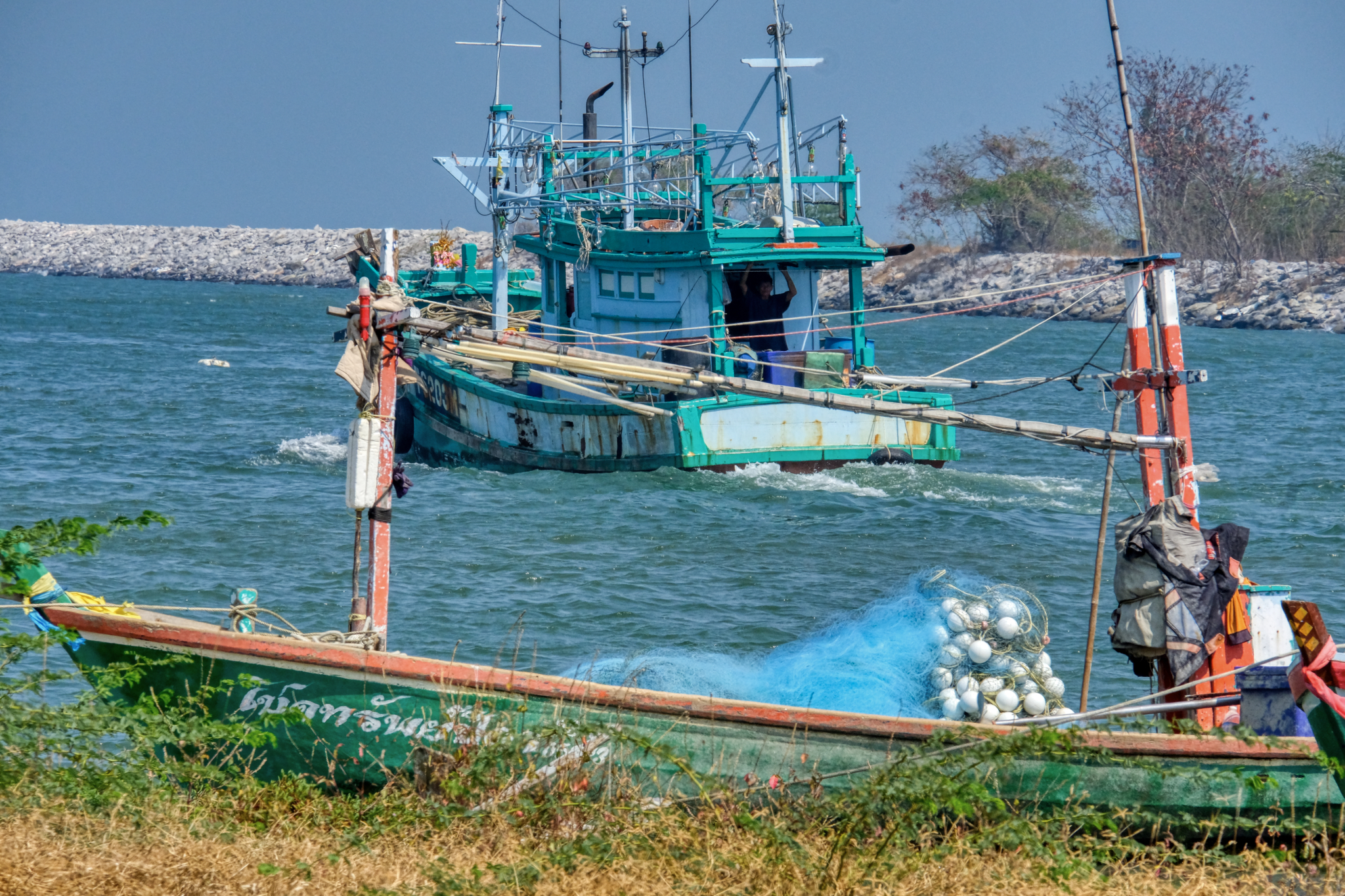 A 'company boat' heading out early for night squidding . . . they must be going far out into the Gulf of Thailand.
A 'company boat' heading out early for night squidding . . . they must be going far out into the Gulf of Thailand.
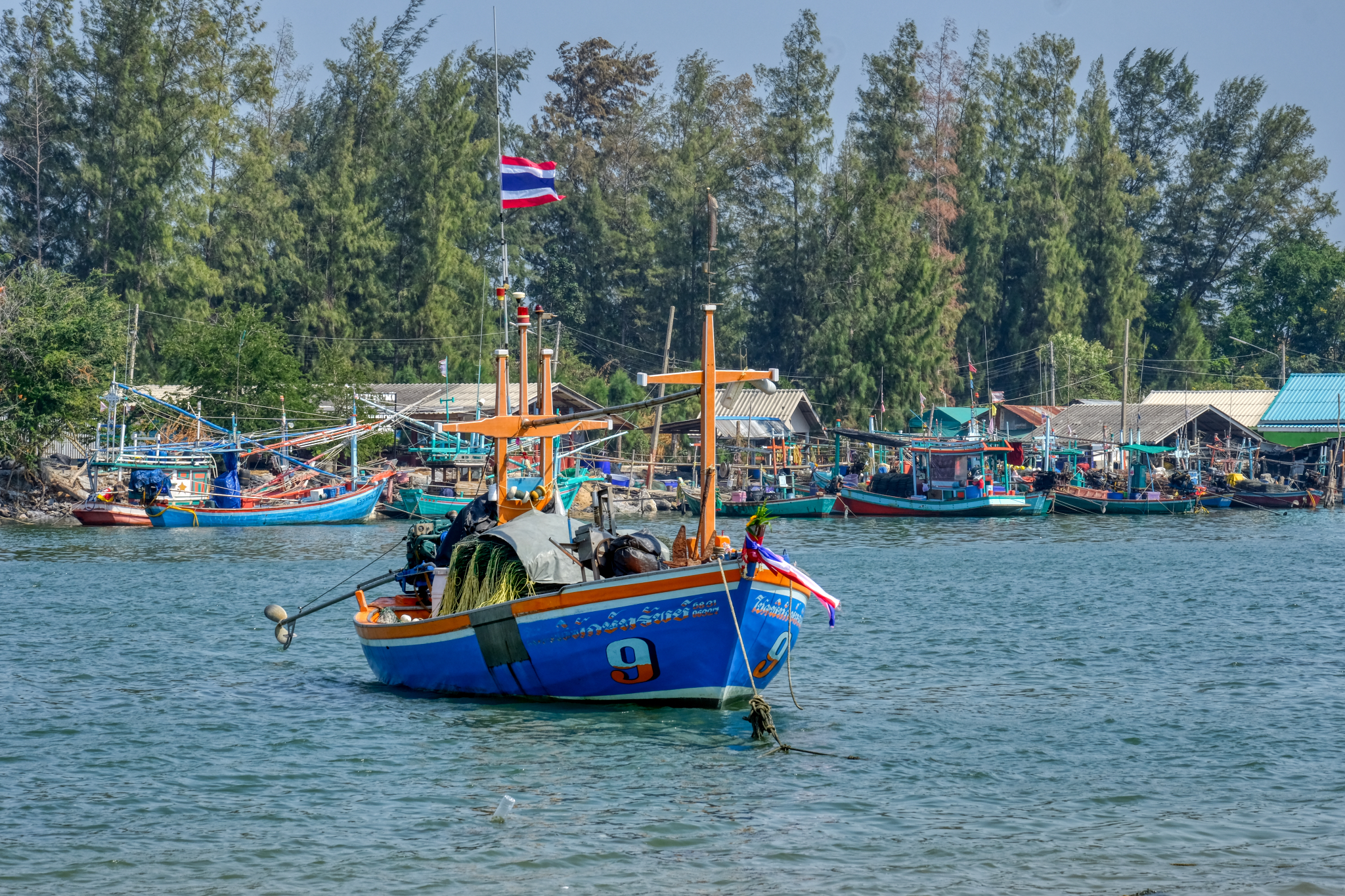 A busy Thai commercial fishing port.
A busy Thai commercial fishing port.
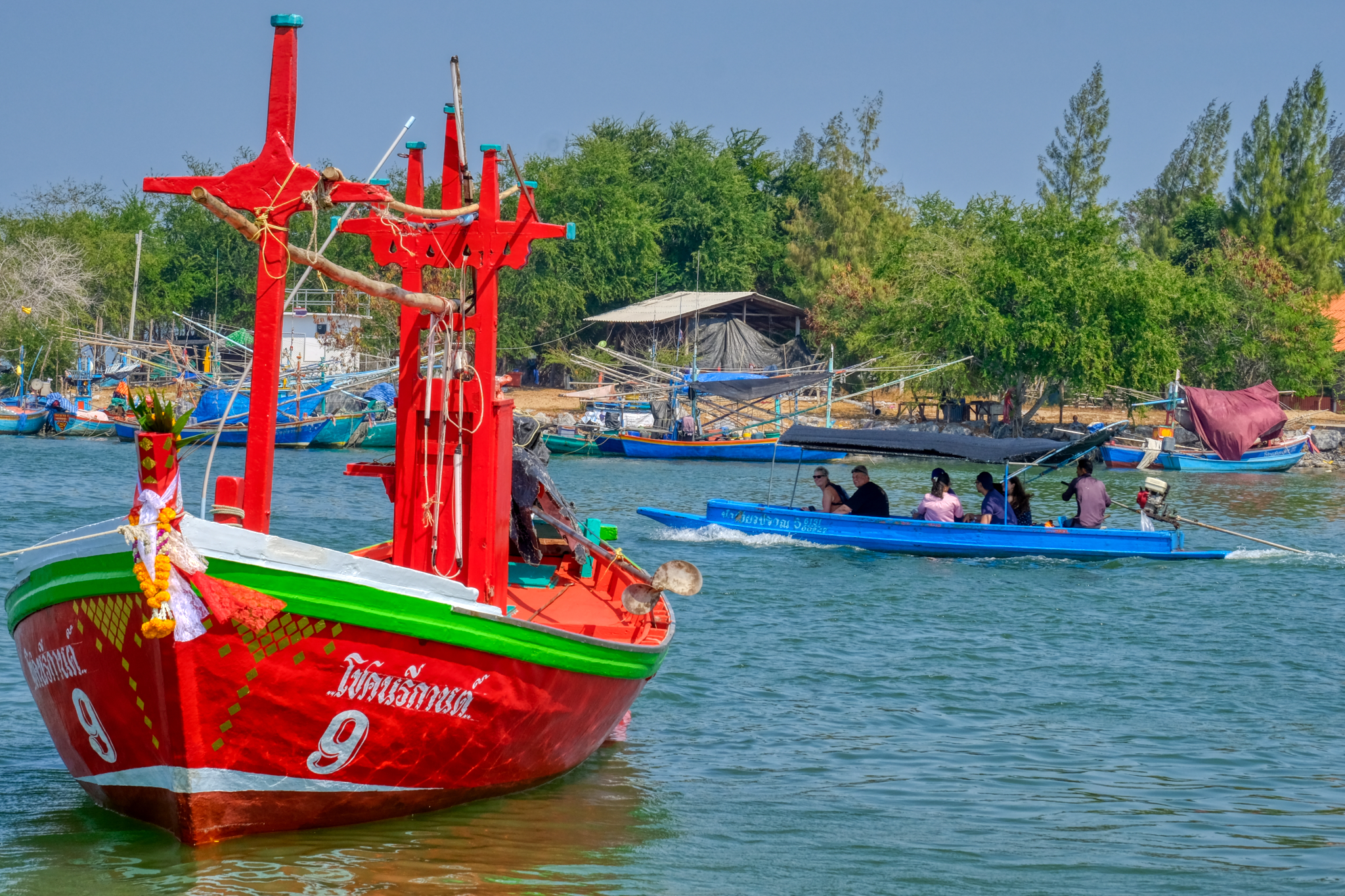 Yep . . . a tourist tour boat! This is actually the tourist boat from the mangrove forest park nearby . . . we all waved at each other.
Yep . . . a tourist tour boat! This is actually the tourist boat from the mangrove forest park nearby . . . we all waved at each other.
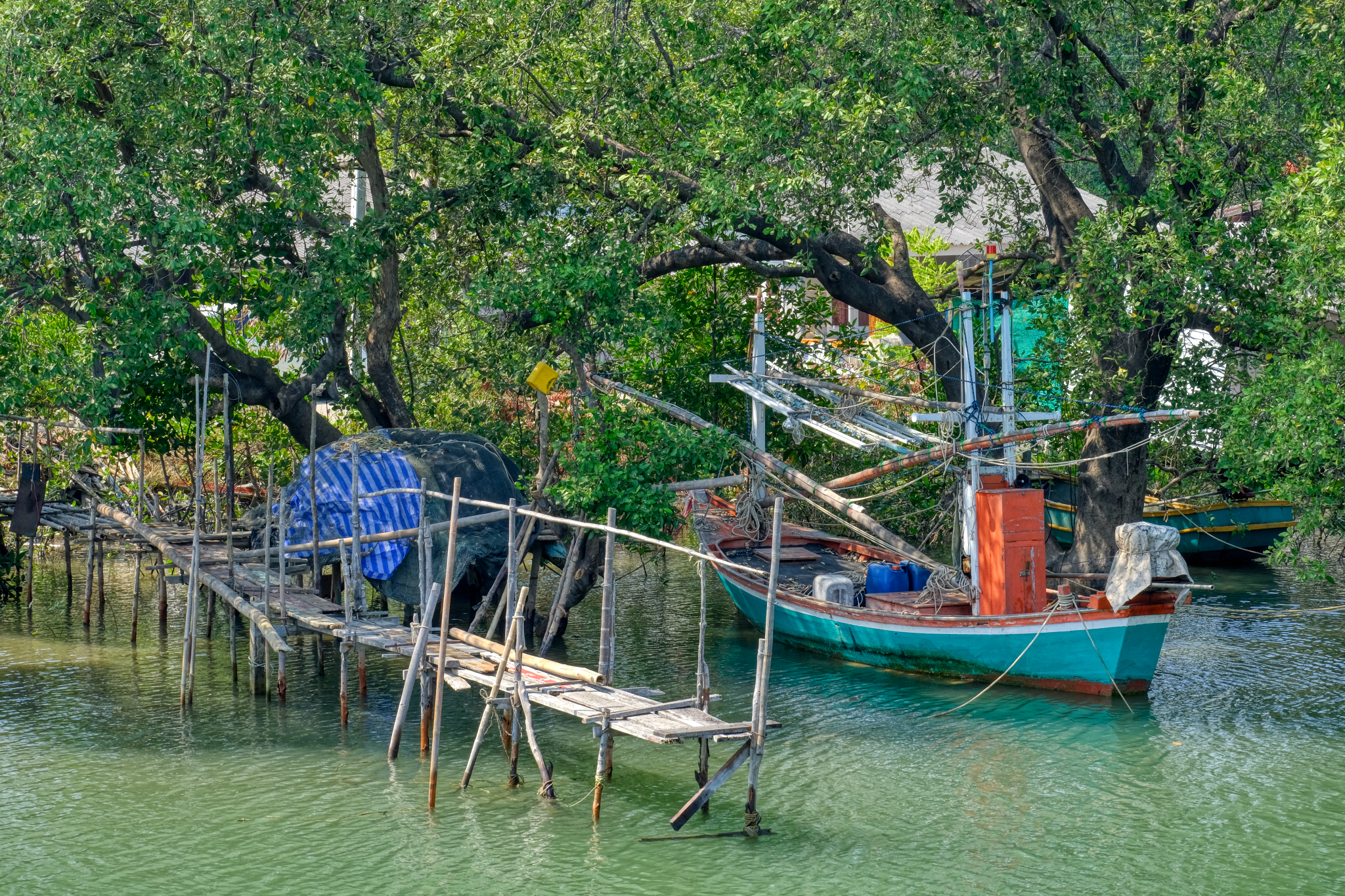 We walked along the road near the fishing port and came across a picturesque little slough.
We walked along the road near the fishing port and came across a picturesque little slough.
 Life along the slough.
Life along the slough.
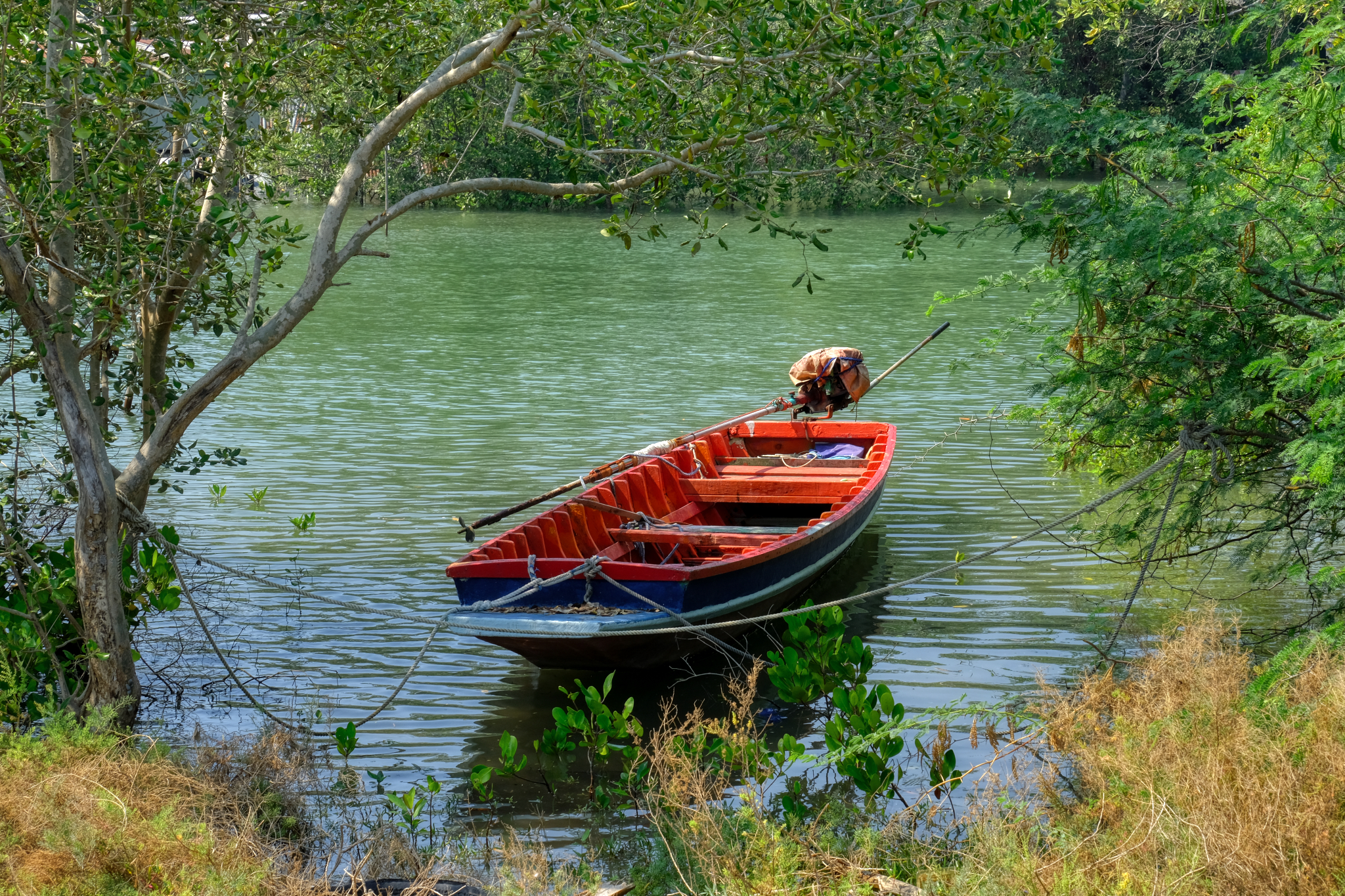 Picturesque . . . indeed!
Picturesque . . . indeed!
---------------------------------------------------------
Happy New Year 2020 From Hua Hin Thailand!!!
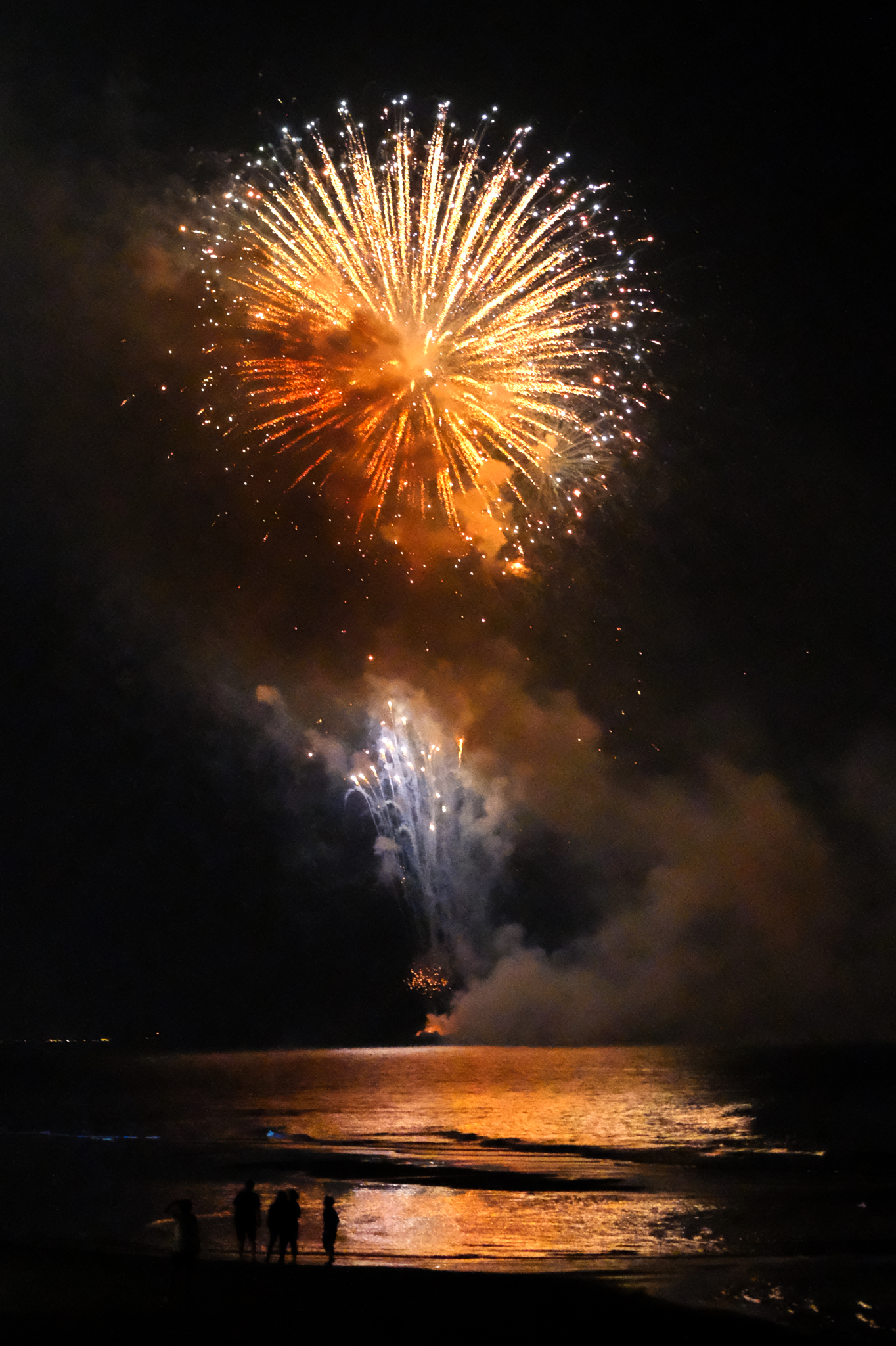 We went out to dinner at our usual favorite restaurant . . . . but we were not satisfied with the meal . . . it was a buffet, not the usual excellent food from the menu. Afterward we went to a friend's beach house . . . then out on to the beach for the BIG fireworks display.
We went out to dinner at our usual favorite restaurant . . . . but we were not satisfied with the meal . . . it was a buffet, not the usual excellent food from the menu. Afterward we went to a friend's beach house . . . then out on to the beach for the BIG fireworks display.
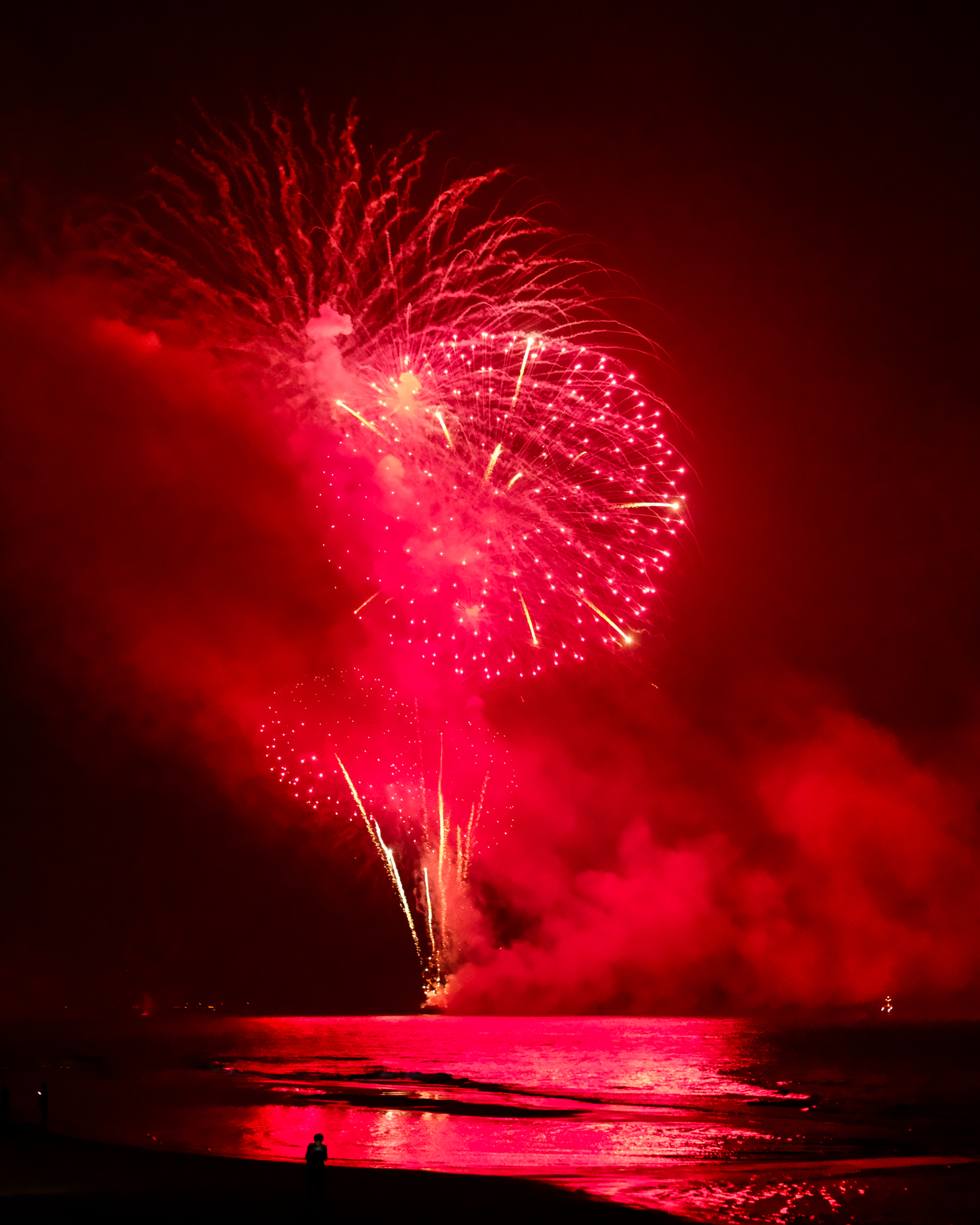 Down along the beach . . . fantastic fireworks display for 20-25 minutes.
Down along the beach . . . fantastic fireworks display for 20-25 minutes.
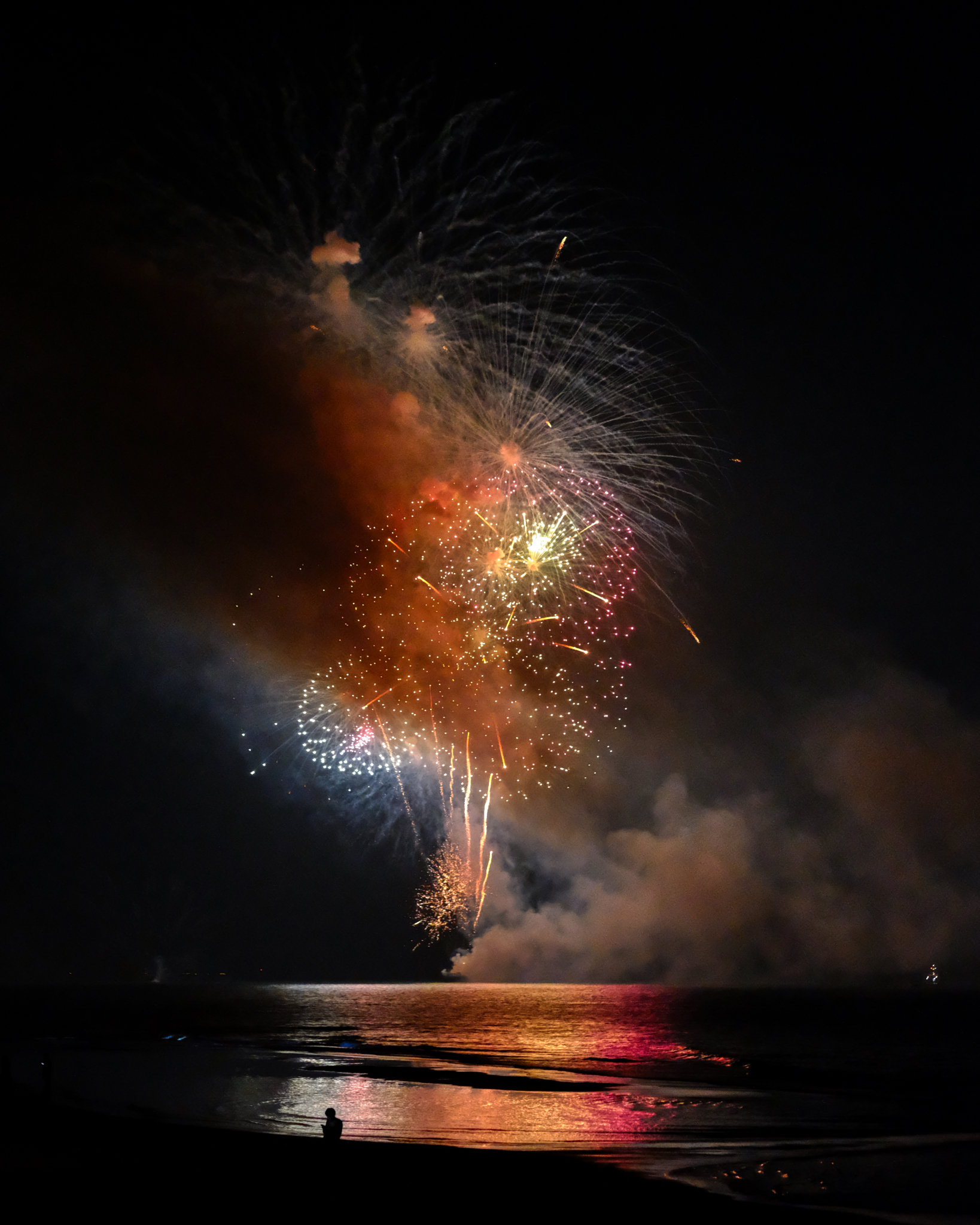 Fireworks across the bay . . .
Fireworks across the bay . . .
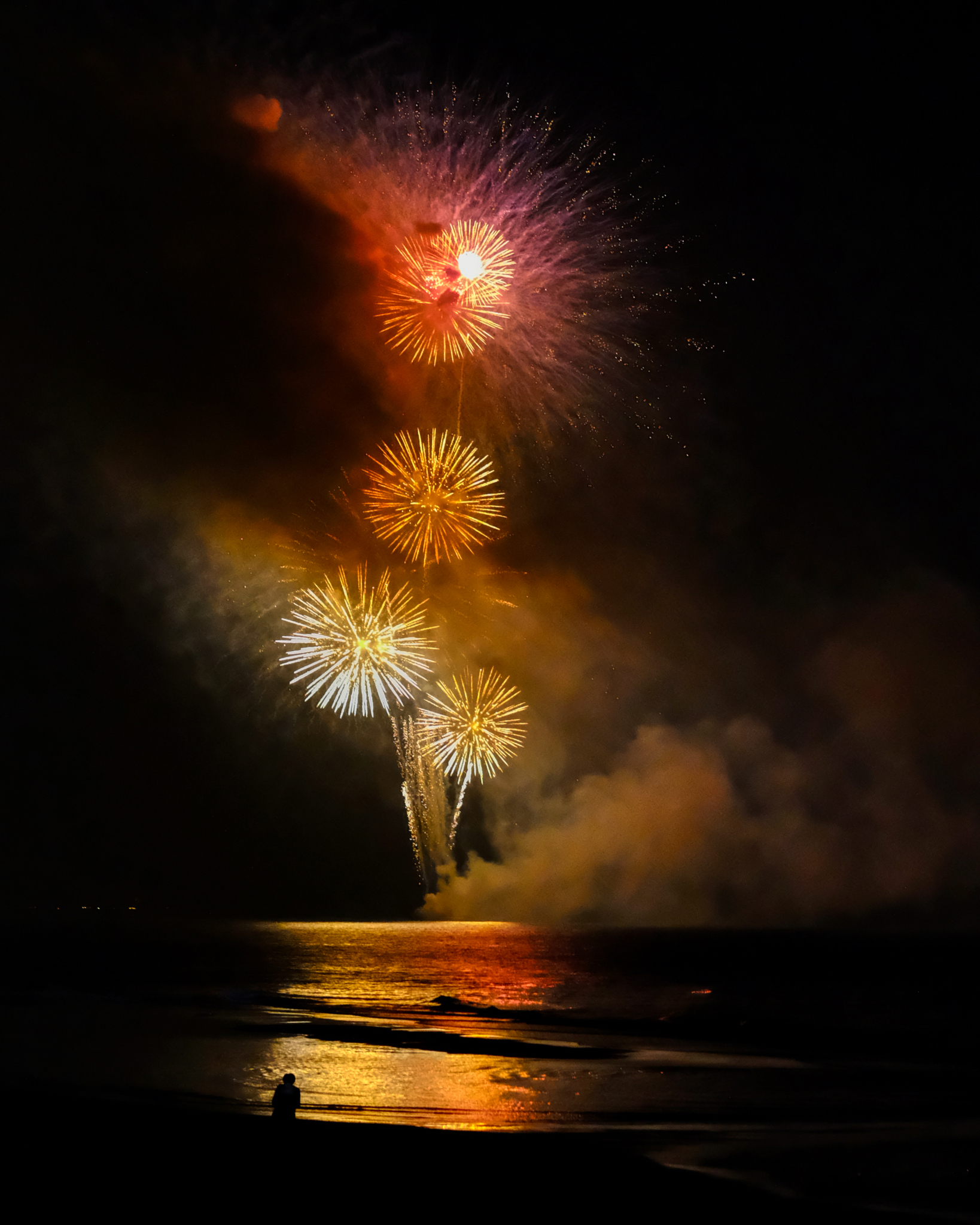 Once I figured out my camera settings . . .
Once I figured out my camera settings . . .
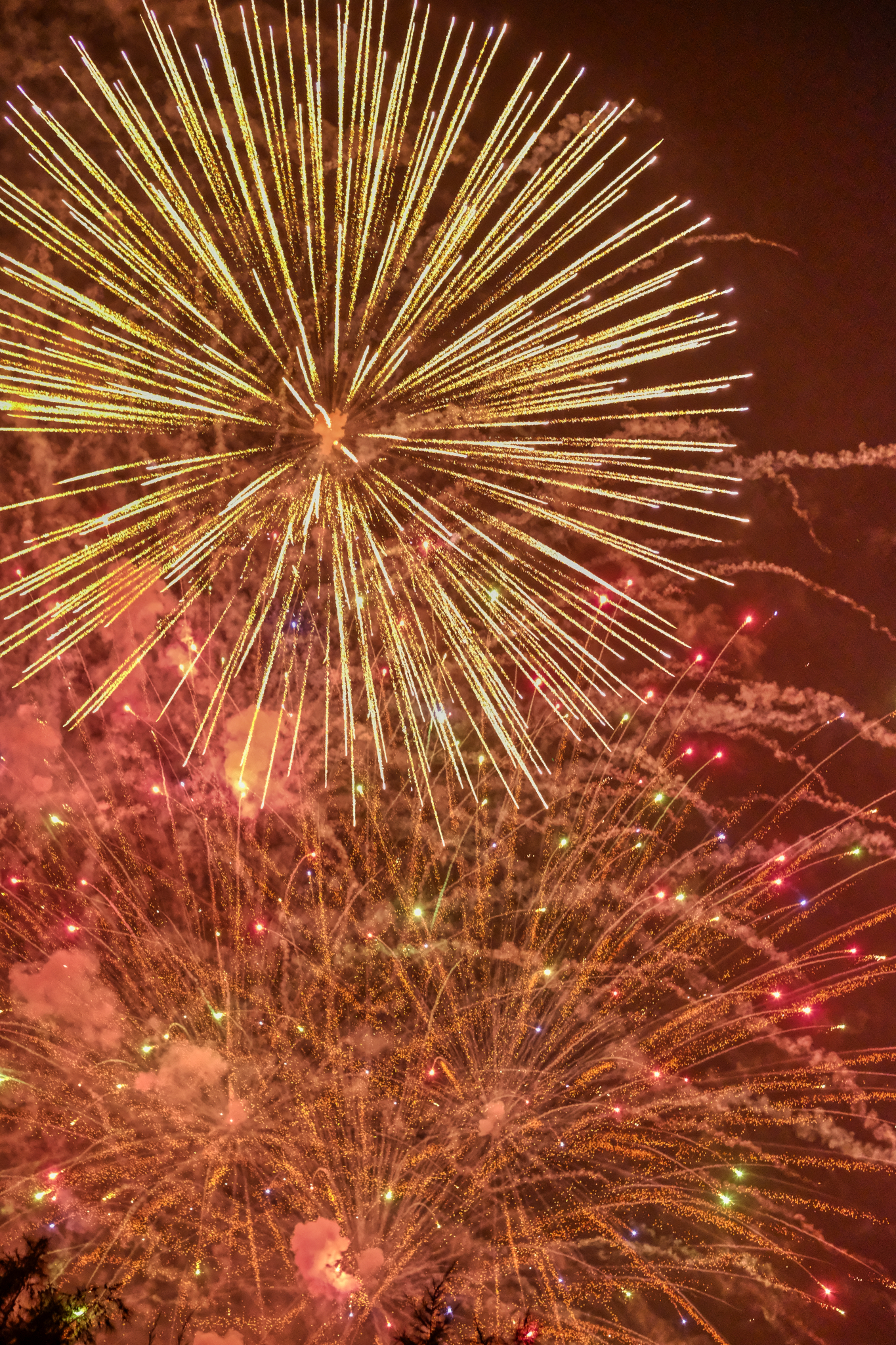 Right overhead!
Right overhead!
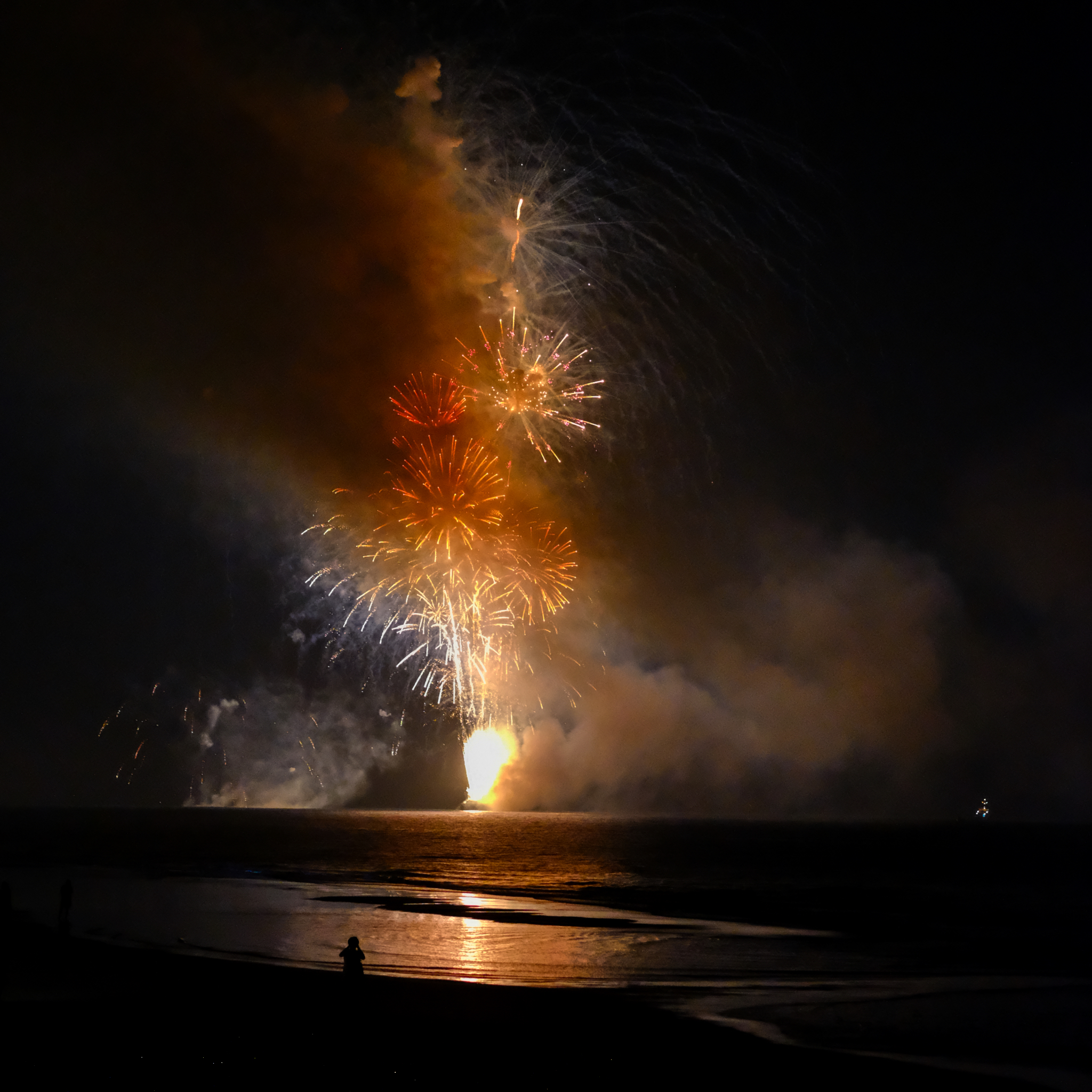 I hope you all had a New Years' Eve as colorful and interesting as I did!
I hope you all had a New Years' Eve as colorful and interesting as I did!
YES! All in a day! All within 20 miles!
A New Years Eve Ramble Near Hua Hin, Thailand
 Friday, March 20, 2020 at 2:05PM
Friday, March 20, 2020 at 2:05PM 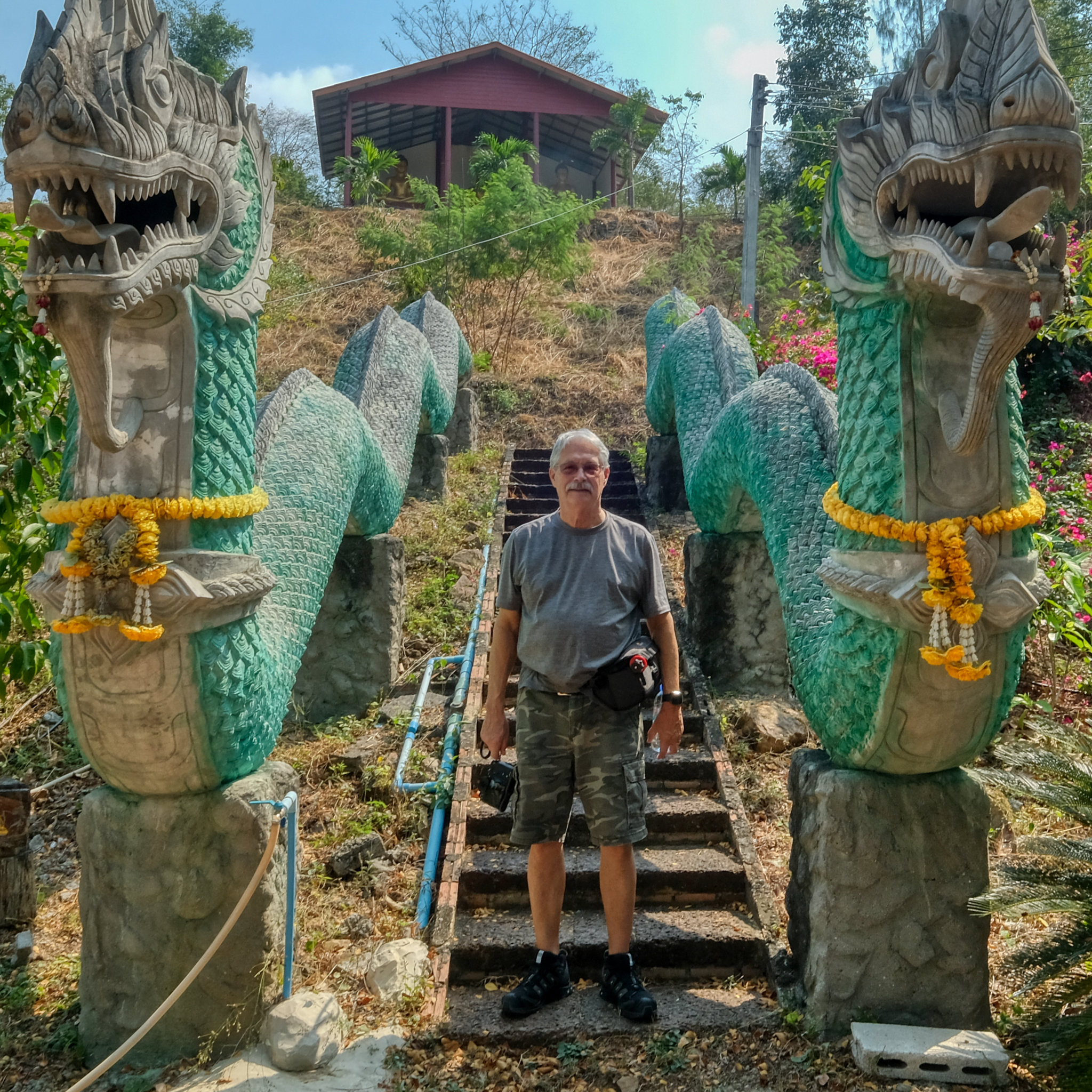 My visiting friend (of 45 years) on the verge of a long climb!
My visiting friend (of 45 years) on the verge of a long climb!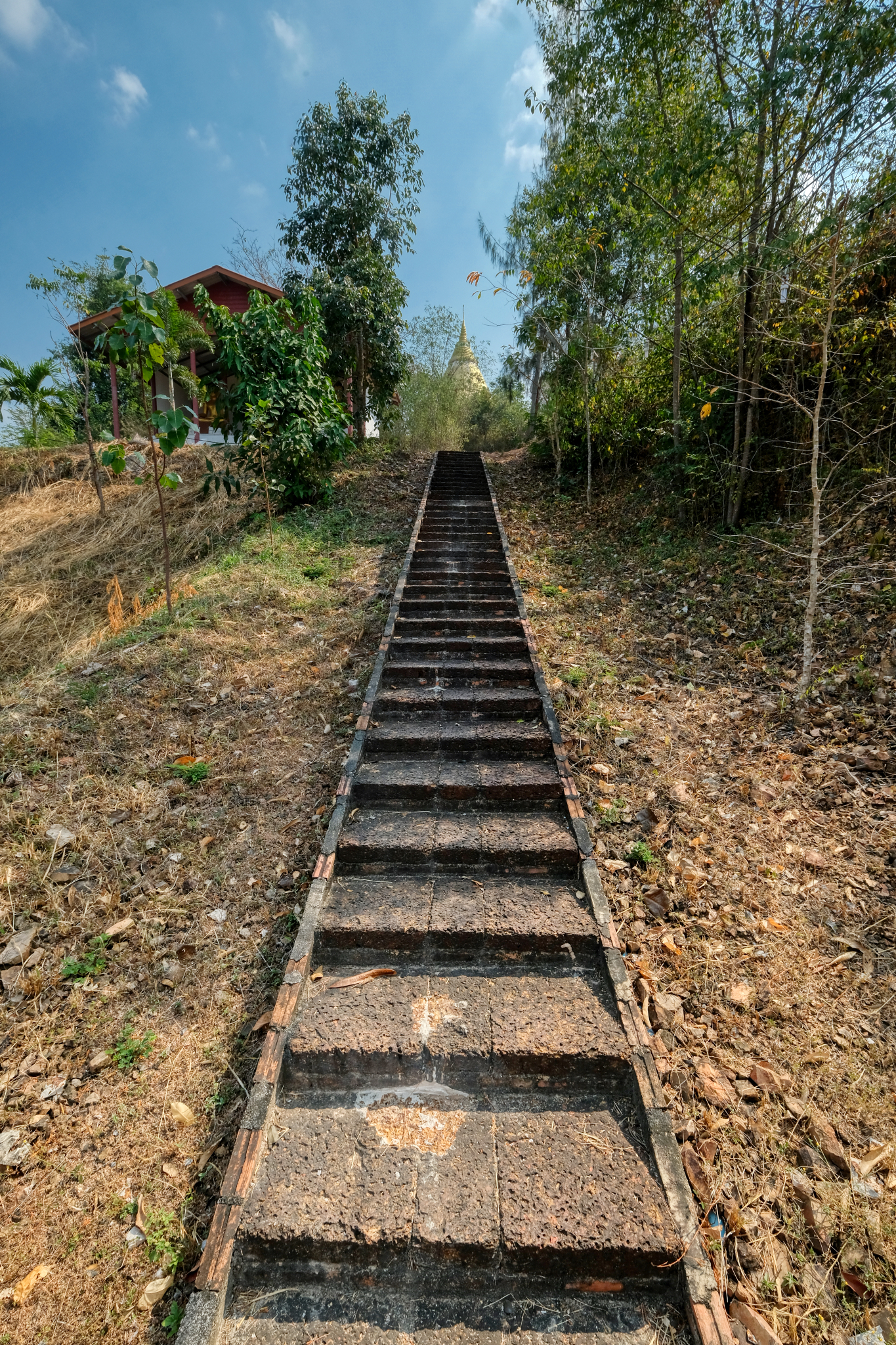 A long way up to the chedi.
A long way up to the chedi. 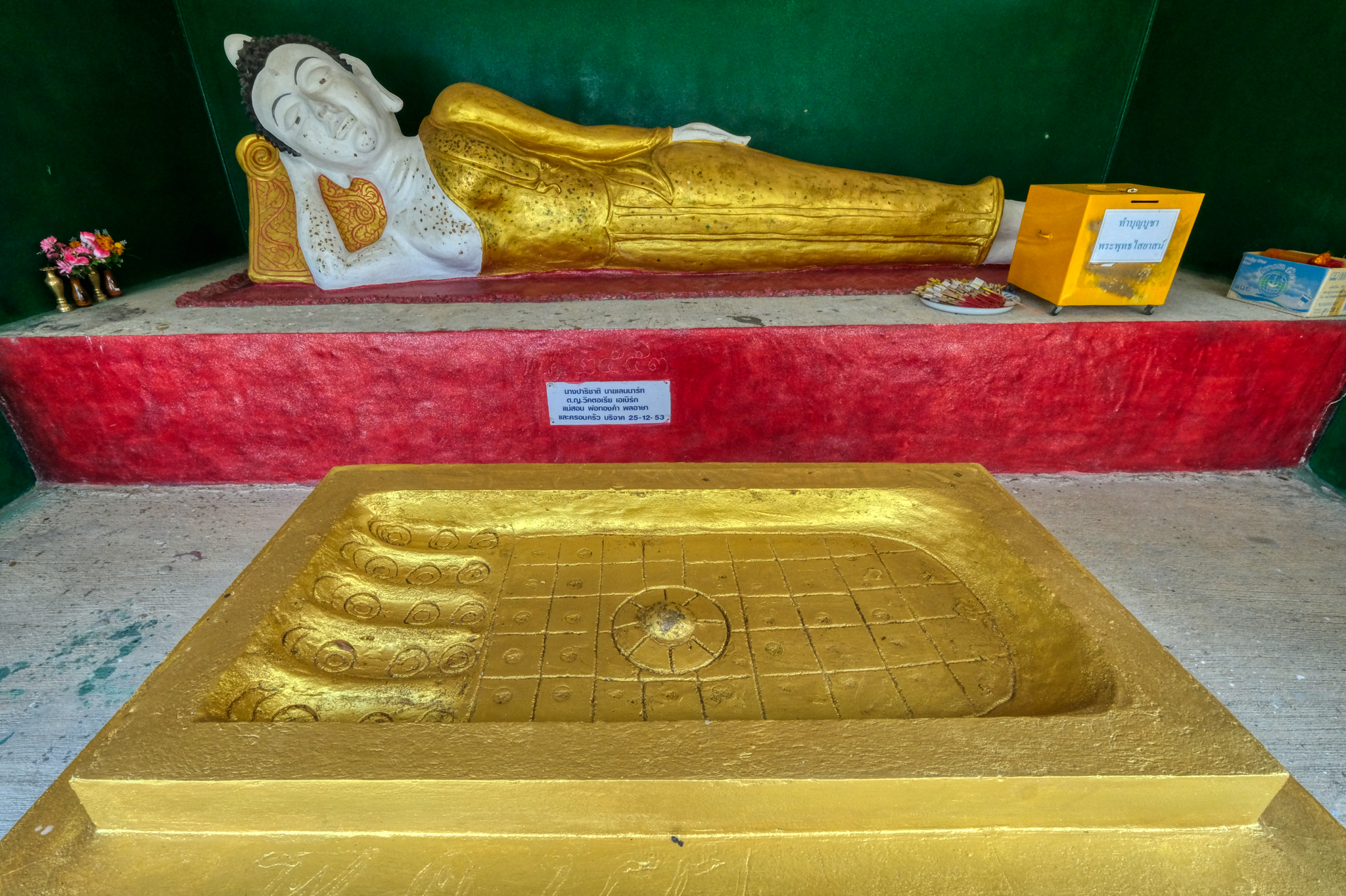 A beautiful shrine with a reclining Buddha on the way up . . .
A beautiful shrine with a reclining Buddha on the way up . . . 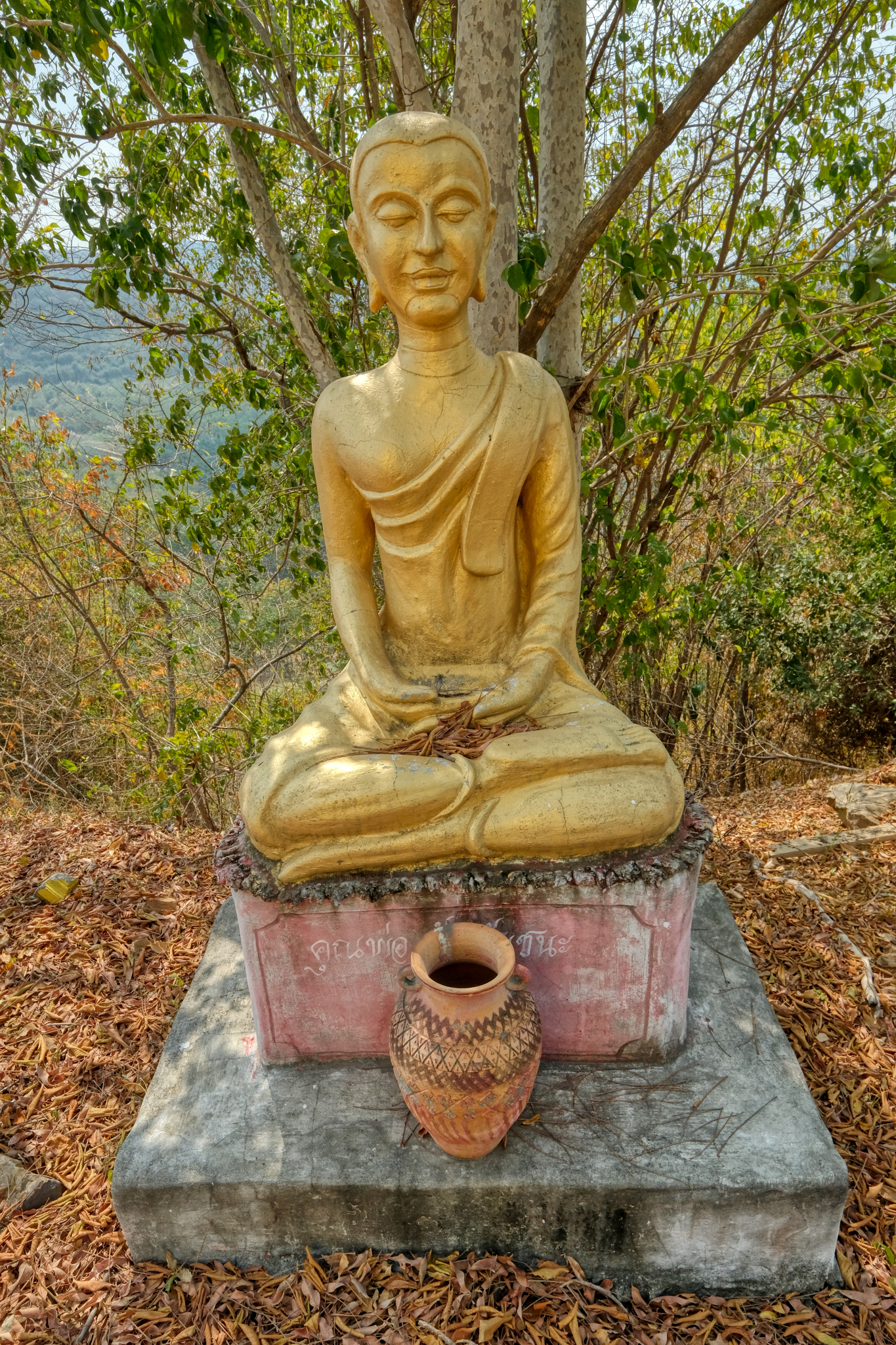 This 'naive art' Buddha image was very heartwarming.
This 'naive art' Buddha image was very heartwarming.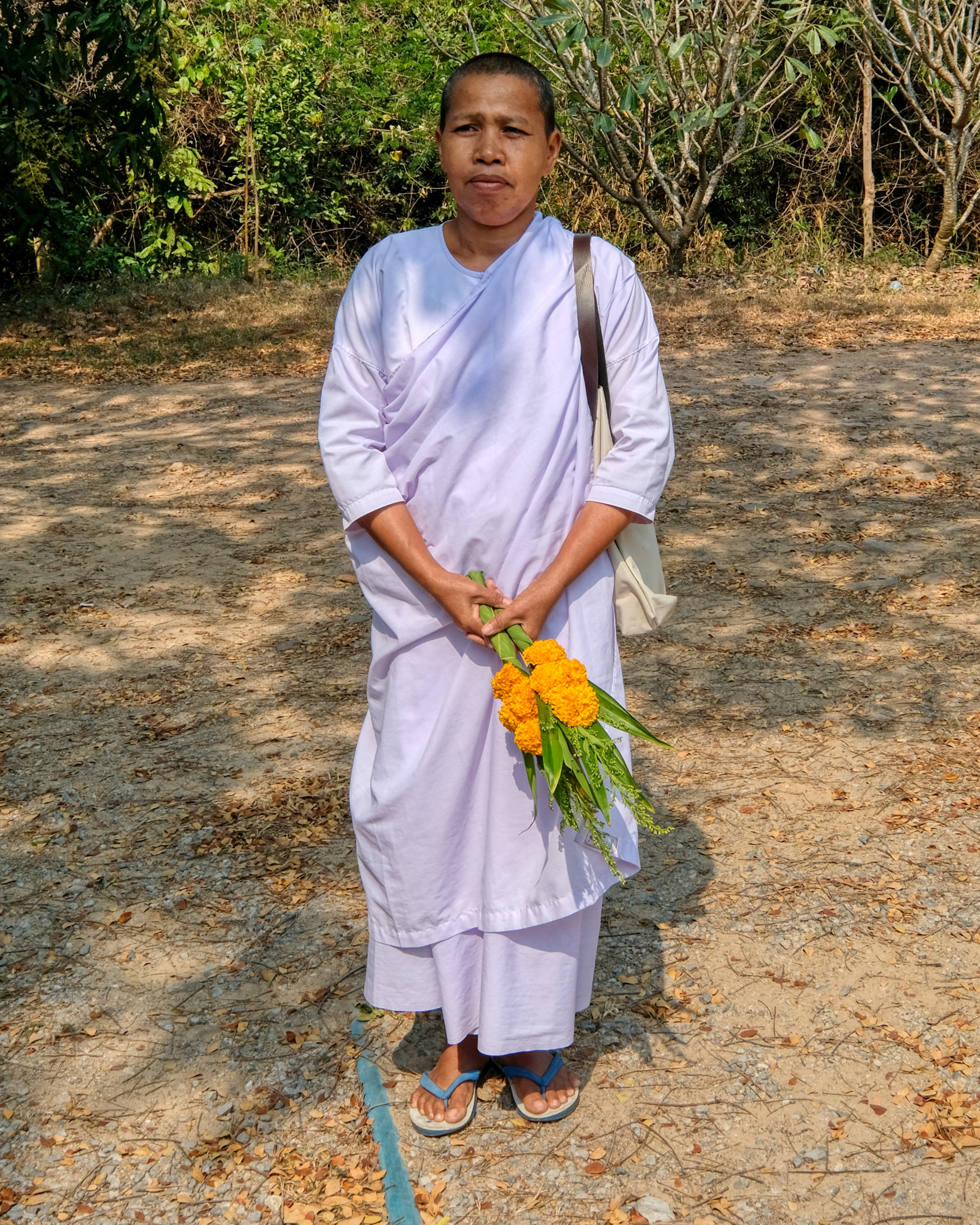 This Buddhist 'nun' followed us around for the afternoon. She is a kind of security guard. Good idea . . . there are some very beautiful and rare Buddha statues in the golden chedi (known as a 'stupa' in other Buddhist trditions and countries).
This Buddhist 'nun' followed us around for the afternoon. She is a kind of security guard. Good idea . . . there are some very beautiful and rare Buddha statues in the golden chedi (known as a 'stupa' in other Buddhist trditions and countries).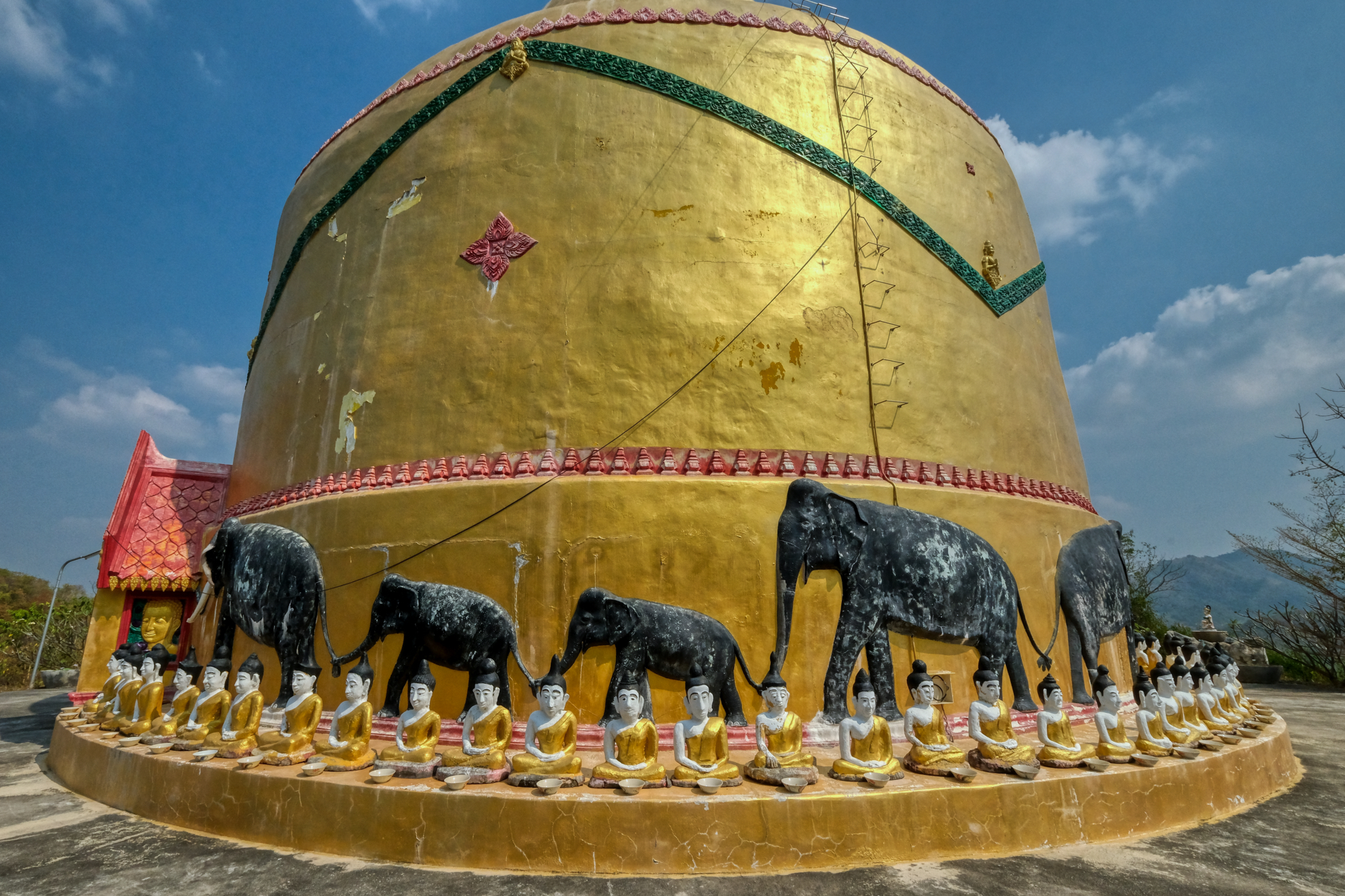 This is what I had taken my friend to see . . . and for me, to see again.
This is what I had taken my friend to see . . . and for me, to see again.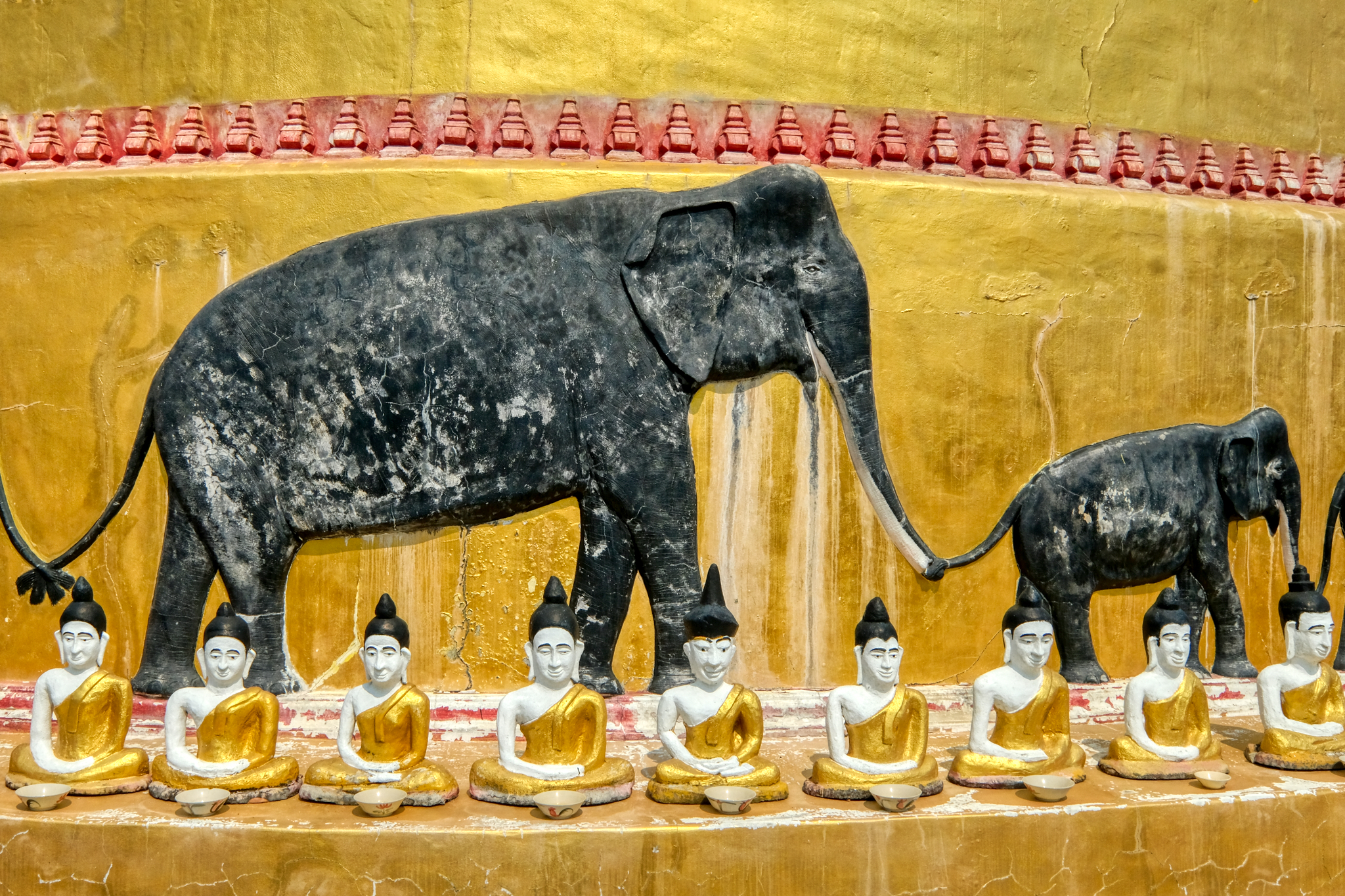 More fascinating, and individualistic, naive art Buddha images. As interesting as the outside of the chedi was, it is the inside that brought me back!
More fascinating, and individualistic, naive art Buddha images. As interesting as the outside of the chedi was, it is the inside that brought me back!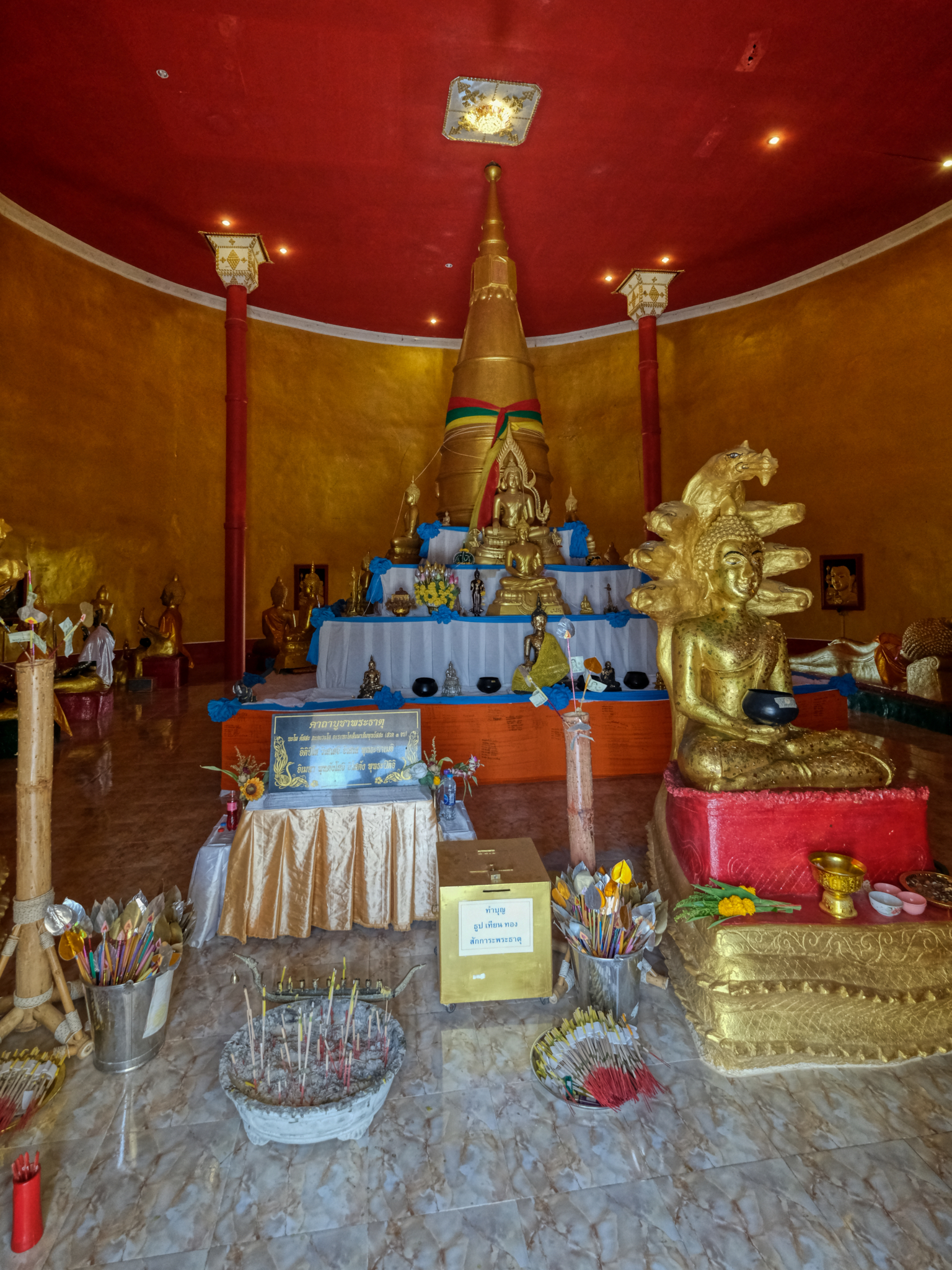 Looking into the chedi interior from the front door. WOW!
Looking into the chedi interior from the front door. WOW!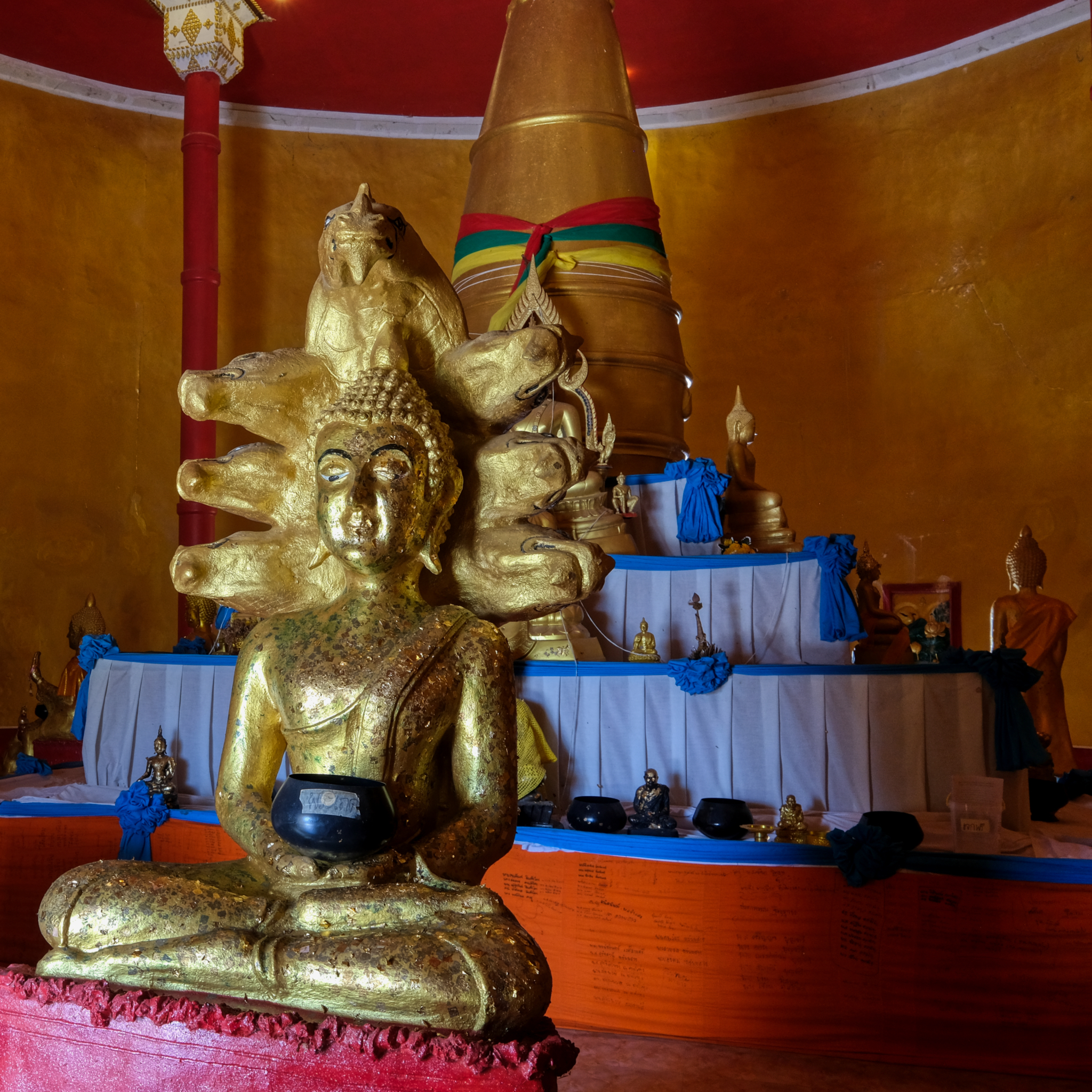 The light was so scrumptious, the images so serene . . .
The light was so scrumptious, the images so serene . . .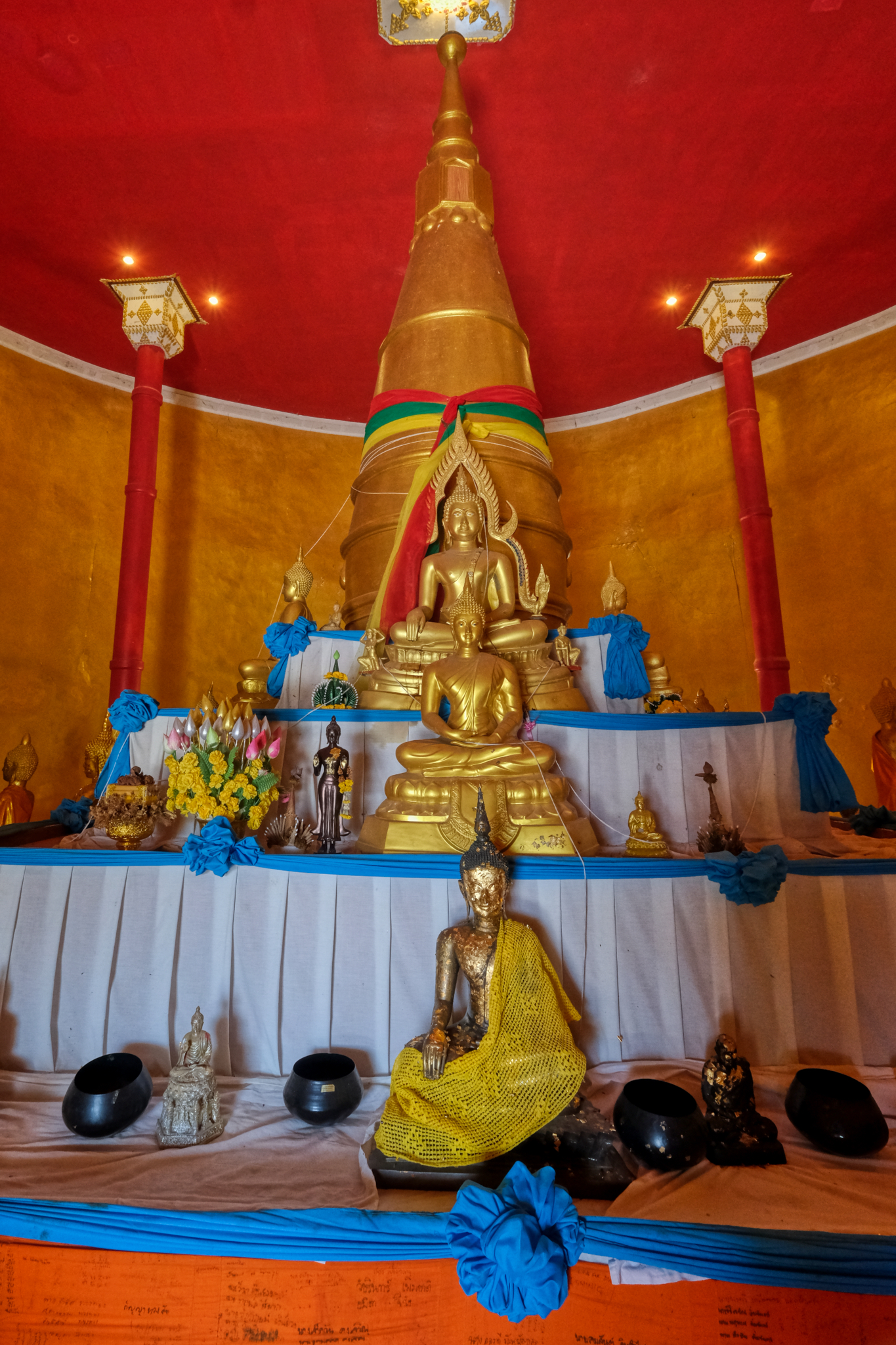 The front of the entry altar. The big interior in its marvelously bright colors.
The front of the entry altar. The big interior in its marvelously bright colors.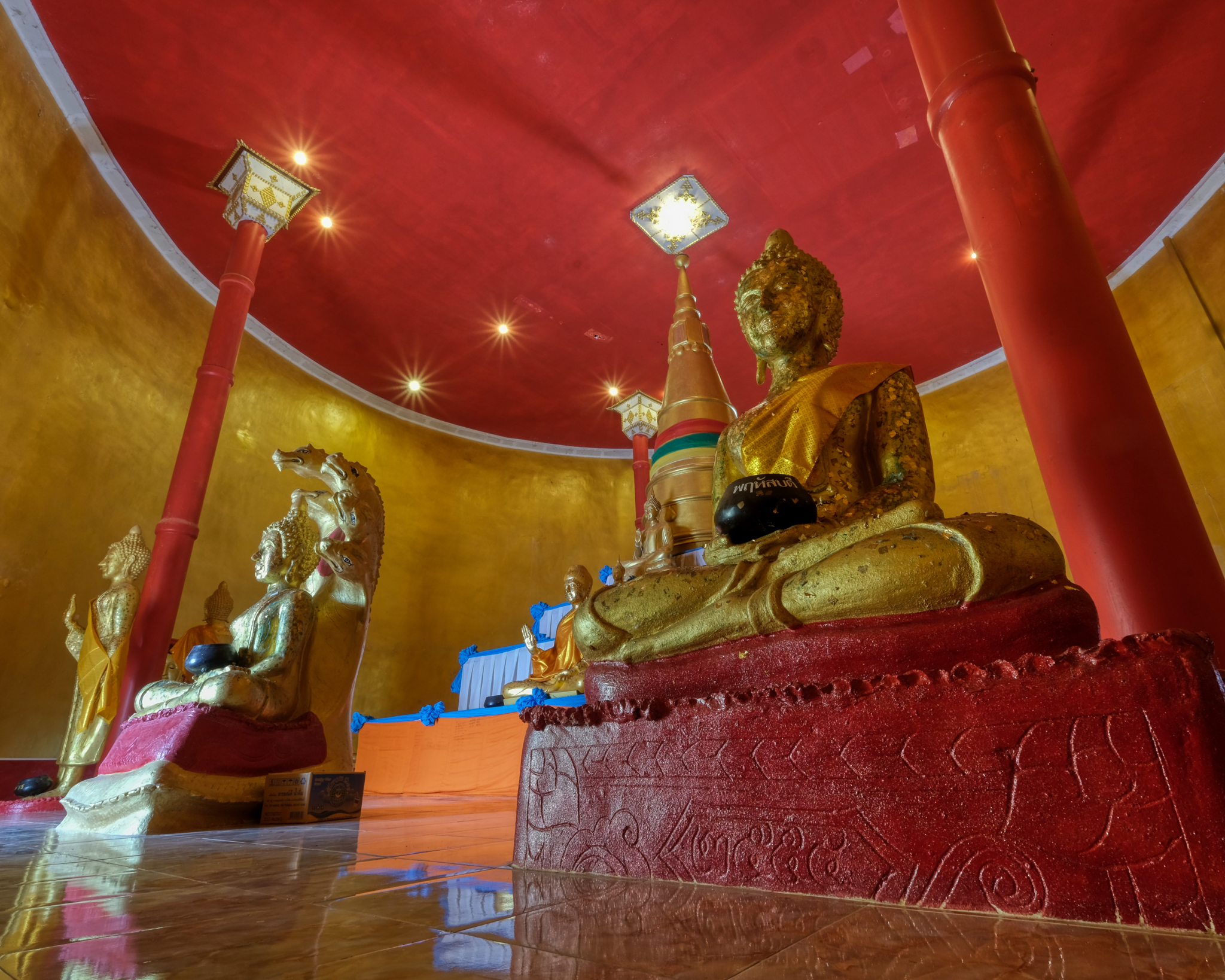 My camera on a small tripod . . . so many superb images to capture.
My camera on a small tripod . . . so many superb images to capture.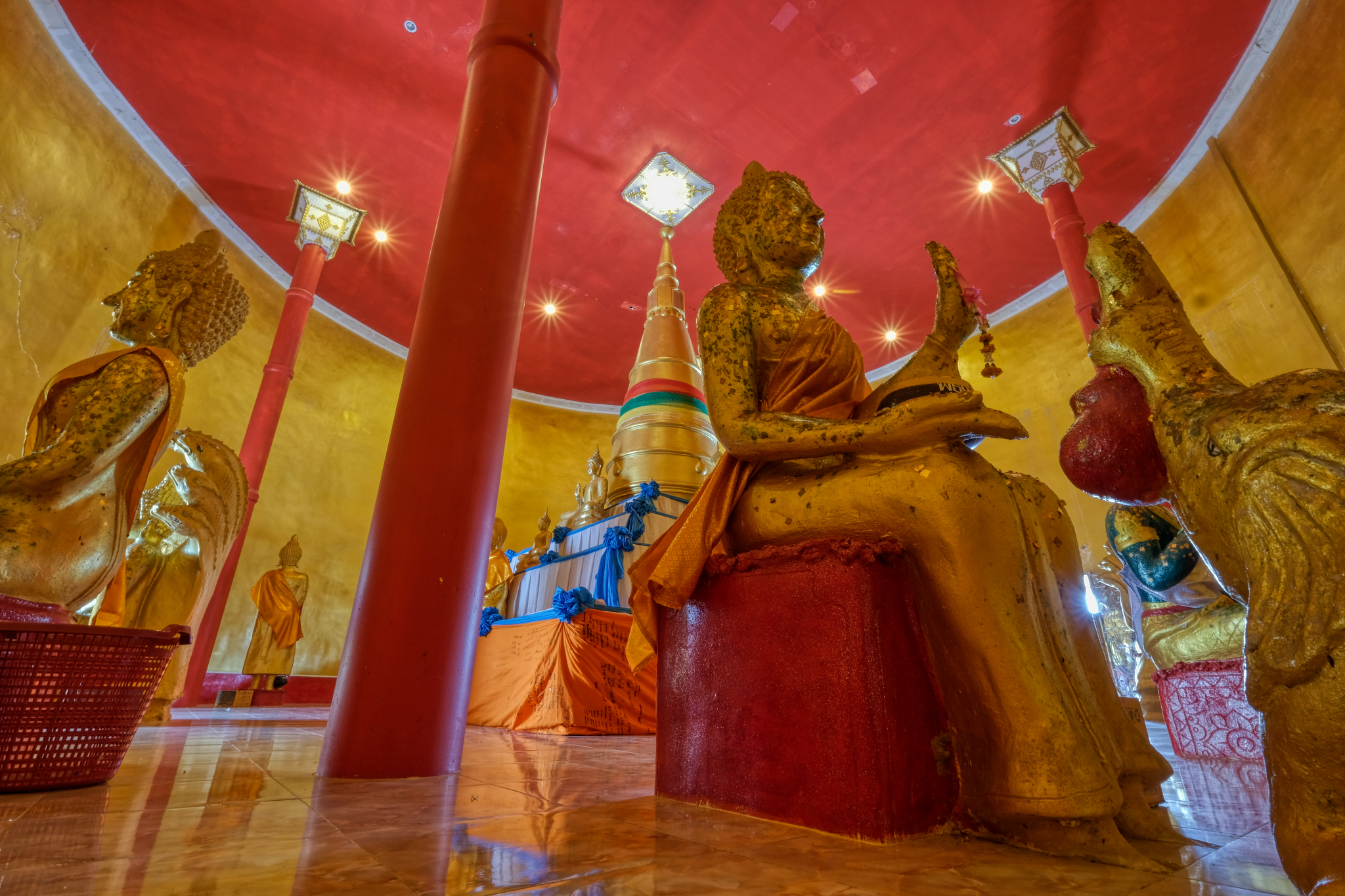
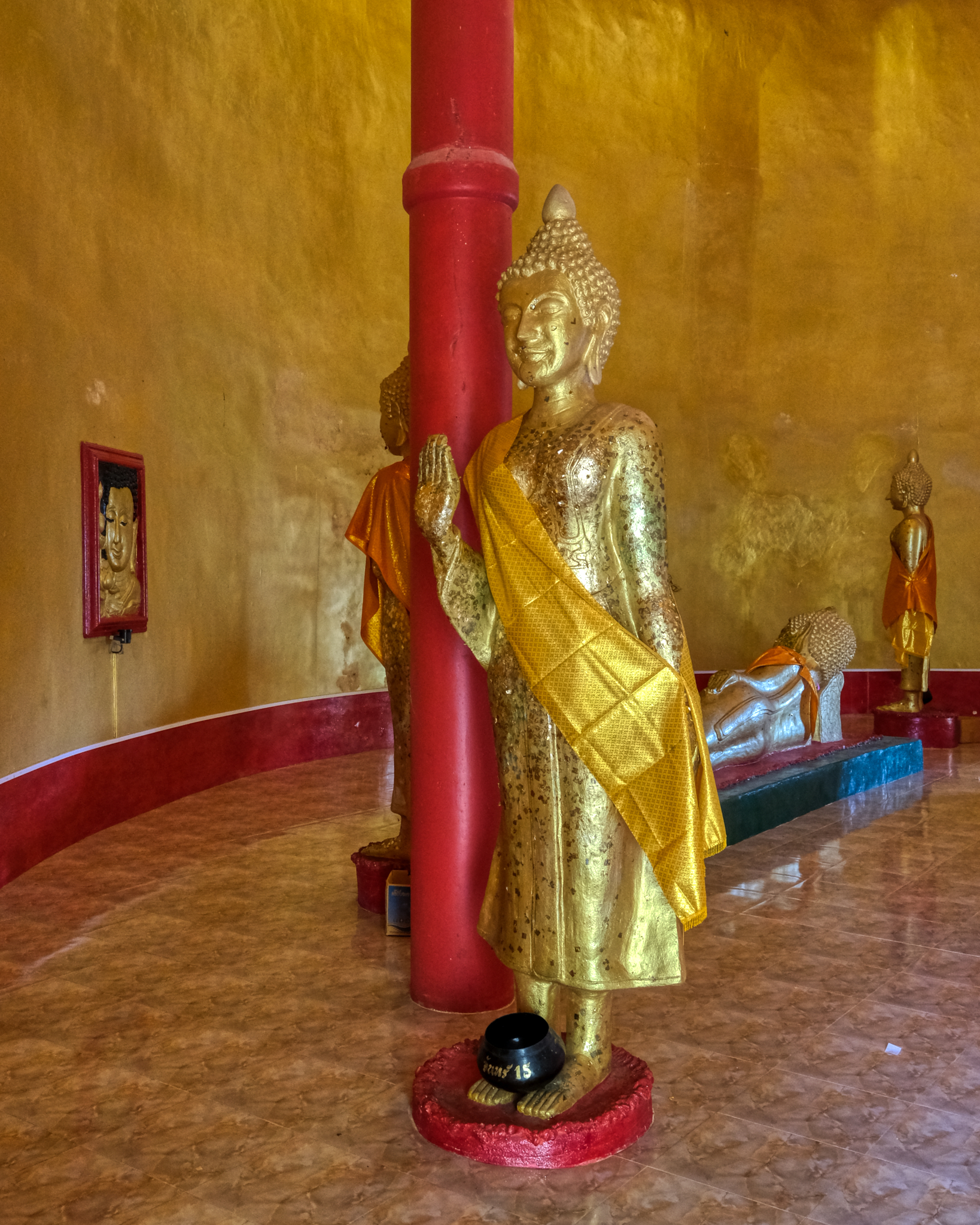 Holding Back The River of samsaric temptation.
Holding Back The River of samsaric temptation.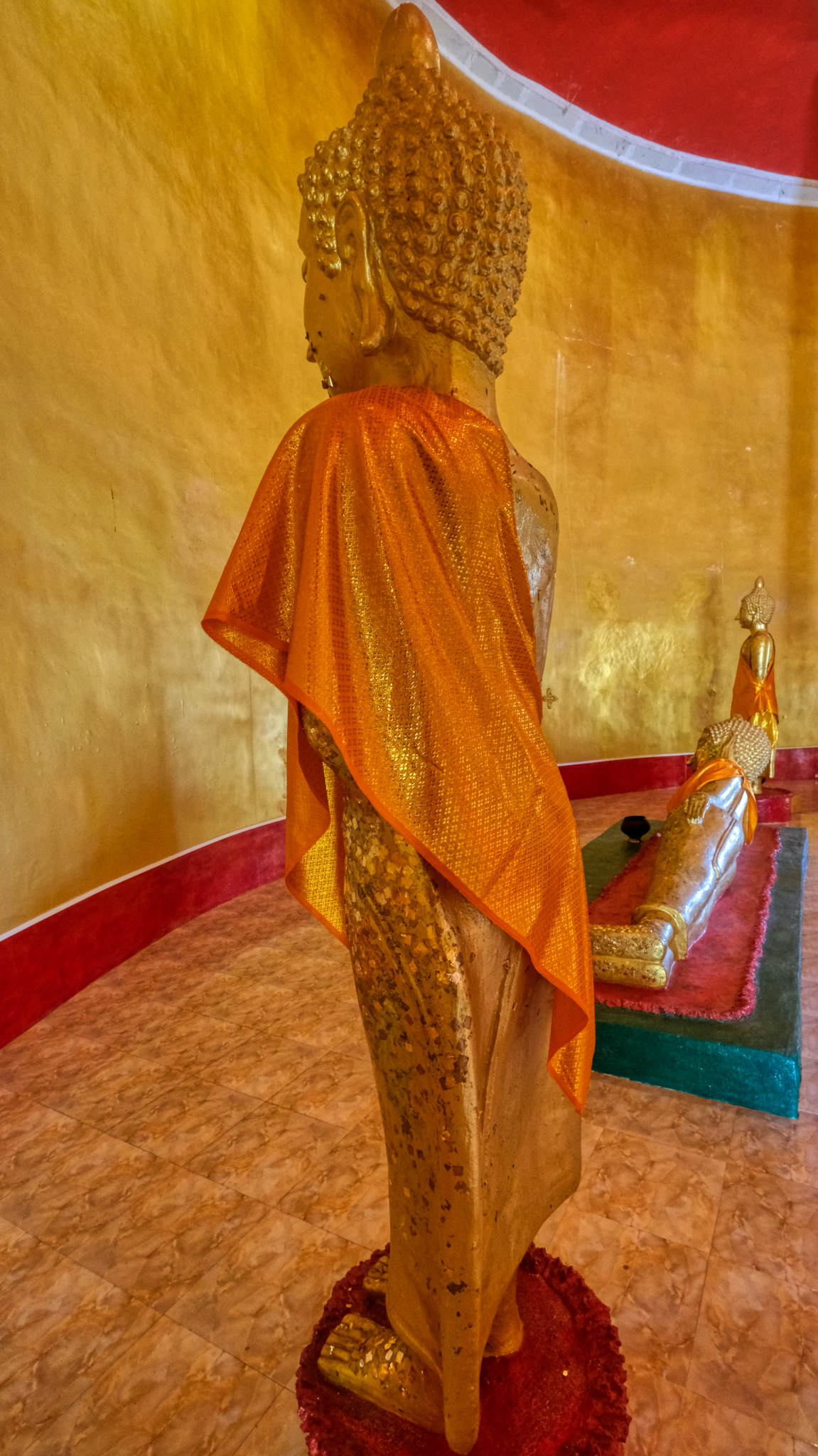 Beautiful spiritual space of Buddhanature.
Beautiful spiritual space of Buddhanature.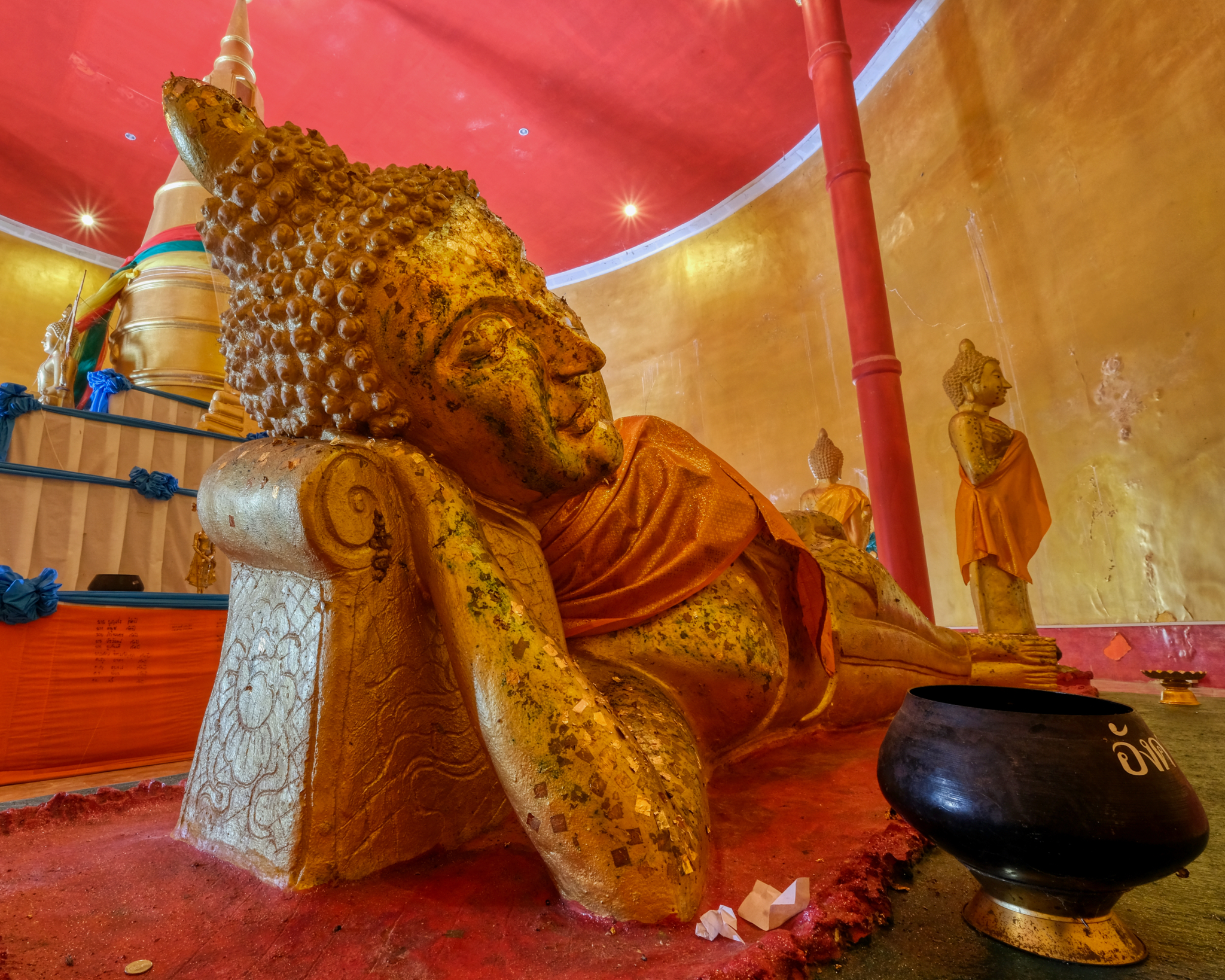 A Reclining Buddha . . . this posture represents the mahāparinabbāna: the Buddha's final state of enlightenment before his death!
A Reclining Buddha . . . this posture represents the mahāparinabbāna: the Buddha's final state of enlightenment before his death!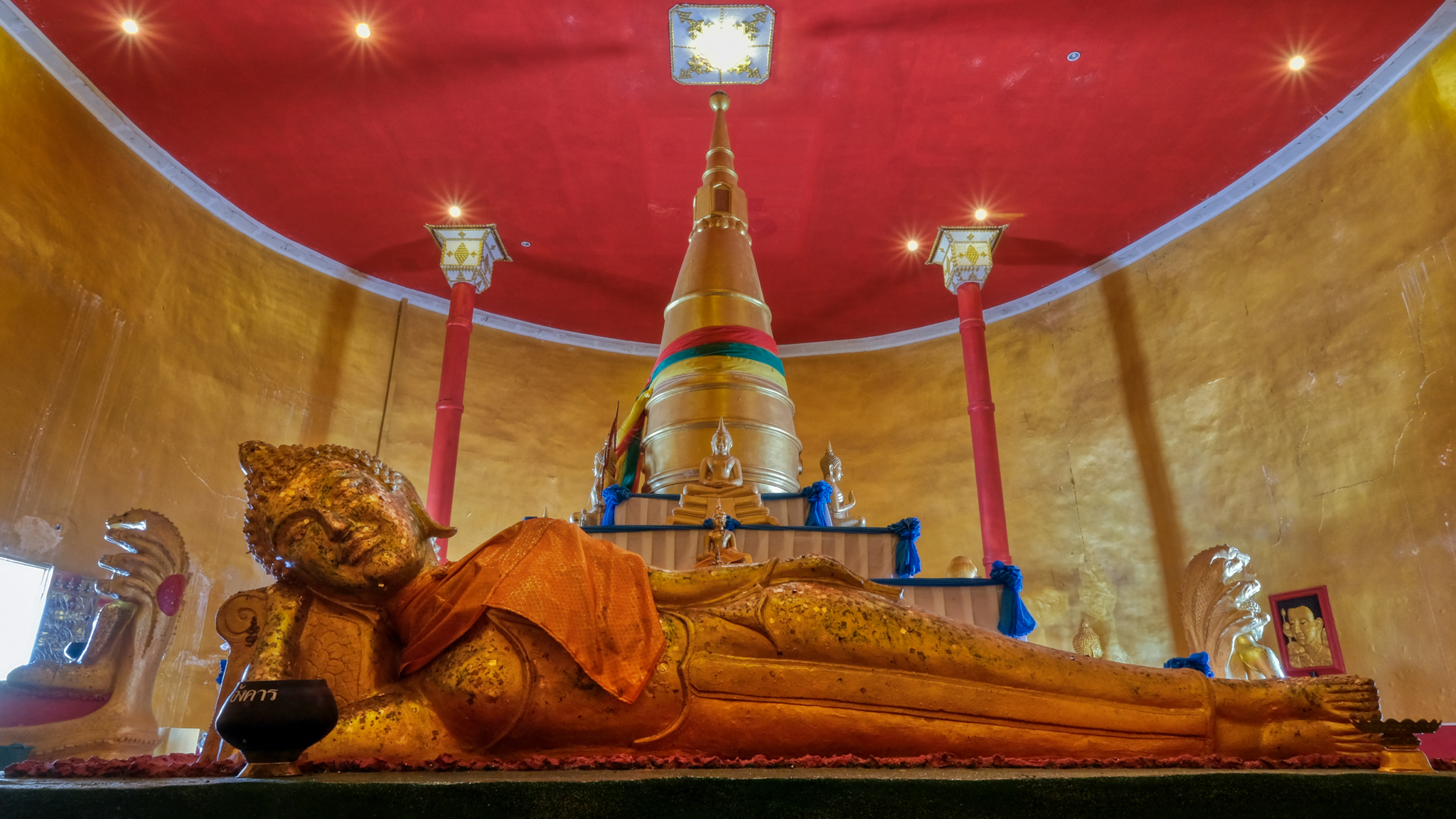 The last time I was in this chedi I did not have a lens wide enough to take this photo. I'm very glad I came back, and would have come back even without a camera. This chedi has become a favorite spiritual pilgrimage site for me.
The last time I was in this chedi I did not have a lens wide enough to take this photo. I'm very glad I came back, and would have come back even without a camera. This chedi has become a favorite spiritual pilgrimage site for me.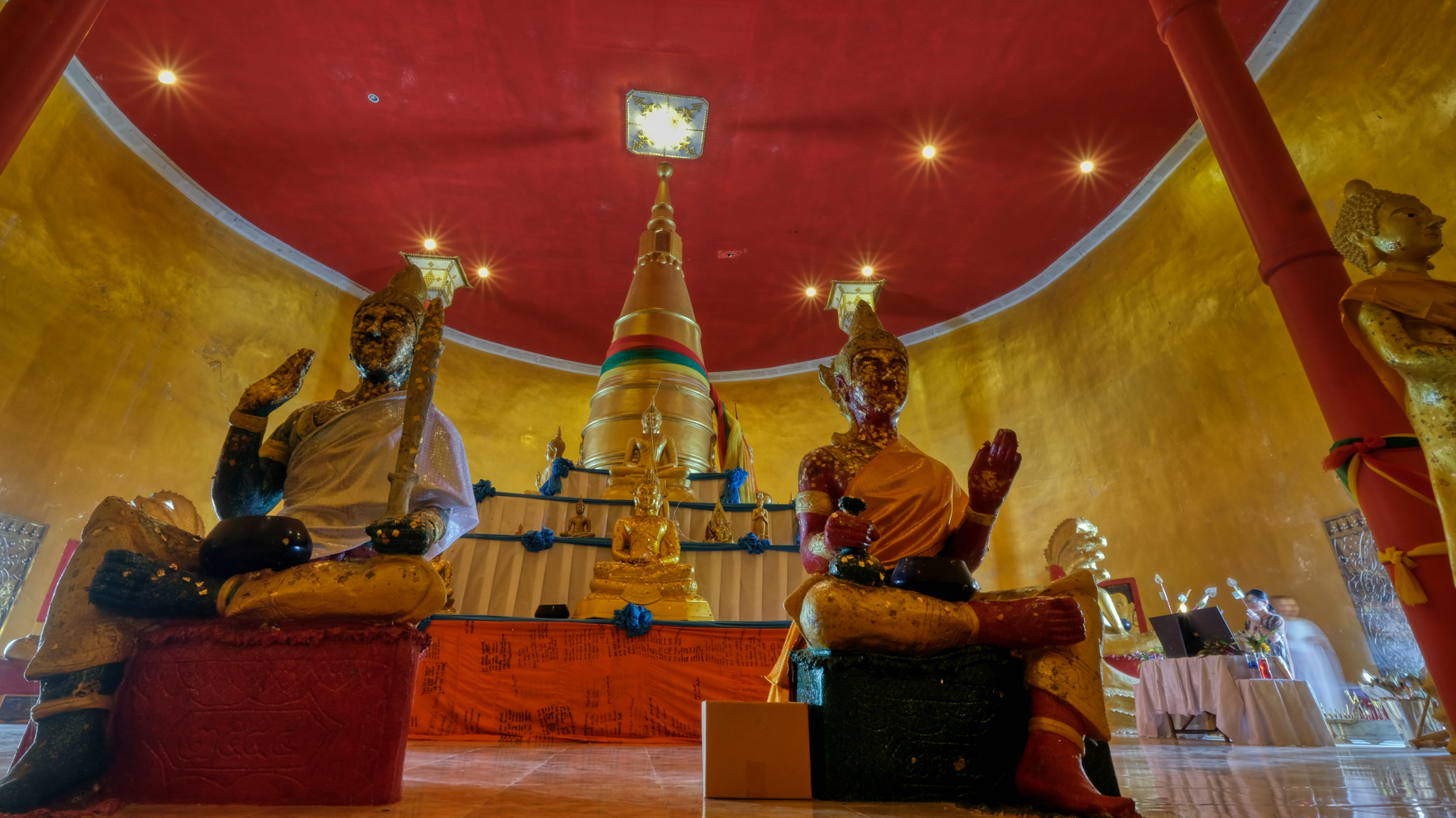 Each side of the central interior chedi presents a different compositional arrangement. Notice our nun and another pilgrim on the right.
Each side of the central interior chedi presents a different compositional arrangement. Notice our nun and another pilgrim on the right.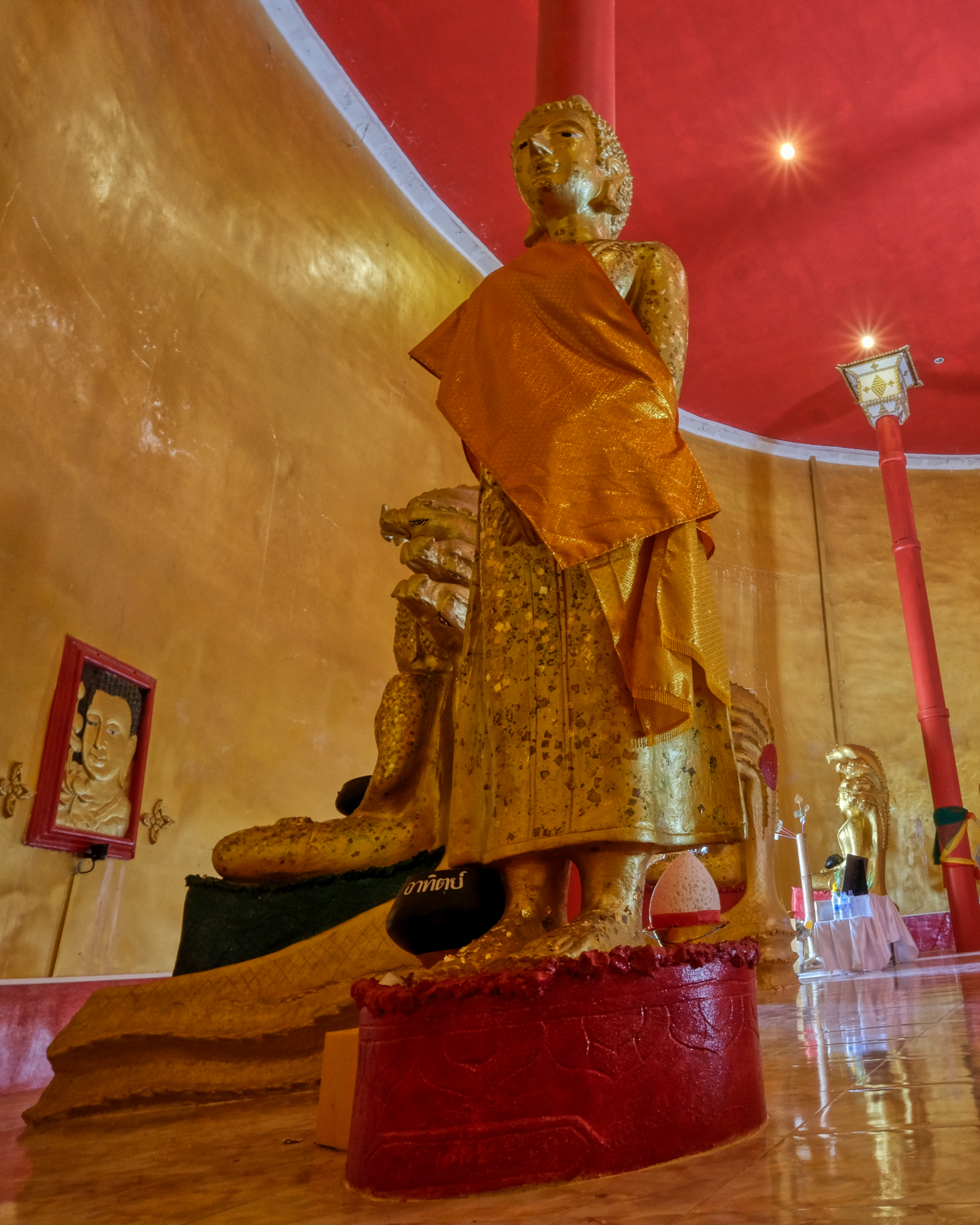 Move a few feet and see another striking composition . . .
Move a few feet and see another striking composition . . .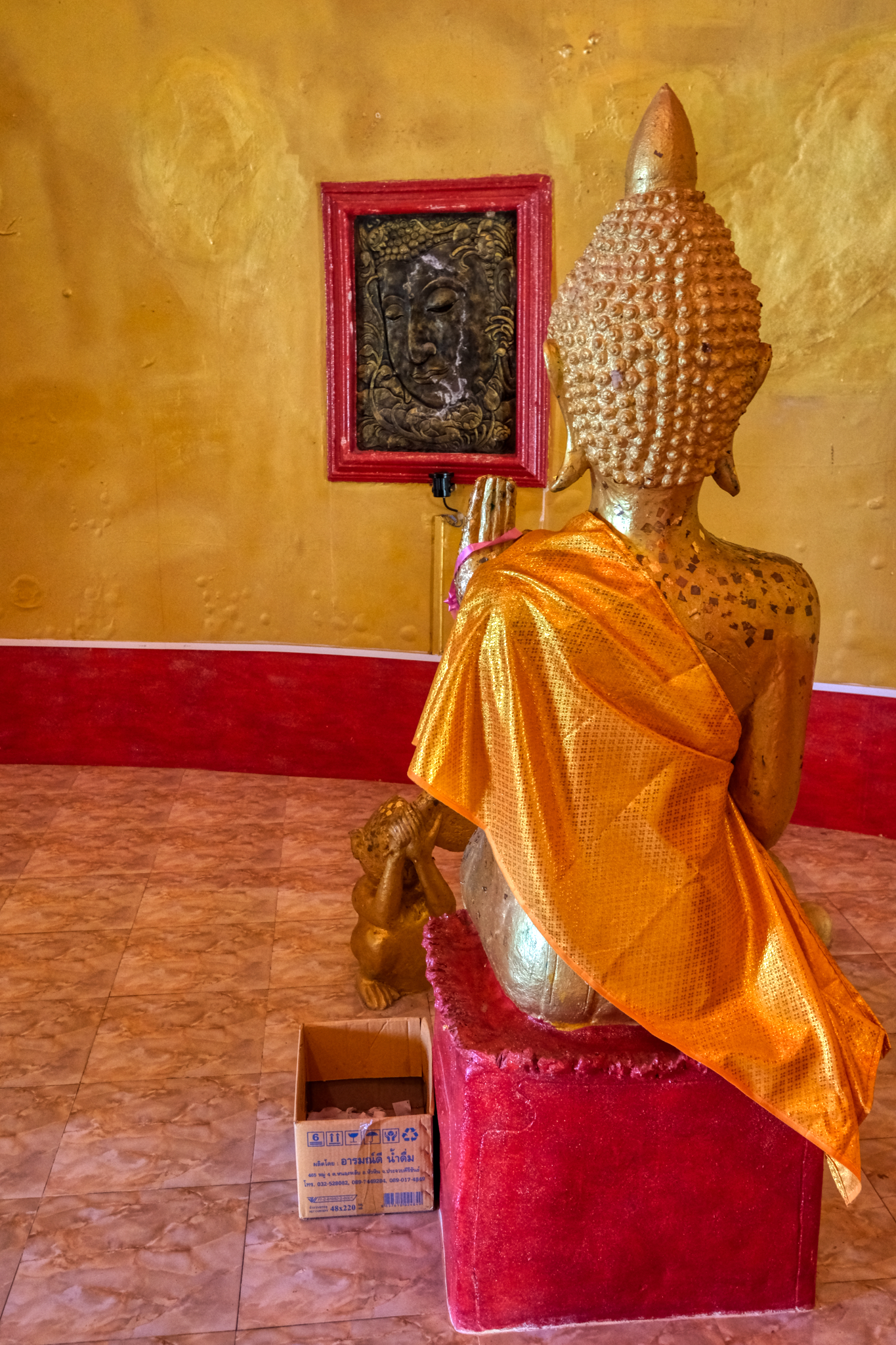 Not all of the statuary represents the Buddha. Some, like this one, are of bikkus, followers of the Buddha captured in a moment of listening to the dharma.
Not all of the statuary represents the Buddha. Some, like this one, are of bikkus, followers of the Buddha captured in a moment of listening to the dharma.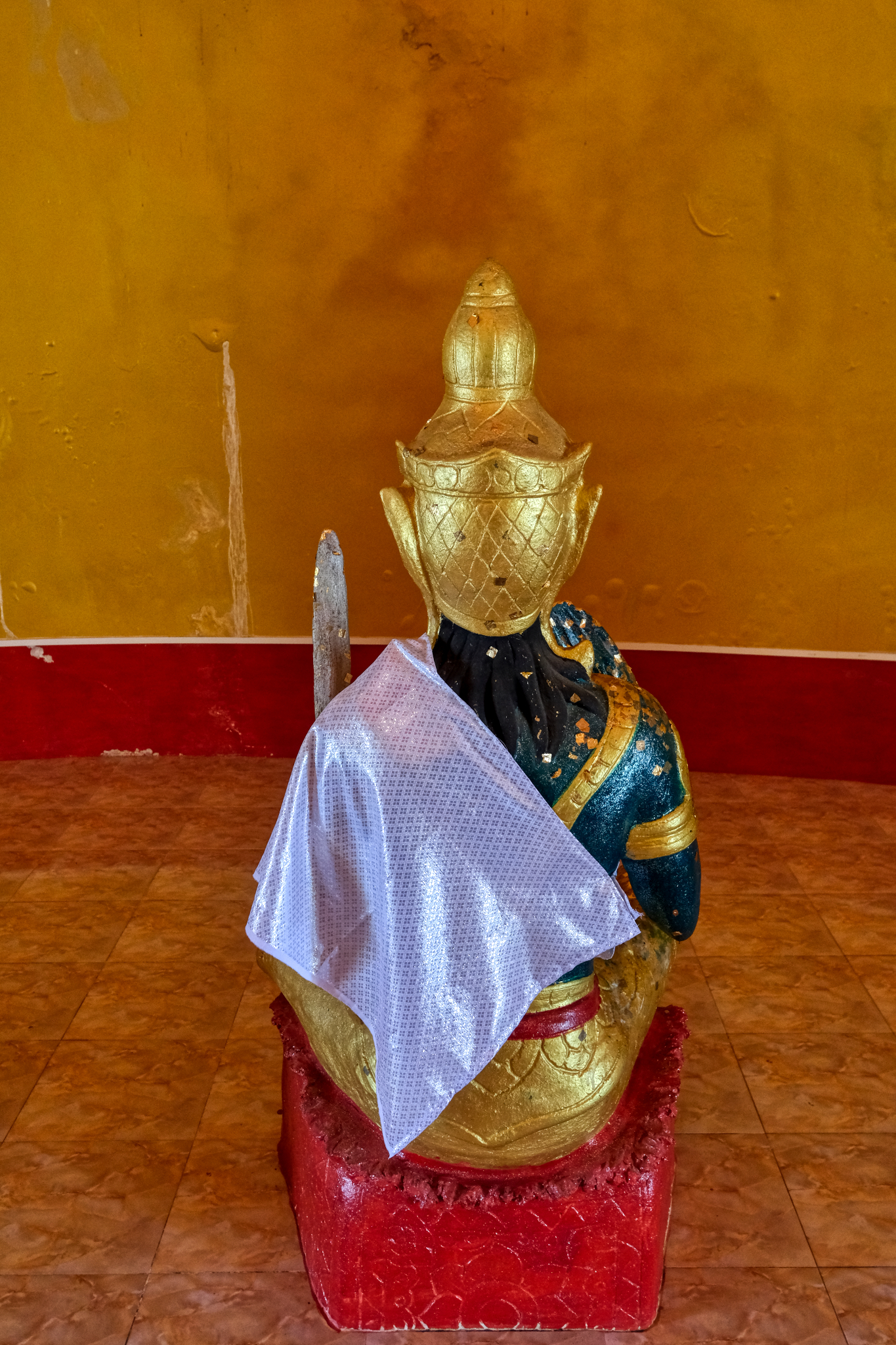 A bikku.
A bikku.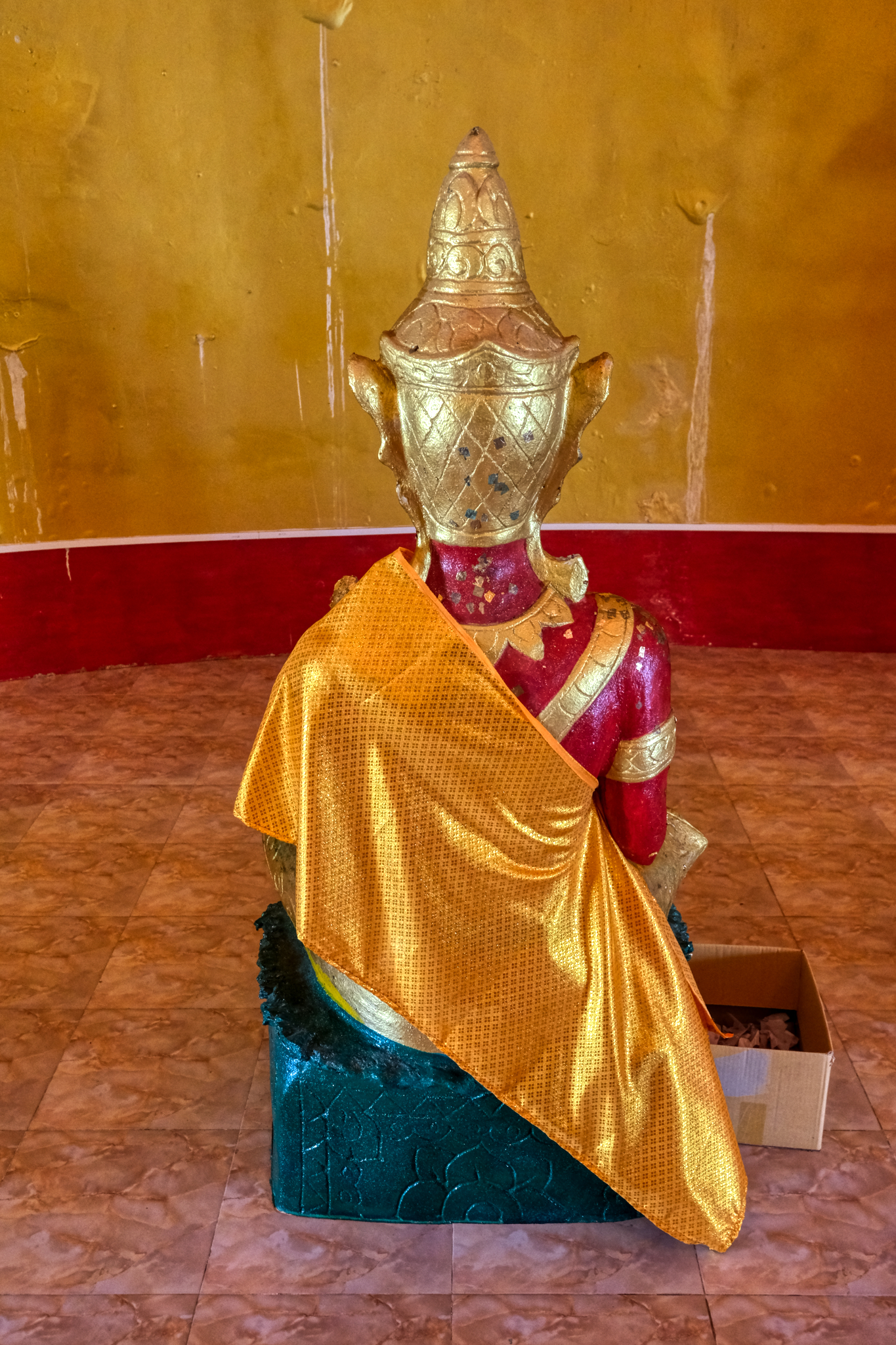 A bikku. The cardboard box is for the paper fold left over after a visitor has laid a piece of gold leaf on the statue in reverence.
A bikku. The cardboard box is for the paper fold left over after a visitor has laid a piece of gold leaf on the statue in reverence.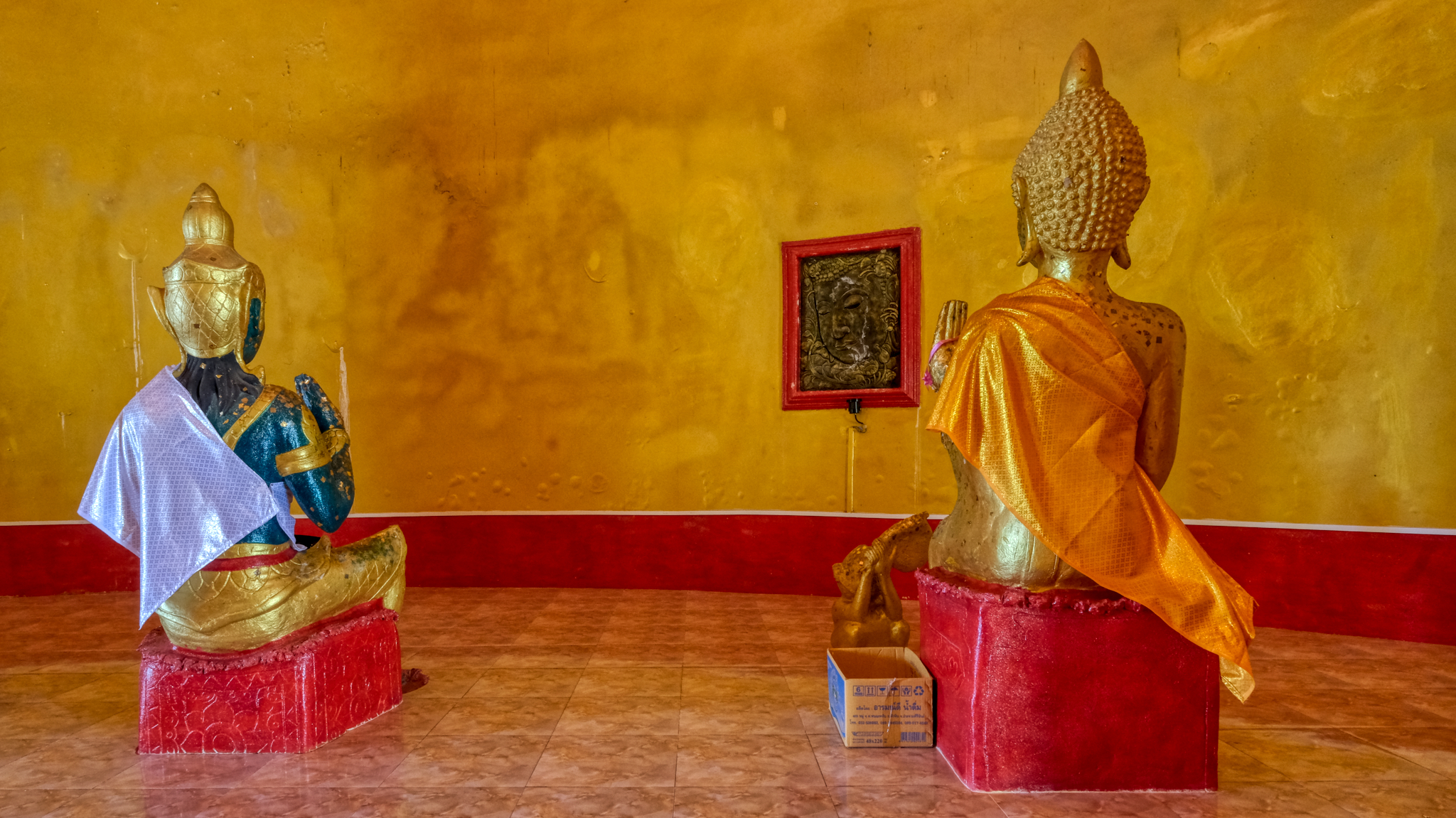 There is something so compelling about these dressed statues.
There is something so compelling about these dressed statues.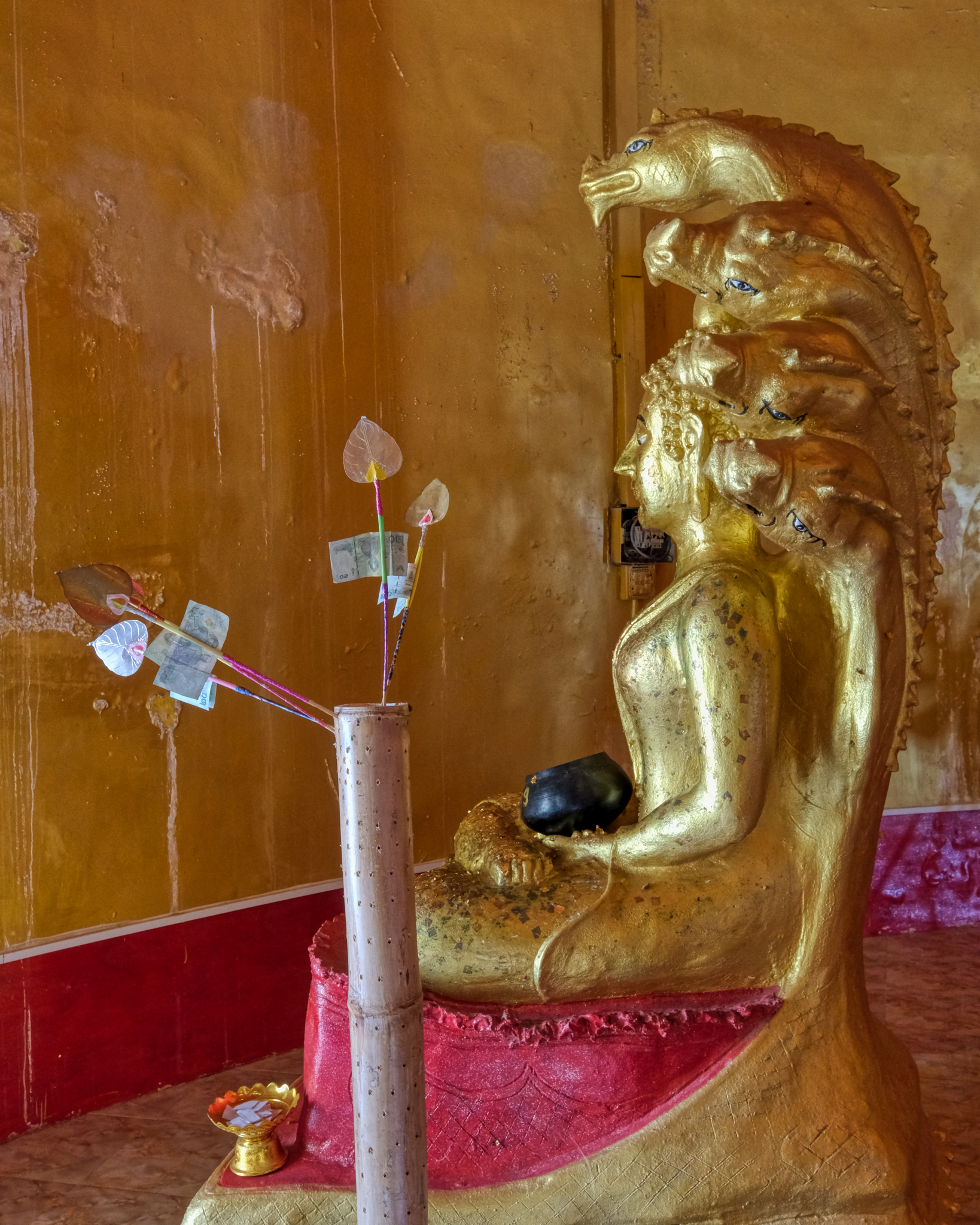 Every few feet . . . another image to never forget . . .
Every few feet . . . another image to never forget . . .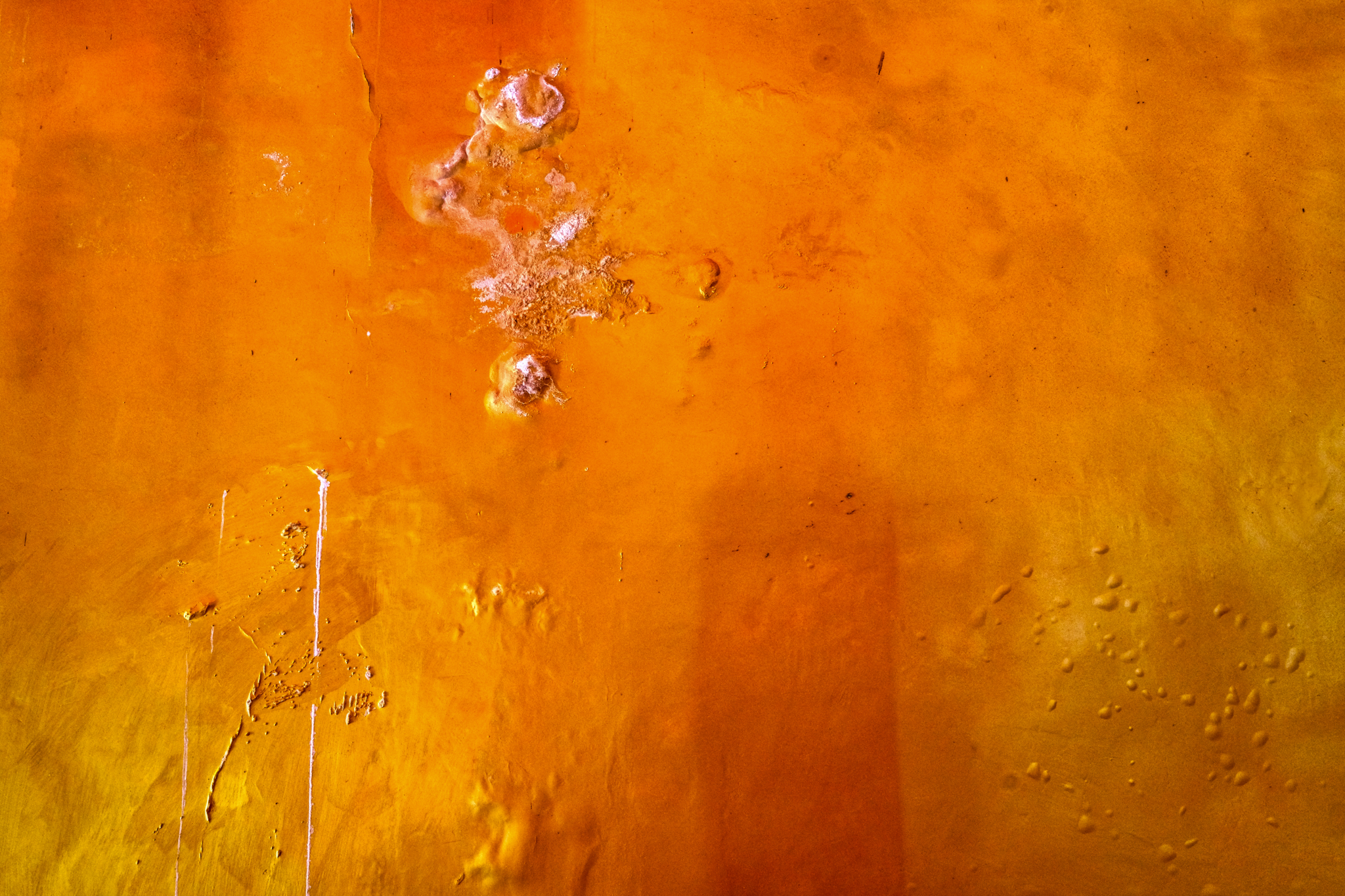 The walls themselves were a thing of wonder.
The walls themselves were a thing of wonder.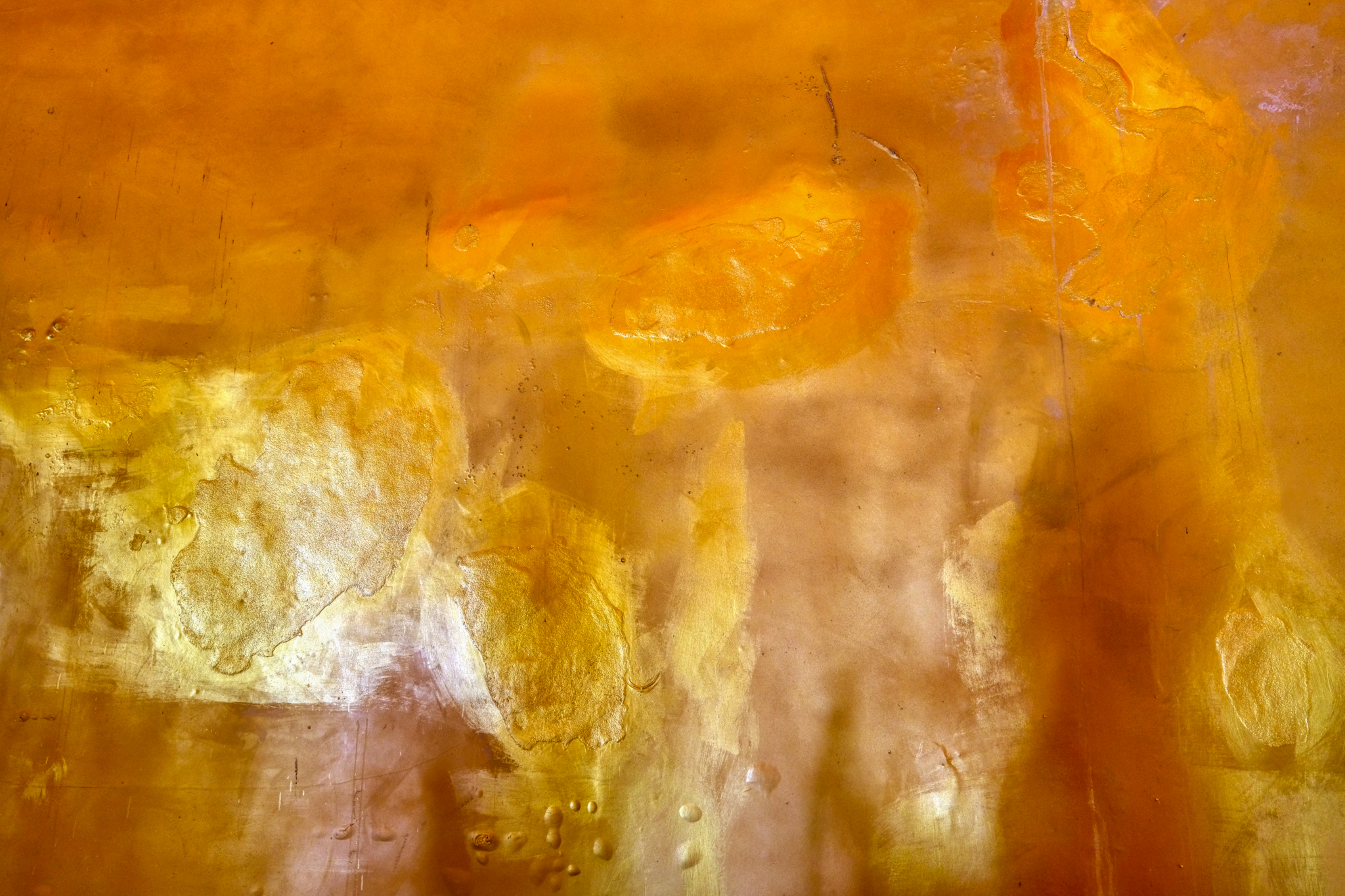 I am very nearly moved to tears by these walls . . . the color, the play of light, the human touch, the honesty.
I am very nearly moved to tears by these walls . . . the color, the play of light, the human touch, the honesty.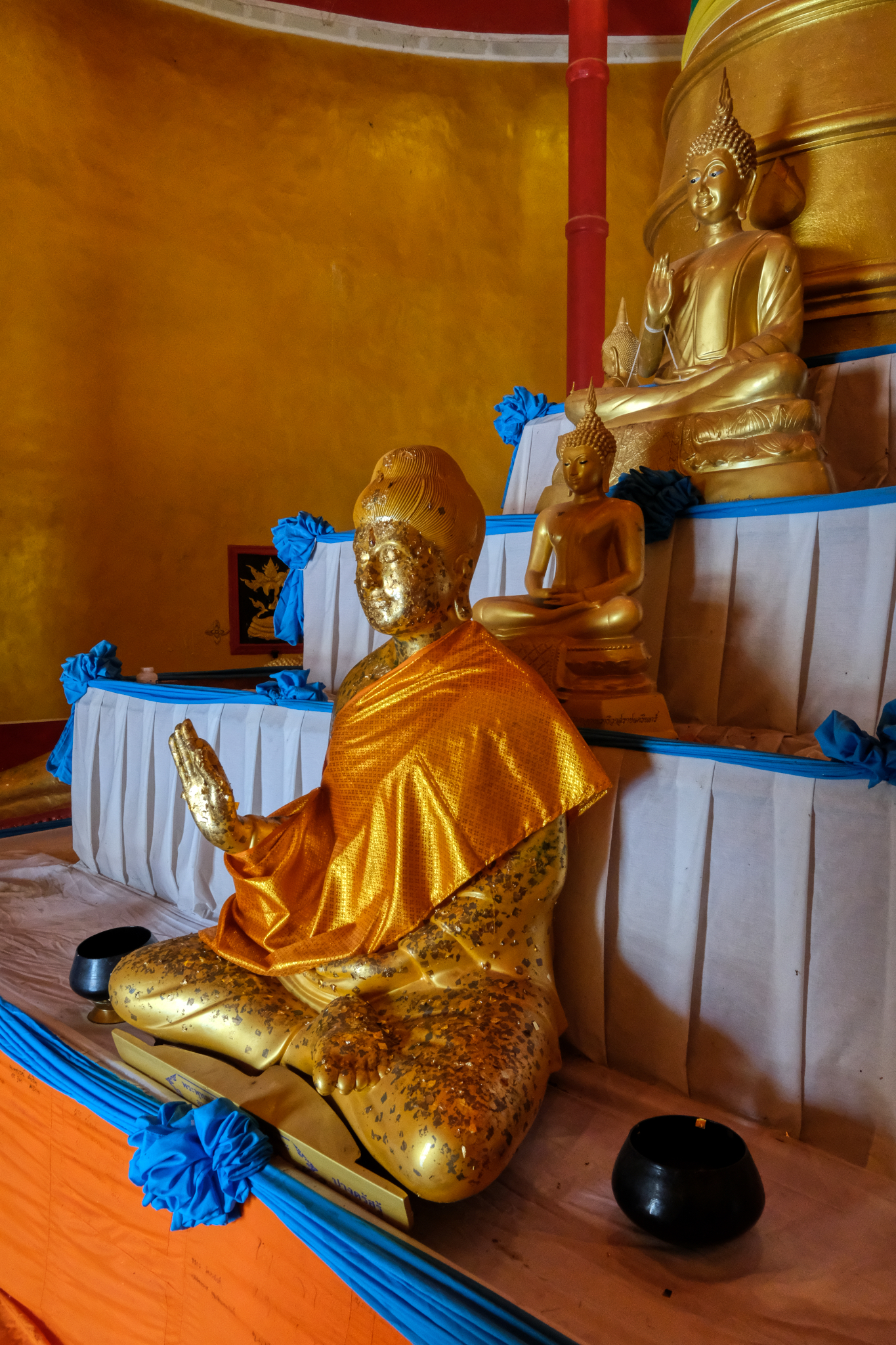 An altar facing an opposite door and sunlight.
An altar facing an opposite door and sunlight.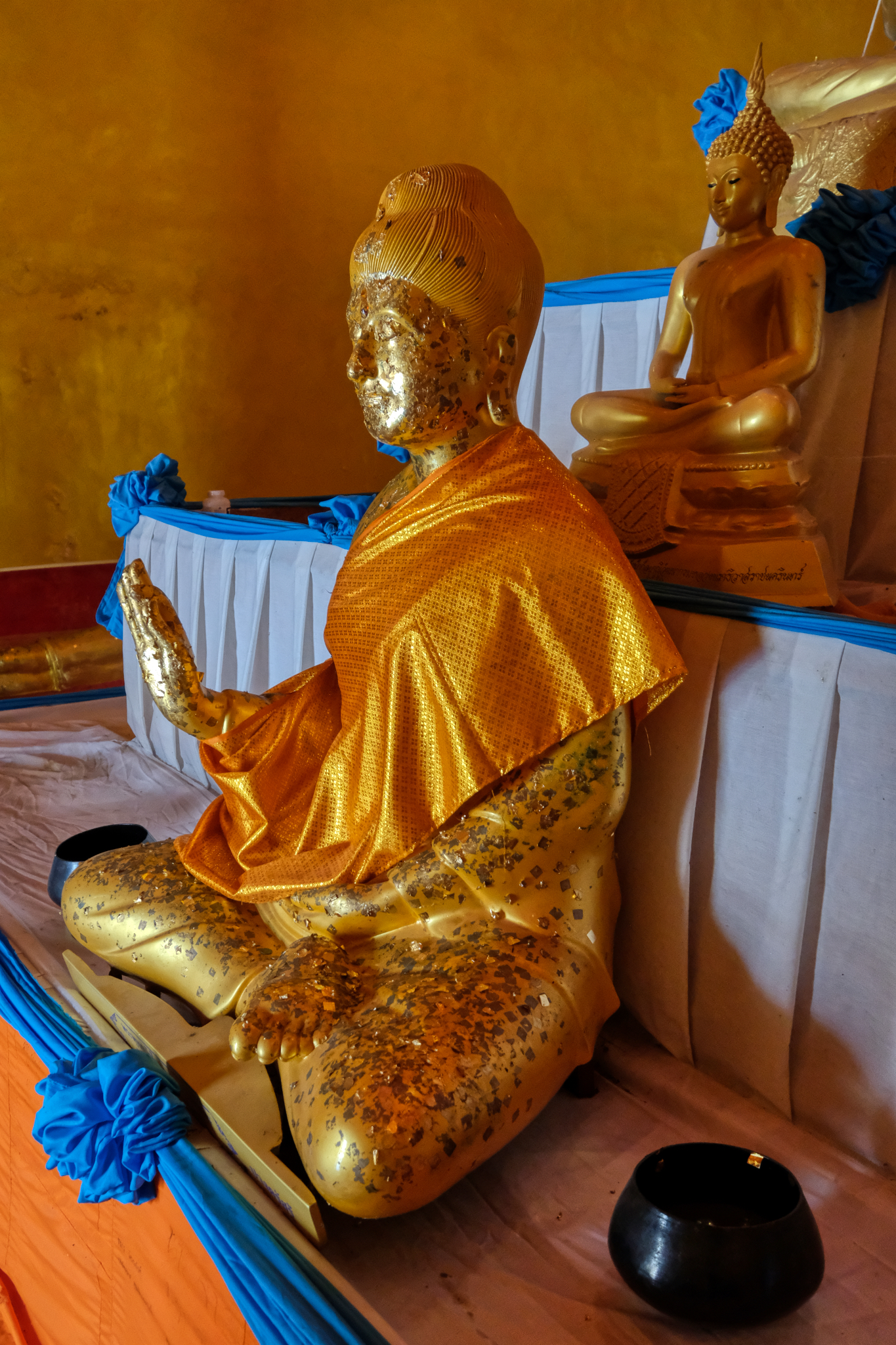 This Buddha statue in the Fearlessness (Abhāya mudrā) pose.
This Buddha statue in the Fearlessness (Abhāya mudrā) pose.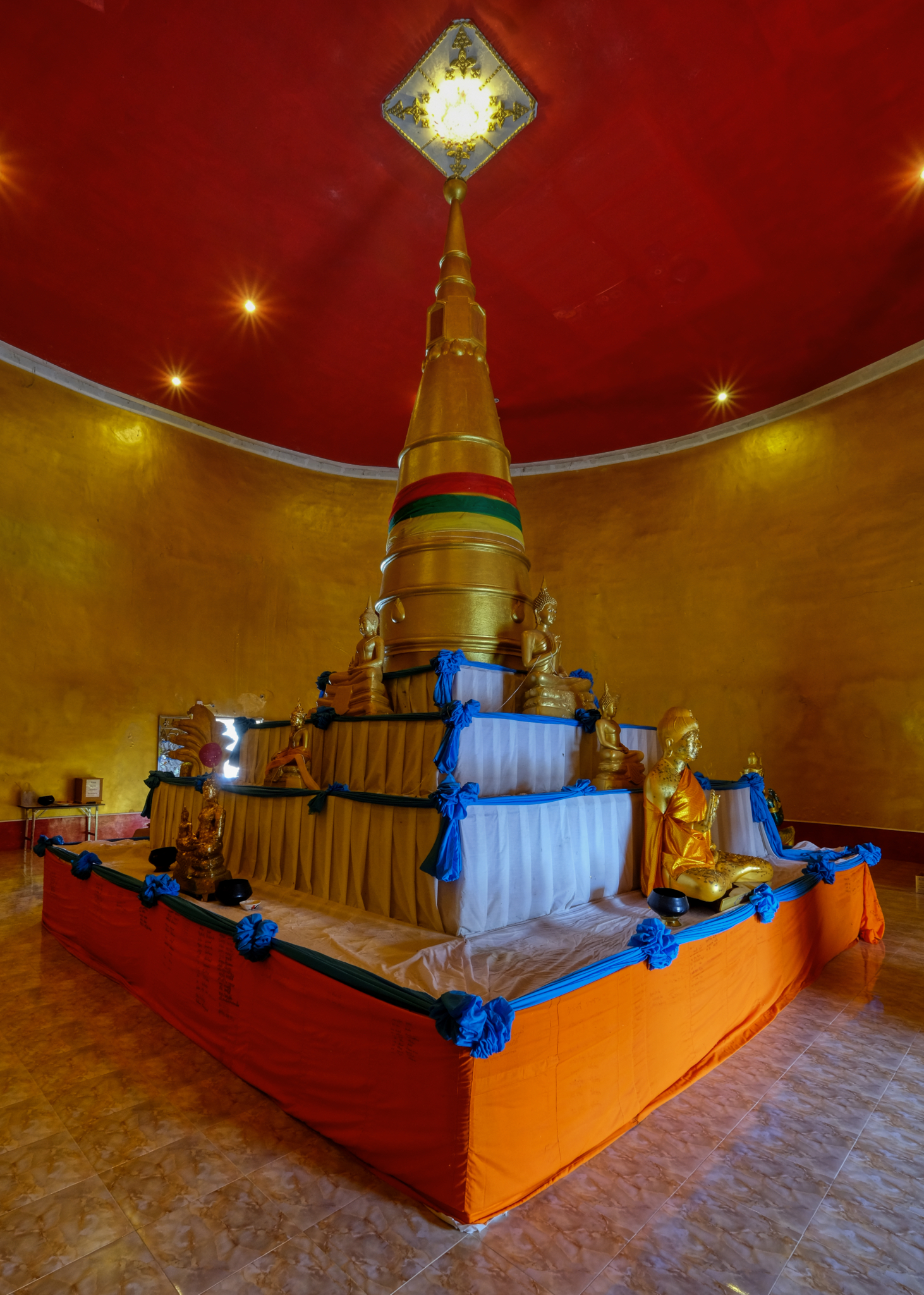 The chedi within the larger chedi.
The chedi within the larger chedi.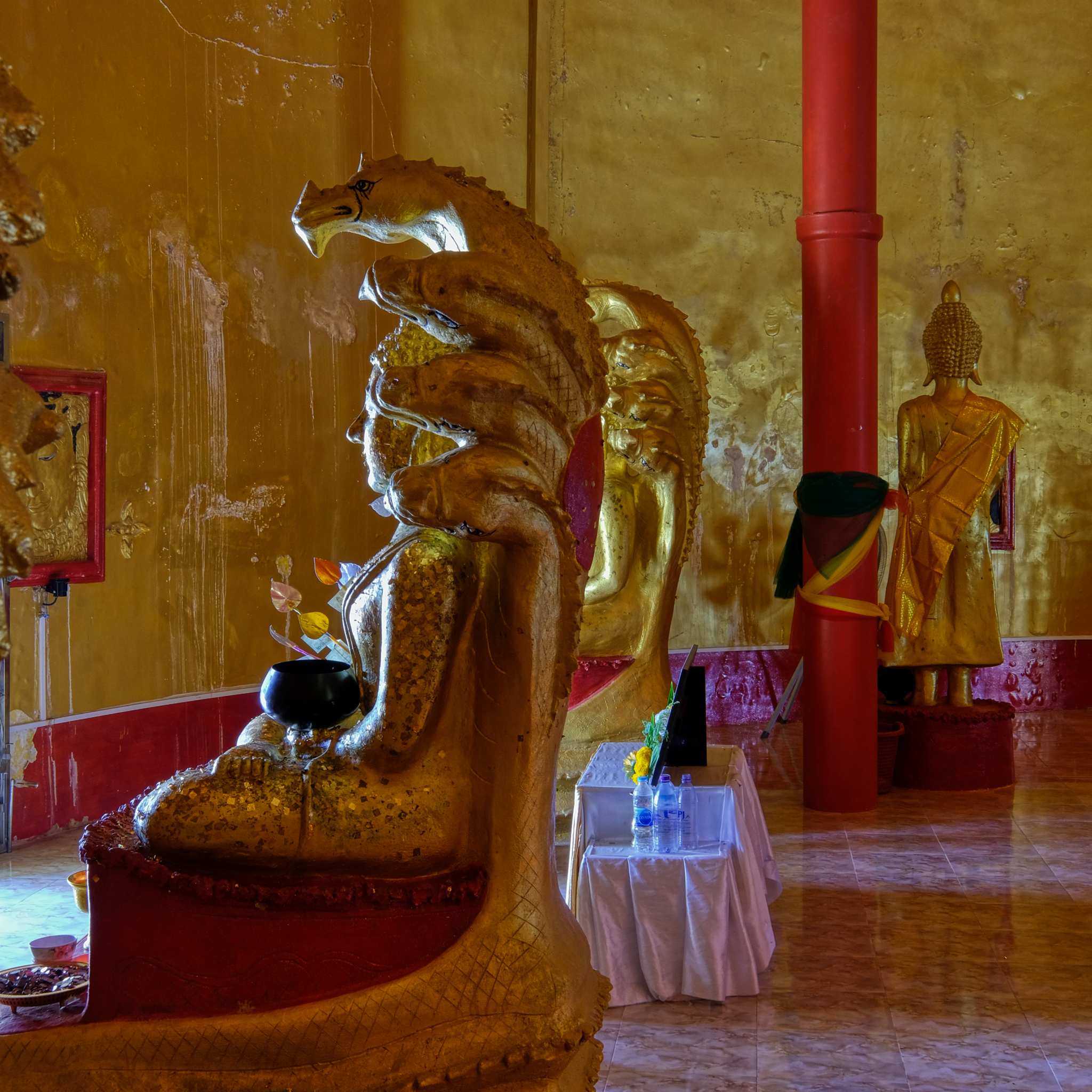 In some locations the light on the figures and on the wall came together in fantastic ways!
In some locations the light on the figures and on the wall came together in fantastic ways!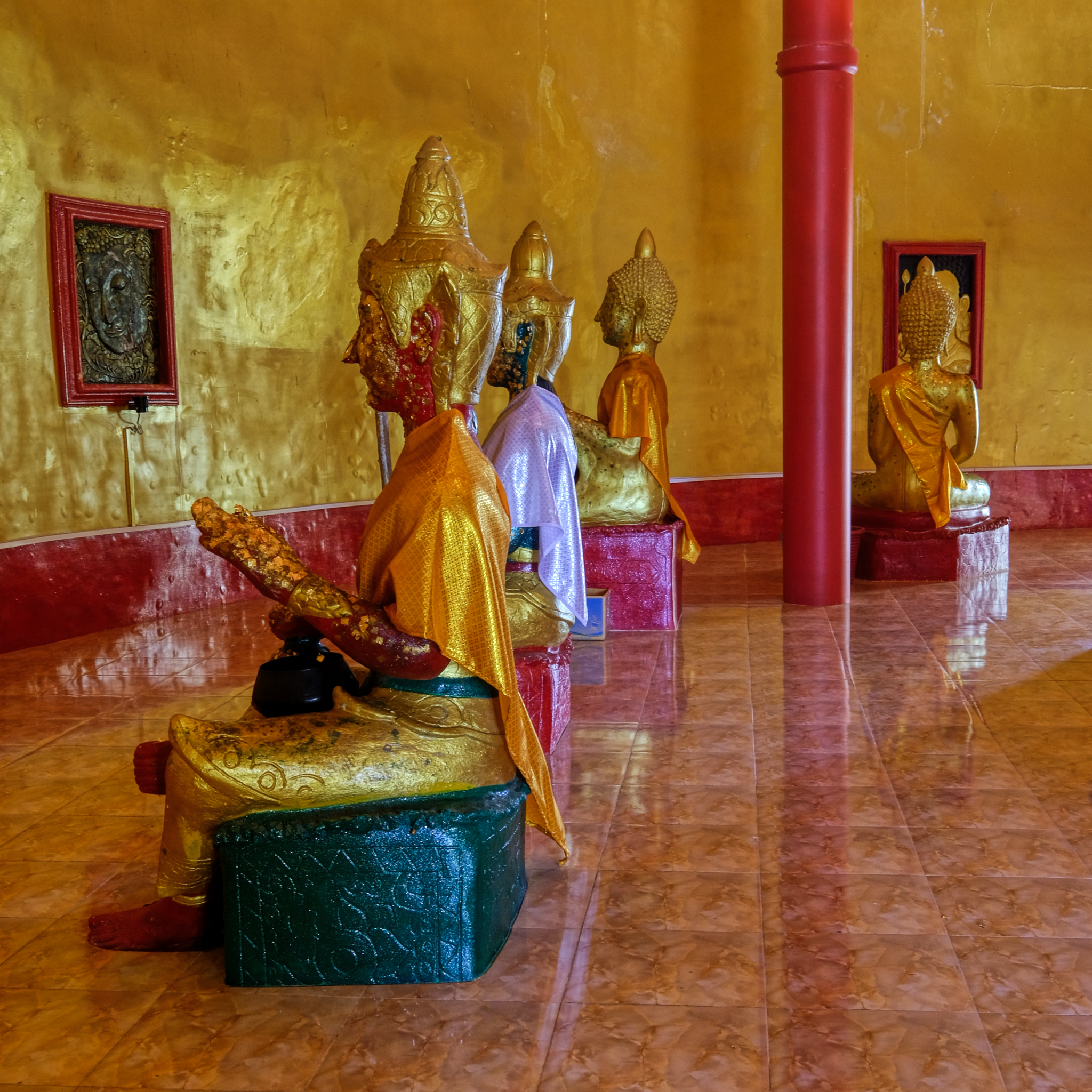 Phenomenal light and color and shapes . . . .
Phenomenal light and color and shapes . . . .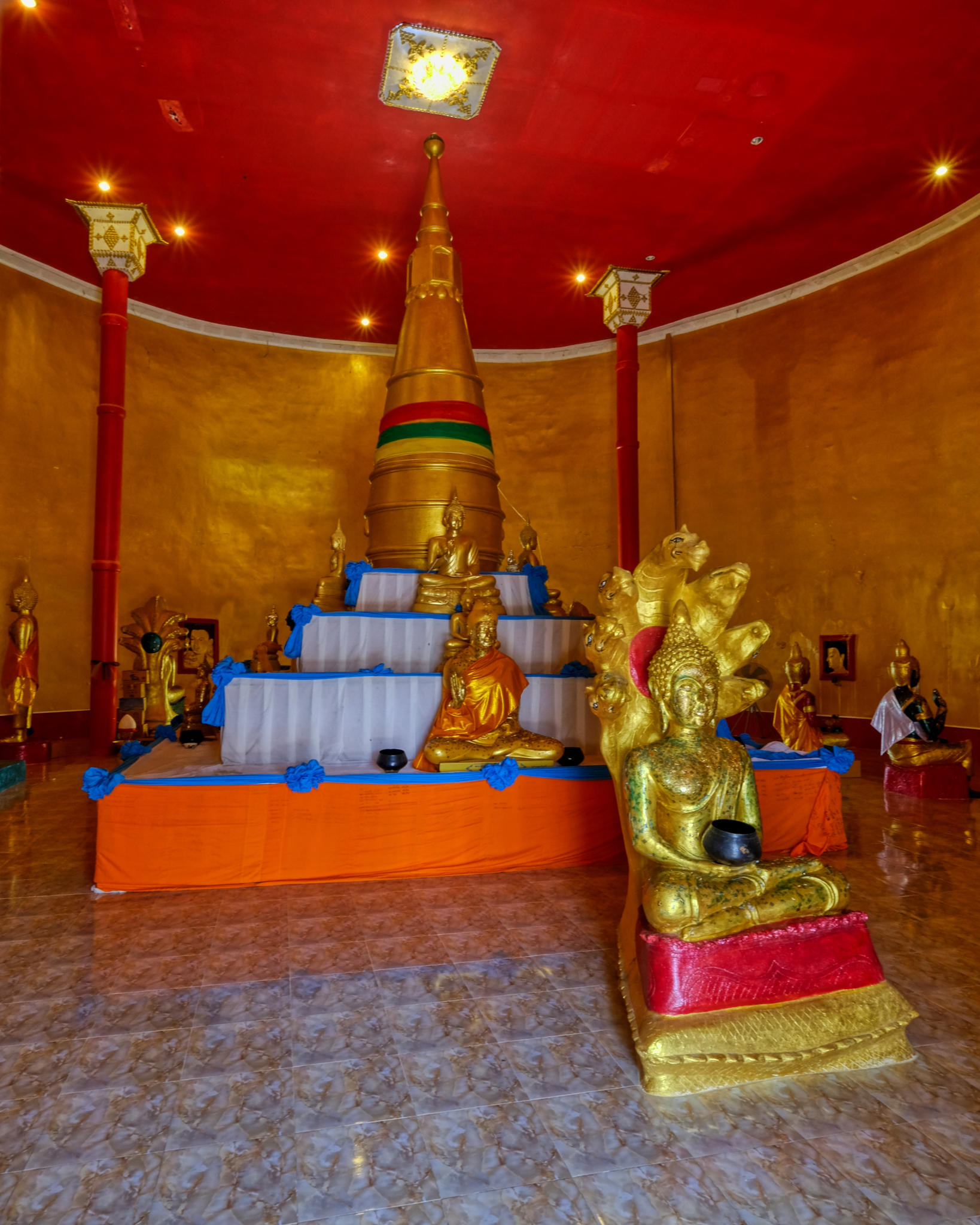 Although the Buddha figures seem sparse in this photo it seemed FULL of them.
Although the Buddha figures seem sparse in this photo it seemed FULL of them.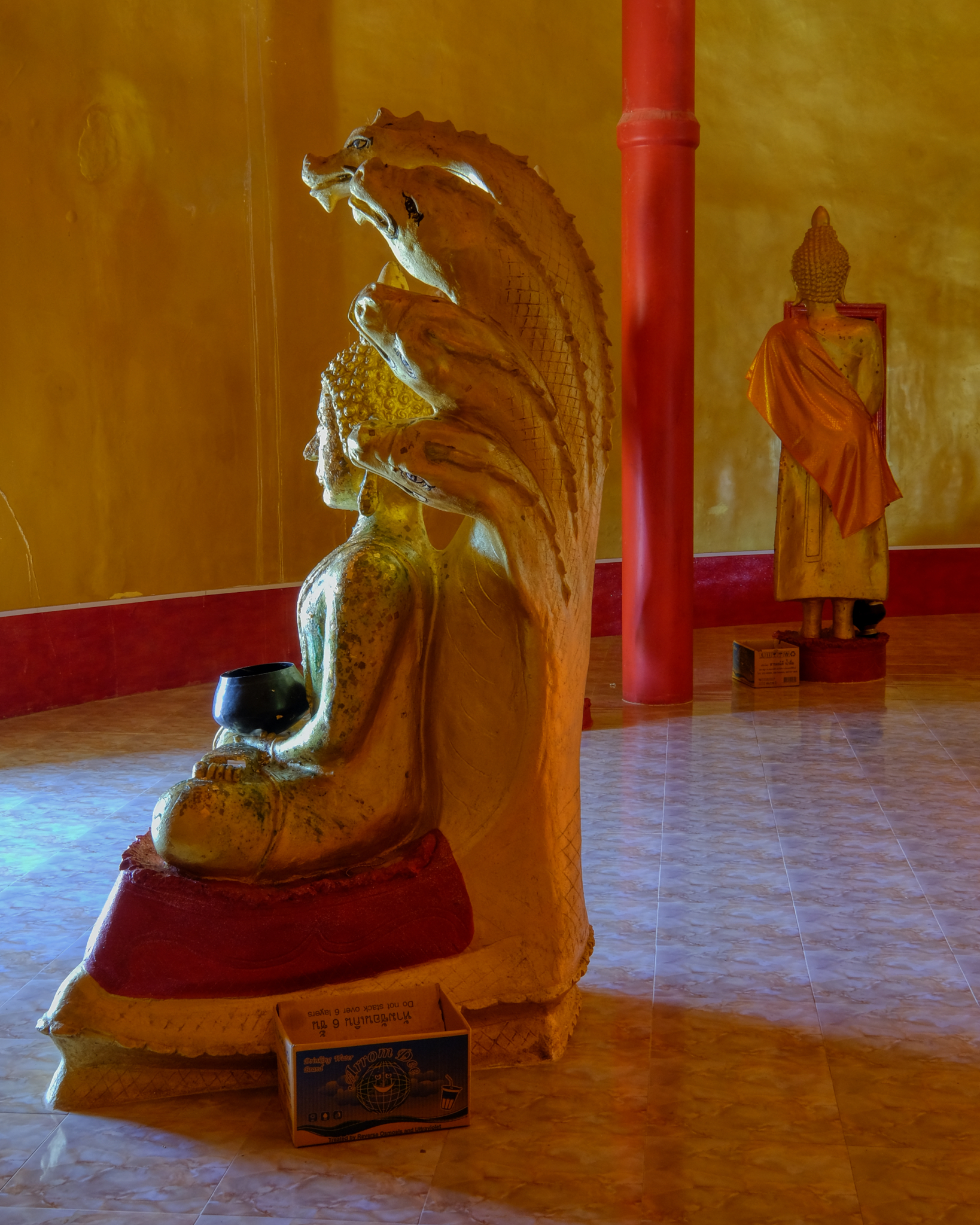 I did not know when to stop taking photos. I took a break and made merit at each Buddha image with gold leaf and reverent wais.
I did not know when to stop taking photos. I took a break and made merit at each Buddha image with gold leaf and reverent wais.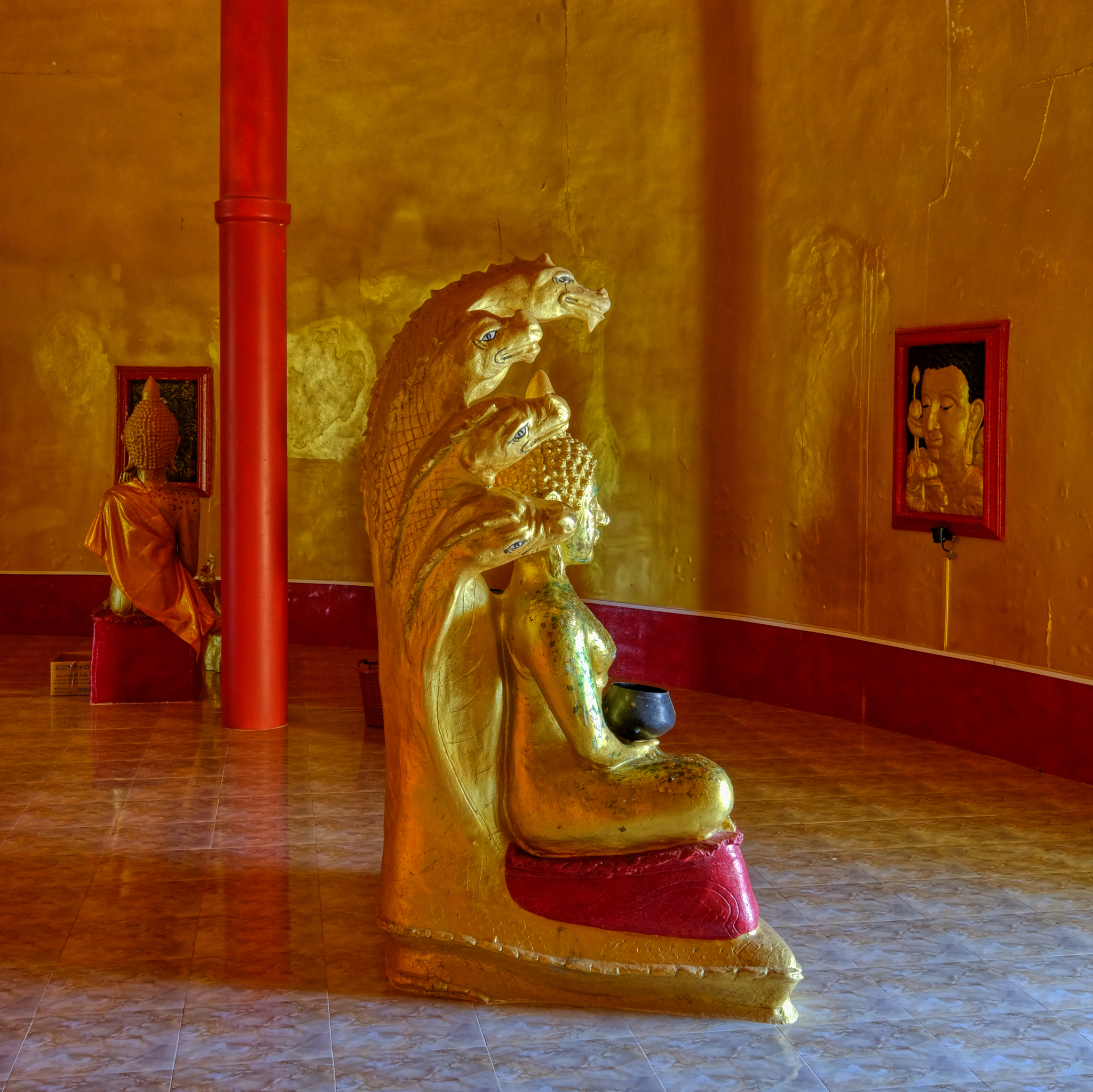 I became aware that as the sun outside brightened and dimmed, so did the lighting effects in the interior. Fantastic!
I became aware that as the sun outside brightened and dimmed, so did the lighting effects in the interior. Fantastic!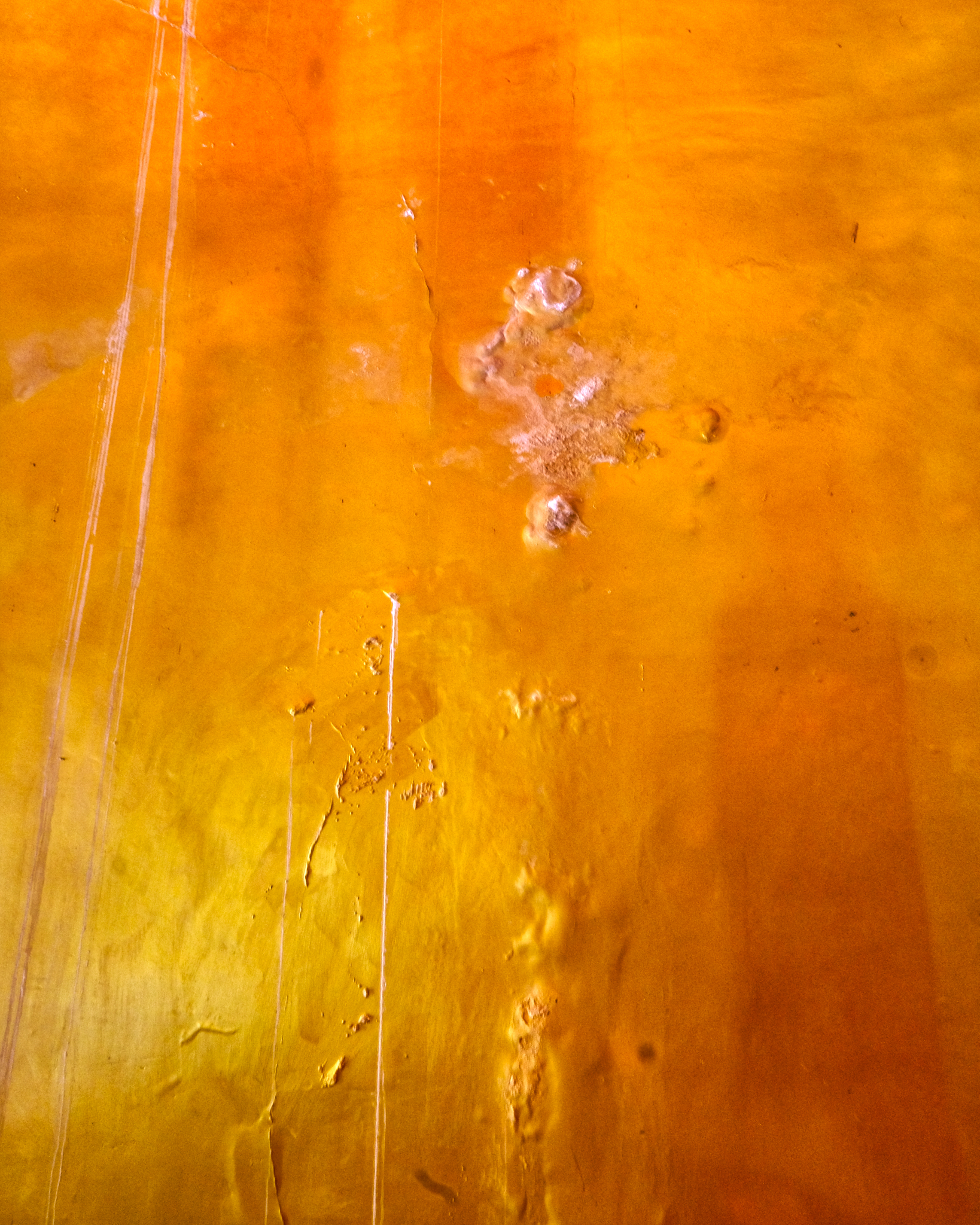 We spent several hours inside this remarkable chedi. So captivated by everything . . . standing staring at the walls in absolute wonder.
We spent several hours inside this remarkable chedi. So captivated by everything . . . standing staring at the walls in absolute wonder.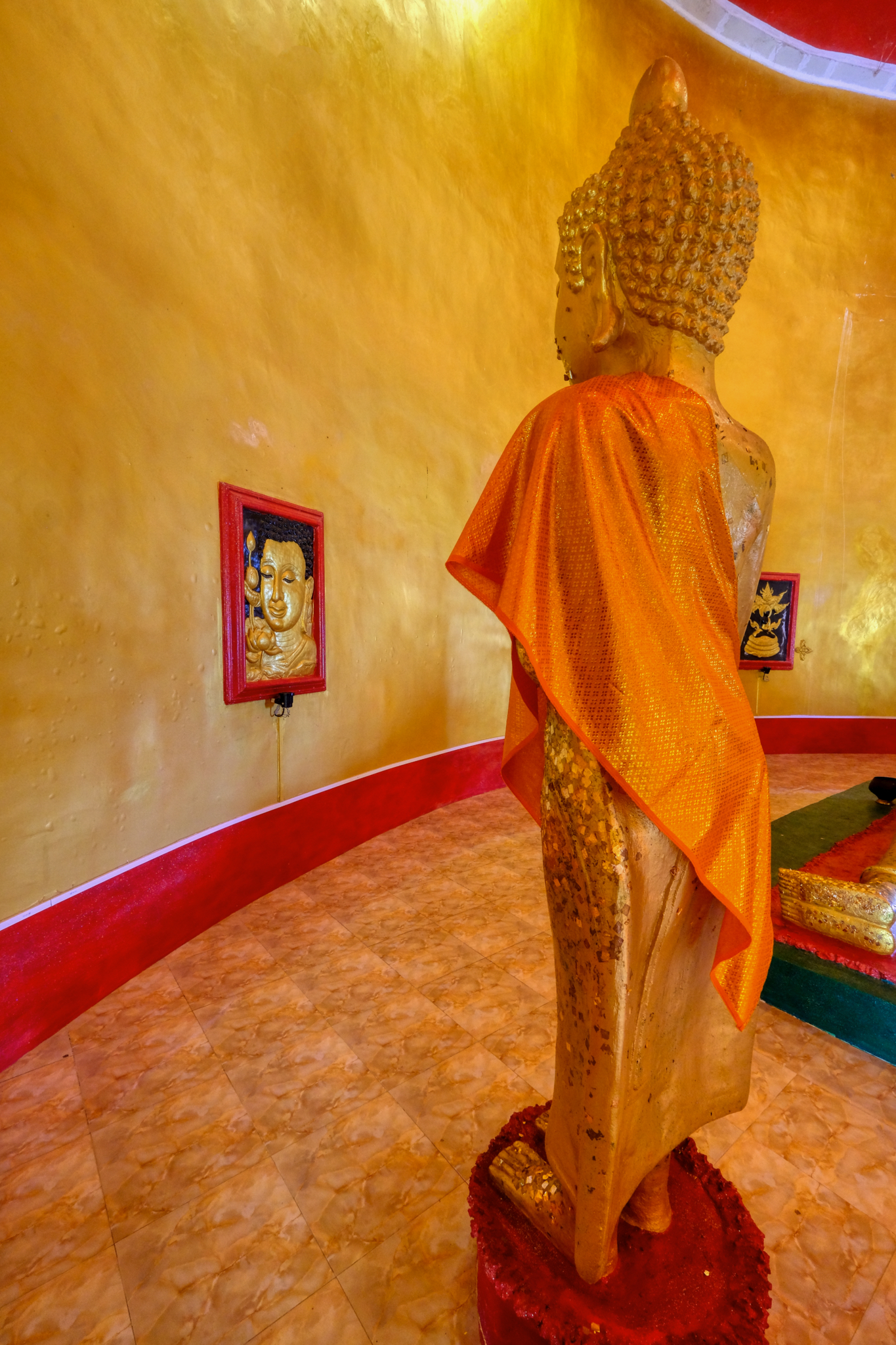 We had to leave . . . reluctantly. We had a whole day ahead of us and many adventures to have.
We had to leave . . . reluctantly. We had a whole day ahead of us and many adventures to have.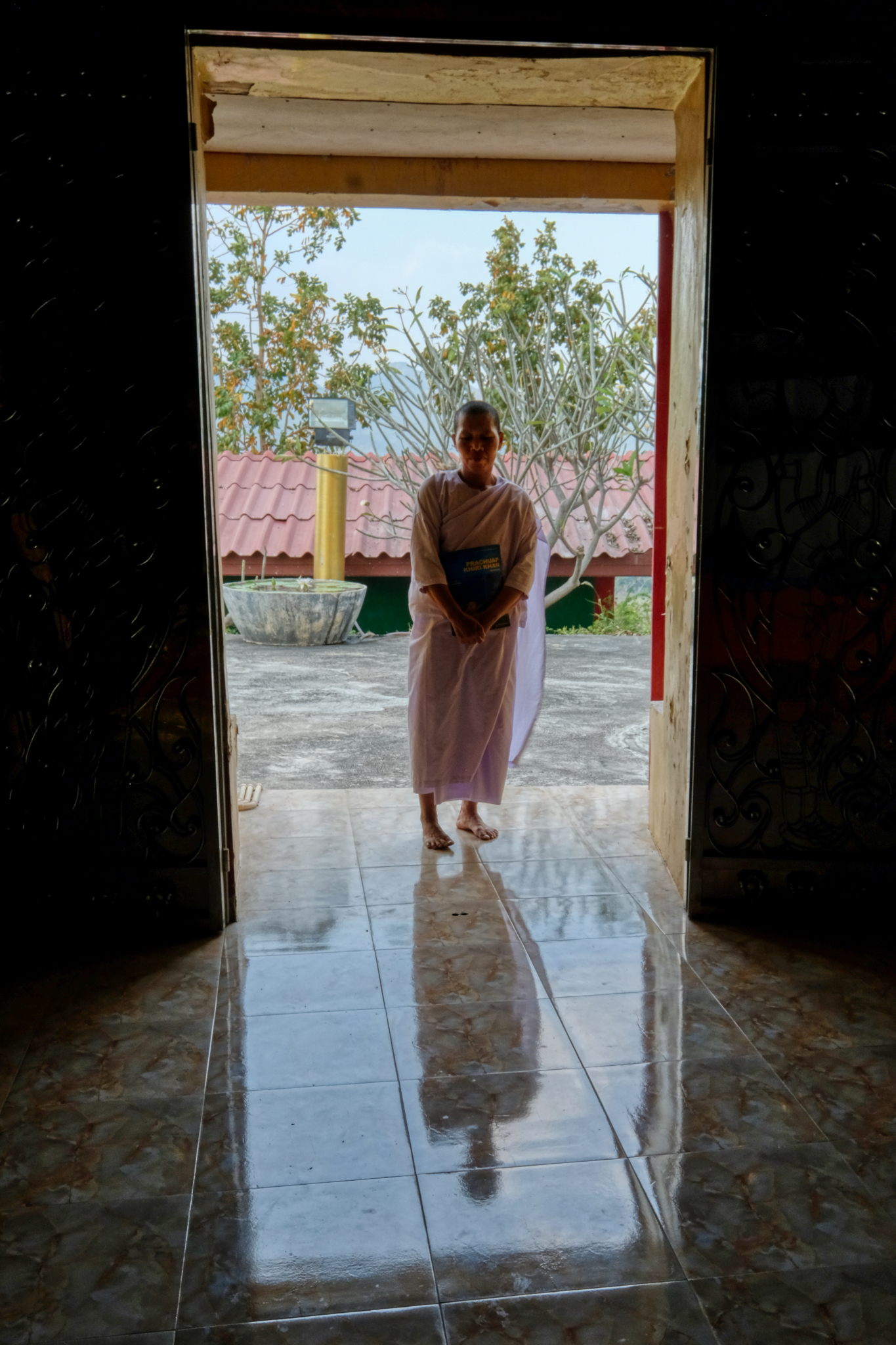 We at last left the chedi to the nun to have on her own in solitude.
We at last left the chedi to the nun to have on her own in solitude.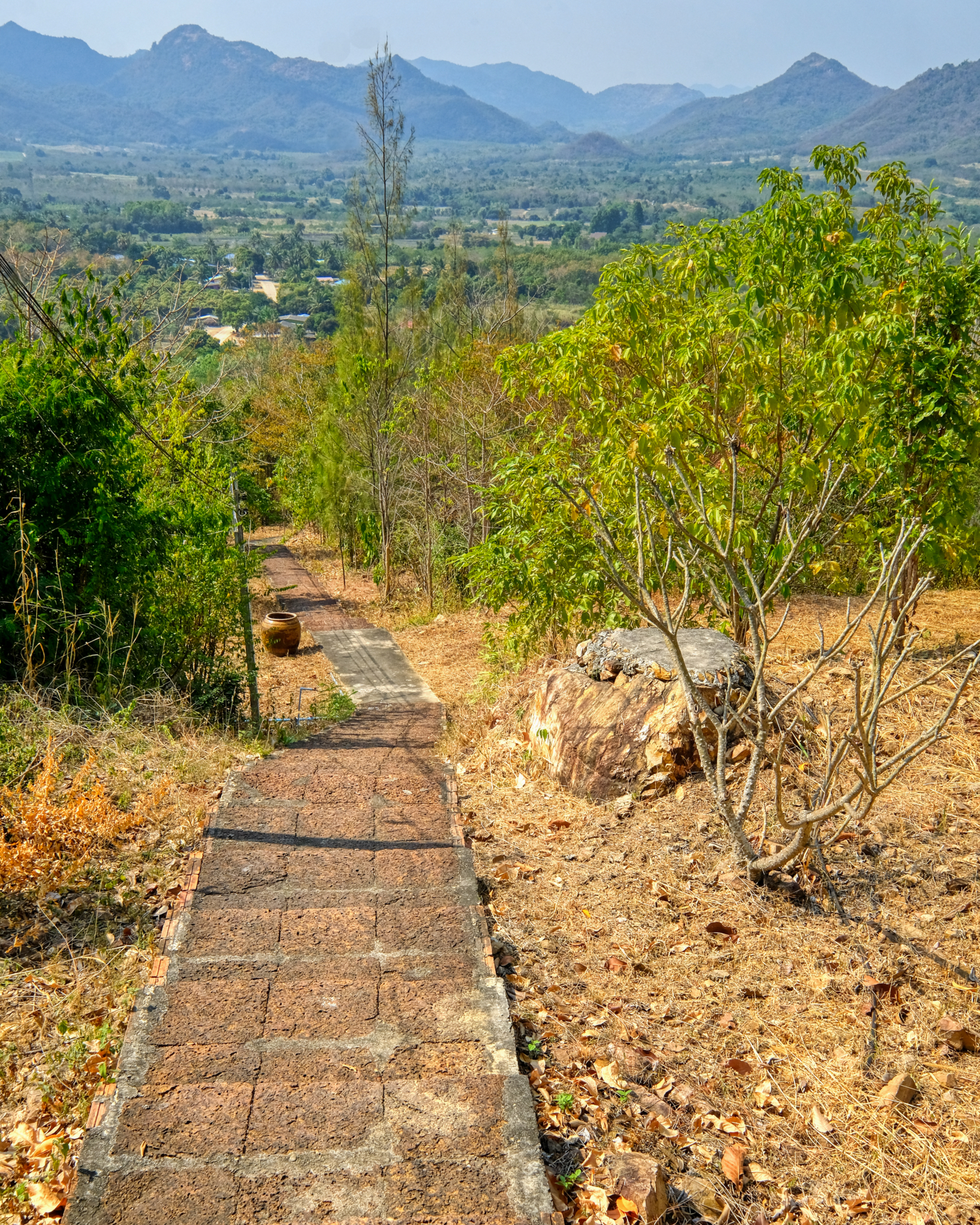 The chedi sits high on a hilltop with a wide view. This is a very rural location west of Hua Hin.
The chedi sits high on a hilltop with a wide view. This is a very rural location west of Hua Hin.